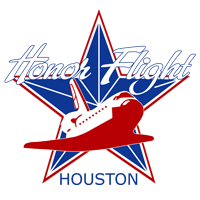VETERAN BIOGRAPHIES
We are honored to be able to share our veterans’ stories, so that you may better get to know the heroes within our community.
Amante, Anthony
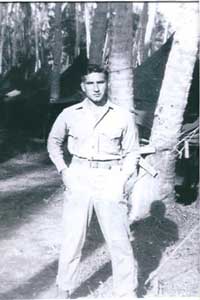 Anthony Amante
Anthony Amante
United States Marine Corps – Sergeant
1st Marine Air Wing, Marine Air Group 12.
Amante served in the Southwest Pacific and
Philippines Campaign. He served from 1943 -1946.
During his service Amante received a Bronze Star.
Once Amante returned to the states after the war he utilized the GI Bill benefits by enrolling at Brooklyn College. He was awarded a Bachelors degree in Geology from Brooklyn College and a Masters degree in Geophysics from the University of Wisconsin.
Amante was employed by Texas Instruments from his graduation until retirement in 1988 as a Vice President.
Baker, Delmar G.
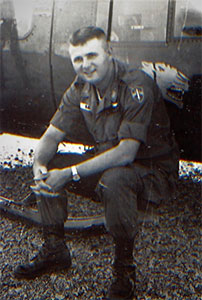 Delmar G. Baker
Delmar G. Baker
Major, United States Army. Baker served his country from 1956 to 1977 which included two tours in Vietnam, two tours in Europe, as well as numerous tours in the United States.
Baker was born in Arapahoe, Colorado in September 1936.
He joined the army in September 1956 as a Private First Class. He then served as a Specialist Five prior to going to flight school in 1963 where he became a Warrant Officer Aviator.
Baker was ordered to Vietnam in August of 1964 where he served until August of 1965. He was stationed at Ft. Walters, TX from 1966 to 1968 at which time he was reassigned to Bac Lieu Vietnam as a CH47 Aviator. He flew over 1700 hours during his two tours in Vietnam. Baker was awarded numerous medals including The Bronze Star and 38 Air Medals. In 1969 he returned to the US and was assigned to Fort Gordon, Georgia as a Company Commander. He attended The University of Nebraska in 1970 earning a GBS degree. In 1972 he was assigned to Heidelberg Germany where he served as a Communications Officer for CEEIA Europe.
While serving in Fontainebleu France, Baker married his wife Lydia in 1960. They have 3 children. Their oldest child Patricia was born in Germany, their son Raymond was born in Ozark, Alabama, and their youngest child Cheryl born in Ft. Monmouth, New Jersey. They have also been blessed with 6 grandchildren and 2 great grandchildren.
Baker retired from the military as a Major in 1977. He and his wife have been married for 58 years, are both retired and live in Houston, TX.
Barmore, Gaston
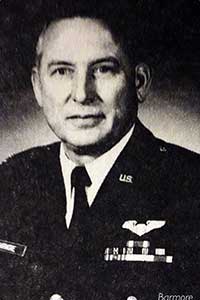 Colonel Gaston C. Barmore
Colonel Gaston C. BarmoreUSAF
Colonel Barmore was born November 23, 1930, In Cameron, Texas. He is a graduate of Texas A&M College. His military education includes Air Command and Staff College, Industrial College of the armed forces, and Air War College by correspondence.
He enlisted in the Texas Air National Guard in June, 1948 and was called to active duty in October, 1950. He served as a Senior Aircraft Radio Operator in B-26 aircraft during the Korean Conflict and was released from active duty in 1952.
Colonel Barmore received a direct Commission in 1956 and was assigned to the 272 Communications Squadron, Texas Air National Guard at La Porte, Texas. Shortly thereafter he was selected to attend the Communications-Electronics Officers School at Scott AFB, Illinois. Upon graduation, he returned to the 272 Communications Squadron as H F Communications Officer. In 1963, Colonel Barmore returned to the unit in which he served during the Korean Conflict, the 147 Fighter Interceptor Group Texas Air National Guard, as Communications-Electronics Staff Officer. In 1977, he was promoted to Lieutenant Colonel and transferred to the Air Force Reserve. He was subsequently assigned to the 10th Air Force as Director of Communications. He assumed the duty of mobilization assistant to the commander, 1923 Communications Group, Kelly Air Force Base, Texas in May, 1981.
Colonel Barmore’s military decorations and awards include the Meritorious Service Medal, Air Force Outstanding Unit Award, Army Good Conduct Medal, National Defense Service Air Medal, Air Force Longevity Service Award Ribbon with six oak leaf clusters, Armed Forces Reserve Medal and Small Arms Expert Marksman Ribbon.
In his civilian capacity, Colonel Barmore was a manufacturer’s representative and President of Barmore Associates, Inc.
Colonel Barmore is married to the former Camille Faver of Cameron, Texas. They have two children, Cliff and Michelle. The Barmores live in Houston, TX.
Beard, Ronald
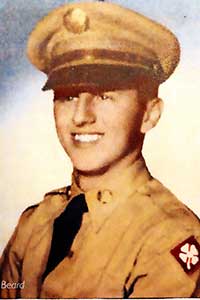 Ronald Beard
Ronald BeardU.S.ARMY
KOREAN COMMUNICATIONS ZONE AVAITION
1 ST CALVARY DIVISION AVAITION
After basic training at Fort Bliss,Texas, as Army schools were full, he was sent to Gary Air Force base, San Marcos, Texas for helicopter Aviation maintenance training. Upon completion, was sent to Fort Lewis Washington to be sent to Korea, followed by a 21 day cruise to Inchon, Korea aboard the USNS Marine Serpent. Assigned to Able 3 Ascom city airbase, further assigned to Able 33 airbase , Taegue. Soon after was upgraded to Crew chief of the the KCOMZ division commander Maj Gen E.J.McGaw’s Helicopter.
Almost a year later General McGaw became Division commander of the 1st Calvary Division and he was requested to transfer to the 1st Calvary Division in Japan to remain Crew Chief of the General’s Helicopter in Sendai Japan. Remaining in Sendai for the balance of my tour of duty.
After discharge returned home to Houston, Texas and to the University of Houston to study engineering. He married, they have 7 children, 3 grand children, 4 great-grandchildren and reside in Spring, TX. As his family grew and he searched for his true vocation, the cellular telephone arrived. He saw the potential and founded Cellular Horizons, a specialized mobile phone company that dealt only with the corporate world. “It was an Honor and Privilege to serve our country.”
Beard, William
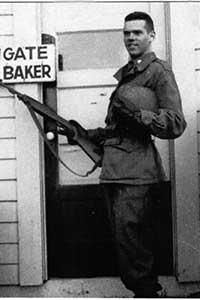 William L. Beard
William L. Beard
Sergeant Beard served in the Army Corps of Engineers from November, 1950, to November, 1952. He was one of about 150 draftees inducted in St. Paul, Minnesota, and shipped by troop train to Ft. Riley, Kansas, for processing. At this time, the 30th Engineer Base Topographic Battalion was under orders to complete a priority mapping program in Alaska in 1952; to achieve that objective, the Battalion needed an additional Base Survey Company. For whatever reason, the batch of inductees from St. Paul was chosen to staff the new company and was shipped to San Francisco to join the 30th Battalion. The new company, the 551st Engineer Base Survey Company, was stationed at Ft. Baker on San Francisco Bay, beneath the north end of the Golden Gate Bridge. We were given six weeks of basic training, followed by ten weeks of training in the jobs we would be doing in Alaska. In April, 1951, the Battalion boarded a troop ship for a six day cruise to Seward, Alaska. The surveying season in Alaska is short; after five months and with snow on the ground, the Battalion returned to base in San Francisco and then moved to southern California to support the U.S. Geological Survey in mapping desert areas. While on furlough to St. Paul, Beard married Barbara, his wife for almost 65 years. They had two children, four grands and three greats. In June, 1952, the 30th returned to Alaska. Beard’s unit spent the summer surveying on the lower Yukon River and delta. In September, the job was finished -for the 30th, mission accomplished; for Beard, time to go home.
Beehler, Marvin
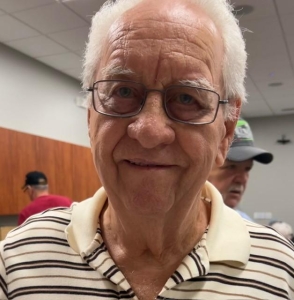 Marvin Beehler was born in St. Cloud, Minnesota and served in the U.S. Army from September 1958 to 1960 in Fort Hood, Texas and Germany.
Marvin Beehler was born in St. Cloud, Minnesota and served in the U.S. Army from September 1958 to 1960 in Fort Hood, Texas and Germany.
He was Direct Support Ord in parts requests.
Beehler was discharged in New Jersey. From there, he went to electronics school in Minneapolis and subsequently got a job with Honeywell in the Data Processing division. After that, he went to school in Boston as was assigned as a computer tech at Philadelphia Electric.
Marvin then went to work for GE’s Industrial Computer department. GE sent him to school in Phoenix which resulted in him being assigned to the Houston area. He took early retirement in 1995 and remained in the Houston area.
Marvin married a Philly girl on 4/06/64. They did not have children and his Philly gal passed away in 1999. He has not remarried.
Benavides, Alfred
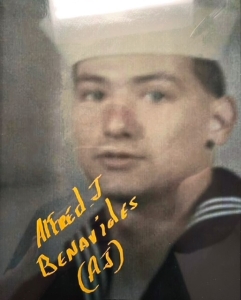 Alfred J. Benavides, Sr.
Alfred J. Benavides, Sr.US Navy; E3, OJT Corpsman Striker
Vietnam War
Seaman 1st Class (S1/C), United States Navy. Be-navides served his country during the Viet War/Conflict.
Alfred J. Benavides, Sr. was born on June 15, 1947 in Houston, Texas. I enlisted in the United States Naval Reserves in September 1967, attended the Great Lakes Naval Academy in Illinois (boot camp) September 6 to November 3, 1967. My orders were to report to Naval Reserves in Houston, trained aboard the USS Hans-worth DD700 in Galveston, Texas in November 1967 to November 1968. I had one tour to Gitmo (Guantanamo Bay, Cuba) with RR in Ocho Rio, Jamaica.
In November 1968 received orders to report to San Die-go, California. Stayed in barracks on the Naval Base Pier where I received my orders to report to the USS Dennis J. Buckley DD808 in December 1968.
Reported to Naval Reserves in Houston, trained aboard the USS Hansworth DD700 iin support, S&R (search and rescue), and guarding carriers (Constellation & Hancock). We stopped in ports such as Hawaii, Subic Bay, Phillipines, Sacebo, Japan and R&R in Hong Kong. My duties included Deck Hand and Corpman Striker (Chief Corpsman Helper).
I was discharged from active duty in San Francisco, California in October 1970.
Berkowitz, Herbert
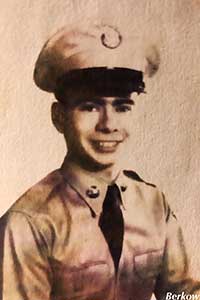 Herbert Berkowitz
Herbert BerkowitzUS Army
1st Lieutenant U.S. Army. He served his country 1949 – 1954.
Born in the November, 1931 in Bronx, New York, Herb enlisted in the U.S. Army on his 18th birthday in November, 1949 as a private.
After Basic Training in Ft. Dix, NJ he was assigned to the Army of Occupation in Germany.
Trained as a Medical Lab Technician in Heidleburg, Germany and served in the 10th Field Hospital in Wurzburg, Germany in support of combat divisions facing the Soviet threat during the Cold War.
Applied and accepted to the Armor Officer Candidate School in Ft. Knox, KY in early 1951.
After service as a Recon Platoon Leader with an Armored Cavalry Regiment in Camp Pickett, VA, he asked for and was deployed to Korea in 1953. He served as a Tank Platoon Leader in an Armored Company of an Infantry Regiment in the 40th Division in Korea from March, 1953 to March, 1954.
“It has been the greatest honor of my life to serve my country.”
Discharged in March, 1954, 1st Lt. Berkowitz returned home to New York City and immediately married Carol Meyers. He was married to Carol for 46 years until her passing in January, 2001. Herb and Carol have two children and four grandchildren.
He met Wanda Robicheaux Bradshaw in New Orleans and they were married in June, 2002 and they currently reside in Katy, Texas.
Berry, Thomas
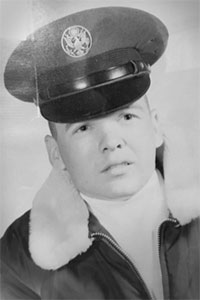 Thomas (Tom) C. Berry
Thomas (Tom) C. Berry
Served April 1968 – April 1972
USAF
Tom Berry was born in Houston, Texas in 1948 and raised in Beaumont, Texas. There, he met and eventually married his high school sweetheart, Melissa Ferguson on April 1968.
In 1968, Tom joined USAF. After basic training, Sgt Berry was assigned to Sheppard AFB, Wichita Falls, Texas for Jets 1 & 2 engines. Thomas was assigned to the 91st TRS Squadron at Bergstram AFB in Austin, Texas. This is where he began working on the F-4 Phantom.
It was at Bergstram AFB, Sgt Berry received orders to DaNang AB, VietNam. He was assigned to the 366th TFW with primary duties to make ready F-4 jets in order to support ground troops. The 366th were known as “Can do Bears”.
After completing his tour of duty in DaNang from 1969-1970, Sgt Berry was assigned to Davis Monthan AFB in Tucson, Arizona. There he was assigned to the 354th TFW, nicknamed “The Fighting Bulldogs”. He worked on A7D aircraft.
Sgt Berry was honorably discharged from the USAF in May, 1972. He returned home to Texas. Thomas and his wife, Melissa have three children and six grandchildren and currently reside in Cypress, Texas.
Since retiring, Thomas volunteers at the Tomball VA Outpatient Clinic serving veteran comrades.
He and his wife are working on their “bucket list,” and spending times with their family.
Blair, Andrew
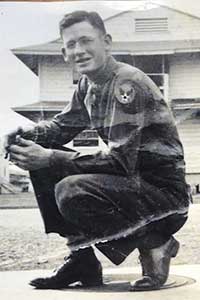 My name is Andrew V. (Buddy) Blair. I was born on June 26, 1929, in Sugar Land Texas. That makes me almost 88 years old. I went to school in Sugar Land, and graduated from Sugar Land High school in 1947.
My name is Andrew V. (Buddy) Blair. I was born on June 26, 1929, in Sugar Land Texas. That makes me almost 88 years old. I went to school in Sugar Land, and graduated from Sugar Land High school in 1947.
I had always wanted to be in the United States Air Force. I read an article that told me how to apply to be an Air Force Airplane and engine mechanic. I applied and was enlisted on August 30, 1948 for 3 years. I enlisted in Houston and was taken to Lackland Air force Base in San Antonio for my basic training, but a new base was opened in Wichita Falls so they sent me to Shepherd Air Force Base in Wichita Falls to finish my basic training. After basic I was sent to Kessler Air Force Base in Biloxi, Mississippi for my tech training to become an Aircraft Mechanic. I spent a short time at Oliver General Hospital, Augusta, GA because I broke my ankle. After recuperating I was sent back Shepherd to complete my tech training.
After training I was sent back to Lackland to await my assignment. I was then sent to Clark Field in the Philippines by way of Camp Stoneman in California. They shipped us to the Philippines by boat. In 1950 North Korea invaded South Korea on June 25th, the day before my 21st birthday. It wasn’t very long after that we were shipped to South Korea. My first assignment in South Korea was to the headquarters and headquarter squadron 13th Air Force, airplane and engine mechanic. I stayed in Korea for two years. While waiting to be discharged Uncle Sam decided he wanted me to stay a while. I was discharged on July 24, 1952.
Blanco, Matthew
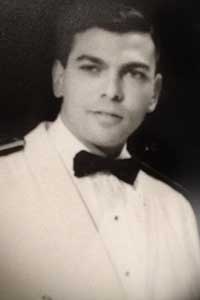 MATTHEW C. BIANCO
MATTHEW C. BIANCOCaptain. United States Air Force.
Matt served his country during the Vietnam era from 1962 – 1970.
Matt was born in October 1940 in Paterson, New Jersey and later moved to Ho-Ho-Kus, N.J.
He volunteered and entered the Air Force in June 1962 and went to Lackland AFB attending Officers Training School. After completing the Supply Officers Course at Amarillo AFB he was stationed at Toul Rosieres Air Base in France.
After completing a three (3) year assignment in France with the 2nd Mobile Communications Group he was selected to attend the Air Force Institute of Technology program and was assigned to Michigan State University for 15 months where he successfully completed and graduated with a MBA.
In early 1967, Matt was assigned to the Air Force Command Post at the Pentagon and completed his Air Force service there resigning his commission in October 1970.
Thereafter, Matt was employed by ExxonMobil for some 30 years prior to retiring in 1999 and currently resides with his wife, Zuleika in Houston, Texas.
Blunck, Bill
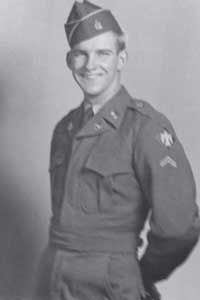 Bill M Blunck
Bill M Blunck
Cpl. United States Army Infantry
Bill was born in Clinton, Oklahoma in March 1932. Graduated HS 1950. Was mobilized into the National Guard Sept. that same year. Did basic at Camp Polk, La., from there to Hokkaido, Japan and then deployed to Korea late 1951 – 52. Where they arrived in Pusan, So. Korea via landing barges. On up through Seoul and north to Chorwon and near (old baldy) where the Division was established.
Bill Served in a battalion Hq. Co. as a field wireman, infantryman, and other communication skills.
Bill and his wife have been married for 56 years. They have four children, eight grandchildren, and seven great-grandchildren.
Bobbitt, George
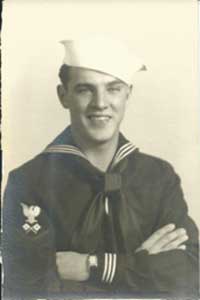 George Bobbitt
George Bobbitt
Signalman 2/C, served in the U S Navy during WW II from Sept 1942 to Jan 1946.
Following boot camp at Great Lakes and then Signalman School he was sent to the Armed Guard Center at New Orleans where crews were assembled and assigned to merchant ships located principally in the Gulf Coast Area.
His first ship assignment was the SS Arthur M Huddell located in Jacksonville, Fl. A convoy was formed for Great Britain with his ship destined for London where at that time the blitzkreig was bombing every night. During the convoy at least two ships were known to have been torpedoed and sunk. After returning to the U S, the next trip was to North Africa with a full load of bombs and assorted ammunition.
His second ship assignment was the SS John R McQuigg located in Panama City, FL. His first time in Houston, up the ship channel, was to take on a full load of bulk sulfur destined by convoy to a chemical plant in Manchester, England. Again, after returning to the U S, the next trip was to take a load of military materiel from Newport, RI to destinations to be named in the Pacific. This was a long, slow trip to the first stop on Saipan where the Japanese greeted them on Christmas, 1944 with a bombing raid. Additional stops were made on Tinian and Guam before returning to San Francisco.
The third and last ship assignment was the SS Am-Mer-Mar (American Merchant Marine) berthed in New Orleans. The next trip was less nerve wracking taking general supplies to three different military installations on the east coast of South America. On the return trip a load of bauxite ore was picked up in Trinidad and taken to Mobile.
The ship then was sent to New Orleans where it was loaded for the Pacific area for an unnamed port. Soon after clearing the Panama Canal word was received regarding the dropping of a mysterious atomic bomb with the effects unknown. Okinawa was to be the next port where the ship arrived just in time to be ordered back to the open sea to ride out a vicious typhoon which wreaked havoc with the port. The next destination was to Yokohama, Japan, where materiel for the then unnecessary invasion of Japan was unloaded.
Following the Japanese surrender the homecoming trip was from Yokohama and arriving in Galveston in December, 1945. An honorable discharge took place at Great Lakes Naval Station in January, 1946. Bobbitt has resided in Houston since 1948 with his wife and two children.
Boucher, Henri
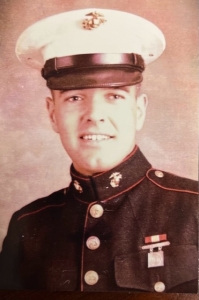 Henri P. Boucher
Henri P. BoucherUSMC; E-3
Vietnam War
Lance Corporal, United States Marin Corps, served from September 1966 through September 1972.
Boucher was born in Lawrence, Massachusetts, in January 1948. At the age of 4, his family moved to Salem, New Hampshire where he graduated from Woodbury High School in 1965 and went on to complete his first year of Electronics Engineering at New Hampshire Technical Institute.
He enlisted in the Marine Corps in August 1966, graduated from Basic Training at MCRD Parris Island and went on to complete his Infantry Training at Camp Lejeune.
Boucher graduated from Communications School at Camp Pendleton, CA and was assigned to FMF WESTPAC. After additional Infantry training with Staging BN at Camp Pendleton he was assigned to various Fleet Marine Force units, including 3rd Force Service Regiment (Japan), 5th Communications Battalion (RVN), 3rd Marine Amphibious Force (RVN), 2nd Brigade ROKMC (RVN). During the 1968 Tet Offensive and siege of Khe Sanh, Boucher was assigned to the 26th Marine Regiment. Upon return from overseas assignments, Boucher was assigned to Base Communications, Marine Corps Base, Quantico.
Upon completing his active-duty service, Boucher returned to Salem, NH and married his High School sweetheart, Joanne Radziwill and continued to serve in the Marine Corps Reserve, Delta Company 1st BN 25th Marine Regiment, until his discharge in 1972.
Mr. and Mrs. Boucher have 2 sons, 5 grandchildren, and 1 great grandchild. They currently reside in Katy, Texas.
Brady, Stephen
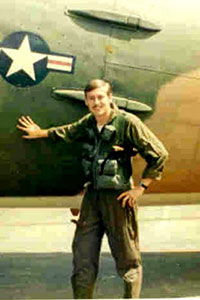 Stephen Brady
Stephen BradyStaff Sergeant, United States Air Force
Stephen served his country from 1970 – 1977, including a tour in the Vietnam War 1972-1973.
Stephen enlisted in the United States Air Force in 1970, to serve my country, which was going to be life-changing and positive experience for him. He says that he will never forget getting on the Braniff Airlines aircraft at JFK Airport and arriving in San Antonio at about 0200 hours. Upon arrival at Lackland AFB, an hour or so later, when getting off the bus, he and his fellow recruits received very loud, commanding, no-nonsense introductions by a pack of Air Force Drill Instructors to: shut up, stand on the painted pavement footprints at attention.
“I’m in the Air Force now!” – Stephen B
“That is one of the many military memories I will never, ever forget. To this day, I am so grateful for their instruction and preparation for what my experiences and future in the Air Force were to hold.” – Stephen B
After basic training at Lackland AFB in San Antonio, he was selected to go to Morse Code Intercept Operator School at Kessler AFB in Biloxi, Mississippi. Stephen receive and assignment to the United States Air Force Security Service (USAFSS) Group (6921st) in Misawa, Japan. The Security Service is an organization within the United States Force’s cryptographic intelligence/Signal Intelligence (SIGINT) branch serving our country 24/7. Stephen was a Morse Code Operator (commonly referred as, “Ditty Bops”) intercepting, analyzing, and reporting ELINT and HUMIT intelligence to the appropriated military commands and civilian agencies.
As a 22 year old, Stephen found himself in a cutting-edge profession involved in the acquisition of highly classified intelligence that was acted upon at the highest levels of the U.S. military and government. He was hooked the mission requirements, working with talented analysts, and the professionalism and esprit di corps of the organization! While assigned in Misawa, Japan, he willingly volunteered for a 90 day temporary duty assignment (TDY) with the 6924th Security Squadron and the U.S. Army Security Agency (ASA) at Ramasun Station in Udorn, Thailand in 1971. The assignment with the 6924th was so professionally rewarding to him, expanding his expertise and knowledge, and the manner in which his duties directly impacted our troops, our allies, in the overall war effort.
On his return to Misawa, Japan, within 24 hours, he requested consideration for a Vietnam combat assignment (based on his 6924th experience) and subsequently received selection to our ARDF (Airborne Radio Direction Finding) Program in Vietnam with the 6994th Security Squadron. This organization performed intelligence activities from the EC-47 electronic reconnaissance aircraft platform. Please note that the EC-47 is the same great aircraft used in WWII by the US Army Air Corps and our Allies. After he was accepted to the program, he attended over 5 months of specialized training at Goodfellow AFB San Angelo, Homestead AFB Miami, Fairchild AFB Spokane, and Clark AFB in the Philippines to prepare him for his upcoming combat assignment.
In June, 1972, Stephen’s world changed dramatically as he found himself in the Vietnam War wearing flight suits, jungle fatigues & combat boots, chow hall powdered eggs & milk, and the well-known C Rations with SPAM (yuck!). Being home-based in Nakhon Phanon (NKP), Thailand, Stephen flew combat missions in and out of NKP, as well as Da Nang and Pleiku, South Vietnam. These combat missions entailed intelligence gathering missions in South Vietnam and Laos supporting the missions of the 7th Air Force and MACV HQ. Stephen taught, “ground school” to new crewmembers and flew 79 combat missions, of which his last mission (Fini flight) was a combat mission over South Vietnam on June 2, 1973, approximately 3 months after the war ended.
During Stephen’s R&R from combat duties in 1972, he flew to Sapporo, Japan, where the winter 1972 Winter Olympics were held, to meet and marry his sweetheart, Laurie. Laurie was in the Air Force and stationed to Misawa AFB, Japan since they met in October, 1971. In Sapporo, they were legally married in the American Consulate and the Japanese Consulate, which was unique and a wonderful experience. There together a little over 48 hours in Sapporo, then Stephen had to return to the War.
Following Stephen’s assignment with 6994th Security Squadron in Southeast Asia, he was assigned to Goodfellow AFB in San Angelo, Texas. During this assignment he became a certified instructor for the USAF upon graduation from the Air War College Academic Instructor Course at Maxwell AFB, Alabama. He subsequently taught at the School of Applied Cryptologic Science at Goodfellow AFB in San Angelo, Texas teaching Ditty Bops, Linguistics and Analysts.
Stephen’s final assignment in the USAF was at Osan Air Force Base in Osan, Korea as a Morse Code Intercept Operator.
Stephen received an Honorable Discharge from the United State Air Force in 1977 and returned to San Angelo to be with his wife, Laurie, also a USAF veteran. After locating to Lubbock, he graduated from Texas Tech University and had a successful career with Amoco/BP Amoco for 30 years. Stephen and Laurie have one daughter, Whitney.
“I am dedicating my Honor Flight to my best friend, Joseph A. (Kiwi) Matejov, who, while flying an EC-47 combat mission (Baron 52) over Laos, was shot down on February 5, 1973. Kiwi gave the ultimate sacrifice, along with his seven crewmembers, all of whom are honored on the Vietnam Veterans Memorial Wall in Washington, D.C. Kiwi and I served together in Misawa, Japan, were like brothers, and we planned to go to Vietnam together. I hope to visit the crew’s communal grave in Arlington National Cemetery when we are there.” – Stephen B
Brantley, Ward
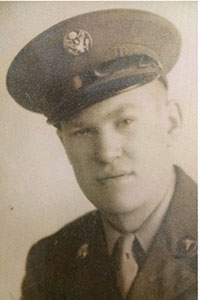 Ward L Brantley
Ward L Brantley
Technician Fifth Grade (T5), United States Army. He served his country in World War II (Battle of “Rhineland Central Europe”) from 1943-1945.
Ward was born in July 1925 in Lovelady, Texas. At the age of 18 he went to Fort Sam Houston and was inducted on October 14, 1943.
He was then sent by train to Rockford, Illinois where he received most of his medical training. With all medical training completed, he was transferred to APO New York, Liverpool England and Embermenil France. It was in Embermenil, France when he joined the 324th Medical attachment of the 44th Infantry Division. He was then assigned to I Company 2nd platoon as an Aid man and sent to war.
Ward fought through France, Germany and then Austria meeting the 5th Army on the border of Austria and Italy. Two weeks after the war was over, he was sent to Liverpool, England to board the Queen Elizabeth to return back to the USA.
Ward was discharged on November 19, 1945 and went home to go to Sam Houston State Teachers College in Huntsville, Texas.
He was honored with a Purple Heart, Good Conduct Metal, Bronze Star, Bronze Star Cluster and 3 Campaign Metal Stars for his time served in the Army.
Ward was also awarded with a longtime foxhole buddy, Richard Jacobs. Beside him in the foxhole Richard lost his right arm. As a Medic and a close buddy, he immediately carried Richard to the Aid Station for help. They have visited each other many times over the years. On one of his visits to Ward’s house, he was having chest pains when he arrived. Ward immediately had to drive him to the Hospital AGAIN.
At least this time he did not have to carry him.
It was not until 1954 when he married Alfredia Lou Lee and had 4 girls, 1 boy, 7 grandchildren and 8 great grandchildren. He was married until November 2014 when Alfredia passed away, just after their 61st Anniversary. Ward and Alfredia Brantley have also been the proud owners of Fluid Mechanics Valve Company since 1972.
Bray, Ron
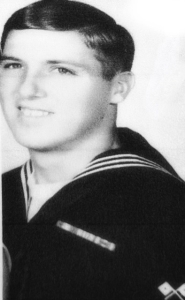 Ronald Bray
Ronald BraySignalman 3rd Class, United States Navy. Ronnie served his country in the Vietnam War from 1967 – 1971.
Ronnie was born in September 1947 in Houston, Texas. He graduated from high school in Houston, TX in 1967.
He enlisted in the Navy in April 1967 and attended boot camp at Naval Training Center San Diego. During his time in Vietnam, he served aboard the USS Whet-stone LSD-27, USS Valley Forge LPH-8, and the USS Cleveland LPD-7. He earned the Vietnam Service Medal with Bronze Star and was under the Ready Group Bravo during the Tet Counter Offensive.
Ron was honorably discharged from the Navy in May 1971.
He married his high school sweetheart ini 1969 and they have been married 53 years. They have 3 children and reside in Hou-ston, Texas.
Bristol, Harry
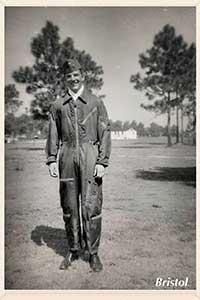 Harry W. Bristol
Harry W. BristolLt. Colonel, USAF
Harry served his country on active duty from 1951-1955 and as a reserve officer from 1955 to 1976.
Harry was born in Fargo, North Dakota in December, 1929. As a four-year member of ROTC at North Dakota State University, he received his commission as a Second Lieutenant on graduation. He was initially assigned to Bartow Air Base, then Ellington AFB and Mather AFB which prepared him as a Navigator-Bombardier for duty in Korea. In 1952, he was assigned to Harlingen AFB as an Instructor – Navigator and where he was later released from active duty in November, 1955. From 1955 to 1976 as a reservist, he was assigned to the 446th Troop Carrier Wing serving in administration and where he retired at Lt. Colonel.
After active duty, Harry became a stockbroker with Paine Webber in Houston. In 1970, he married Judith and they adopted two sons. In 1997, he retired from UBS (Paine Webber). For the past 20+ years, he has been traveling and serving as a volunteer with Meals on Wheels, working in the church office and at the Hospitality Apartments which offers free housing the Houston Medical Center.
Brunson, Clifford
Hospital apprentice Second Class, United States Navy
Brunson served his county in World War II form 1945 to 1946.
Brunson was born in June 1927 in Houston, Texas. He joined the Navy on Feb, 8th 1945 and went through boot camp in San Diego, Ca. then to hospital corpman’s training school in San Diego. Then he was transferred to shoemaker Ca. Navel hospital. From there onto Memphis Naval Hospital and finally ending up at the Naval hospital in Philadelphia, Pa.
Brunson was discharged from the Navy in August 1946. He returned home to Houston and then went to John Tarleton Jr. college in Stephenville, Tx for 2 years and transferred to Texas a&M in College Station, Tx. He married Shirley Hicks in 1949 during his junior year at A&M and moved back to Houston after graduation in 1951. They were married for 33 years before Shirley’s passing. They had a son that’s now living in Houston but did lost two other children in infancy.
He married his second wife, Juanita S. Tuggle in 1986 and were married for seventeen & one half years before her passing in 2003. He claims two grandsons and one granddaughter from his second marriage.
Bundy, Thomas
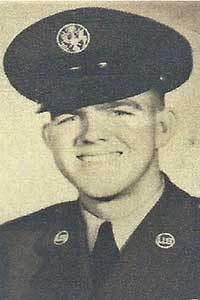 Thomas E. Bundy
Thomas E. BundyAirman Second Class (A2c)
Thomas was born on July 31, 1933 in Joshua, Texas. During World War II his family moved to Clute, Texas where he graduated from Freeport High School in 1951.
After attending Apostolic Bible Institute St. Paul, MN. for one and a half years he and a buddy volunteered in the United States Air Force in November 1954.
.
He took basic training at Parks Air Force Base, CA. Upon completing basic training he was sent to Keesler Air Force Base, Biloxi, MS. Where he completed Air Traffic Control School. Following Air Traffic Control School he went through eight weeks of instructor training and the remainder of his service was spent teaching Air Traffic Control.
In January 1958 he completed his active duty and returned to finish his college education and serve the remainder of his service obligation in the Air Force Reserves.
Burks, Cliff
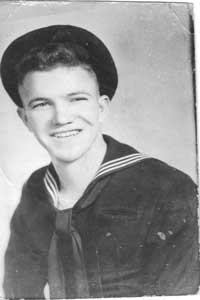 Charles Clifford (Cliff) Burks
Charles Clifford (Cliff) Burks
Burks was born in Jasper, Texas July 15, 1925. His family then moved to Galveston, Texas February 1930 where he was educated.
Burks joined the Navy two months after his 17th birthday. He attended boot camp at the Great Lakes Naval Base in Chicago. He boarded the USS Nevada at Bremerton, Washington November 1942 after repairs from damage sustained at Pearl Harbor December 7, 1941 were completed. The Nevada then sailed from Bremerton December 19 to Long Beach, California, so that the crew could acclimate to the new guns and practice at sea.
Their first encounter was at Japanese held Attu and Adak in the Aleutian Islands off the coast of Alaska. After finishing operations and taking the islands back from Japan, they went through the Panama Canal to the North Sea. Their mission was to escort ship convoys of supplies and troops from the United States to England.
The Normandy Invasion was their next operation June 6, 1944. After several weeks of bombardment in Normandy they sailed to the Mediterranean Sea landing troops on the southern coast of France. In August 1944 they sailed back to the US to Norfolk, Virginia for gun repairs, then sailed on through the Panama Canal to Pearl Harbor. October 1944 they left for the Caroline Islands in the South Pacific Ocean.
Burks’ next operation was Iwo Jima where his ship shot up the islands for two days, and was involved in a tough fight losing several ships and one aircraft carrier.
Japanese suicide bombers were raining from the sky causing many casualties in the fleet.
After watching the raising of the American flag on Mount Suribachi:
All on board cheered the victory.
They left Iwo Jima for the Leyte Gulf in the Philippines to assist in operations there, then sailed on to Mog-Mog back in the Southern Caroline Islands for R & R.
After a few days of R & R they sailed from Ulithy on March 20, 1945 for Okinawa for another tough fight. Okinawa was less than 400 miles from Japan and was where troops were landed on Easter Sunday.
Many men were lost when a Japanese suicide plane struck on the starboard deck and 8” shore batteries pummeled the ship from the beach.
After landing troops in Okinawa the ship went back to Pearl Harbor for repairs. Once repaired, they sailed to the coast of Shanghai to help in clearing numerous mines in the sea. While there the Atomic bomb was dropped on Hiroshima, then another on Nagasaki a week later, which ended the war with the Japanese surrender.
The Nevada sailed back to Pearl Harbor, then on to San Pedro, California where half the crew were allowed to go back home. A few stayed on the Nevada, including Burks, to engage in “Magic Carpet trips.” This involved sailing to islands in the Pacific to pick up stranded troops scattered across the area and bring them back to the United States.
Burks got off the ship in Los Angeles harbor December 1945, caught a train for Camp Wallace, Texas in Galveston County and was honorably discharged December 15, 1945.
Butler, Robert
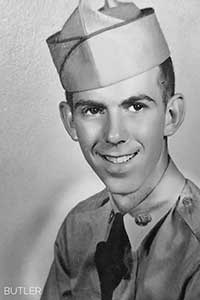 Robert J. (Bob) Butler
Robert J. (Bob) Butler
US Army; TSgt
I was born and raised in Chicago, Illinois. I attended parochial primary school and public high school, then started college at Wilbur Wright College. While attending college, I served in the Illinois National Guard in a Military Police company until drafted into the regular Army.
Once in the Army, I was processed at Fort Sheridan. Moved to Camp Chafee for review of records and then sent to Fort Sill in Oklahoma for basic training and advanced training as a Field Artillery Fire Direction Control Specialist.
After completing training, I was sent to Seattle, Washington for deployment to Korea. I arrived in Japan to be assigned, much to my surprise, to an Observation Battalion in Korea. Upon arrival, I was re-trained in this MOS and assigned to a line company near, “Old Baldy,” mountain.
Serving in both the Command Center and Front Line Bunkers, I served there, gaining rank of TSgt. until rotated home.
Still having time to serve, I was assigned to Camp Atterbury in Indiana to await discharge.
After returning home, I married my high school sweetheart and attended Wilbur Wright College in Chicago. With my studies completed, I worked for Nachman Corporation, a manufacturer of products for the bedding and furniture industry in the office and in the field as a sales representative; Brandwein Corporation, a bedding manufacturer in sales, and then with Diebold Inc., a manufacturer of bank equipment and office systems equipment. I was transferred to St. Louis, MO by Diebold and stayed with Diebold until 1975 when I took over their St. Louis sales branch forming my own company as an independent dealer for Diebold. I continued as an independent dealer until 2005, when I retired.
Over time, my wife and I had 3 children; now married and on their own living in the Midwest. They have given me 8 grandchildren and 9 great-grandchildren. Having lost my wife in 1998, I met, through mutual friends, a Texas lady whom I married in 2005 and moved to Texas where I now reside.
Cabrera, Jimmy
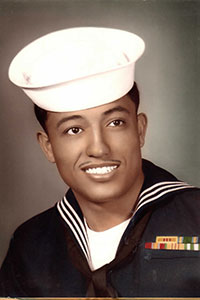
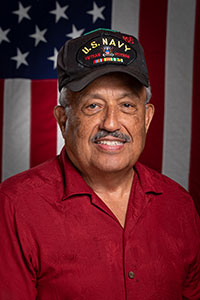
Jimmy Cabrera
CYN 3RD Class (Communications Yeoman Petty Officer 3rd Class)
United States Navy.
Served his country during the Vietnam War Era from July 1965 to July 1969
Jimmy was born in September 1944 in Amherst, Texas before his family moved to Muleshoe, Texas.
He was drafted in June of 1965 and he did not want to go into the U.S. Army, choose to enlist in the U.S. Navy on the 7th of July 1965. He went to Navy Bootcamp in San Diego.
After Bootcamp he was sent to Norfolk, VA. for Communication Yeoman ‘A’ School. He was assigned to the 7th Fleet for orders to work in the top secret communication centers with other Radiomen wherever deployed.
His first deployment was to the USS Annapolis AGMR-1. He boarded the ship in Subic Bay, Philippines in November 1965. The ship was stationed off the shores of Vietnam as a communications center for the 7th Fleet.
Second deployment was in November 1966 to the USS Prairie AD-15. Where he was just on this ship for 30 days. He started to experience some health issues (Thyroid).
In December he was admitted to the U.S. Naval Hospital in December 1966 for observation and treatment. Where he was diagnosed with Hyper-Thyroid and had surgery (Subtotal Thyroidectomy). He spent one year at the U.S. Naval Hospital.
After recovery from the surgery he volunteered for an assignment to Vietnam. In January 1968 he was sent to Survival School in Warner Springs, CA.
In February 1968 was deployed to Saigon, Vietnam to join the Com7thFltDetCharlie Unit (Communication 7th Fleet Detachment Charlie) which was located in the Tan Son Nhut Airbase in Saigon, Vietnam. He was also sent TDA to Monkey Mountain in Da Nang area for two months.
His last deployment was in April 1969 on the USS Ticonderoga CV-14.
Jimmy was honorably discharged from the Navy in July 1969 in San Diego, CA. He returned to his home in Texas for 3 months and decided to return back to San Diego to begin his next phase of life. He became a Real Estate Salesperson. Then in April 1975 he met Laural and married her in August 23, 1975. They have three children and two grandchildren. In 1980 he moved his family back to Texas (Houston).
At present Jimmy Cabrera, CSP has been a Professional Speaker for over 37 years. You can visit his website: www.JimmySpeaks.com.
Because of the Thyroid Surgery he had in the Navy and what he experienced in Vietnam he has several service connected disabilities which includes PTSD. As a disabled-veteran he has gone out of his way to encourage and help fellow veterans dealing with PTSD.
Callahan, William
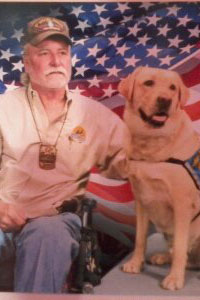
William “Bill” Callahan
United States Army
My name is Bill Callahan. I’m better known to Vietnam vets as, “The Walking Man.” I earned that name by walking across the United Stated to draw public awareness to almost 58,000 names on the Vietnam War Memorial (The Wall) and the thousands more that died from suicide or Agent Orange and 2500 POWs and MIAs left behind and are not forgotten.
I was Medivac by 85th VAC Hospital to Zama, Japan, then to Scott Air Force Base, and then to Walter Reed. After being in a wheelchair for years, I underwent a long surgery and a lot of therapy, I could get up and walk again.
The operation didn’t last long. I’m back in a chair again. I’m involved with the American Legion, VFW, Texas Paralyzed Veterans, Houston Livestock Show & Rodeo (32 years), Office Down, Thin Blue Line, Make-A-Wish, and several breast cancer groups. It helps me open the doors for a lot of other veterans when I try to help them by doing benefits or whatever it takes to help a brother or sister.
In my eyes, there is no branch of the service. We are a band of brothers & sisters, no matter what ware we fought in, we will always stand together.
I think this trip for the Vietnam vets will give some closure and bring us closer home.
I want to say, “Thank you,” to Honor Flight Houston for selecting me and other Vietnam vets. I’m hoping that my brothers & sisters on this flight, when they come back, will share this trip with America so we can help Honor Flight Houston make more trips possible for veterans from all wars.
God bless America. God bless our troops.
Caltzontzint, Luis
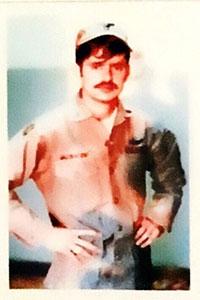
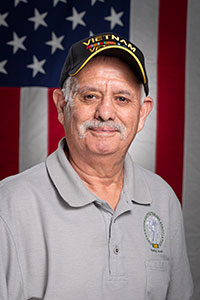
Luis “Cal” Caltzontzint
U.S. Army; SP/5
SP/5 Luis “Cal” Caltzonzint
U.S. Army Helicopter Aviation
Basic Training in Fort Bliss, El Paso
A.I.T. in Fort Rucker Alabama
Military Service Date of Entry: September 30, 1968
Military Service Separation: August 27, 1971
Vietnam Date of Service: 1969 – 1970
Assignment Vietnam: 176th Assault Helicopter Co., Chu Lai, Vietnam I Corps
Assignment Aschaffenburg, Germany Airfield: H.H.C. 3rd Infantry Division
Assignments while in the military involved Huey, OH-13, 206 A&B Helicopter Maintenance and Crew Chief
Helicopters under my responsibility: UH-1, Huey H, C Models, OH-13, 206 A&B Models
Awards: Vietnam Service Medal w/3 Bronze Stars // Republic of Vietnam Gallantry Cross with Palm Unit Citation Badge // Army Commendation Medal // Aviation Badge // Expert Marksmanship Qualification Badge w/Rifle Bar // Overseas Bars // 3rd Brigade H.H.C. Infantry Unit Citation
Calzada, Julian
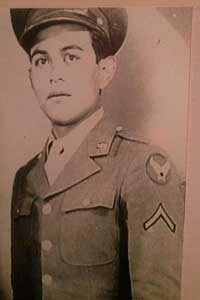 US Army Medic Tech 5 (Tech Corporal)
US Army Medic Tech 5 (Tech Corporal)
Served his country from December 1942 until January 1946.
Calzada was born May 1, 1922 in Kingsville, Texas, home of the King Ranch.
Prior to serving his country, he worked in the Kingsville Hospital for six months and thus when he entered the Army he was sent for training in El Paso’s General Hospital. After a month’s training he was shipped to Fresno, California and assigned to the Air Corp at Camden Airfield for the next 9 months.
In mid-January 1944 he was shipped to New Guinea from San Francisco, California.
He spent the next 13 months frog jumping in the East coast of New Guinea.
In October of 1944 he was sent to the island of Leyte in the Philippines where he served from October 1944 to January 1945. In January 1945 he was sent to the Island of Manila until August when he was sent to Japan after the bombings.
He left Japan December 23, 1945 and returned to San Diego, California where he was honorable discharged in mid-January 1946.
He returned to Kingsville, Texas and married Lucia Falcon Cardenas and had five children.
Julian celebrated his 92nd birthday on May 1, 2014 and has 12 grandchildren and 14 great grandchildren.
Camarillo, Castulo Jr.
Sgt. E-5 U.S. Army
Castulo was born in San Juan, Texas on May 16, 1945. He was drafted on April 18, 1966. Had my training in Fort Polk, LA. My Mos. Was 11B40 Infantry. I was flown to An Khe, Vietnam. After one week, was flown to Phan Thiet, Vietnam where I served one year with 1st Calvary Division B 217 1st Platoon.
Capello, Joseph
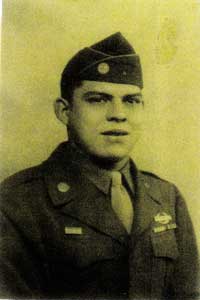 Capello was born on February 20, 1925.
Capello was born on February 20, 1925.
He was inducted into the Army on March 4, 1943 at Fort Sam Houston. He received basic training in Missouri for 2 months before being sent to Alamogordo, New Mexico for 7 months on a Bomb and Gunnery Range. This was a closed range site that was utilized for testing the Atom bomb.
Capello was then sent to Boston and on to the Port of New York. He departed from New York on December 5, 1943 and landed in Scotland on December 15, 1943 as a replacement to the Air Force for 1 year.
Capello was part of a group who were surplus to the Air Force. Ground troops were needed after D-Day, and they were sent as replacements to the 9th Armored Division in France. This was around January 21, 1945.
At this time they liberated a concentration camp in Weimer, Germany – the name of the camp was Buchenwald.
Capello was fortunate to have a camera and took actual pictures of his fellow soldiers guarding the camp. He still has these pictures in his possession. His occupation in Germany was for 9 months.
Capello proudly served his country and was honorably discharged February 8, 1946.
He married his wife in 1952 and together they have 2 children, 5 grandchildren and 1 great-grandchild.
“By serving my country I was able to meet many families in England and Germany. I was able to correspond with them and through the years they have visited me in my home and I visited them in Germany and England.”
Carper, Phyllis
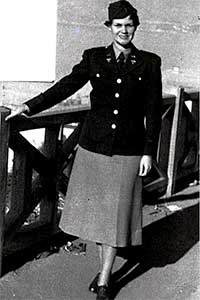 I joined the U.S. Cadet Nurse Corps #232216 in 1946. In 1948 I graduated from Northwestern University with a B.S. in nursing from the Evanston Illinois Hospital. I stayed at the hospital for the next two years to repay the Nurse Corps for my education.
I joined the U.S. Cadet Nurse Corps #232216 in 1946. In 1948 I graduated from Northwestern University with a B.S. in nursing from the Evanston Illinois Hospital. I stayed at the hospital for the next two years to repay the Nurse Corps for my education.
By 1950 the Korean War began. I enlisted in the Army Nurse Corps as a 1st Lt. We had Basic Training at Ft. Sam Houston, Texas. Next I went to Letterman Army Hospital in San Francisco CA. Then I served three years in Japan at a number of posts, Tokyo, Keyoto and Camp Drew in Hokido Japan.
I met and married my husband at Sopporo Hospital Japan, where we were both stationed at the 8164st Army Hospital.
The Korean War was a difficult “adventure” for America and Me.
Next the new husband, a 2nd Lt. MSC officer took early release from the Army. I was discharged from the Army in 1954 at Camp Stoneman CA. We both went back to his home state of Virginia where he began a private practice of Optometry.
In 1960 the Army recalled him to active duty so off we went to France for three years. I love that and we toured Europe.
At each place we moved to I was back to nursing, so all total I worked 20yrs as an RN.
In the 1970s we adopted 2 children, a Boy Charles and a girl Amy. We were stationed at Ft. Hood Texas at the time.
Charles was killed at 24yrs in a job related accident. Amy is married at 46 with two children and lives in Colorado.
Our travels have been France-Japan-all over the USA at posts-ending in Louisiana where my LTC husband retired from the Army after 32yrs.
Husband Robert R. Carper was a Virginia Native, I was an Illinois Yankee: but we seemed to make it work.
After 60yrs of marriage Bob died 5 yrs ago. I maintain the house and life here in LA. At 91 I am in good health except for a breaking a hip a few years ago.
I remain active in Church, the Community and life. I have a wonderful support group of women here-so I am content.
Cartwright, Thaddeus
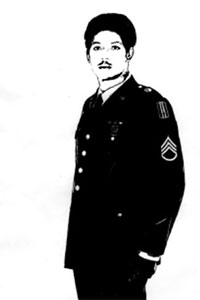 Thaddeus E. Cartwright, Jr.
Thaddeus E. Cartwright, Jr.
United States Army/SSG E6
SSG. Cartwright was born in Baytown, Texas on July 29, 1951. He is a graduate of Ross S. Sterling High School. He was an outstanding football and baseball player.
SSG. Cartwright was drafted in December, 1970. He attended basic and AIT at Fort Ord, California. After AIT, he was selected for the NCO Academy in Fort Benning, George, where he graduated first in his class. This lead to several prestigious appointments such as Infantry School, MAC-V HQ RSV, Platoon Sgt 9th Infantry Ft. Lewis, Defense Race Relations Institute (DRRI), and HG CO 193rd Infantry Div. Panama.
SSG. Cartwright left the Army in March, 1978.
SSG. Carthwright returned to Texas and is happily married. He and his wife, Mary, are proud parents of 5 children, 21 grandchildren, and 3 great-grandchildren. They spoil them as much as they can!
Cashman, Colleen
Cejka, Abdon
I was drafted into the US Army in January of 1953. It was at Fort Sam Houston in San Antonio, Texas. This was where we got our uniforms, work fatigues, shoes and some vaccines. Right away I learned about night KP Duty and for some reason worked night KP for most of my time in the Army. We then were flown to Evansville, Indiana in Dec by way of Leavenworth, Kansas where some were left. Then to Indiana where we took a bus to Camp Breckenridge of the 101st Air Born Division which made me so proud to be part of such a famous Army division. Basic was tough, but always the Army food was very good. After Basic we got a 7 day leave to make our way to Tacoma, Washington in August. It was cool, rainy, and beautiful with all the forest and Mount Rainier to the East. Then we took a ship the Marine Lynx out of Puget Sound and the Northern Route by the Aleutian Islands and we let some off at Adak, Alaska. Then on to Japan’s most Southern tip where we stopped on Labor Day of Sept 1953. Then on a larger ship we went to Pusan, Korea which was in recovery from the siege by the Chinese Army shortly before. We then went by train to Chun Chow to the 38th Parallel where I stayed for most of my time in the 45th Oklahoma National Guard Division. We would stay at the 38th Line for some weeks then 2 weeks of training to the farm lands farther south in Korea. About a year went by and the 45th left for home and I went to the 2nd Texas Army Division where I witnessed the drowning of my neighbor Richard Judd of Hallettsville in the crossing of the Han River. After this I was transferred to the 25th Army Divison and soon left Korea on the General Jordan Ship for the Hawaii Islands where it was beautiful. The very famous Schofield Barracks there was the home base in the middle of the island where we trained and had rifle shooting practice in the mountains. I received a very high score of 370 and got my Sharp Shooter Badge. After this we took a ship to San Francisco, California then a train to El Paso, Texas where I was honorably separated from the Army in Feb of 1955. In all of this time I was proud of my service to the United States of America. I lived and worked for 64 years in Houston, Texas. In 1964 I married Elda Montemayor and we celebrated our 50th anniversary before she passed away in 2013. We had 3 children and I now have 5 grandchildren that enjoy visiting me on my farm in Schulenburg, Texas.
Chambers, Kennon
 Chambers was born in Italy, Texas on July 14, 1923. He was the youngest of three boys, all three served in the war.
Chambers was born in Italy, Texas on July 14, 1923. He was the youngest of three boys, all three served in the war.
His time in the service started in January 1943. He received basic training in San Diego, California. From there his training was at several bases across the U.S.
Chambers was shipped out April 1945 to Saipan where he served as a Machinist 3rd Class until the end of the war.
He was discharged in December 1945.
Chivers, Algernon
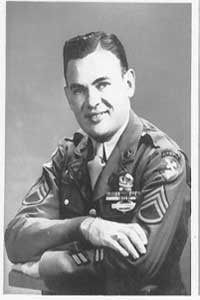 Staff Sergeant, Company H503rd Parachute Infantry Army of the United States. Chivers served his country in World War II from 1939 – 1945.
Staff Sergeant, Company H503rd Parachute Infantry Army of the United States. Chivers served his country in World War II from 1939 – 1945.
Chivers was born on July 5, 1921 in Beeville, Texas
He enlisted in the Army September 9, 1939 and trained at Fort Sam Houston.
Chivers was appointed to the Woman’s Army Auxiliary Corps (WAAC) under the direction of the first director of the Woman’s Army Corps, Colonel Oveta Culp Hobby. He was assigned to set up three hotels (Savery, Chamberlin and Plaza) that was taken over by the U.S. Government for the first women coming into the Army Corps which he received accommodations for.
Chivers was assigned with the detail of 18 men to set up Fort Devens for the Fort WAC Devens training center.
Chivers then trained to become a paratrooper and was sent to Leyte in the Philippines. He jumped on Corregidor and fought the Japanese.
He fought in Negros Island and received a Purple Heart, Silver Star and Bronze Star. Chivers was wounded just before the war ended and received 100% disability.
Chivers was discharged from the Army on Christmas day 1945. He returned to Texas and became a Hotel and Country Club Manager. He married in November of 1947 to Alice Burns (from Belgium) who he was married for 65 years before Alice’s passing in 2011, just shy of their 66th wedding anniversary. They have three children, three grandchildren and 5 great grandchildren. They all reside in Houston, Texas.
Chivers, Bill
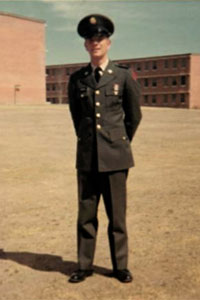 Bill Chivers
Bill ChiversSergeant, US Army
I was drafted in 1966. Sent to Fort Polk and after about a week, I was sent to Fort Carson Colorado.
After about a year, I was sent to the 199th Light Infantry Brigade in 1967. I spent one year there which included the 1968 TET Offensive.
I lost eight buddies from my high school class. I returned home through California – all the name-calling and spitting was going full-force in 1968.
I was married in 1972. I have one daughter and one grandson.
I would do it all over again if called.
Ciaccio, Louis
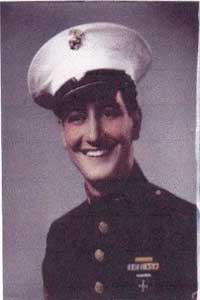 Technical Sergeant in Aviation Communications – United States Marine Corps
Technical Sergeant in Aviation Communications – United States Marine Corps
Marine Airgroup 13
Served from January 2, 1942 to October 20, 1945
Ciaccio was born November 12, 1921 in Galveston, TX
At age 19, Ciaccio worked at Todd Ship Yards in Galveston rebuilding ships for England until the attack on Pearl Harbor on December 7, 1941.
The next day, Ciaccio joined the Marines and was sworn in on January 2, 1942.
After boot camp in San Diego, California Ciaccio was deployed to American Samoa in the Pacific. Ciaccio next journeyed to the island of Funafuti and then to Roi & Namur in the Marshall Islands. Ciaccio served in the Pacific for 22 months. Ciaccio then returned to the United States for a few months and then to Hawaii for the remainder of the war. He was discharged from the Marines on October 20, 1945 in San Diego, California.
After the war, Ciaccio met the love of his life, Marianne Stone. They were married in 1947 for 62 years. They have three children, four grandchildren and seven great-grandchildren.
Ciolli, Paul
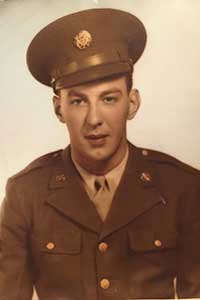 Paul was born in Youngstown, Ohio, February 21, 1923. His father had voluntarily joined the U.S. Army as an Italian citizen and served in Europe in WWI thereby earning citizenship for his family.
Paul was born in Youngstown, Ohio, February 21, 1923. His father had voluntarily joined the U.S. Army as an Italian citizen and served in Europe in WWI thereby earning citizenship for his family.
Following his father’s example to serve, Paul enlisted in the army reserves in December 1942. At that time he was in his second year of college at John Carroll University in Cleveland, Ohio on a football scholarship. He was called to active duty in April, 1943 and was sent to Camp Wallace in Hitchcock, Texas. During that training, on a weekend pass to downtown Houston, he met his future wife, Margaret Sullivan.
He was promoted to staff sergeant and served in the Anti Tank company 262nd infantry regiment, 66th infantry division. The 66th division was sent to Fort Robinson in Arkansas and on to Camp Rucker, Alabama where he and Margaret were married in the chapel at the Camp.
The 66th was ordered to Europe, destined for France and the Battle of the Bulge. They boarded the ship Leopoldville on December, 23, 1943. Fate intervened when Paul and some of the 66th were taken off the ship because of a mix up in their paper work. They boarded the next ship header to Cherbourg, France. at midnight on Christmas eve, 1944 the Leopoldville was torpedoed and more than 900 men lost. because of devastating losses to the 66th division, Paula n the remaining soldiers of the 66th were sent to serve in Hennebont in the St. Nazaire region of France.
Toward the end of his service in France Paul enjoyed playing center in the Army Vs. Army football game on January 1, 1945. the game was played in the football stadium in Marseilles, France and was attended by hundreds of soldiers and U.S. General John P. Ratay. Paul’s team won and the general presented the trophy.
Paul was honorably discharged February 7, 1946. He received the good conduct medal, American THR Service Meal, EAME THR service medal W/1 Bronze Star and the Victory Medal.
Paul and Margaret were married just shy of 67 years before Margaret passed way. They have five children, 16 grandchildren, 20 great grandchildren, and 3 great- great grandchildren.
Clark, James
 Gunners Mate 3rd, United States Navy
Gunners Mate 3rd, United States Navy
Served in World War II from 1944 – 1946
Clark was born in Elizabeth, Louisiana and lived in many different places throughout Texas before settling in Orange, Texas.
He enlisted on September 29, 1944 and went to San Diego for basic training. He was assigned to the USS General S. D. Sturgis (AP-137), a troop transport ship, and spent his military time aboard this ship.
While on the USS Sturgis he visited many world ports including Marseille, France; Calcutta, India; Port Said, Egypt; Manila, Philippines; Gibraltar, Holland, New Guinea; and Nagasaki, Japan.
His ship carried officers and officials of the United States, Australia, Canada, Netherlands, East Indies, China, and the Philippines. Delivering them to Tokyo Bay August 21, 1945 to witness the historic Japanese surrender ceremonies on September 2, 1945, thus ending World War II.
He was discharged from the Navy on July 2, 1946 and returned home to Orange, Texas. He married Mary Sinclair on April 7, 1956. They have been married 58 years and have three children, eleven grandchildren and two great-grandchildren.
Clark celebrated his 88th birthday on April 8, 2014.
Cohn, William
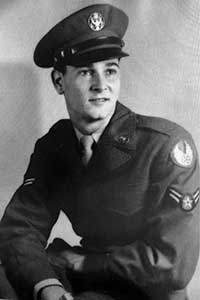 WILLIAM F. COHN
WILLIAM F. COHN
S. Sgt Cohn served his country in the Korean War from 1950 to 1952.
William (Bill) was born in Cleveland, Tx on January 21, 1930, where he lived his entire youth.
All male members of his immediate family served in the military: His dad was a 1st Lt. in WW I, and both brothers served in WW II. Since all had served, he volunteered for the Air Force on January 20, l950. He served his Basic Training at Lackland AFB in San Antonio, TX and later was assigned to Kelly AFB in San Antonio TX. His second assignment was at Perrin AFB in Sherman-Dennison, TX. Both assignments were in Hq & Hq Squadron.
At Perrin AFB, he met and married his wife, Tan, and, this year 2019, they will celebrate their 69th year of marriage.
He was discharged in 1952, and after one year of work, he attended the University of Texas at Austin TX where he earned his BBA and JD degrees. His working career included 29 years at Exxon-Mobil from which he retired in l986.
Coker, Ray
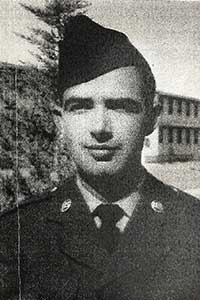 Mansel “Ray” Coker served his country in the US Air Force from October 1954 until February 1965.
Mansel “Ray” Coker served his country in the US Air Force from October 1954 until February 1965.
Mansel was born in Parkdale AR in January 1933 to Paul and Audrey Coker. After World War II they moved to Crane TX where his father worked for Gulf Oil Corporation. Ray grew up in the oil fields there and graduated out of high school at 17, worked 2 years so he could afford to attend Junior College in Odessa TX. He joined the Air Force in 1954 instead of being drafted into the army, he was fortunate that he was sent to technical school at Keesler AFB in Biloxi MS. After Tech School he was sent to Barksdale AFB in Shreveport La. As an Electronic Countermeasures Technician (ECM). He was a Technician until 1959 when he re-enlisted for 6 years to attend officers candidate school, he made it through the lower classman but the Air Force only approved 85 second Lieutenant commissions in class 59 C . Both he and another 100 upper classmen were flunked out of OCS. Since he had field training in ECM he was sent to Keesler AFB to teach ECM, after about a year of teaching ECM the Air Force asked for volunteers to go to Kingston NY’s IBM federal systems division and learn computers. He came back and help set up the first computer school the Air Force had, and when he was getting close to re enlistment time, he got a nice letter from IBM Huntsville AL, Federal Systems Division asking him to come interview for a job. IBM was manufacturing the computers for the Apollo Saturn V Launch Vehicle program. He lived in Huntsville one year when he was asked if he would enjoy going to Houston to Johnson Space Center and work as a Flight Controller on all the Apollo missions. Ray supported all the Apollo missions and the first Shuttle Mission and as then retired from IBM. He is now enjoying retirement as well as working part time in a company that he formed with his sons that does environmental work; refrigerant recovery and reclamation; in the Houston TX area. Ray married Patricia Ann Sales in 1954 while he was in Shreveport LA at Barksdale Air Force Base and they were married for 55 years until she passed away in 2013. They had 3 sons, Ray is working with 2 of them and one lives in Austin Tx with his wife. Ray has 2 grandsons that live in the in the Clear Lake area.
Cole, John
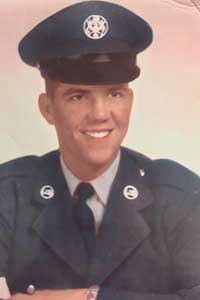 John Adrian Cole, Jr.
John Adrian Cole, Jr.
I was born June 29, 1935 in Columbus, Georgia. I moved to Freeport, Texas in 1942 living at Camp Chemical. I attended school in Houston, Texas, graduating from Charles H. Milby High School in May of 1953.
I joined the Army National Guard in June 1953 and was assigned to the 49th Armored Division in Tanks. In November, 1953 I transferred to the 509th Air Refueling squadron, 509th Bomb Wing. I spent time in the SAC unit at Harman AFB in Newfoundland, Goose Bay Labrador, Thule Greenland, Alaska and Lakenheath, England. I was a crew chief on a KC 97 Air Refueler. I was discharged August 17,1957.
I returned home to Houston, Texas and married Bonnie Cole. Our extended family includes 2 children, 6 grandchildren and 13 great grandchildren. I worked for Houston Light & Power Co. as a lineman, then for Southwestern Bell Telephone as an installer and troubleshooter. I got into Law Enforcement as a Brazoria County Constable Pct. 4 and retired in 2006. After retiring I was appointed Municipal Court Judge and currently still hold that position in West Columbia Texas.
Colwell, Joesph
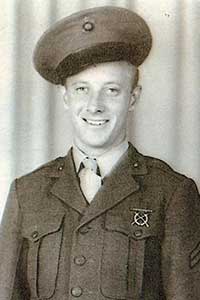 Joseph M. Colwell
Joseph M. Colwell
Corporal, United States Marine Corps. Colwell served in World War II from 1942-1946.
Colwell was born August 1921 in Hudson, New York.
He enlisted July 7, 1942 and went through 9 weeks of boot camp training at Recruit Depot in Paris Island, South Carolina. On completion of boot camp training he was assigned to MAW-3, MAG23 in Cherry Point, North Carolina.
In March 1945 Colwell was ordered to Oahu, Hawaii and upon arrival was sent to Midway Island. He was assigned to a job in the truck company where he moved ordinance and personnel to the planes and he also volunteered to fly dawn/dusk patrol where he would go out and look for Japanese ships coming into Midway.
When the war ended Colwell was ordered to Okinawa, Kadena air field and was sent back to the states in Treasure Island, California. In March 1946 he was discharged in Bainbridge, Maryland.
Colwell returned home to Hudson, New York and married his love Frances Kurowsky in 1946. They have 3 children, 4 grandchildren and 3 great grandchildren. They were married 62 years when she passed.
Colwell’s service to his country didn’t stop after his discharge in 1946. He continued to serve in different capacities that included the Hudson Police Force, the Hudson Volunteer Fire Department, the Houston Post Office starting as a carrier, then moving to Foreman of the Mail, then as a Route Inspector and then later retired as Superintendent of Route Inspectors after 18 years of service. He also served as Tax Assessor for Harris County, Texas and Comal County, Texas and on the fire district board in New Braunfels, Texas.
Combs, Clyde
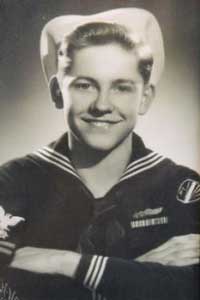 My name is Clyde O. Combs and I was born in Louisville, Kentucky on September 15, 1924. However, my family moved to Indianapolis, Indiana when I was two years old. I graduated from high school there in 1942, and World War II had been going on for six months, after the Japanese attacks at Pearl Harbor. I had been working in a “defense plant” after school, designing the machinery to build fighter planes and continued working there for eight months after graduation.
My name is Clyde O. Combs and I was born in Louisville, Kentucky on September 15, 1924. However, my family moved to Indianapolis, Indiana when I was two years old. I graduated from high school there in 1942, and World War II had been going on for six months, after the Japanese attacks at Pearl Harbor. I had been working in a “defense plant” after school, designing the machinery to build fighter planes and continued working there for eight months after graduation.
I then joined the U.S. Navy in March of 1943 and went to boot camp at Great Lakes Naval Training Station, north of Chicago. After nine weeks of basic training, we were given aptitude tests and I was selected to go to quartermaster school for three months to learn navigation, signaling and all other “Rules of the Road”, pertaining to the navy. After completion of quartermaster school, they asked for volunteers for PT boats. I volunteered, not even knowing what a PT boat was. I soon learned.
Our training for PT (Patrol Torpedo) boats was at the Motor Torpedo Boats Squadrons Training Center in Melville, Rhode Island. Our very thorough training taught us to take over the duties of our shipmates, if the occasion should arise. There were only twelve men on PT.
We picked up our new boat, just built in Bayonne, New Jersey, and were assigned to Squadron 35 (twelve boats to a squadron). My boat was PT 515. (President Kennedy was PT 109). Most PT boats up to this point served in the Pacific area, and we were scheduled to go there also, but our orders were changed and we joined a huge convoy of ships heading for Europe. We arrived at our PT base in southern England on June 4, 1944, just two days before D-DAY in Normandy, France. We just had enough time to take on fuel and ammunition to prepare for the upcoming invasion.
The mission of the PT boat squadrons during the invasion was to provide a line of defense at the western flank of the Utah beach landings, to prevent any interference from German vessels, during the invasion. We also went on nightly patrols, seeking the enemy. We lost one boat and its twelve-man crew off of the German held Channel Islands area.
I feel very privileged to have served my country in this massive, world changing invasion and proud to have been a “PT Boater.”
Our mission was complete in November 1944 and we gave our boats to the Russians and came home. I was honorably discharged in 1945 at Quartermaster Second Class.
**Clyde received the French Legion of Honor Medal on the 70th Anniversary of D-DAY in Normandy, France for his services during World War II.
Coody, Jack
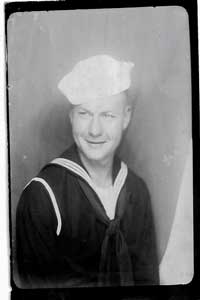 Volunteered for U.S. Navel Services at age 17; January 8, 1945.
Volunteered for U.S. Navel Services at age 17; January 8, 1945.
Spent 10 weeks of boot camp in San Diego, and 6 weeks of radio operator school in Los Angeles, CA.
Assigned ship duty on a tanker, the USS Natchaug, and our duty was to keep ships refueled at sea in the Pacific Ocean.
Our position was near Japan when both the atomic bombs were dropped.
My enlistment was extended 90 days due to me being the only radio operator left aboard ship.
My replacement came aboard in July of 1946, and I was discharged in Galveston, Texas in August of 1946.
Cooke, Ronald
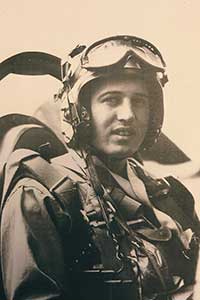 Ronald W. Cooke
Ronald W. CookeCommander, USNR Ret.
In July 1948, I joined the Marine Corp Reserve and trained as an aircraft mechanic for the FG-1D Corsair. In August 1949, I transferred to the Naval Aviation Cadet program, and reported to Pensacola, Florida for pre-flight. I qualified for advanced training in late 1950 with 6 landings on an aircraft carrier, and was transferred to Corpus Christi, Texas for fighter training in the Hellcat F6F. In April 1951, I received my wings and commission as an Ensign, and was sent to San Diego Naval air station North Island.
After two months in Hawaii for night fighter school, I was assigned to VF-871 just returned from Korea, flying F4U-4 Corsairs. We trained in close air support work waiting for delivery of jet fighters. Unfortunately, the new planes did not arrive in time, so we deployed in June 1952 on USS Essex for Japan. We cruised off Korea for 8 months, and I flew 53 combat missions, and I was struck by ground fire several times, one 35 mm shell tearing a 4-foot hole in my wing, making an emergency landing in Korea necessary.
After the truce, I checked out in jets, and flew in Utility for a year, and then was discharged to attend the University of Michigan where I received a Master’s Degree in Aeronautical Engineering. During my 4 years of college, I served in the reserves, and in 1957 I spent 2 months at Pensacola learning to fly helicopters. I flew helos for 11 ½ years until I retired in 1968, last serving as CO of HS731, an anti-submarine helicopter squadron.
After graduation from U of M, I worked for Bendix Aerospace, where I spent 5 years in Quebec, Canada. I learned French there and married a Quebec Nurse. After Bendix, I worked for Warner Electric Brake & Clutch, E. Edelmann & Co. automotive as VP Engineering, and Nypro as President of their Galesburg, II injection molding facility.
I moved to Kingwood, TX in July 1981 with my wife Lise, and our two girls and son, and built swimming pools for 20 years, retiring at 71 years old. Now a month away from 90, I am still active, have a current pilot license, and often fly with my son in his open cockpit stunt plane which did air shows around Houston for many years.
My son Brett, who also served in the navy, earning the rank of LCDR, will accompany me as my guardian. We once spent a few days together on a Tiger cruise between Hong Kong and Japan, where I relived old memories. Brett submitted the application for this honor.
I am looking forward to this Honor Flight as one of the highlights of my life.
Cormier, Elbert
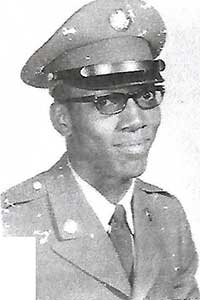 Elbert Cormier
Elbert Cormier
United States Army BTRY D 6TH BN 562D ARTY APO 09039 USAREUR
Entered U S Army February 25, 1965
Elbert entered basic training at Fort Polk, Louisiana. He also did AIT training at Fort Bliss in El Paso Texas. After AIT training, Elbert boarded the U.S. Bunker Ship and sailed 14 days to Germany, Port of Hamburg. From there he was trucked to Fulda Germany where he started an 18 month Tour of Duty. I enjoy playing football, baseball, basketball sport activities and reading in my leisure time during my deployment in Germany. I received an honorable discharge February 9, 1967. At that time, I receive a rank of Specialist 5, E-5. Upon my return, I worked at the Southern Pacific Railroad from June 1968 until my retirement in 2009. As a retiree I now enjoy spending time traveling. When I am not traveling, I participate at events with Senior Citizens.
Cortez, Israel
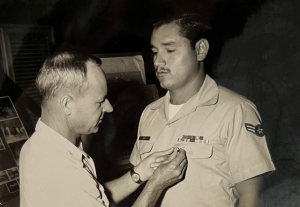 Israel Cortez, Jr.
Israel Cortez, Jr.
Israel volunteered in the US Air Force from 1968-1972 after graduating Bellaire High School. His basic training was in Amarillo, TX not Lackland Air Force Base in the month of February.
His first duty station was Carswell Air Force Base Texas. He then volunteered for Viet-Nam in 1969 for one year in the Transportation Squadron. He was awarded the Commendation Medal while in Viet Nam. His last two years serviced at Barksdale Air Force Base known as Strategic Aire Command in Field Maintenance supporting ground power equipment on aircrafts.
Israel was Honorably Discharged at rank of Sergeant in February 1972. He returned home to Bellaire where he got his first job with Mosler Safe Company.
What he got out of serving in the military is helping other veterans get their benefits through VFW, American Legion, VVA and the DVA, which he is a life member of all four.
“What a great nation I live in – God bless the USA!”
Crass, Don
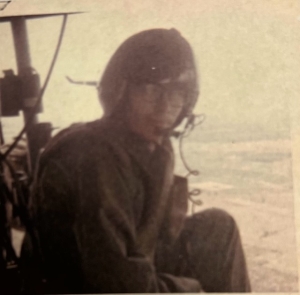 Don Crass
Don Crass
US Army; Specialist E-4
Vietnam War
Don Crass was born in Big Spring, Texas in 1943 and raised in Ackerly and Midland, Tex-as. He graduated from Midland High School in 1961 and went to Electronics School in Louisville, KY.
He worked for McDonnell Aircraft in St. Louis, MO on the flight line for the F-4 Phantom as an autopilot and weapons technician from 1963 until he was drafted in October 1966.
After basic training at Ft. Bliss, TX, Don was sent to AIT at Ft. Eustis, VA for helicopter powertrain training (MOS 68D20). In March 1967, Don graduated as the Honor Graduate in Class 68D20 #9. He was then sent to Ft. Sill, OK and assigned to the 154th AVN where he worked in the powertrain shop on CH-47 Chinook. In September 1967, Don was promoted to SP-4.
In January 1968, Don received orders for Vietnam. He was assigned to the 393rd Transportation Detachment, “Witchdoctors,” which was attached to the 128th Assault Helicopter Company, “Tomahawks,” at Phu Loi Base Camp, Vietnam. The Company commander said that he had no need for Don’s MOS and asked if Don would be willing to go on flight status. Don was sent to Bien Hoa Air Base for a flight physical. After returning to Phu Loi, Don flew as a door gunner in the UH1 Huey and worked in the helicopter electrical shop.
Don was honorably discharged from the Army in October 1968. He returned home to Tex-as where he attended the University of Texas Austin on the G.I. Bill. Don worked in Austin as a mainframe computer Field Engineer for Ford Aerospace. In 1977, Ford Aerospace promoted Don to be the Engineer in Charge of the mainframe computers for the government in the Washington, DC area.
In November 1978, Don moved to Houston with Ford Aerospace to work in the Mission Control Center at Johnson Space Center as a contractor. Don went to work for Amdahl Computer Systems in 1981 as a mainframe specialist. Amdahl was later taken over by Fu-jitsu America. Don retired in 2013.
Don and his wife, Jo, live in Cypress, Texas.
Crober, Johnnie
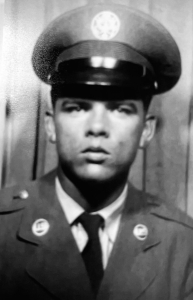 Johnnie Ray Crober, Sr.
Johnnie Ray Crober, Sr.
Sergeant United States Air Force, Johnnie served his country with the First Mobil Communication Group in Vietnam 1966 – 1967.
Born in Victoria, Texas, November 1943, he grew up on a farm in Long Mott, Texas. He enlisted in the Air Force in April 1963 and went through Basic Training at Lackland AFB in San Antonio, TX.
After completion, he was sent for training in communication at Shepard AFB and after tech school, was sent to Panama City FL Tendall AFB. John was deployed to Clark AFB Philippines where he served with the Fiest Mobil Communication Group then was deployed to Phu Cat Vietnam to establish the Base as well as communications.
Upon returning to the US, he was sent to Chanute AFB Rantoul Illinois. Crober received an Honorable discharge in March of 1967.
He has been married 40 years to Patricia and raised seven children. He and Patricia currently reside in Sweeny, TX.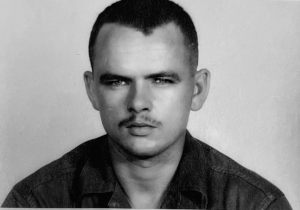
Cross, John
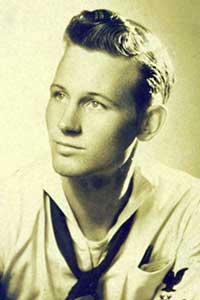 John H. (Jack) Cross
John H. (Jack) Cross
Boatswain Mate Second Class (BM2) U.S. Navy – Jack was born in Galveston Texas on May 15, 1932.
Jack enlisted in the U.S. Navy in October 1950, four months after the start of the Korean War. After finishing boot camp at San Diego, Jack was assigned to the Destroyer USS Herbert J. Thomas DDR 833 that was operating with the 7th fleet in Korea.
The Thomas returned to San Diego June 26, 1951 at this time the Navy was activating World War ll ships from the Reserve Fleet at San Francisco. Seeing a chance to move to the east coast, Jack volunteered for Carrier duty on the Shangri La – CV 38.
The Shangri La was a famous fast carrier of WW ll and was the Flag Ship of Vice Admiral John S. McCain Sr. It was in the moth ball fleet at Hunters Point among other famous WW II Carriers, USS Boxer, Hornet and Intrepid who were being readied for war service. After being commissioned, the Shangri La traversed the Panama Canal stopping at Colon and Panama City on the way to Boston.
After 11 serving 11 months on the Shangri La, Jack was able to get a swap with a crew member of a destroyer escort USS Manuel DE 351. The Manuel whose home port was Newport RI, was about to depart for a six-month Key West Fl training mission to taking out Sonar students to track Submarines. The Subs would try to sink the destroyer by firing un-armed torpedo’s and the Destroyer would fire unarmed hedge hogs (dept charges) that had a package of yellow sea dye.
During this period the Manuel made a number of calls at ports and Islands in the Gulf of Mexico and Caribbean. Some of the sites included Havana Cuba before Castro, Galveston (Jack’s home town), San Juan, Puerto Rico, Montego Bay, Jamaica, Bermuda and Islands in the west indies that was only accessed by boat.
Working with the submarines on almost a daily basis Jack became acquainted with one of the submarine Executive officers. Jack said he would like to be on one of the Submarine runs. His friend said all he had to do was get permission. He got the Ok from his ship’s captain and spent a day witnessing submarine operation trying to avoid detection and at one point firing an unarmed torpedo at his ship, the Manuel.
Jack’s last assignment was on the U.S.S. Yellowstone AD 27, a large Tender repair Ship. His service on the Yellowstone concluded his military service ending with a 6-month Mediterranean Cruise operating with the Sixth Fleet.
The Yellowstone was in the Auxiliary fleet and in that sense not a warship that operates with the carriers and battle groups. This allowed the Yellowstone’s specialized crew to be fulfilling work orders which could be done in port while the fleet was at sea conducting operations. The Yellowstone visited ports from one end of the Mediterranean to the other and to the Dardanelles at the entrance to the Black Sea.
The Yellowstone spent 22 days on the French Riviera at Cannes France. While in Cannes he visited visit Nice the perfume capital of the world and a trip to the French Alps as a prize for winning a swimming contest in the middle of the Mediterranean Sea.
Other stays by the Yellowstone included Naples Italy, with a visit to Pompey and Rome, the Island of Capri, Istanbul Turkey and a visiting the Blue Mosque, Valencia Spain, Malaga Spain, Tunis Tunisia that included a visit to the ancient city of Carthage. Other port visits were Piraeus Greece. Including a visit to Anthems Greece and the ancient ruins, the Island of Crete, Sardinia, La Spezia, Italy and a visit to the leaning Tower of Pisa.
Having spent time in the pacific, East and west coasts, the Gulf of Mexico and the Caribbean and now six months visiting cities and ancient historic sites along the Mediterranean, Jack indeed realized the slogan of; “Join the Navy and see the world”.
Jack was discharged in August of 1954. His Navy experience helped get a job as a rigger at Todd Shipyard in Galveston and shortly later working for the Galveston Houston Pilots on the pilot Boat Texas. Looking for better work opportunity, he went to work for Monsanto In Texas City in November of 1954, retiring as Chief operator in 1989 after 35 years.
Jack married Greta Hearn Cross in December of 1954, they reside in Texas City and will celebrate their 65th wedding anniversary on December 23rd 2019. They had three sons, two are diseased, two grandchildren and 4 great grandchildren.
Cruz, Nepthalie
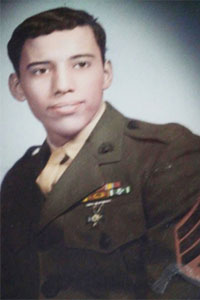 Nephtalie Cruz, Sr.
Nephtalie Cruz, Sr.USMC, SGT (E5)
I was a 19 year old native Houstonian from the 2nd Ward when I joined the United States Marine Corp in April, 1969. The TV showed men putting body bags in choppers. I felt it was my duty.
I am a proud member of Echo 2/7 1st Marines Division (Echo Company, 2nd Battalion/7th Marine Regiment, 1st Marines Division). My job was to make our mission in Vietnam a success which included Search & Destroy and day & night patrols.
The hardship and experiences are too hard to express in words.
I did bring back a new camouflage jungle uniform for participating Houston downtown parades, etc…
Truthfully, it is really painful to think about. I shall live the rest of my life with this embedded. It’s too difficult to explain the details. The Houston VA keeps me in caring hands and I am grateful. Although it is sad, I shall love this country for the rest of my days.
Culmer, Earl
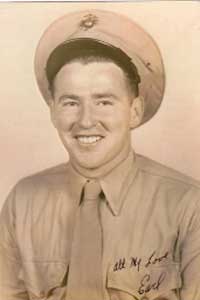 Earl Culmer was born in Houston, Texas in 1924. Earl grew up in the Heights and attended Reagan High School. Culmer joined the Marine Corps in March 1943. He attended Boot Camp in San Diego. Later, he was sent to the navel Air Station Alameda and then Camp Pendleton where the 26th Marine Regiment was formed. He was then sent to Hawaii for further training at Camp Tarawa.
Earl Culmer was born in Houston, Texas in 1924. Earl grew up in the Heights and attended Reagan High School. Culmer joined the Marine Corps in March 1943. He attended Boot Camp in San Diego. Later, he was sent to the navel Air Station Alameda and then Camp Pendleton where the 26th Marine Regiment was formed. He was then sent to Hawaii for further training at Camp Tarawa.
Culmer was assigned to the Alpha Company, 1st Battalion, 26th Marine Regiment, 5th Marine Division as a B.A.R.-man. He landed on Iwo Jima on February 19th, 1945 on the Red Beach One. Culmer was awarded the Bronze Star with a combat ‘V’ for acts of bravery on February 20th. On his 10th day on the island, he was struck by artillery shrapnel and evacuated off the island. He later received a Purple Heart for his wounds.
After returning home Culmer married Ethel McGinnis. They continued their life in the Houston area where they raised two children. Culmer was a life member of Heights Christian Church and is still an active member, as well as serving for many years as the Chairman of the Board. Continuing his service to his community, Earl has been a board member on the HUD Housing Projects and was very active in the building of Heights Towers, Heights House, and many others. He still serves on these boards today.
After retiring from Commercial Real Estate, Culmer retired and traveled worldwide with Ethel to ss the lifestyles of China, North America, Canada, Morocco, Portugal, Spain, England, the Caribbean and the list goes on.
Earl Culmer passed away on October 23, 2015. We were honored to have this hero on our V-J Day flight in 2015. He was a true hero, we are forever grateful to him for his service to this country, and honored to have known him.
Cunningham, Raleigh
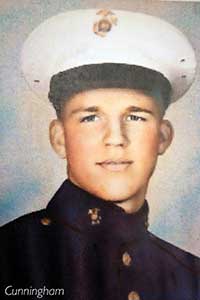 RALEIGH E. CUNNINGHAM
RALEIGH E. CUNNINGHAM
USMC & US NAVY – 1st CLASS PETTY OFFICER ENGINEERING AID
- Corporal United States Marine Corps.
- Cunningham served his country in the Korean War from 1953-1955
- Raleigh was born in September 21st, 1935 on a farm West of Kountze, Texas
- He joined the Marine Corps in 1953 at the age of 17 and attended Air School in Jacksonville, Florida and Airplane Mechanic School in Willington, Tennessee
- In May of 1954 he was assigned oversea duty and transferred to El Toro Marine Air Station in Orange County California. From there he went to K-6 Air Field in Korea
- In March of 1955 Cunningham was transferred to K-3 Air Field in Korea
- Cunningham was honorably discharged from the Marine Corps in 1961
- In 1964 he jointed the Navy CB22 (Construction Battalion) Reserve and was honorably discharged in 1968 as a First Class Petty Officer Engineering Aid
Currin, Clifton
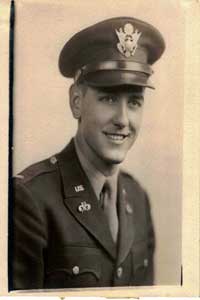 My father died when I was 12 years old. My mom did a fabulous job of raising my two younger brothers and I, but we were very short on money.
My father died when I was 12 years old. My mom did a fabulous job of raising my two younger brothers and I, but we were very short on money.
When I graduated from High school in 1938, I worked for a construction company for two years to earn money for college. Due to the war, we went on a four quarterly full year basis, graduating in 3 years. I studied Military Science in the ROTC (Reserve Officers Training Corp) all three years.
As a new Chemical Engineer I was sent to Edgewood Arsenal, MD for OCS (Officer Candidate School). I was then assigned to a Chemical Warfare Battalion to train for combat in the European Theater. We arrived after the hard work of the invasion and freeing of France around Christmas 1944 and joined the “Battle of the Bulge”. Fortunately neither side used chemicals after the horrible experience of WWI so we used our 4.2 inch mortars firing 25.5 pound high explosive shells in close-in support of the infantry. Two officers commanded a platoon of four mortars. We switched duties every three days, three commanding the guns and then three days on the front lines as Forward Observers radioing target coordinates to the platoon a mile or two back. The infantry requested fire on enemy machine gun nests, mortars, counter attacking units, and any thing else that would help hold positions or move forward.
On May 7 in a late snow in southern Bavaria the sound of explosives died down and we heard that Germany had surrendered. After a short occupation, we were shipped back to the States to train for the invasion of Japan. Fortunately thousands of lives on both sides were saved from what would have been a very bloody invasion when President Truman authorized using the newly perfected atom bomb on Hiroshima and Nagasaki, which ended the war.
Rather than rejoin civilian life immediately, I volunteered to transfer to the Counter Intelligence Corp and the occupation of Japan. I was sent to Fort Holobird, MD to study the Japanese language and under-cover tactics. We shipped to Japan at the beginning of 1946. I was put in command of a small detachment of six agents in Gifu with the mission of capturing Russian spies who were trying to set up communist cells across Japan with the intent of gaining political control and making Japan another satellite country around their border. As young bucks we enjoyed our “cloak & dagger” work and succeeded in thwarting their plans. McArthur turned a fierce enemy into a democratic ally.
I returned at the end of 1946, married my sweetheart, and spent 38 great years with Atlantic Richfield Co (ARCO) rising from research engineer to Manager of Operations at the Philadelphia Refinery. My wife and I had 61 years together, raised 4 kids, 8 grand kids, and 2 great grand kids. Marcie passed on in 2008. I’m still enjoying an active retirement and will be 93 in July 2014…what a blessed life!
Davidson, Dorman
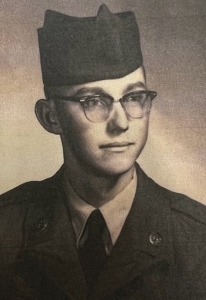 Dorman C. Davidson
Dorman C. DavidsonUS Army; SP3
Dorman C. Davison served in the US Army from September 1955 – 1958.
Dorman was born in June 1936 and after graduating from Pearland High School he joined the Army.
I was sent to Ft. Ord, California for 8 weeks of basic training. Upon completion, was then as-signed to Fort Gordon, GA where I was assigned to complete 8 weeks of Teletype school.
After completing Teletype school, I was sent to Ft. Dix, New Jersey and then sent to an Army transfer station in Frankfurt Germany for the next assignment. There I learned that the next assignment would be the 7794 Signal Depot in Saumur France.
I arrived in Saumur in April 1956 and spent the next two and a half years as a Teletype and Crypto Operator which required a Top-Secret clearance.
In September 1958 I was then sent to Ft. Chaffee, AR where I was honorably dis-charged. I returned home and married my high school sweetheart, Agnes Dugie, in May 1960. We have been married 63 years and have two children, one daughter who passed away in 2014 with a brain tumor and 3 grandchildren and one great grandchild.
Upon coming home, I went to work for Houston Coca-Cola as a route salesman for 10 years and then Frito Lay for 11 years. My final job was Deputy Sheriff for Brazoria County Sheriff’s Office. Served as a jailer, then to patrol and then as an Investigator. I was then promoted to Captain of Patrol Division and retired in 2004.
Davis, Judith
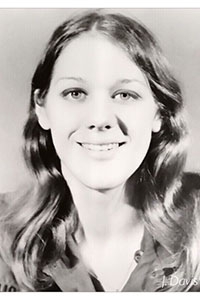
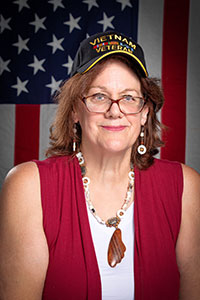
Judith Hooper Davis
Army Nurse Corps, 1LT
Judy grew up in PA (Born in Bethlehem). Her father was a retired LTC Marine Corps Reserve. Her paternal grandmother was a member of the Mayflower Society.
After 1 year in the Army Student Nurse Program, she was commissioned as a 2nd Lt in Army Nurse Corps after graduating nursing school and passing State Board Exams and getting her RN.
She met her husband, Jim Davis, at Ft Dix, NJ. (Armor Lt) 1st duty assignment.
Judy then had a 1 year tour Vietnam at 67th Evac Hospital , QuiNhon Oct 71-Jan 72. 3rd Field Hospital, Saigon Jan 71-Sep 72 working in ICU. Promoted to 1 Lt while in Saigon.
She was married to Jim Davis 1973- (they’ve been 46 married years). After birth of their 1st son, she came to faith in Jesus Christ. Judy & Jim have three grown sons, 6’9, 6’8 and 6’11. (Patrick, Jeffrey, Timothy.)
In 1991 she recognized she was still “at war,” when Desert Storm soldiers being welcomed home was shown on TV.
Judy has poems in the collection, “Vietnam: Words from the Unknowns.”
She returned to school and grad w BSN degree at UT in 1998.
Judy finished 20 years working night shift in 2009. Last 13 years in labor and delivery. Retired in 2012 after 1 1/2 years in High Risk OB home Nursing.
She is Life Member of Vietnam Veterans of America.
Judy is the grandmother of two girls ages10 and 7, two boys 7 and 3.5 and one step-grandson age 11.
Army Reserve 84-91. Rank of Major.
Awarded Army Commendation Medal for service in Vietnam
Love to cook, share my faith, make care packages, read, travel and write songs and sing. Africa mission trip 2005, Israel trip 2012. I am an Active member of Aglow International.
Davis, Sam
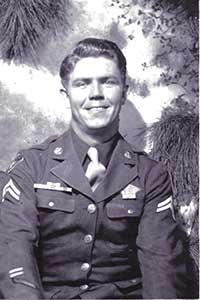 Sam P. Davis
Sam P. Davis
Corporal, 62nd Bomb Squadron, United States Army. Davis served his country in World War II from February 1943 to February 1946.
Davis was born in Colmesneil, Texas. After High School, he moved to Port Neches, Texas where he began working for Texaco, Inc. On February 4, 1943, Davis received his draft notice and entered into active service a week later in Houston, Texas. Upon completing basic training in Saint Petersburg, Florida, Davis was sent to Salt Lake City, Utah for deportation orders. Davis’ first deployment was to the Walker Army Airfield (also known as Victoria-Pratt Airfield) located three miles NE of Victoria, Kansas where he was assigned to the Military Police Squadron. While stationed there, Davis had the privilege of escorting Mini Pearl and her entourage to Army installations to entertain the troops stationed throughout Kansas. In recognition of his contribution, Davis was awarded the American Theater Campaign Medal.
In early 1944, Davis was transferred to the Smoky Hill Airforce Base (also known as Schilling Airforce Base) in Salina, Kansas where the 39th Bomb Group had been reactivated as a heavy bombardment unit for participation in the then new B-29 Superfortress program. Upon arrival, he was assigned to the 62nd Squadron (Motor Pool) which was one of the last three Squadrons to be deployed overseas (Guam). The Smoky Hill AF Base was the first operational training base for the B-29s and was used as a processing and staging area for heavy bombardment units going overseas. After the long awaited departure of the 499th Bomb Group (which was part of the 73rd Wing) for its overseas station at Saipan in October 1944, all facilities and resources at Smoky Hill were able to be devoted to the job of training the 39th for the time when it, also, would be assigned to an operational base in the Pacific. Flight training picked up and class after class of ground school instruction began for all men of the unit. It was at this time that Davis received combat training to prepare him for field conditions and, on December 14, 1944, he was qualified as a Carbine Marksman. Davis also received training as a heavy equipment operator (crane, backhoe, bull dozier) and was able to put these skills to good use after arriving on Guam.
On January 8, 1945, the ground echelon, which Davis was a part of, left Salina, Kansas for the Port of Embarkation in Seattle, Washington, where his unit would board the S. S. Howell Lykes for its ultimate destination at North Field, Guam. The Howell Lykes left Seattle on 18 January arriving in Guam a month later. Many were the experiences and tales of life on an Army Transport including surviving a typhoon in the Pacific on the way to Saipan after having enjoyed a 10-day layover at Pearl Harbor. With two years of preparation and combat training under his belt, Davis was ready for the task at hand. Upon arriving in Guam, the men of 62nd Squadron were quickly made aware of the dangers and threats to their safety both in the air and on the land. Davis was assigned to heavy equipment detail as there was very little infrastructure in place at the North Field air strip. He was responsible for helping to build out the base – grade roads, build streets and runways and construct facilities. While stationed on Guam, Davis served under Colonel John G. Powel, commanding officer of the 314th Wing of the 62nd Squadron.
Their mission was the strategic bombardment of the Japanese Home Islands and the destruction of its war-making capability. The B-29s flew “shakedown” missions against Japanese targets on Moen Island, Truk Lagoon, and other points on the Caroline and Mariana Islands. The 62nd squadron began combat missions over Japan on February 25, 1945 with a firebombing mission over Northeast Tokyo. The squadron continued attacking urban areas with incendiary raids until the end of the war in August, attacking several major Japanese cities and causing massive destruction of urbanized areas. They also conducted raids on key objectives by bombing aircraft factories, chemical plants, oil refineries, and other strategic targets in Japan. The squadron flew its last combat missions on 14 August when hostilities ended. Davis returned stateside six months later on February 3, 1946. He was discharged on 11 February at Camp Fannin, Texas. In honor of his service, he received the Asiatic Pacific Campaign Medal with two Bronze Stars, a Good Conduct Medal, a Distinguished Unit Badge and the World War II Victory Medal.
After separation, Davis returned home to Colmesneil to be reunited with his friends and family. After a few weeks of vacation, he returned to the Texaco Refinery in Pt. Neches, Texas where he worked until his retirement in 1984. Davis married Sybil Pauline Wright of Buna, Texas on March 26, 1950 and they have three children, three grandchildren and one great granddaughter. They recently celebrated their 68th wedding anniversary in Beaumont, Texas where they were married and currently reside.
Deason, Joe
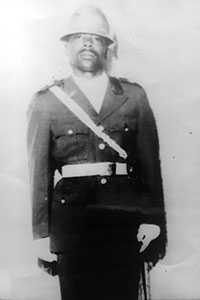
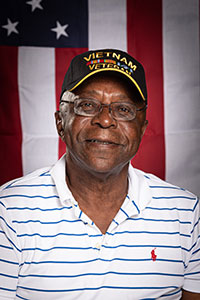
Joe M. Deason
US Army; Tank Commander
Joe Deason was born on February 25, 1947 in Nigton, Texas. He was the seventh of ten children and attended elementary school in Nigton, Texas. He attended high school at H. G. Temple High School in Diboll, Texas and graduated in 1964 with honors.
Mr. Deason received his bachelor’s degree in elementary education from Prairie View A&M University graduating with cum laude honors. He enrolled in the Army ROTC program and served as a commissioned officer in the United States Army from 1969 to 1971. He served one year of active duty in South Vietnam as a tank commander.
In 1972 Mr. Deason received a master’s degree in guidance and counseling from Prairie View A&M University. He served as teacher, coach, and counselor in the Cy-Fair Independent School District from 1972 to 1976.
Mr. Deason changed careers and became a district manager with World Book Encyclopedia from 1976 until 1982. In 1982 Mr. Deason and his family moved to East Texas and he returned to the education field. He had been a cattle rancher since 1972 and the relocation allowed him to be able to raise cattle on 100 acres of land that his grandmother purchased as an ex-slave with twelve bales of cotton.
In 1982 he received his mid-management certification from Prairie View A&M University. From 1982 until 2003 Mr. Deason served as teacher, counselor, and principal in the Lufkin Independent School District. He is a certified trainer in the areas of team building, administrative leadership, and teacher appraisal training required by the State of Texas. During his tenure as principal at Lufkin Middle School, the school achieved many awards.
In 2002 Lufkin Middle School was rated a Recognized Campus by the Texas Education Agency (TEA) and in 2003 Lufkin Middle School was rated as an Honor Roll School by Just for Kids, sponsored by the Texas Business and Education Coalition.
Mr. Deason served as the personnel recruiter for the district from 2003 until 2015 when he retired. He believes that keeping the school atmosphere conducive to learning.
Throughout his career, Mr. Deason has been involved with many committees and organizations. He served on the board of directors for five years at Woodland Height Medical Center, the Angelina Neches River Authority, the Salvation Army, the Boys and Girls Club, the Family Practice Residency Advisory Committee. He currently serves on the board of directors of Angelina College in Lufkin, Texas.
Mr. Deason married Frances Williams, a 1969 Prairie View A&M University graduate, and they have four sons, all Prairie View students. Three of them graduated from Prairie View and went on to acquire master’s degrees. Their oldest grandchild is currently an honor student at Prairie View A&M and is an assistant to the dean of Student Affairs. He has four grandsons who are honor students as well.
De La Cruz, David
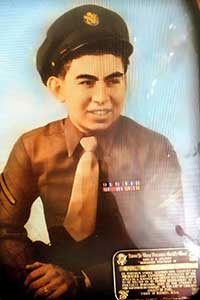 David De La Cruz
David De La Cruz
United States Army; PFC
David De La Cruz was born on June 19, 1928 in Benavides, Texas.
When World War II began, De La Cruz, was too young to enlist or be drafted. Eventually, he volunteered into military service in June 1946 at the age of 17. Serving as a Private First Class with the United States Army, De La Cruz would be assigned to the position of supply clerk under a Division called the 53rd Airlift Squadron.
Stationed in Berlin, Germany, De La Cruz would, before being honorably discharged in 1948, receive the Good Conduct Medal, the Victory Medal, and the Army of Occupation Medal. After the war, De La Cruz would return home but then quickly attended a vocational school in Harlingen, Texas under the American GI Bill where he took classes as an electronic technician.
Upon receiving news of his father’s injury, De La Cruz went back to Benavides to run the family business; a service station his dad had operated for several years. Following the passing of his father, De La Cruz sold the family business and returned to Harlingen with his remaining family to complete his studies but only to be recalled back into action on October 10, 1950 following the start of the Korean War.
He would remain on active duty until March 3, 1951 before being sent home on a hardship discharge; something De La Cruz asked for so that he could return home to help his family who were struggling tremendously with their finances. It was after his second tour that De La Cruz made the move to Houston, Texas. Once in the city, he did various jobs in electronics repair and eventually secured a position with the Foley’s company as a television repair technician; a position he held for 17 years before retiring. De La Cruz currently lives in Pasadena, Texas
De Leon, Gilbert
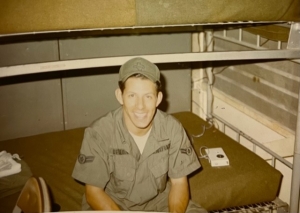 Gilbert De Leon
Gilbert De Leon
USAF; A1C
Vietnam War
A1C De Leon served in the United Staes Air Force. His time of service was from 25 August 1966 to 18 August 1970.
He enlisted in San Benito, Texas and went to Lack-land AFB for Basic Training. He was assigned to Fairchild AFB in Spokane, Washington. Because of the Viet Nam was, our unit rotated to the Island of Guam every six months. He was assigned as a vehicle dispatcher at Fairchild AFB. On the 15th of August of 1969, he was transferred to Cam Rahn Bay, Viet Nam. In June of 1970, he was transferred to Vung Tau, Viet Nam.
He was released from the Air Force on August 18, 1970.
He returned home to Houston, Texas and married Yolanda Vallejo on August 12, 1972. They have been married for 51 years. They have 4 children, eight grandchildren and one great grandchild. He retired in August 2001 from being an educator in the Pasadena School District. He volunteers with the USO, the Red Cross, St. Lukes Catholic Church and teaches English at the Harris County Pub-lic Library.
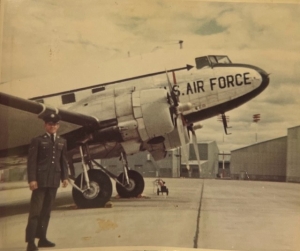
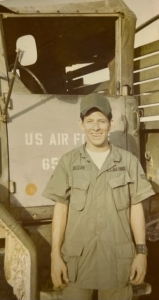
Deluke, Charles
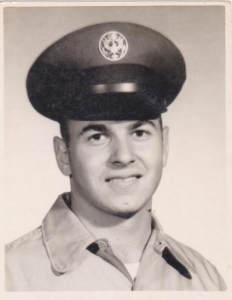 Charles S. Deluke
Charles S. Deluke
Airman First Class (A1/C), United States Air Force. Active duty service during Cold War Era and Vietnam War Era (January 1962 through December 1965).
Born in Houston, Texas just about 3 months prior to the Japanese surprise attack on Pearl Harbor in December 1941.
I spent my entire 4 years of U. S. Air Force active duty in the continental United States.
Lackland AFB, Texas (January 1962) Air Force basic training
Keesler AFB, Mississippi (February 1962 – December 1962) Air Force Electronic Technical School. Graduated to Air Force Career Specialty as an Airborne Electronic Navigation Equipment Repairman and during my stay was promoted to Airman Second Class (A2/C). I married my sweetheart at the Keesler AFB Base Chapel in April 1962 and left Keesler upon graduation in December 1962 with a 30 day leave (woo-hoo!) and orders to report to my permanent party base assignment at Webb AFB, Texas (Big Spring) with the 331st Fighter Interceptor Squadron (ADC).
Webb AFB, Texas (February 1963 – December 1965) Assigned to the 331st Fighter Interceptor Squadron (Air Defense Command) upon graduation from tech school at Keesler AFB. Upon arrival at Webb, I was delayed a week or more before being able to join my shop as I waited for my secret level security clearance to come in. Started out with the F-102A ‘Delta Dagger’ aircraft and then after about a year had passed, our squadron transitioned to the F-104A ‘Starfighter’ aircraft. Our squadron (331 FIS) protected the southern airspace of the USA. I worked both in the shop in repair of the various airborne nav-aid equipment installed on our squadron aircraft as well as providing necessary maintenance support of aircraft on flight line. I was promoted to Airman First Class (A1/C) shortly after passing exam for the next higher proficiency level; this also meant no more KP (kitchen police) duty for me. I was Honorably Discharged from active duty to civilian life in late December 1965 with 2 years of inactive reserve. My Air Force training had served me well for I had a job waiting for me back home in Houston, Texas as an electronic technician with a bio-medical instrumentation company. I received my Bachelors Degree using the GI Bill and later obtained a Masters Degree while employed with Gulf Oil Corporation.
While being stationed at Webb AFB, my two children (Lisa and Allan) were born in the base hospital. These were very happy moments in time. Then much later, Lisa, gave birth to my granddaughter (Sarah) in 2001; another very happy moment!
De Santo, Joseph
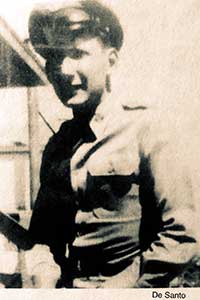 Joseph F. De Santo
Joseph F. De SantoS/Sgt United States Air Force
Served his country during the Korean War
From January 1951 – 1955
Joe was born March 16, 1931 in New York and spent the Depression years out in rural Long Island. He was drafted in December, 1950 but chose to enlist in the Air Force because of his desire to fly and love of airplanes.
He attended boot camp at Lackland Air Base at the time of the worst winter in Texas. The base was overcrowded by 20,000 recruits. The transition from “army green to air force blue,” was in its early stages. There were tents all over the parade grounds to house the overflow.
After completing basic training, he was sent to Wichita Falls, Shepard Air Force Base to attend Aircraft & Engine school.
Upon completion of A & E school, he was assigned to the Strategic Air Command at Carswell Air Force Base’s 19th Air Division, headquarters for the 824 Air Group. That group was attached to the 7th & 11th Bomb Wings which were manned by B36 bombers.
Joe was put on flying status and assigned to General Joe Kelly’s crew. While maintaining the General’s aircraft, it also meant participating in a great deal of trips coordinating max bombing practice exercises with the 7th & 11th Bomb Wings. At that time period, we were at max security and keeping the peace with Russia by keeping aircraft in the air around the clock. He had logged flying time on B-25, B-26, C47, C54, C119, and C45, with most time accrued on the B-25.
After the war ceased, Joe still had time to serve so he married the love of his and now had a military bride. His first son was born in the “old tar paper Quonset huts” that served as hospitals.
They were to end up with 5 children, 14 grandchildren and, currently, 5 great-grandchildren. They will be celebrating 66 years of marriage in September, 2019, and are blessed, so far, with pretty good health.
Joe was honorably discharged on January 5, 1955 and has been a resident of Texas City since 1956.
Dichard, John
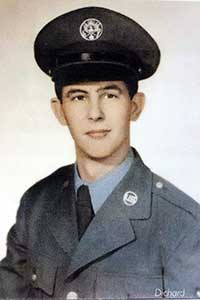 JOHN R. DICHARD
JOHN R. DICHARDMaster Sergeant (MSGT)
United States Air Force
Dichard served his country from 1954 to 1974. He was born 21 January 1937, in Hudson, NH and grew up in Lowell, MA. His family moved to Lowell in 1940.
He enlisted on 29 January 1954 and did his basic training at Samson AFB, Utica, NY. After Basic he was assigned to Keesler AFB, Biloxi, MS, Vance AFB, OK for on the job training as a military payroll clerk. In August 1955 he was assigned to Kimpo AB, Korea from 1955 to September 1956.
Upon his return from Korea, Dichard was assigned to Sewart AFB, Smyrna, TN from 1956 to 1958. Upon reenlistment in January 1958, Dichard returned to Vance AFB until his assignment Brindisi AS, Brindisi, Italy from January 1960 until February 1963. He was next assigned to Hq ASD, Wright Patterson AFB, Dayton, OH 1963 to 1964. His next assignment was Thule AB, Thule, Greenland 1964 to 1965. His next assignment was Bolling AFB, Washington, DC 1965 to 1968. Dichard next requested recruiting duty and assigned to Nacogdoches, TX 1968 to 1969. His next assignment was Yokota AB, Japan and Hq 5th AF from 1969 to 1973 where he served as a member of the Hq 5th AF IG team auditing all Non-Appropriated fund activities in 5th AF. In June 1973, he returned to Wright Patterson AFB until his retirement on 1 June 1974.
On 1 September 1974, Dichard entered Stephen F. Austin State University, Nacogdoches, TX and graduated in December 1977 with a degree in accounting. After graduation, he went to work for Temple-Eastex Building Products Corp., Diboll, TX in internal audit and after 20 years, he retired as assistant controller.
Mr. Dichard has been married to Norma L. Freeman, of Enid, OK, for 64 years. They have three children, four grandchildren, and six great-grandchildren.
Awards: Two AF Commendation Medals and numerous other awards
Assocations: 6147th Tac Con Gp from 2000 to 2018, his Korean unit assignment. Positions held: treasurer 10 years, assistant reunion commander for 8 reunions and President from 2015 to 2018.
Hobbies: Adult Scout leader for 15 years, golf, bowling, and woodwork specializing in making furniture for their home.
Diotalevi, Tony
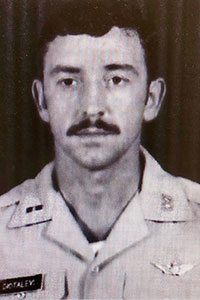
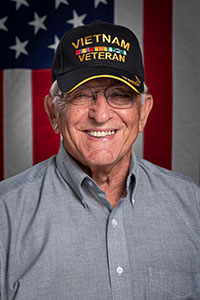
Tony Diotalevi
Chief Warrant Officer 4
Tony was born and raised in Gardner, Massachusetts beginning in February, 1939. Eight months after graduating from Gardner High School he started his military service in the United States Navy serving on the USS Lexington as an Aerographers Mate striker for three years. The Lexington is now a museum ship anchored in Corpus Christi Bay, Texas.
After separating from the Navy, he returned to Corpus Christi where he married Benita Galindo and started a family of three daughters, Laura, Gina and Marisa, and one son, Tony. Two years later he re-entered the service, this time in the United States Army. He was stationed at Fort Rucker; Alabama, Fort Sill, Oklahoma, Ft. Clayton, Panama Canal Zone, Heidelberg, Germany, Fort Leonard Wood, Missouri, and did two tours of duty in Vietnam.
He retired from active duty in June 1979, and flew as a commercial pilot in the Houston, TX area. He and his wife Benita then moved to Saudi Arabia and he flew for the ARAMCO oil company for seven years. In 1995, he and his wife returned to Houston, Texas and he continued to fly commercially until retiring completely in 2O13 after 50 years of flying. To this day when we get together as a family we always seem to reminisce about the great times we had during our days serving the US Army for those 17 years.
Dix, Richard
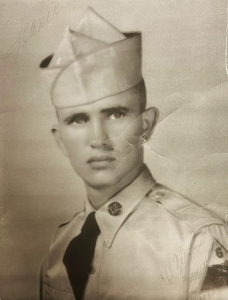 Richard A. Dix
Richard A. Dix
US Army; M/SGT E-8
Vietnam War
Richard A. Dix was born in Cano, North Dakota on August 10, 1936. He joined the National Guard in 1954 and went on active du-ty in 1956. He did his BCT in Ft. Leonard, MO. He did his ACT at Ft. Bragg, NC in 1956 as well.
Dix joined the 1st Infantry Division at Ft. Riley, KS in 1958 and joined the 1st Recon Squadron. He was stationed in Hawaii with the 24th Infantry Division from 1960 until 1963 when he was assigned to Ft. Polk, LA with the 3rd Brigade teaching replacement for Vietnam.
He was also an instructor with the Drill Sergeant school until 1968 when he de-ployed to Vietnam as an advisor to the Vietnam Army. In 1969, he was assigned as the ROTC Instructor at North East Missouri State College until 1971 when he deployed for a second time to Vietnam as an advisor to the Vietnam Army.
In 1972, he was assigned as the ROTC Instructor at Rice University in Houston, Texas. He retired on December 31, 1976 as a Master Sergeant.
Dodson, George
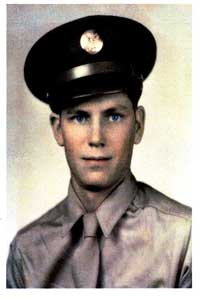 World War II Veteran – Army
World War II Veteran – Army
Born on August 28, 1923
Years of Service 1943 – 1945
George Earl Dodson, son of Daniel B. and Lottie E. Wilson Dodson, was born in Benton, Arkansas. He was educated in the Benton Schools.
I was drafted into the Army on January 19, 1943, and left this county, along with sixty-four more boys who were called for duty.
Dodson was sent to South Carolina, then to Key Field, Mississippi. Here he was assigned to the 463rd Air Service Squadron. He was shipped overseas on November 15, 1943, landing in England. He stayed in England for some time and was transferred to the Army Infantry, 84th Infantry Division.
Dodson was in the invasion of Normandy, France.
We went through France into Belgium. In Belgium my unit was almost wiped out during the Battle of the Bulge. The Germans were forced to retreat and we went into Germany.
Dodson was hospitalized for rheumatic fever. When the war in Europe ended he was told he was going to the Pacific for the invasion of Japan. The war with Japan ended, and he was sent back to the states and discharged at Camp Chaffee, Arkansas on December 3, 1945.
Dodson came home to Benton and farmed for a year, then moved to Louisiana to work in the oil fields. While in Louisiana, Dodson married Martha Jean Johnson in July of 1947. They were married for 56 years and have five children; Lottie, Georgia, Brenda, Peggy and Michael. They moved to Dickinson, Texas in 1965 where Dodson worked in the oil fields as a pipefitter (Local 211) until he retired.
Today Dodson is living in Texas City, Texas. He has 13 grandchildren, 32 great-grandchildren and 6 great-great-grandchildren. He is a lifetime member of the VFW Post 6378 in Dickinson, Texas and a proud member of the Honor Guard.
The VFW Post 6378 Honor Guard performs burial site and Funeral Home services for departed veterans with Military Memorial Honors; performing the 21 Gun Salute and live Bugle Taps.
Douglas, William
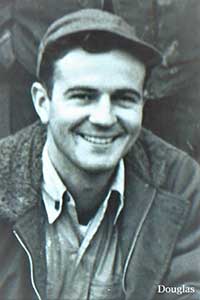 William F. Douglas
William F. Douglas1st Lieutenant United States Navy
Served his country in World War II from 1942-1946.
Douglas was born in 1924 in Galveston, Texas, attended St. Patrick’s Elementary school until his family moved to Houston, Texas. He enlisted in the United States Navy in April 1942 and attended Northwestern University in Chicago, Illinois where he earned his rank of Ensign. Douglas was sent to Houston, Texas (his hometown) to join his ship, the U.S. LSM 121 which was built in the Brown Shipbuilding Company in Houston. Remarkably his parents were able to visit his ship before it sailed. His ship went through the Panama Canal to San Diego for supplies and on to Pearl Harbor before sailing into the Pacific war zone where Douglas served in Saipan, Guam, Tinnian and in the horrific battle of Okinawa.
He was honorably discharged from the Navy with the rank of 1st Lieutenant in January 1946 and returned to his home in Houston where he married his beloved high school sweetheart, Amy Batterson. They have three children, four grandchildren and five great-grandchildren. Amy passed away in May 2014 after celebrating 68 years of marriage.
Drake, Donald
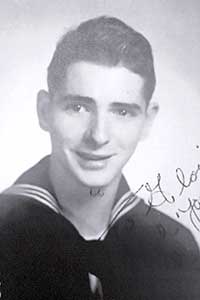 Donald Drake
Donald DrakeUS Navy; E-7 Chief
Chief Drake was born in Kansas City, MO on December 16, 1936. He attended Sacred Heart School. High school was West High School in Kansas City.
Enlisted US Navy, August, 1954. Boot camp Great Lake, Illinois – assigned to NAS Kingsville, Texas 1954-56. He met and married Gloria Ramirez on May 12, 1956 transferred to USS Salisbury Sound AV13 1956 – transferred again 1957. Reenlisted 1958 transferred to USS Whetstone LSD 27 1958 Deck Force to Dietary – stayed on 1958 – transferred from Whetstone 1962.
Naval Station San Diego: While at San Diego Commissary, was awarded Most Outstanding Dietary in twelve Naval districts. Drake awarded Top Sailor in twelve districts.
Class B Commissary School finished – third in class of 33 to MCB 10 Seabees 1964 – MCB 10 First Seabee Battalion in Vietnam. Our mission was to build an airfield for Mag Grove.
Vietnam Tour 1965, 66, 67.
In 1967, transferred to Naval Station Kodiak, AK – Chief
In 1970, transferred to NAS Lemoore, CA – Assistant Chief in charge of sale floor and ordering.
In 1972, went aboard USS Roark DE 1053 – two tours to West Pac.
Retired in April, 1975 and went to work as Director of Dietary at Richmond State School, Richmond, TX and left in 1988 to work for Texas Department of Criminal Justice at Central Prison Sugar Land, TX until 1999 when he retired from State Service and went to work as Support Service Director, Acute Mental Hospital, Oklahoma City till 2012 when he fully retired.
Chief Drake resides in West Columbia, TX
Easley, Donald
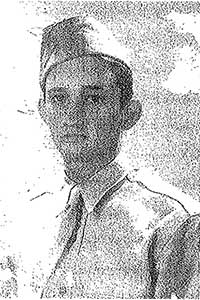 Donald (Don) was born on January 20th, 1925 in Rosebud, Texas. His family later moved to Telferner, Texas. Don was drafted and served proudly in the United States Army as a Private, First Class. He worked in the Field Artillery Division and served his country in World War II from 1943 – 1945. Don was assigned to the 190th Field Artillery Division (Battery A) and was attached to Patton’s 3rd Army in the European Theater. Don fought in Normandy (Fifth Wave), Northern France, Ardennes (Battle of the Bulge), Rhineland, & finally Central Europe. As such, Don was awarded the EAME Campaign Medal with 5 Bronze Stars. Good Conduct Medal, World War II Victory Medal, & the Silver Star Award. When asked how he made it through such a complicated theater, Don stated “I survived by the grace of God. We were well trained and in great shape. It was just luck and God’s blessings that I was never hit”. After the war, Don received honorable discharge from the Army in December of 1945 and returned home to Telferner, Texas, where he met and married his darling wife Margaret Ley in December of 1949. They were married for 67 years before Margaret’s passing. Don attended The University of Texas in Austin on the GI Bill and received his Bachelor of Administration in Business Degree in 1952. After graduation, Don & Margaret became entrepreneurs opening and operating a very successful independent insurance agency, Easley Insurance, from 1953 until 1991 when thereafter they retired. They were blessed with four children, twelve grandchildren, and eleven great-grandchildren.
Donald (Don) was born on January 20th, 1925 in Rosebud, Texas. His family later moved to Telferner, Texas. Don was drafted and served proudly in the United States Army as a Private, First Class. He worked in the Field Artillery Division and served his country in World War II from 1943 – 1945. Don was assigned to the 190th Field Artillery Division (Battery A) and was attached to Patton’s 3rd Army in the European Theater. Don fought in Normandy (Fifth Wave), Northern France, Ardennes (Battle of the Bulge), Rhineland, & finally Central Europe. As such, Don was awarded the EAME Campaign Medal with 5 Bronze Stars. Good Conduct Medal, World War II Victory Medal, & the Silver Star Award. When asked how he made it through such a complicated theater, Don stated “I survived by the grace of God. We were well trained and in great shape. It was just luck and God’s blessings that I was never hit”. After the war, Don received honorable discharge from the Army in December of 1945 and returned home to Telferner, Texas, where he met and married his darling wife Margaret Ley in December of 1949. They were married for 67 years before Margaret’s passing. Don attended The University of Texas in Austin on the GI Bill and received his Bachelor of Administration in Business Degree in 1952. After graduation, Don & Margaret became entrepreneurs opening and operating a very successful independent insurance agency, Easley Insurance, from 1953 until 1991 when thereafter they retired. They were blessed with four children, twelve grandchildren, and eleven great-grandchildren.
Today, Don enjoys reading and spending time with his family.
Edgington, Sonja
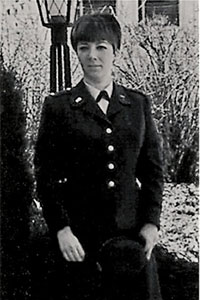 Sonja N. Edgington
Sonja N. Edgington2LT/1LT United States Army Nurse Corps
Sonja was born in Crawford County, Illinois, then was raised in Lawrenceville, Illinois.
After high school, Sonja attended Julia F. Burnham School of Nursing and graduated in 1965. She then moved to Madison, Wisconsin where she worked at the University of Wisconsin as a pediatric nurse.
In 1967 Sonja joined the Army and went to basic training at Fort Sam Houston in San Antonio, Texas. She was then assigned to Letterman Army Hospital in San Francisco, California.
In 1968, Sonja was sent to Vietnam, where she served as a nurse at the 6th Convalescent Center in Cam Rahn Bay, then was transferred to the 12 Evac Hospital in Cu Chi.
She was discharged from the Army in 1969. About 18 months later, she rejoined the Army. She worked as a pediatric and neonatal nurse.
While in the Army, she attended the University of Virginia and graduated in 1975 with a BS in nursing.
Since leaving the Army, Sonja has lived in Katy, Texas and continued working as a neonatal nurse until she retired.
Ellison, Samuel
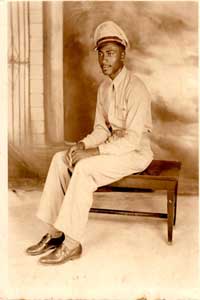 PFC United States Army
PFC United States Army
Served in World War II from 1942 – 1944
Hometown: Houston, Texas
Samuel J. Ellison was drafted into the U.S. Army at 18 years of age. He entered service on November 2, 1942 as a Private First Class (PFC) in World War II.
Samuel saw action in 4 major battles in New Guinea (Oro Bay, Lae, Buna, and Finschhafen). He was wounded in action and critically injured with a head wound in Finschhafen, New Guinea by Japanese Reinforcement on February 6, 1944.
Samuel was honorably discharged on October 19, 1944.
Samuel J. Ellison earned 3 Battle Stars and a Purple Heart.
Samuel has been married to Mary G. Ellison for 60 years and has one daughter, Sabrina A. Banks.
Enos, Dana
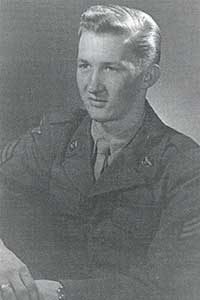 Dana R. Enos
Dana R. Enos
Sgt. US Army Air Corp
Enlisted Feb. 1944
Active Duty – April 1945 – Dec. 1946
Basic Training – Wichita Falls, Texas
Parachute Rigger, trained at Chanute Field, III.
ETO, 9th Air Force, 366th Fighter Group, 389th Fighter Squadron,
Fritzlar Air Base, Fritzlar, Germany
Married 1950 to Lois J. Dunn who passed away 2016
Two children, Seven Grandchildren, Eight Great Grandchildren.
Epstein, Robert
Robert Epstein, Captain, United States Corps of Engineers
In 1942, Epstein was a student in the Corps of Cadets at Texas A&M University. On June 2, 1942 the Army enlisted the entire Corps of Cadets student body into the Enlisted Reserve Corps (ERC). School continued as usual until the Army came back and placed all students under Active Duty.
Epstein was sent to Officer Candidate School (OCS), after finishing he became an Artillery Officer. After a short period of time he was sent to Engineering school as part of the Student Officer Training Regiment (SOTR).
Epstein served in the South Pacific’s Philippines as company commander during World War II. During this time he was part of an iconic event for Texas A&M University. On April 21, 1946 Robert Epstein was one of nearly 200 men who stood at the mouth of the Malinta Tunnel on the island of Corregidor in the Philippines. It was Muster Day, an annual day where Aggies globally remember those that we have lost in the year before. Softly call the Muster, let comrade answer ‘Here.’
Upon his return to the states after World War II Epstein learned that when he had been enlisted the Army had failed to register him for the draft.
Even though the draft stated that men who served during World War II did not have to serve, Epstein was drafted for the Korean War.
Epstein was honorably discharged at the end of the Korean War and served in total 51 months in World War II, 21 months and 6 days in the Korean War and earned a Bronze star and 6 Battle Stars.
On April 21, 2018 Robert Epstein was on his return trip from Washington, DC with Honor Flight Houston when he made history once again. At 30,000 feet Epstein and three other fellow Aggies became the first to hold a Muster in the Sky.
Epstein currently resides in Houston and is an active member of his community.
Ericsson, Gerald
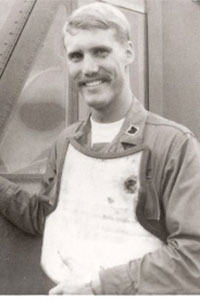 Gerald Ericsson
Gerald EricssonLt Col/US Army
Army 1 May 1967 BPED
Flight School at Ft Wolters, TX until December, 1967 and Ft Rucker, AL until graduation 4 June 1968.
RVN 1 July 1968 to 1 July 1969 serving in the 71st AHC (Assault Helicopter Company) – Rattlers and Firebirds. 71 AHC became part of the Americal Division 1 January 1969.
Flew 1200+ combat hours in UH-1D/H’s slicks and UH-1C gun-ships. Received 2 Purple Hearts 4 March 1969 and 2 May 1969.
Second tour RVN 9 November 1971 to October 1972. Flew AH-1G Cobra’s in various Cav units in the Delta; Vinh Long and Can Tho until spring offensive in 1 Corps flying UH-1M gun-ships with French Wire-Guided Missiles, out of Da Nang. About 800 combat hours and one of about 5 Army pilots to get a Russian tank until Desert Storm.
Taught Vietnamese to fly helicopter between tours.
Was 2AD (2nd Armored Division) Flight Standardization Officer (instructor pilot and instrument flight examiner) at Ft Hood until becoming full time Texas National Guard Flight Instructor in 1976 and Houston Army Aviation Support Facility Commander at Ellington in 1991. Commanded two Attack helicopter companies (Cobra’s) Ellington then San Antonio and finally commanded the 1/149th Attach BN (AH-64 Apaches) at Ellington until retiring in 2000 with about 10,000 total flight hours.
Evans, Robert
 Evans was born on December 28, 1921 in Wolf City, Texas.
Evans was born on December 28, 1921 in Wolf City, Texas.
Robert Earl Evans enlisted in the USMC on April 1, 1942.
Evans served two duties in the Pacific theater from July 8, 1942 to April 6, 1944 and April 17, 1945 to January 8, 1946.
Defense of Midway Island August 5, 1942 to June 26, 1943.
Evans served in 6th Company Defense Battalion, FMP
He was discharged from the Marines in San Diego, California in 1946.
Evans returned home to Waco, Texas and married childhood sweetheart Peggy Sue and was married for 47 years. They had three children. His oldest son, Andy, served in the USAF and was killed in an automobile accident while he was on duty. After Peggy Sue passed away he moved to Bellville, Texas to be near his children.
Fegette, Lee
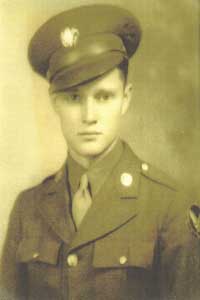 Fegette enlisted into the Army Air Corp November 1943 and served until July 1946.
Fegette enlisted into the Army Air Corp November 1943 and served until July 1946.
His training was in Chanute Field, Illinois and later he went to Walterborough, North Carolina.
Fegette sailed out of New York City to Dorchester, England where he served 27 months. His total service was 3 years and 9 months.
Fegette’s unit was the 381st Service Squadron, attached to the 7th Photo Group, which was part of the 8th Air Force. Their purpose was to photograph bomb targets before and after missions, as well as German troop movement. Fegette also repaired aircraft, mostly P-38s, which served as the eyes and ears of the 8th Army Air Corp. His squadron also played a major role in the D-Day invasion.
Following discharge, he returned to Dickinson, Texas and married his wife, Helen, of 62 wonderful years. They were blessed with 4 children, 6 grandchildren, and 10 great-grandchildren.
Fegette retired from American Oil in Texas City after 38 years and moved to Henderson where he has lived the past 35 years. He will be 92-years old in January, 2015.
Ferguson, Andrew
 Ferguson served in the US Army from the start of 1943 to the end of 1945. He was in combat in Europe with the Medium Artillery battalion of the 103rd Infantry Division.
Ferguson served in the US Army from the start of 1943 to the end of 1945. He was in combat in Europe with the Medium Artillery battalion of the 103rd Infantry Division.
Ferguson’s primary responsibility was in directing the firing of 155mm howitzers in support of front line infantry soldiers. The 103rd Division had trained in Texas and landed for combat in Marseille in southern France. As the German forces were slowly pushed northward, the 103rd fought its way North to attack Germany’s concrete bunkered Siegfried Line. Just North of the Siegfried Line the Germans established a winter offensive known as the ‘Battle of the Bulge’ in which the 103rd Division participated. Our 155mm howitzers helped turn the tide of the German offensive
When the ‘Battle of the Bulge’ was concluded, the 103rd was reassigned to General Patton’s 6th Army, which drove South. The 103rd was the lead division as the Sixth Army liberated Innsbruck, Austria, and fought South over the Brenner Pass to meet up with American troops in Northern Italy. Several days later the Germans capitulated on a day, which became known as ‘VE Day’ (Victory in Europe Day).
Ferguson was being redeployed to the South Pacific, and was on home recuperation leave when the atomic bomb was dropped in Japan. Some days later the Japanese surrendered on a day, which became known as ‘VJ Day’ (Victory in Japan Day). Within six weeks after ‘VJ Day’ Ferguson was honorably discharged from the US Army.
He returned to his hometown of Porterville, California to be with his wife and baby son. From there he enrolled in the Engineering School at the University of Oklahoma and waited for the start of the next semester. He graduated 18 months later with a bachelor’s degree in Mechanical Engineering.
Flores, Arquimedez
Arquimedez Flores
Sgt (E-5) United States Army
Sgt. Flores service his country in the Korean War Conflict and during peace-time from 1955 – 1961.
In Korea, Sgt. Flores served with the 187th Regimental Combat Team. Other assignments included Mort. Btry, 1st ARG 504 Inf., Fort Bragg, NC as a Master Parachutist. Sgt. Flores is proud of his service and 82nd Airborne Division.
Sgt. Flores was born on The Butler Ranch in League City, Texas in 1933, and spent most of his childhood traveling between Galveston, Texas and Waukegan, Illinois.
Sgt. Flores is married with ten living children, two deceased, numerous grandchildren, great-grandchildren, and great-great grandchildren.
“Strike and Hold!”
Foltz, Raymond
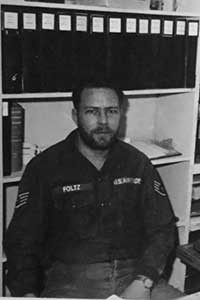 RAYMOND B FOLTZ
RAYMOND B FOLTZ
I served my country from November 1954 to December 1974. I retired from the USAF on December 1 1974, reaching the rank of Master Sergeant.
During my service, I served as a weapons mechanic, long range radar technician and as a flight simulator technician.
I was stationed overseas in England,Labrador and Germany for a total of eight years. The other twelve years were at numerous duty stations in the CONUS.
I have been married to my wife Patricia for 53-1/2 years and we have two sons and five grand-children.
Fontenot, Benjamin
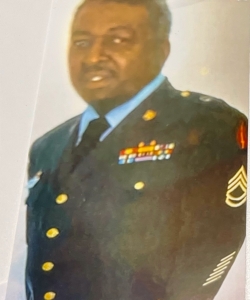 Benjamin Fontenot
Benjamin Fontenot
US Army; E-7
Vietnam and Desert Storm
SC Benjamin Fontenot served his country during the Vietnam War from 1971 – 1973. He also served in the Army Reserve for 22 years from 1975 – 1997.
Fontenot was born February 13, 1951 in Lafayette, Louisiana and grew up in Eunice, LA.
I was drafted on January 23, 1971 and did my basic training at Ft. Polk, LA. I did my Medic training at Ft. Sam Houston.
From there, I was assigned to 1/46 23 Inf America/Division Combat Medic. From there, I was transferred to USA Medoac USARSUP Thai. I was discharged from the Army on February 12, 1973.
I moved to Los Angeles, CA and on January 20, 1975, I joined the 419th QM BN of the Army Reserve. I entered the Reserve at the rank of E-4. Rose to the rank of E-7. I served as unit supply specialist, water treatment specialist, and food service sergeant.
On September 20, 1990, I was ordered to active duty in support of Operation Desert Shield/Desert Storm. Service was in southwest Asia from 900920 to 910420.
I married Anna Edwards on July 2, 1981. We have been married 42 years. We have 3 children (my oldest passed) and 2 grandchildren.
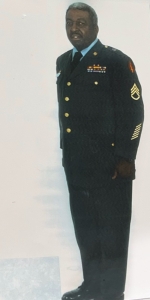
Ford, Bill
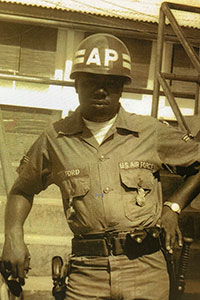
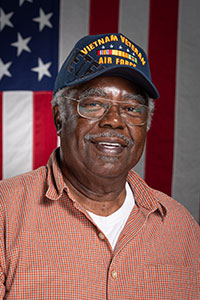
William Henry Ford
William, commonly known as Bill, Henry Ford parents were Roy and Estella Ford. He attended (1951-1962) public school and graduated from William High School in Crockett, Texas, Houston County. After graduation, for employment purposes, Bill moved to Tyler, Texas and worked at Tyler Pipe & Foundry until 1964. His personal and work ethics guided another career decision which was to join the United States Air Force (USAF).
Bill served 3 years, 10 months and 19 days on active duty. During this time, he stayed 12 months in Vietnam Tan Son Nhut Air Base. He started his career as a Security Police with 377 Security Police SQ PACAF. His active duty release date was November 26, 1967 from Travis Air Force Base, Fairfield, California. Subsequently, Bill joined the Air Force Reserve in 1972 until he retired August 1, 1992.
Selected achievements from Bill’s military experience includes: National Defense Service Medal, Small Arms Expert Marksmanship, Outstanding Unit Award, Vietnam Service Medal and Republic of Vietnam Campaign Medal. He also had educational accomplishments such as: Professional Certified Welder, Order No. HO3267 in accordance with spec. ASME Sect. IX. Aluminum Electric and Wire Welding, knowledge of OSHA Safety Rules and Regulation Supervision Skills, Structural Welding and Instructional Skills.
Bill’s military career and successes were used in his work experience. Selected examples include: Pabacon Service LLC: Certified Safety Instructor, Taught OSHA Safety to students seeking employment, AND, General Electric (10-1991 until 2-2010): Travelled from company to company rendering Aluminum, Electric and Wire Welding Service for GE.
He continues to serve by volunteer ring in the community. Some examples include: working with his Civic Club monitoring and communicating information about neighborhood and other events, used his military experience to work with youth at the George Foreman Youth Center (1991-2009) and Fonwood Elementary School (2010 -2012).
Bill enjoys exercising and going to the movies (favorite: Tuskegee Airmen and Hidden Figures).
Foster, Harold
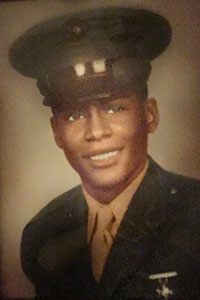
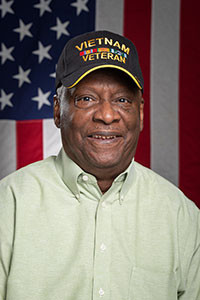
Harold W. Foster
USMC; CPL
Corporal Harold W. Foster served from June, 1963 to June, 1967.
CPL Foster was born in Houston, Texas in December, 1945. He voluntarily joined the Marines in Houston and took basic training in San Diego, California. Later duty was Naval Training Center at Naval Air Training Center at NAS Memphis. Upon completing aviation training, Foster was stationed in MC Air Station in Tustin, California.
Foster was then transferred to Okinawa, Japan. Then, transferred to DaNang, South Vietnam for two tours in the combat zone as a tail-gunner in HMM-163 and HMM-361,
CPL Foster was honorably discharged from the military in June, 1967. He returned to Houston in 1968 where he resides today.
Foster, Robert
Don served his country during WWII from 1942-1945.
Don was born April 22, 1922 in Canyon, Texas. While studying physics at West Texas College, Don joined the reserves in April 1942. Just before graduating, he was called to active duty in Feb. 8, 1943 and sent to Boca Raton Florida for basic training. Upon completion of basic training, Don then spent the next 10 months at UCLA studying meteorology, graduating on Nov. 28, 1943. The next day, he received his 2nd Lieutenant’s commission. While studying meteorology at UCLA, he was awarded his physics degree from West Texas College, not having been able to complete his degree before his call up.
Don then spent the remainder of the war at Amarillo Air Field, as well as, San Marcos Air Field, both in Texas. There he taught pilots and navigators the art of meteorology as well as performing weather forecasting duties.
Don was promoted to 1st Lieutenant on Dec. 17, 1945. He separated from the service on Jan. 27, 1946. He and his new bride, Nedra, then returned to Austin, Texas where Don re-entered school on the GI bill and graduated in Jan 1948 with a BS in Mechanical Engineering. Don and Nedra then moved to Houston, Texas where they raised a family of three children. Don worked as the chief engineer for two separate companies before he started his own engineering consulting business in 1956, retiring about 1992.
Don and Nedra were married 1 week shy of 69 years before she suddenly passed away. They have 4 grandchildren and 7 great grandchildren at this time.
Don is now 92 years old (2014).
Fox, James
Petty Officer First Class TE(RMl) United States Navy, 1951-1957.
Enlisted in the USN in 1951, after Boot Camp in the USN, James served on Guam, Class C Teletype maintenance School at San Diego CA .. Served aboard the USS ROGERS DDR 876 Destroyer.Radar Picket Ship. Served in the China Seas, the Korean Conflict, then to the Naval Air Station, Olathe, KS. Enlistment expired and enlisted into the US Air Force one day later as TSG (E-6). Started Air Force career at RG Air Force Base in 5th Comm SQ, then to Clark AB Philippines in the 1961 st AACS Sq. From there to USAF Recruiting Detachment in Kansas City, MO. Then to US American Embassy at Ankara, Turkey, As Communications NCO for the Military Attaches. Then to IZMIR, Turkey in the 1127th Communications SQ. Promoted to MSGT (E-7) and transferred to U.S. Recruiting Det Kansas City, Mo.Spent 10 years overseas, about half Far East, half Middle East. Retired USAF 1971
Freed, Robert
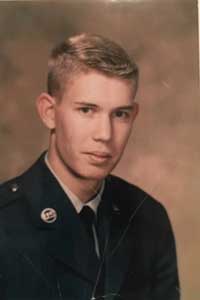
Frese, John
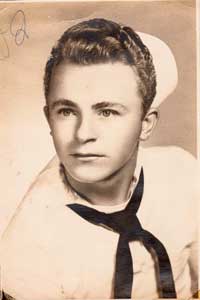 Frese was born in Tulsa, Oklahoma on February 4, 1927. He graduated from Will Rogers High School in “44”and joined the U.S. Navy on February 8, 1945.
Frese was born in Tulsa, Oklahoma on February 4, 1927. He graduated from Will Rogers High School in “44”and joined the U.S. Navy on February 8, 1945.
He requested and was approved for the V5 program, and was sent to San Diego, California for training.
In April 1945, Frese was transferred to the Thermal, California Naval Air Station and joined VT98 Squadron in their ground support group.
Later, Frese was assigned to the Las Alamedas Naval Air Station, Long Beach, California and joined CASU 33.
In August 1945 Frese was shipped to Pearl Harbor, CASU 1 at Ford Island, Honolulu, Oahu and attached to Naval Air Station Operations.
During July 1946, Frese was transferred to Norman, Oklahoma for discharge. On August 1, 1946 he was given an Honorable Discharge.
After military service, Frese attended college and was graduated from Tulsa University earning a BS in Marketing. He moved to Houston in 1965 and has remained there since. His career has been in the oil and gas equipment business to this day.
Frost, John
 John E. Frost
John E. Frost
Military Service:
1st Lieutenant, Navigator, Pacific Theater, World War II
Completed 47 missions, shot down and wounded on eleventh mission, but returned to combat six weeks later. Medals include: Purple heart, thre air medals (4th pending), six battle stars, theater ribbons plus three presidential citations.
Education:
B.S. Mining Engineering, Stanford University
M.S., Ph.D Geology, Stanford University
Management Course, Northwester University
Post Military Service, Employment and Activities:
U.S. Geological Survey
ASARCO
Philippine Iron Mines
Duval Corporation
Exxon Corporation
Frost Mineral International
Planned and managed four major exploration and development organizations. Actively involved in athletic organizations and was active in Mineral, Pre-Columbian and Primitive Art organizations.
Garner, James
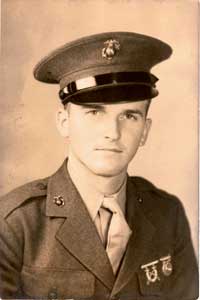 World War II Veteran
World War II Veteran
Born December 14, 1919
United States Marine Corps
Years of Service 1944 -1946
James L. Garner was born December 14, 1919, in Hamilton County, Texas, and was educated in country schools. When he was 18 years old he joined the Civilian Conservation Corps, at Garner State Park, Texas, which was a program organized by President Franklin D. Roosevelt to give young men 18 through 25 a place to live and learn a trade. He served there two years. James drove a supply truck the first six months, then worked as physician assistant for the remaining eighteen months.
On May 15, 1941, he began doing civil service work for the United States Air Force at Kelly Air Force Base in San Antonio, Texas. He and Tressie Lou Hartman were married September 6, 1942. He continued doing civil service until May 15, 1944, then joined the United Stated Marine Corps at San Diego, California. In September he went to Millington, Tennessee, and attended a six month course to learn Morse code and navigation.
Afterwards he returned to California and was on standby to go overseas. On July 6, 1945, James boarded an aircraft carrier, went to Honolulu, and then on to the island of Guam three months later. His classification was Flying Radio Gunner on Navy fighter planes in the Marine Air Force, Third Marine Division. His division was included in a planned invasion of the Japanese mainland but the Atomic bomb was dropped and the war was over.
After the war ended, the United States organized an expedition to send the First Marine Division in, with air support, to occupy the land in China that Japan had been holding as a result of war with China. On Christmas day, James boarded another aircraft carrier, went to north China and dropped anchor 22 miles off shore in the Gulf of Chithi, near the City of Tientsin.
James went on a train about 200 miles north to a Japanese hospital located at Petieho Junction. Five days later he went on to Chinwangtao and set up a radio station in a house on a cliff overlooking the harbor. His group had to guard five networks: one was in Manchuria with the United States Army, one in Honolulu, one in Shanghai, one to report classified information regarding the revolution between the Chinese Communist and Nationalist Armies, and one to keep track of trains. In addition they also served as Port Director. This expedition lasted six months and came to an end in July.
When this assignment was completed James boarded a ship and returned to San Francisco. He says, “We saw the Golden Gate Bridge and as we drew nearer I saw one word on that bridge, ‘Thanks’. At that moment the names of three of my high school class mates, C. V. Lee, Percy Bingham and Garland Ledbetter who had made the ultimate sacrifice by giving their lives for their country, flashed through my mind. I had given it my best and here I was. Then I suddenly realized that the one powerful word on that bridge was an expression of gratitude from thousands of Americans to me for doing my small part in defense of their freedom.”
James went back to his civil service job at Kelly Field where he continued supporting the War efforts including the Korean and Vietnam Wars. On December 24, 1975, he retired at age 56. Twenty years later he was called back to work by Alamo Aircraft, a private company that sold aircraft parts back to the Air Force, and worked ten more years.
He and his wife Tressie were married 65 years and had four children and ten grandchildren.
Goergen, Gerald
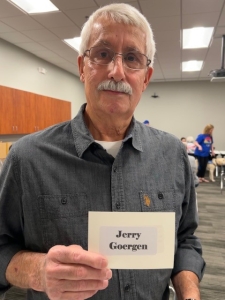 Gerald F. Goergen
Gerald F. GoergenSpecialist 5 (E-5) United States Army
Gerald served his country during the Viet Nam War from 1969 – 1972
Gerald was born January 1, 1948 in Sioux City , Iowa.
He enlisted and entered the service on October 24, 1969 and attended basic training at Fort Leonard Wood, Missouri. During his time at Fort Leonard Wood, Gerald was selected to become a member of the A.S.A. (Army Security Agency) where he would work in conjunction with the National Security Agency. He was then sent to Fort Devens, Massachusetts where he was trained as a traffic analyst (98C20). In October, Gerald was transferred to Viet Nam.
While serving time in Viet Nam, he was stationed in Saigon, NaTrang, DaNang, and ChuLai. His main responsibility was monitoring enemy troop movement within the country, The following year, October 1971, Gerald was sent to Fort Carson, Colorado, and his final months of service were spent in Fort Hood, Texas.
Gerald was awarded the Viet Nam Service Medal with 2 Bronze Service Stars; National Defense Service Medal, Republic of Viet Nam Campaign Medal, Viet Nam Cross of Gallantry with Palm, Army Commendation Medal, Bronze Star Medal and Expert Rifle.
Gerald was discharged from the Army in October of 1972. He remained in Texas and married Pam Loftin (the best thing that ever happened to him) in August of 1974. They have been married for 49 years and they have one son who has a beautiful and a PRECIOUS 2-year old daughter who is our pride and joy, granddaughter, Sofia Elizabeth.
Goforth, Charles
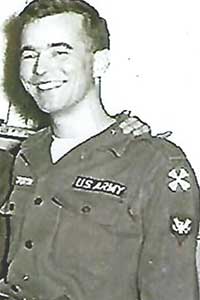 Charles Goforth, Jr.
Charles Goforth, Jr.
I was born in Cincinnati, Ohio. My family moved to California when I was eleven years old. I graduated from High School in 1953.
I knew that I needed to give my country some time, so I volunteered to be drafted. Eight weeks later I was on my way to Korea.
I served six months in Pusan, Korea driving a 2 ½ ton truck; my MOS was Administrative Specialist. Then I was transferred to Inchon, Korea, where they had a opening in the supply room on Wamido Island.
Gomez, Leopoldo
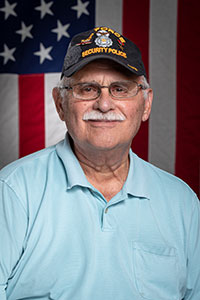 Leopoldo Gomez
Leopoldo Gomez
I joined the Air Force in August of 1962, right out of high school. My first assignment right out of Basic Training was at George AFB Californiz.
Got to George right in the middle of the Cuban Crisis and since a lot of our Air Policeman had gone temporary duty assignment to Florida in order to guard our F1045, they put us on temporary 12 hour shifts.
Spent 2 ½ years at George where I got orders to go to Bien Hoa A.B. Vietnam.
Received a Bronze Star with V for Valor and 2 Oak Leaf Clusters. Got a 4 ½ month early out of the Air Force because the would not re-assign me since I had less than 6 months left on my enlistment.
Goscinski, Buster
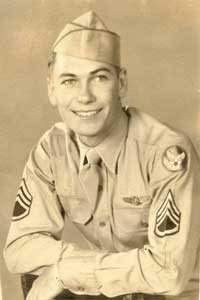 2nd Division, 466th Bomb Group, 787th Bomb Squadron.
2nd Division, 466th Bomb Group, 787th Bomb Squadron.
‘Buster’ enlisted on November 11, 1942, and served 2 years 11 months and 17 days. He had Gunnery Training in Harlingen, Texas, and Overseas Training in Pueblo, Colorado.
S/Sgt Goscinski was in England for about 9 ½ months, and flew 27 missions aboard a B24 as a nose gunner. He would have continued, but one of his buddies brought it to the attention of a superior officer that S/Sgt Goscinski had already exceeded the number of required missions.
During his service, he was awarded the European Theater of Operations as well as an Air Medal and four clusters.
Busters Hometown is San Jon, New Mexico.
Goudeau, Eugene
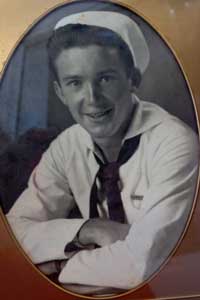 In 1942 the battle for the Soloman Islands was raging between the United States and the Japanese. During one of these battles the USS Houston, a US Navy cruiser, was sunk with a great loss of men.
In 1942 the battle for the Soloman Islands was raging between the United States and the Japanese. During one of these battles the USS Houston, a US Navy cruiser, was sunk with a great loss of men.
Shortly after the sinking an enlistment drive was made in Texas to replace those men that were lost. In October 1942, Goudeau and a buddy heeded the call and enlisted in the US Navy.
Goudeau took a five-week training course before being sent to his hometown of Orange. Here a destroyer, the USS Dyson, was nearing completion and Goudeau was assigned to the crew’s list.
About two weeks after arriving in Orange, Goudeau boarded the ship for the ‘shake down’ cruise. Then, on December 30, 1942 the ship was commissioned at the Orange city docks. After training up and down the East coast, the Dyson left New York City May 15, 1942 for the Panama Canal.
Leaving the canal they headed to the South Pacific and into the area where the USS Houston had been sunk. Their epic journey, that brought the Dyson and three other Orange-built destroyers into a mighty fighting force, began when Destroyer Squadron 23 (Des Ron 23) was organized and commissioned in June of 1943. Commanded by Captain Arleigh Burke, better known as 31 Knot Burke because he believed in full speed when in battle. Hit them fast and furious was his motto, and he did.
Des Ron 23 became famous in the Pacific, earning eleven battle stars for the Soloman campaign for which it won the Presidential Unit Citation, the only destroyer squadron to ever do so. Also, the Little Beaver squadron and its famous logo is still in commission today and operates out of San Diego. This is another honor given to Des Ron 23 and is the only destroyer squadron from World War II to have that honor. The Dyson fought 27 direct combat battles with the Japanese, resulting in sinking or damaging several of their naval ships, and shooting down several Japanese war planes.
The USS Dyson was given to Germany in 1947 and was commissioned into the German Navy until 1982. The ship was then sold to Greece for spare parts and scraping. There were even some German sailors that served aboard the Dyson who attended the Dyson’s reunions in the States.
Goudeau served on the Dyson from December 20, 1942 until December 15, 1945. The only home he knew for three years.
Goudeau retired from DuPont Chemical in 1982. He just celebrated his 90th birthday and is still in good health. Mr. Goudeau looks forward to taking his first jet airplane ride on June 28, 2014 with Honor Flight Houston.
Green, Bill
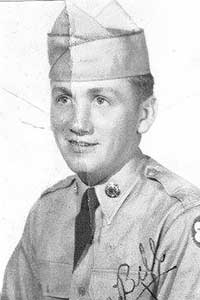 Bill J. Green
Bill J. Green
Corporal, United States Army. Bill served his country from 1951 -1953 during the Korean War.
Bill was born on May 27, 1930 in Terre Haute, Indiana – before his family moved to a farm north of Bangor, Michigan in 1936.
Bill was drafted on March 16, 1951 and was stationed in Fort Eustin, Virginia. He was in the Mechanic division.
In 1952, he sailed from Virginia to Goose Bay Labrador and Greenland. In Labrador (where he was stationed for one year), he helped to build an airplane runway that was 7 miles long. He was in the Motor Pool and was a mechanic in the Parts Division.
Bill was honorably discharged from the Army on March 18, 1953. He returned to Michigan and married his school teacher wife, Constance Stanislawski in November of 1953. They have been married for 65 years. They have two daughters (both school teachers), two grandchildren (one a doctor), and three great-grandchildren.
Bill spent 33 years in the car business, owned his own gas station and ran a used car business for 13 years.
Bill and Connie traveled extensively both in Europe and the United States (having traveled 47 states).
Bill has enjoyed golfing, bowling and racing cars. (He built one).
Life is good – we have been truly blessed with a wonderful family and many good friends.
Green, Charles
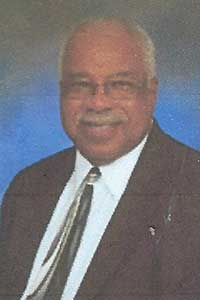 Charles Green, PᏂD.
Charles Green, PᏂD.
Charles Green, Ph.D., recently retired from Bermuda College as President Emeritus after serving a contract for three years to train a Bermudian replacement. Prior to that he spent eight years in Chicago, Illinois in various capacities, which included President of Olive Harvey College. He served as chancellor of the 55,000 student Houston Community College System from 1990 to 1995 where he employed over 3,000 employees. Dr. Green’s career in education spanned nearly three decades serving in posts ranging from Chancellor, College President to College Dean. In his military career he retired with the Military Rank: Colonel after 33 years of Active and Reserve Military Service.
During Dr. Green’s Maricopa Community College years, he served as President of Maricopa Technical Community College (now Gateway Community College) from 1981 to 1985, providing leadership and management to the only technical community college in Arizona. Dr. Green moved to Rio Salado Community College as President from 1985 to 1990. At Rio Salado he presided over and provided management for the school without walls”. Dr. Green established the Presidents’ Round Table, an affiliate of the National Council of Black American Affairs, and established the first Maricopa Council on Black American Affairs (MCBAA) Leadership Academy.
Several awards and achievements have marked Dr. Green’s career; notable among them are: Honorary Professor, Universidad Autonoma de Guadalajara, Mexico, Doctor of Technical Letters, Cincinnati Technical College, Doctor of Humane Letters, Central State University and Distinguish Alumni, National Association for Equal Opportunity in Higher Education, Historically and Predominantly Black Colleges and Universities.
Charles Green earned a Bachelor’s degree in Industrial Technology from Central State University (Wilberforce, OH), and a Master’s degree in Management and Industrial Supervision from Central Michigan University. He received his Doctorate of Philosophy degree in Education Administration from The University of University of Texas at Austin (Austin, Texas). Dr. Green also participated in: Institute for Educational Management, Harvard University (Cambridge, Massachusetts) and numerous other Presidents Academies and post doctorate seminars.
Grogin, Gerald K.
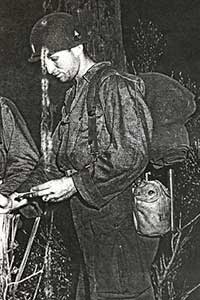 Grogin enlisted as an Aviation Cadet in the Army Air Corps in 1944 while a student at Texas A&M University.
Grogin enlisted as an Aviation Cadet in the Army Air Corps in 1944 while a student at Texas A&M University.
He was called into service in 1945 and served until 1946 as an Air Force Cryptographer with the 141st Army Airways Communication Squadron, in Manila, Philippines.
He returned to Texas A&M and received an Army Reserve commission in 1948 in the Armored Calvary.
In his career, he rose to the rank of Captain. Gerald was discharged in 1961.
Grumboski, Lawrence
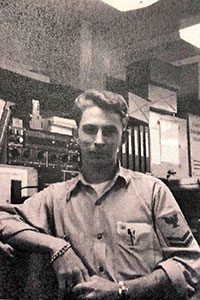
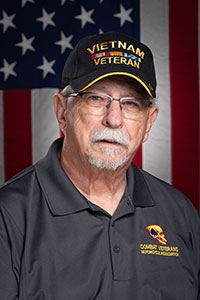 Lawrence “Ski” Grumboski
Lawrence “Ski” GrumboskiAviation Fire Control Technician (AQB2), United States Navy, serving from 8/11/61 to 9/20/68.
Ski was born on Mother’s Day May 14, 1944 in Detroit, Michigan.
He joined the Navy in August 1961 and received his basic training at Great Lakes Training base in IL. From basic training he was then assigned to the Naval Air Station Meridian Mississippi, and then assigned to the NAS supply department while waiting for orders to AQ “A” school.
From “A” school Ski was assigned to Heavy Attach Squadron 13 assigned to NAS Oceana in Whidbey Island, Washington. The squadron was already serving duty on the U.S.S. Kitty hawk CVA-63 on a Western Pacific cruise. After training on the ASN-1 RADAR bombing system Ski was transferred to Yokosuka Japan where he meet the Kitty Hawk and started duty as a flight deck technician for the ASB-1 aboard the A3D Sky Warrior heavy bomber. This was the first tour in Vietnam as sorties were flown over Dixie Station/Vietnam in the spring and summer of 1964.
On return from the 63/64’ West Pac, the squadron was re-designated as RVAH-13 and sent to NAS Sanford Florida to train on the RA5C Vigilante. During this time Ski trained on the ASB-12 RADAR navigation/Bombing system,
In 1965 Ski meant his wife to be Susan DePass and they married in Aug 1965 just 3 weeks before he returned to his second Vietnam cruise aboard the Kitty Hawk.
For the next two tours to Vietnam, Ski worked both the ASB shop and flight deck troubleshooting. Ski was also part of the beach detachment at NAS Cubi Pt before he was transferred to NAS Oceana VA, where he worked in an ordnance group calibrating and repairing Sparrow III Air to Air missiles.
Ski was discharged in September of 1968 and attended DeVry Technical Institute earning a AAS in Electronics. From DeVry he worked at Fermi-Lab until 1980 as a staff member working in Radiation Physics, the Energy Doubler and the Neutron Cancer Therapy Facility.
In 1980 Ski took a job at AT&T Bell Labs where he worked on the first digital switching system (5ESS). During his time at AT&T Ski earned a BA in Computer Science from Aurora University and a Masters of Science in Computer Science, from Illinois Institute of Technology and was promoted to a Distinguished Member of Technical Staff.
At this time, Ski and Susan have been married 54 years and have two sons and four grandchildren.
Guidry, Henry
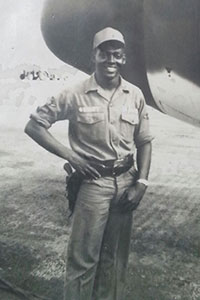
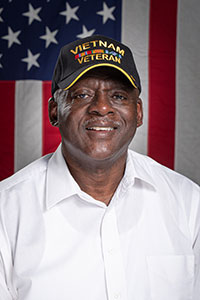 My name is Henry A. Guidry, Sr. I was born to Curley, Sr., and Kathryn Guidry in Houston (Fifth Ward), Texas, on January 29, 1948.
My name is Henry A. Guidry, Sr. I was born to Curley, Sr., and Kathryn Guidry in Houston (Fifth Ward), Texas, on January 29, 1948.
I attended public school in the Houston Independent School district at Atherton and Nat Q. Henderson Elementary, E. O Smith, Junior High and Phyllis Wheatley Senior High, class of January ’66. After graduation from high school, I attended Texas Southern University for one semester.
I joined the United States Air force (USAF) in July 1966 and spent the next 31 plus years (4 years active duty and 27 years in the USAF Reserves) in the military.
I started my career as a C-130 (cargo aircraft) mechanic, first, stationed at Mactan, AB, Philippines, January 1967 – February 1968. We flew support missions out of Tan Son Nhut AB, S. Vietnam, while serving 15-day rotation with each C-130 aircraft. I totaled a little over 100 day in Vietnam.
I completed my last 35 months of active duty at Edwards AFB, California. I served as a mechanic and a Scanner (part of the flight crew) on the C-130. I left active duty on July 27, 1970.
I spent the next 27 years in the Air Force Reserves, with the 924th (C-130) and retired as a SMSgt., Structural Superintendent, with the 307th Red Horse at Lackland AFB, San Antonio, Texas, in January 2003.
My civilian life has been equally rewarding. I retired from the Department of Defense (Defense Contract Management Agency) in December 2010 after 38 years of service. I served as a Quality Assurance Specialist, Branch Chief, and a Lead Quality Assurance Specialist.
Between my military and civilian careers, I have traveled to over 20 countries and 48 states (in the US). I have lived in the Philippines (13 months on active duty), Egypt (3 years), Australia (3 years) and Djibouti, Africa (4 months) as a civilian.
I am married to Monica Thompson Guidry and have five children (50 to 21 years) and eight grandchildren (28 to 6 years). My oldest grandson graduated from Navy Basic Training in May 2012.
I completed by bachelor’s degree at Texas Southern University in Houston, Texas with a degree in General Studies in May 2014.
I enjoy action movies. Some of my favorites are the Star Wars movies, the Batman movies, and the Men in Black movies. I enjoy military movies although sometimes I find them hard to watch.
I also enjoyed Armageddon. Parts of the movie was filmed at Ellington Field in Houston and I was cast as an Air Force Major, but the scene that I appeared in ended up on the cutting room floor.
I also enjoy watching romantic movies with my wife.
My passion is photography: I have been doing it since 1975.
Gutierrez, Winslow (Ben)
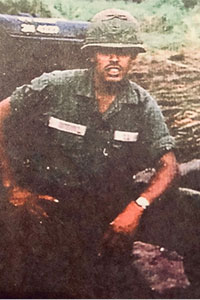 Winslow (Ben) Gutierrez
Winslow (Ben) GutierrezSergeant E-5 U.S. Army
I was born in Houston, Tx on October 10, 1945 to Charlie and Valentine Gutierrez.
I was drafted on Nov 29, 1965 and served until Sept. 2, 1967. Served basic training and AIT at Fort Carson, Colorado. Went to Ford Meade, Maryland for jungle training for Vietnam. Flew to Oakland, California in August ’66. Got on the USS Sultan and arrived in Nam in late August. Served with Black Horse (11th Cav.) 1st Squadron and last job in Nam as Track Commander.
I returned to Houston on Sept. 2, 1967. Met my wife on Sept. 2 at about 11.30pm at my parents house. Fell in love with her and we got married on August 3, 1968. We have been married a little over 50 years. We have one daughter and two sons, all married. We have 8 grandkids, 4 boys and 4 girls. Our oldest grandson just got married on May 4th so we have one granddaughter-in law.
Vietnam Combat Veteran
Ben Gutierrez
Haertling, Nelson
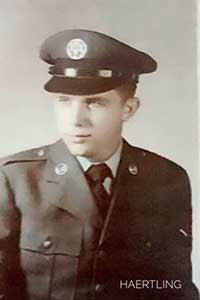 Nelson A. Haertling
Nelson A. HaertlingAirman First Class (A1/C), United States Air Force
Haertling served his country from 1954 to 1957.
He was born in Pocahontas, Missouri on May 31, 1935.
He volunteered in January, 1954 and completed basic training at Lackland, AFB, Texas, later attending Personnel School at Scott AFB, Illinois. After completing Personnel School, he was transferred to Manston RAF Station in England and served in the 406th Air Base Group maintaining airmen service records for a 3 year period. He was transferred to Maxwell AFB, Alabama and was discharged there in October of 1957.
Haertling attended Oklahoma State University (OSU) and graduated in 1964 with a BA degree in Architectural Design. He worked with the Army and Air Force Exchange Service (AAFES) from 1964 to 1992 designing and building PX’s and BX’s for the Army and Air Force.
After graduating from OSU, he married Melba Seaton in September of 1964 in Commerce, Oklahoma. They were married 42 years before Melba’s passing. They have two daughters and one grandson.
Haertling is retired and currently living at Kruse Village in Brenham, Texas.
Hagerty, Robert
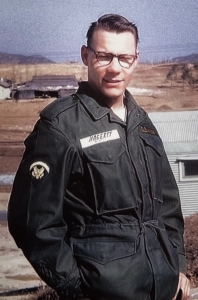 SP5 Robert Hagerty, United States Army
SP5 Robert Hagerty, United States ArmyRobert served his country from 1963 – 1966.
Robert enlisted in the US Army in June of 1963 in Boston, Massachusetts. He did his training at Fort Dix, New Jersey, and advanced airborne and infantry training at Fort Benning, Georgia.
In 1964 he was assigned to the First Calvary Division with orders to Viet Nam. At the Oakland Naval Base in Oak-land, California, he was reassigned to Camp Hovey, Korea, to patrol the heavily armed Demilitarized Zone (DMZ). He learned quickly that some people may not like you but soon became your, “fox hole brother.”
Robert was discharged from the Army in June of 1966. Before returning to Boston, he visited a close friend, Donny Glenn, who, “saved his ass,” on patrol duty near the DMZ. Robert was employed, along with Don, digging water wells in Ro-swell, New Mexico.
Robert later returned to Boston, where he took advantage of the GI Bill and graduated from Boston University with a BAS degree in Software Engineering. There, in 1974, he met this beautiful girl, Kathleen Clifford, who was from Ireland. A few months later they were married.
Shortly thereafter, they moved to Houston, Texas where he joined the space shuttle program of NASA at the Johnson Space Center in Houston.
This year (2023), Kathleen and Robert will celebrate their 49th wedding anniversary.
Robert and Kathleen are both retired. They spend a lot of time with their two daughters, two sons-in-law, and five grandchildren.
Robert still holds the title of, “First Place BBQer,” in the family.
hall, Lonnie
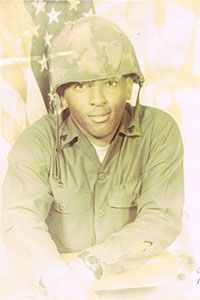 LONNIE L. HALL
LONNIE L. HALL
Sergeant Lonnie L. Hall answered the call to serve his country in 1966. The primary reasons were based on the influence of a high school teacher who was a veteran, remembering the words of President Kennedy’s 1961 Inauguration ‘My fellow Americans, ask not what your country can do for you, ask what you can do for your country’, and a basic desire to show his patriotism.
Hall was born in 1947 in the rural area of Washington County, GA and later his family moved to the central GA city of Macon in 1957.
He joined the US Marines in July1966 after graduating from Macon’s Ballard Hudson High School in May1966. He received his basic training at Parris Island, SC graduating with a Rifleman 0311 MOS 31Aug66.
This was not your normal summer at the beach. Not even close! I would do it again.
PFC Hall departed US Naval Base San Diego aboard the merchant marine vessel USNS Gen. LeRoy Eltinge 07Dec66 for the Republic of RVN. After a one day layover in Okinawa on 24Dec66, he, along with 3,500 other Marines, disembarked at DaNang, RVN on 29Dec66. Hall served his entire 13 month ‘tour of combat duty’ with India Company, 3rd Marine Battalion, 5th Marine Regiment, 1st Marine Division (I co. 3/5) FMF which was based at Chu Lai, RVN. Hall spent 30 days receiving additional training as a Combat Field Radio Operator at Marine Base Camp Hansen, Okinawa in Mar66. Camp Lance Corporal Hall was injured during Operation Swift on 07Sept66 in Que Son Valley, RVN and returned to field duty the next day after recovering from his leg wound. Hall ended his combat service and flew home aboard a chartered flight from DaNang to Kadena, Okinawa AFB on 24Dec67. He departed Kadena on 26Dec67 and landed back in the good USA on 25Dec68 (Christmas Day) arriving at Norton AFB in CA.
After a 30 day leave, Hall reported to Marine Barracks Camp LeJeune, NC to begin formation and training for a six month Mediterranean cruise. As a member of Battalion Landing Team Company L, 3rd Bn., 8th Regiment, 2nd Marine Division, Cpl. Hall’s unit embarked 18Apr68 on board the USS Cambria, along with 5 other Navy vessels in this BLT, departed from the port of Sunny Point, NC on 18Apr68 bound for the Mediterranean Sea. The cruise included several training and casual stops until we returned and disembarked 22Aug68 at Morehead City, NC.
Sgt. Hall spent his final year of active duty at Marine Barracks NWS Concord, CA serving as a Military Police. He was honorably discharged in 1970. He returned home to Macon, GA, found employment and married Sandra Parker in 1971 and they were blessed with three children. His employment took him to the Houston, TX area in 1981. Hall retired in 2013 and along with his wife enjoy traveling and spending time with their granddaughter.
Hamaker, Jack
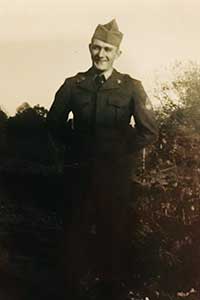 Jackie L. Hamaker
Jackie L. HamakerSergeant 1st Class, United States Army. Hamaker served his country in the Korean War from 1950 – 1952.
Hamaker was born in May 1932 in Leesville, Louisiana and was raised in nearby Anacoco.
He enlisted into the National Guard in 1949 and was drafted in the army in 1950, at the age of 17 and attended Boot Camp at Camp Polk, in the same town that he was born, Leesville, which later changed its name to Fort Polk.
Hamaker was assigned to the Tank Company at first, then was transferred to the Mortar Company for approximately 3 weeks, and was finally transferred to the Tank Battalion as Tank Commander.
In September of 1952, Hamaker was wounded in battle and discharged with the Purple Heart military decoration.
He returned home to Leesville and married Margie Arnold, whom he had met just prior to being drafted. They will be married for 65 years on October 31, 2018. They have three sons, six grandchildren, and five great grandchildren.
Hamilton, Clovis
 Born September 17, 1927 in Houston, Texas
Born September 17, 1927 in Houston, Texas
Enlisted as Apprentice Seaman : February 4, 1946 U.S. Coast Guard
Served country from February 4, 1946 to June 30, 1947 – active duty.
Honorable discharged as Seaman 2nd Class, Fireman 1st class and Fireman 2nd Class
Coast Guard Training Station – Alameda, California to Coast Guard Cutter AIR PARTRIDGE, to Coast Guard Cutter SEQUOIA, to Hawaii, Guam, Manila, Subic Bay including supplies to Loran station on Palawan back to Coast Guard Base in Alameda, California to Coast Guard Cutter IVY, from California through the Panama Canal to Charleston, South Carolina Repair Base.
On January 12, 1957, was married to his sweetheart, W. Faye Nettles – married for 58 years and still counting. They have three sons, one granddaughter and two grandsons and still live in Houston, Texas.
Hancock, William
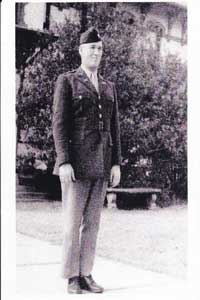 Born November 14, 1921 in Newark, Delaware where he lived and attended the University of Delaware through a football and baseball athletic scholarship.
Born November 14, 1921 in Newark, Delaware where he lived and attended the University of Delaware through a football and baseball athletic scholarship.
Hancock entered the Army through the ROTC program at the University of Delaware and was commissioned as a Second Lieutenant in January of 1943. After training at Camp Davis, North Carolina and Fort Stewart, Georgia he was shipped to England in September of 1944.
After a brief stay in England, Hancock was shipped to Germany where he was assigned to the Blue and Gray 29th Division, Company E, 1st Battalion, 116th Infantry. After a battle at Saint Lo and Brest German Submarine Base, the division with the Aachen, Germany. It was in the Battle of Aachen that Hancock was wounded and received the Purple Heart and Bronze Star Medals.
After World War II, Hancock joined the Army intelligence Corps where he served until 1954 when he left the Army with the rank of Major. Hancock later enlisted back into the Army as a Senior Non-Commissioned Officer.
Over the next few years Hancock did two tours during the Korean War and one tour in Vietnam. After 26 years of service and 32 family moves, he retired from the Army in January 1969 from Fort Bliss, Texas.
Upon retirement from the Army, Hancock received his Master’s Degree in Education and taught Elementary School for thirteen years.
After the death of his Wife of 62 years in 2005, Hancock moved to Spring, Texas. Here he resides with his daughter, and is in close proximity to his Son and Daughter-in-Law, three grandchildren and their families, which includes five Great-Grandchildren.
Hardin, Jerry
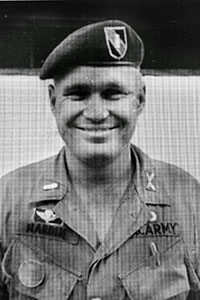
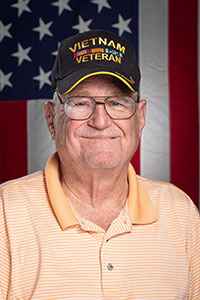 JERRY RAY HARDIN U.S. ARMY SPECIAL FORCES 1966 – 1972
JERRY RAY HARDIN U.S. ARMY SPECIAL FORCES 1966 – 1972
Born in Stamford, Texas – (1942)
Enlisted in the U.S Army – (1966)
Jump School – Ft. Benning, Georgia – (1967)
OCS – Ft. Bragg, N.C. – (1967)
Special Forces Training – Ft. Bragg, N.C. – (1967-1968)
Vietnam – (1968-1969) 5th Special Forces Group Detachment A-251 Plei Djereng
During the “Tet Offensive”
82nd Airborne – Ft. Bragg, N.C. (1969-1970) – Leader
42nd Company 2nd Special Forces – Thailand (1970-1972) Camp Champuri
Medals/Citations:
Airmen’s Medal, 2 Bronze Stars, Vietnam Service Medal, 2 Presidential Citations, Good Conduct Medal.
Earned: Vietnam , Thailand, U. S. and Combat Jump Wings
Discharged – 1972
Stateside became a Registered Nurse and retired in 2018.
Widower: (Patsy Ann Hardin) 2019
2 Sons: Jerry Wayne Hardin, Raymond Bruce Hardin
1 Daughter: Courtney RayAnn Ross
Currently lives in Rosenberg, Texas
Harris, Gerald
 First Lieutenant Gerald Harris enlisted in the Army Air Corps reserve in 1942 and was called to report for active duty in March 1943. Entering the rigorous flight officer training program for primary at Santa Ana, California, progressing through advance and receiving his wings and commission at Victorville, California, he was assigned to the B-24 Liberator bomber and transitioned at Tonopah, Nevada.
First Lieutenant Gerald Harris enlisted in the Army Air Corps reserve in 1942 and was called to report for active duty in March 1943. Entering the rigorous flight officer training program for primary at Santa Ana, California, progressing through advance and receiving his wings and commission at Victorville, California, he was assigned to the B-24 Liberator bomber and transitioned at Tonopah, Nevada.
As replacement for planes lost in action, he and his crew were assembled with other newly crewed 24’s and took off in May 1944 from San Francisco to Pearl Harbor for combat assignment. (Extra fuel tanks were fitted into the bomb bay for what was then an almost 14 hour flight from California to Hawaii). Upon retrofitting to bomb bay, refueling, taking on ammunition for all the gun stations and reporting as present and ready, his crew was assigned to the 220th Squadron, 90th Bomb Group, which was then stationed on New Guinea.
With stops on Guadalcanal and Tarawa, his plane reached its destination, Nadzab, New Guinea. The flight was a taste of the bombing pattern for the next year, island by island, on the way to the retaking of the Philippines under McArthur’s strategic plan to fulfill his promise of “I shall return”. The group’s target included shipping, military installations, supply depots, troop concentrations, ammunition dumps and, where feasible, beach defenses prior to offshore naval and marine attacks.
Returning to the States in June of 1945, he remained in the reserve until being transferred to the U.S. Air Force Reserve, from which he was honorably discharged in October 1955.
Upon his release from active duty, he returned to UCLA, completing the requirements for a BS Degree and continuing his studies for an award of a Masters Degree in Healthcare Administration. For 42-years, he designed, constructed and administrated hospitals, nursing homes and outpatient healthcare facilities.
Since 1973 he has lived in Houston with his devoted wife, who has been his caregiver and major supporter for 46 years. Also living in Houston are two of his six children and three of this seven grandchildren.
Harrison, Ray
Harrison arrived at the Marine Base in San Diego, California on December 24, 1941 for boot camp for 6 weeks. From there he went to Camp Elliot and joined a Machine Gun Platoon, and became a Gunner. He left the states around June 15, 1942 for the Soloman Islands and landed at Tulagi Island on August 7, 1942. He left from Tulagi about 45 days later for the Guadalcanal and was there until February 1943.
Harrison then went to Wellington, New Zealand for more training. He left New Zealand around November 1, 1943 and landed on Tarawa Island in the first wave. He was on a 50 calibur machine gun on an amphibian tractor and was wounded.
He then went to Aier Heights Hospital at Pearl Harbor for treatment. He left Pearl Harbor in late January 1944 and joined his unit at Hilo, Hawaii. From there they went to Saipan Island, then to the Tinian Island.
Harrison came back to the states in September of 1944, and was home on leave for 30 days. He then went to Washington, D.C. and joined a Guard Battalion at the 23rd and Constitution Street.
Around March 1, 1945 he was sent to Camp Lejeune, North Carolina and was there when the war ended.
He was discharged on December 26, 1945.
When he came back to Houston he started Harrison Construction Co. In 1960 he incorporated as Harrison Construction and Lumber Co. Inc. He retired in 1995.
Hernandez, Guadalupe
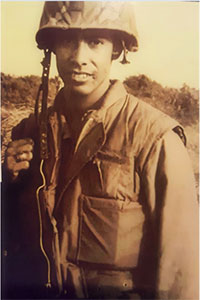 Guadalupe Hernandez
Guadalupe HernandezSergeant, USMC
I graduated from Asherton High School in Asherton, Texas back in 1965. After graduation, I volunteered for the United States Marine Corps from 1965 to 1969 to serve my country at war. Also, I volunteered to serve in Vietnam from 1966 to 1967 for 13 months.
Made it to the rank of Sergeant (E5) and participated in Operations of Hastings with 1st Battalion 3rd Marines, Operation Alleghany with 2nd Battalion 3rd Marines, Operation Deck House 5 Mekong Delta RSVN and participated in operations in the Hue, Phu Bai, and Da Nang areas.
Thanks to all donors for giving us veterans the opportunity to visit Washington, D.C. to see the site, and mainly, “The Wall,” so we may visit our heroes that never made it back home, never got back to enjoy life and see families and friends, never got to get married, have children, never got to be called, “Grandpa,” and never got to grow old.
I finish this with a lump in my throat.
Lupe Hernandez
United States Marine Corp
Heuermann, Anthony
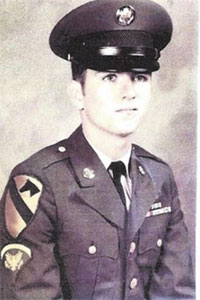 Anthony Wayne Heuermann
Anthony Wayne HeuermannSpecialist E-5 – United States Army
Served my country from
October 30, 1968 – October 29, 1971
Heuermann was born in February, 1951 in Houston, Texas.
He had to have a parent signature to enlist in the military because he was only seventeen years old. He enlisted in the US Army in Houston, Texas.
He was sent to Ft. Bliss, Texas as his first assignment for basic training. After completing basic training, his next assignment was Ft. Huachuca, Airzona to train in learning communications in Morse-coding.
Heuermann was then assigned for continual training for com-center, teletype and mobile communications at Ft. Gordon, Georgia.
In December of 1968, during his two week holiday leave, he married his childhood girlfriend, Mary, before moving on to his next assignment.
In January of 1969, Heuermann completed his AIT training and was trained in more specialized communications which included portable comm-center and landing zone bunker repairs and setup.
On August 4, 1969, he was assigned to the 1st Signal Brigade, Vietnam. After four months, was reassigned to the 273rd HHC, Sky-crane division of the 1st Aviation Brigade, and TDY with units of the 1st Cav.
When returning from Vietnam, and after spending thirty days at home with his wife and daughter, Heuermann’s next assignment was Ft. Sill, Oklahoma working as a Radio Operator at the base Mars Radio Station.
“I did come down on levy to return to Vietnam four time before my ETS, I made the decision not to re-enlist.”
He served out his last fourteen months of a three year term at Ft. Sill, Oklahoma.
Heuermann was discharged from the Army in October of 1971. He returned home with his family to Houston, Texas. December 2018 he and his wife will be celebrating their 50th Anniversary! They have two beautiful daughters and 4 grandchildren for which he and his wife were blessed to have raised on of their grandsons.
He is now retired after 30 years as an Insurance Agent and Financial/Estate Planner.
Heuermann is now giving back to his country by volunteering his time at his local VA Clinic which he enjoys.
“I thank God for my family and for the opportunity He gave me to serve my country and for the freedoms we have to this day.”
Hickey, Jack
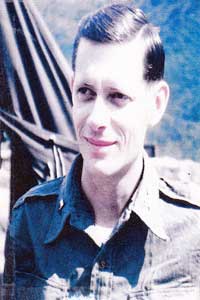 Sprouting among West Texas tumbleweeds in 1926 at Colorado City, Hickey grew up in Stephenville, Texas. He volunteered for induction into the Army in 1944 upon graduating from High School.
Sprouting among West Texas tumbleweeds in 1926 at Colorado City, Hickey grew up in Stephenville, Texas. He volunteered for induction into the Army in 1944 upon graduating from High School.
Following training at Fort Hood, he became an adequate Tank Destroyer radio operator and an expert at KP in the mess hall.
He then decided there must be more to Army life. So escaping KP, he pinned on his Good Conduct medal after a year, and went to Officers Candidate School at Fort Sill where he then pinned on his gold bar. That trinket earned him an Army cruise to sunny Italy, joining the 88th Infantry Division, 337th FA Battalion.
Returning home in 1946, Hickey re-upped in the reserves, returning to college. The Berlin airlift crisis brought him back to active duty for a brief period. Graduating from North Texas University in 1950, the Korean War (“whoever called it a ‘police action’ wasn’t there”) resulted in another Army trip. Over by air, back by ship. This was in 1952.
He became S-2 for the 176th AFA Bn., a separate unit assigned to support the Third ROK Division near Capitol Hill.
Back home, Hickey launched a career in newspapering where he put his journalism degree to work. In 1954 he ended his army duties, deciding that being called up three times in 10 years and getting shot at (and thankfully missed) during two of those three times was sufficient excitement.
Later he entered the oil industry where he retired in 1990 to a life of yard work, fire ant combat and honey-do’s. Irene Hickey, his wife of 30-plus years, shares his enthusiasm for the tennis court where they both play several times a week. Hickey also logs many horizontal hours on his sofa.
Between loafing and tennis he writes for a couple of publications, which keep him supplied with cold beer and cheap scotch. He has written three books, two published and one manuscript gathering dust. Irene is a well-known painter with her oils displayed around the world by collectors. They have a daughter, a son, four grandsons and a seven-month-old great-‘princess.’ The Hickeys live in Spring, Texas just north of Houston.
Hicks, Frank
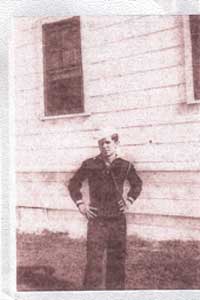 Seaman First Class United States Navy, Hicks served his country in World War II from 1945-1947.
Seaman First Class United States Navy, Hicks served his country in World War II from 1945-1947.
Hicks is a native born Houstonian and attended Reagan High School, where the January 1945 graduates enlisted in the service after graduation
After Navy bootcamp, he attended the EE & RM school at Gulfport, Mississippi. Hicks was stationed aboard the USS Andromeda (AKA 15). He was transferred to the USS John A. Bole (DD-755), until his discharge in 1947.
Hicks served on the committee that established the Heights World War II Memorial.
Hicks married May Eggleston in 1951, and they have two boys and three grandchildren. They will be married 64 years in October 2015.
After 45 years as a TV engineer, Hicks retired (KPRC-TV) in 1994. Hicks continued broadcast work with his own company until his stroke on August 5, 2014. He had been the Rockets’ home radio engineer (1974-2014) and Rice Football travelling engineer from (1983-2014). Hicks has three ‘Emmy’ Nominations to his credit.
Hicks is listed in the book ‘The First Forty Years of Houston Television.’
Hinojosa, Jimmie
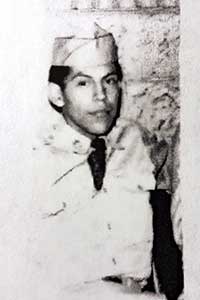 Jimmie R. Hinojosa
Jimmie R. HinojosaCPL, United States Army
Hinojosa served his country in the Korean War from November, 1949 – April, 1952. Jim was born July 25, 1931 in Lawton, Oklahoma before his family moved to Houston, Texas.
He enlisted in the Army right out of High School at the age of 18 in Houston, TX. He was sent to Camp Chaffee, AK for his basic training. After basic training in November, he went to Ft. Bliss, TX where he was assigned BTRY “A” 50th AAA AW BN (SP) where he served until the Korean War started in 1950.
In July, 1950, he was sent to Seattle, WA (Port of Embarcation) and was then sent to Korea and landed in Inchon on September, 1950. From there, he went all the way and fought to North Korea and stayed until the Chinese entered, then was driven back south.
We were picked up from the shore in Hungnam by boats and brought back to Pusan where our battalion was assigned to guard all the airfield for the remainder of our time until November, 1951. After a month of leave, we were sent back to Ft. Bliss, Texas until my discharge in April, 1952. I moved back to Houston, Texas and later met and married Maria Flores. We were married for 56 years. We have six children, 10 grandchildren, and 3 great-grandchildren.
Hodges, Jack
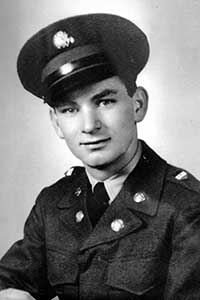 JACK L. HODGES
JACK L. HODGES
Jack L. Hodges served in the US Army Jan. 21, 1951 thru Dec 23, 1953. As I joined towards the beginning of the Korean War at 19 years old, I was inducted in St. Louis, MO then was shipped by train to Fort Sill, OK. Spent 3 weeks, received my shots, army clothes, and began my Army life. Off again by train to Camp Atterberry, IN. As the 28th Division was for the Korean War and was building up, that is where they put me. I was lucky that I was standing in the right line to be chosen for 28th Division.
I was given the opportunity for Med Co 110 Reg 28th Division. Spent almost 1 year at Camp Atterbury, then was sent to N.C. for training at Southern Pines, NC. We spent about a month on training as I was one of the drivers in the Convoy (2 ½ ton truck driver) Army Medic Company.
In November, we shipped out from Virginia to Germany – 28 days on water! Arrived in Hamberg around December 6, 1951.
While I was in Germany,I was able to travel to 10 different countries. Enjoying the people l met and the beautiful countryside. Met a beautiful nurse in Zurich Switzerland. We were married (captured so to a speak!) on Sept 22, 1953 in Switzerland. Then had to be married by German law, so did it again in Stugart Germany, then again in Germany but by the American Government. Now we are celebrating 67 years of marriage living happily near Houston, TX.
We have one daughter working as a nurse and one granddaughter currently in college
Thanks to the VA and all the wonderful people who made this life for me.
Holland, Charles
 [A letter to his Parents from Luzon, P.I. September 8, 1945]
[A letter to his Parents from Luzon, P.I. September 8, 1945]
Dear Mom and Dad:
Ho, me, this will be my first letter that won’t be censored for about eighteen months now. I have no idea what you know about what I do and where I’ve been. I’m a radio technician in the Jungle Air Force. Our unit serves in action with the infantry and directs Jungle Air Force bombers and fighters against ground targets.
I guess I will start from the first and tell you all the places I have been. I landed in Frisco April 1st and came across on the troopship Republic. I landed at Finschhafen, New Guinea on May 3rd. On June 15th I pulled amphibious maneuvers with the 33rd Division at Finsch. On July 1st I left by boat for Aitape, New Guinea and worked there with the 43rd, 32nd & 31st Divisions on the Driniumor River. On September 1st I left via LST for Morotai and landed there for “D” Day, September 15th. I left there on November 10th and went back to the outfit, which had moved up to Wake. I stayed there for a day and a half and then went back to Aitape to go on the Luzon Invasion with the 43rd Division, but my orders were changed while I was waiting on my plane at Hollandia, and I was attached to the 32nd Division again. That suited me because it put me in the same crew with Johnson. We left Aitape and went to Leyte and stayed there for 4 days and then went to Linguyan Gulf, thence overland to the mountains, and up the Ville Verde trail.
On April 21st we were sent down to Zamboanga, Mindanao to work with the 41st Division, but they had no use for us at present, so they split up our crew, half of which went up to Leyte to stage the 108th Regimental Combat team for an invasion of northern Mindanao. I was one of eight. We landed at Bugo on “D”Day, May 10th. We moved inland there over the Sayre highway and met the 31st Division at Malaybalay. When that was accomplished we were sent to the squadron at Leyte to rejoin the rest of the crew that came in while we were gone. We got to the squadron on June 14th and on June 17th I went to the hospital with malaria. After I got out of the hospital we were sent here by LST August 21st; 50 miles south of Manila, or 17 miles north of Batangas, right in the outskirts of a little Barrio called Liba. I am attached to the First Cavalry Division right now. We are transferring all the equipment out of the DUKV into the water buffalo. The First Cavalry is on its way to Japan. We will follow in a couple of days when we finish the tank job.
Your loving son,
Charles
Horn, Arlie

Arlie was born in Magnolia Springs, Texas on September 24, 1924 to Thomas JacksonHorn and Lenora Bell Nelson Horn. He is the 2nd oldest sibling out of 10 children. He attended local schools and graduated from Kirbyville High School in 1947. He was drafted in the United States Army in 1943 at the ripe young age of 18 years, He did his basic training in Mineral Wells, Texas and then was stationed at Camp Kitmer, New Jersey. He was a staff sergeant in the 29th Infantry Division. He shipped out to Lands End, England and on to Penzance/ England where he stayed in a private residence while training with the special forces. He and his division were past of the initial assault on June 6, D-Day-at Omaha Beach, Normandy, France. He lost many friends that day-over 12OO servicemen died out of the 29th Infantry Division. He was promoted to Tech Sergeant and helped lead his platoon in the assault and defeat of St, Lo, France. He continued his service on the front line until he was discharged on October 18, 1945. He received the Silver Star, the Bronze Star, the Bronze Arrowhead and three Purple Hearts for his service to his country, On a 30-day furlough leave in December t944, he met Mildred Ladene Daniels and they were married in Jasper in February L946. After a few years of working in Mississippi and Louisiana, he and his family settled in Beaumont where he worked for Magnolia Petroleum Company (buon/Mobil) for 34 years. He retired in 1985. In his retirement, he kept his sense of service by volunteering in many capacities for organizations and his church. Arlie is 90 years old.
Huet, Lawerence
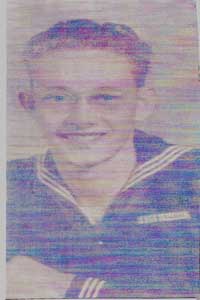 Seaman First Class (S 1/c) United States Navy
Seaman First Class (S 1/c) United States Navy
Served in World War II from December 1942 – January 1946
Huet was born October 3, 1924 in McCook, Nebraska. After joining the United States Navy on December 31, 1942 at the age of 17 he was sent to the Great Lakes Naval Base for boot camp.
From there he was sent to Boston, Massachusetts and assigned to the USS Bunker Hill, a new aircraft carrier. His job assignment was Airplane Handler on the flight deck. One of his responsibilities was to pull the chalks from the wheels of the aircrafts prior to takeoff.
During his time aboard they sailed from Boston to the Pacific, fighting against the Japanese. Huet’s time aboard the USS Bunker Hill was from May 24, 1943 thru June 6, 1944 before taking a 30-day leave. After the leave, he reported aboard the USS Flint Anti-Aircraft Cruiser where he served for the remainder of the war.
Huet was discharged on January 23, 1946 and married his lovely wife the day after being discharged. They met while he was on his 30-day leave and were married for 64 years before her passing in September 2010.
Huet’s medals and achievements include:
• 9 Asiatic Pacific Battle Stars
• 1 Philippine Liberation Star
• Victory Medal
• Good Conduct Medal
• Meritorious Conduct aboard the USS Bunker Hill
• USS Bunker Hill Presidential Unit Citation
Hutner, Raymond
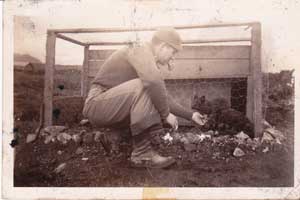 Hutner was a Sergeant Major with the 13th Combat Engineers. He was drafted January 20, 1941, serving for one year with the 13th CE. Later he served for four years and 9 months with the 7th Infantry Division.
Hutner was a Sergeant Major with the 13th Combat Engineers. He was drafted January 20, 1941, serving for one year with the 13th CE. Later he served for four years and 9 months with the 7th Infantry Division.
Hutner was overseas for two years 9 months during the Pacific theatre for four invasions.
Hutner was discharged in October of 1945.
In picture – Hutner on Attu of the Aleutian Islands with Blue Foxes in 1943.
Ibanez, Juan L.
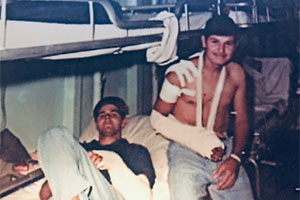 Juan L. Ibanez
Juan L. Ibanez
Cpl. Juan L. Ibanez served his country in Vietnam from 1968-1970
Juan was born on January 18, 1950 in Pharr, Texas to Isidro and Maria Ybanez. His father is a World War II Veteran. He has 6 siblings, and the older brother, Isidro Ybanez, Jr., also served in Vietnam.
Juan volunteered into the Marine Corps on April 1, 1969. When asked by his father why he enlisted into the Marine Corps, Juan’s answer was “because I liked the uniform.” Juan was flown to MCRD, Marine Corp Recruit Center in San Diego, CA.
Sometime in May 1969, Juan was shipped to Vietnam where he was part of the 1st Marine Division stationed outside Da Nang at LZ Baldy. He is unable to recall what company he was with.
On December 25, 1969, Juan was a M60 Gunner (0331) on a mission northwest of LZ Baldy about 10 miles out. Thee was a cease fire due to the Christmas Holiday. Around dusk, Juan was on guard duty where torches provided enough light to see the enemy. Music was baring with the Beatle’s song “Fool on a Hill.” It had started to rain, and Juan felt just like the song was saying – Fool on a Hill. The enemy seemed to know where the Company had set up camp because they would yell out “Marine, you die tonight!”
Juan was relieved from guard duty after several hours and ordered to pack up. It was now December 26, 1969 early morning. As Juan and the other Marines made their way down the hill, one of the marines in front fell and broke both of his legs at the knees. Juan was ordered to assist and take the Marine’s rifle. Juan asked the wounded Marine if his weapon was on safe and the Marine replied that it was. As it was very slippery and downhill, Juan wrapped his leg around a tree in order to reach the Marine’s weapon. Due to the odd position the wounded Marine was in, the only part of the weapon that Juan could reach was the rifle’s flash suppressor. With his right hand, Juan pulled the weapon towards him. At that moment, the enemy caught up with the Marines and a fire fight ensued. Juan went for the rifle to defend himself and the wounded Marine. The wounded Marine did the same, and the rifle fired. Juan’s right hand received the full blast of the bullet. It traveled into his wrist, into his right shoulder and out the back of his shoulder.
Juan and the other wounded Marine were flown out and hospitalized at a Mash Unit and LZ Baldy. Juan was then flown to the USS Sanctuary where his wounds were attended to and several weeks later, Juan was flown to Guam then several weeks later to Corpus Christi, TX. While at the US Naval Station in Corpus Christi, Juan received a Purple Heart for his wounds.
Juan was placed on temporary retirement on January 15, 1971. Later in the year he was Honorably Discharged. He married Alejandra Vela on December 24, 1970, and had
Ikner, Montgomery
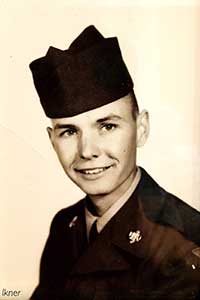 MONTGOMERY (MONTE) IKNER
MONTGOMERY (MONTE) IKNER
US Army
I attended North Hollywood High School in California where I was in the ROTC – Lt Col, Capt Rifle Team, Expert.
Volunteered 17 ½ yrs old US Army Service School, Army Security Agency
Basic Training; Mike, 63rd, Fort Ord Calif.
Military Intelligence School, Ft.Devens, Mass.
Rank: Agent 2 Assigned Post temp short term 1st Lt ASA (Mobile)
Assigned Europe Headquarters Command, Seckenheim, Germany
1953 Mobile Courier, MOS 1616 CRYPTO/TS documents from field to HQ
Intercepted data from overhead planes in sectors Russian, British, German, Belgium
1957 Left active service for College, LACC.
Transferred to USAR California. NSA MIL HQS FT MACARTHUR, SAN PEDRO, CALIF
Married Sept 1957, to my college sweetheart, Wilma.
1957 Los Angeles Junior College Cal State, Management
Certifications: UNY, UH, SMU, Notre Dame, AMA Mgmt 4 yr degree
1960 Stop N Go Stores Calif, West Coast Div Merch. Mgr
1964 NSA Honorable Discharge, 12 years, Agent SP4
Medals; Expert 30cal Rifle, Good Conduct, Europe Command, Reserve Comp
National Convenience Stores, Executive Staff Mgmt, Houston, TX 24 yrs
Corp Equip Mgr, Corp Commissary Mgr, Corp Equip Mgr.
Rtd 1984 Founded Memorial Microwave Ctr Houston Tx
Commercial Kitchen Equipment, 220’ high heat equip.
Texas Distributor Svc/Sls Amana, Sharp, Litton; Houston 100 Chronicle Club
2008 Sold Company, Rtd 72 yrs old
We have 3 Sons with families in Texas, 5 grandchildren, and have been married 59 yrs.
Present: Collette Travel Co volunteer Travel Guide
American Legion Katy ISD Boys State Chairman
Johnsen, George
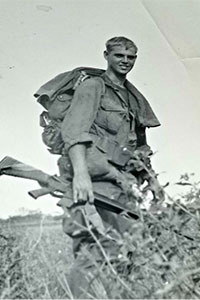 George Johnsen
George JohnsenUnited States Army
George was born in Miami, Florida in December, 1946. He graduated High School in 1964 and went to Junior College until September, 1966.
George volunteered for the U S Army, attended NCO school, Airborne etc. He was assigned to 101st Airborne Division & arrived in Vietnam in October, 1967 and proudly served with B /2nd/ 501 which saw heavy combat all through the TET Offensive.
George was awarded the Purple Heart, & Bronze Star for Valor.
“I was saved from self-injury (suicide) by the Lord introducing me to my wife Elaine. This Lady has been my salvation. One son, Scott, and two beautiful granddaughters, Kylie & Skyler”
Johnson, Ardean
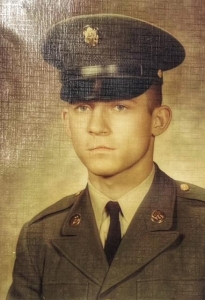 Ardean Johnson
Ardean JohnsonUS Army
Vietnam War
Howdy, my name is Ardean (Dean) Johnson. I was born on April 14,1949 in Detroit Lakes MN and grew up in a large family of “10” in and around the small rural towns of Beltrami and Fertile MN. A few months after graduation with the class of “67” from Fertile High School I volunteered for the draft and entered the US Army on Dec 8,1967. I was sent off to Ft Lewis WA for my Basic Training and remained there for my AlT Training as a 11C Mortarman (indirect fire infantryman). After my 11C training and a short trip home with my family, I flew to Oakland CA and boarded a Seaboard World Cargo plane headed to the Republic of Vietnam. I was one of a large number of non airborne troops assigned to the 3rd Brigade 82D Airborne Division in a light infantry capacity as a 4 deuce mortarman. Initially, we were up in the DaNang and Hue area and later down in the Saigon, Bien Hoa area. In Dec of 1968 I had a great R&R in Sydney Australia and a few months later I enjoyed a week in Taipei, Taiwan. In July of 1969 I returned to Ft Lewis where I was discharged and then returned to Northern Minnesota and my family. I attended the University of North Dakota in Grand Forks a couple years and then moved to Memphis where I lived for several years and attended Memphis State University. Somewhere during those school years, I started working with Northrup King Seed Co out of Minneapolis, MN and worked with them for 25 wonderful years throughout the midsection of the United States. In 1979 I moved to Texas where I still live today. Over the years we have worked with and enjoyed several network marketing companies, including about 10 years with a travel company that took us to numerous places and introduced us to cruising. We have always been involved in agriculture in some capacity, mostly with animals…. wallabies and aoudads to african hoofstock.. oryx, nylgai etc. and birds from ostrich on down to waterbirds.
These days, we live in the country outside of Hockley TX. We still have some birds and we are fostering dogs short term before they head to their new forever homes up in the NW states and Canada. It’s been a good life.
Johnson, Harvey
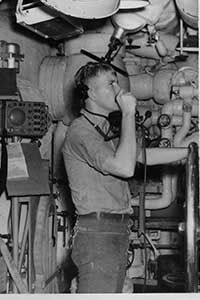 Harvey L Johnson
Harvey L JohnsonU. S Navy 1955-1959
Was born and raised in northern Wyoming. I spent my early years on a cattle ranch and then we moved into town, Sheridan, WY. I attended schools there until I enlisted in the Navy when I was 19 years old.
I attended Boot Camp at the Naval Training Center in San Diego, CA. From there I was assigned to the heavy cruiser USS Bremerton CA130. I served on this ship for my entire four years.
I served as a Machinist Mate in the forward engine room where engines number one and two were located. Three and four were in the aft engine room.
During these four years we made three cruises to the South Pacific with the 7th Fleet. These included trips to Japan, Formosa, China, Okinawa, Philippines and many small islands of the South Pacific, Singapore, Australia and New Zealand. Highlights of those trips included crossing the equator on each cruise and fortunately we got to be in Australia during the 1956 Summer Olympics. All of these were quite the adventure and education for the young man who came from Wyoming.
I was honorably discharged after four years of service as a Machinist Mate Second Class Petty Officer. Upon discharge I returned to Wyoming and have been there to this day.
Johnson, Victor Max
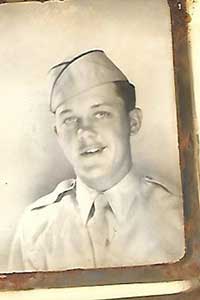 Victor Max Johnson
Victor Max Johnson
1st Lieutenant, United States Army (Corps of Engineers)
Served in Korean from November 1950 to November 1952
Max’s military service began with enrollment in the ROTC program at Fair Park HS in Shreveport, LA, and continued through the required and advanced ROTC program of Louisiana State University where he received his commission as 2nd Lieutenant in June 1949.
Max was born and raised in Shreveport in April 1929 and lived there until he was called into active duty in November 1950. He reported to Camp Rucker, Alabama, an inactive, temporary camp from WWII. The first assignment was to renovate the camp for use as a basic training facility while giving basic training to the newly assigned personnel. After cleaning coal dust from the barracks floors and cow patties from the weapons ranges, he was transferred to Camp McCoy, another WWII facility in Wisconsin, where the temperatures ranged from 23-54 degrees below zero. He continued working on camp renovations and conducting basic training; the acclimation to freezing temperatures was based on reports coming from Korea.
Max was called to Korea in April 1951 as a replacement for a SCARWAF unit. His first assignment was K-1 near Pusan where they built, repaired and maintained air strips for all branches of the United Nations armed forces. He was technically assigned to the US Air Force. His outfit worked their way north to Wonju, Chunchon and Seoul, with side jobs at Taegu, Kimpo, and Kaesong with some PSP pads for helicopters.
Max completed his tour at Seoul City and was assigned to Orlando AFB in Florida where his primary duty was assistance to NASA’s developing space program. He worked on landing strips for planes being used to pick up capsules/missiles fired from Cocoa Beach. He was released from active duty in November 1952.
Following his release, Max began a 25 year career in the oil business, followed by a 40 year career in the insurance business. He is blessed with a marriage of 64 years and a family many would dream for: 2 daughters who married worthily and 5 grandchildren.
“Serving his country in the military contributed in many ways to the joys of his life: knowledge, experience, belief system, friends, opportunities and much more. And now, it gives me the time of sharing and visiting with fellow veterans on the Honor Flight. Thank you.”
Johnson, Roy
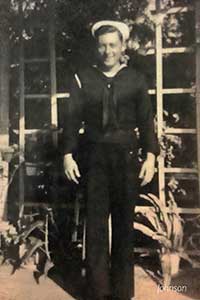 Roy E. Johnson
Roy E. Johnson
Lt. in the US Navy (CEC)
Served 1944 – 1946
Recalled 1951 – 1953
Roy was born February 13, 1921 and was raised in New Orleans, Louisiana.
He attempted to sign up for the Navy in 1942 when he was a junior at Tulane University. He was rejected because he measured ¼ inch too short. He went on to graduate in Civil Engineering. After graduation, he married Elodie Pujols. They quickly headed to California where he worked for Douglas Aircraft. After working for a year, Roy still felt that he wanted to serve in the Navy. He decided to try to sign up again. He was able to enlist as an Apprentice Seaman and this time his height was not questioned.
Roy started boot camp in San Diego on July 8, 1944; he then went on to Quarter Master School. In February, 1945, he was transferred to Construction Battalion Officer’s Training in Davisville, Rhode Island. By May of 1945, Roy was returning to California – this time to Port Hueneme Construction Battle Center where he served as Assistant Personnel Officer until his discharge on September 23, 1946. He remained in the Naval Reserve and was recalled to serve in Yokosuka, Japan from 1951 – 1953.
Roy and “Dee” shared a wonderful life for 74 years until she passed away in 2017. They raised a son and daughter, have 5 grandchildren, 6 great-grandchildren with one more on the way, 1 great-great grandchild and expecting one more.
Jones, Jerry
 U.S. Army, 431st Motor Vehicle Assembly Co., Corporal/Tech 5
U.S. Army, 431st Motor Vehicle Assembly Co., Corporal/Tech 5
Jerry A. Jones, Jr. was drafted on May 18, 1943 and reported to Ft. Bragg, North Carolina. He was assigned to U.S. Army Ordinance.
From North Carolina he was deployed to Liverpool, England through New York. Not long after D-Day, he crossed the Channel into France where his company set up their assembly line in a muddy field near the shore surrounded by hedgerows. Jeeps, weapons carriers, and 6×6 trucks were shipped from overseas in crates to them. Their job was to uncrate, assemble, and drive the vehicles off the end of a 10-bay assembly line.
The American infantry was pushing the Germans back so fast they would run out of ammunition. Jones’ company assigned all of the unmarried soldiers (he was one of them) to a vehicle. He would drive from the assembly line to the beach where he was loaded up with ammo, then straight to the front lines, back and forth, over and over. This continued through France, Belgium, Holland, and Germany.
Jones received the EAMET Campaign Medal, 3 Bronze Stars, and a Victory Medal. He traveled back to New York on New Year’s Eve 1946 from Le Havre, France after two full years of service in Europe.
He attended North Carolina State University on the G.I. Bill. He worked for his Father, who was an electrical contractor for a while before joining the U.S. Army Corps of Engineers as an Electrical Engineer. He came to Houston in 1962 and worked with NASA at Johnson Space Center for 40 years. Jones is now retired and living in Pasadena, Texas.
Karp, William
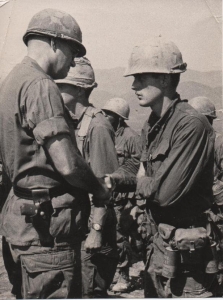 William W. Karp
William W. Karp
Vietnam War Veteran 1967-1968
US Army
Served with Alpha Company 3rd of the 21 st, 196th Light Infantry
Brigade as a Combat Medic
Total time in service 1 year 10 months 13 days
Total time in Vietnam 1 year 1 day (Leap year)
Total time in field 10 1⁄2 months
Vietnam locations, LZ Center, Nhi Ha (7 klicks from the DMZ), LZ Colt, LZ Baldy, Chu Lai, Tam Ky, Heip Duc Valley, Nui Loc Son.
Awarded the basic medals plus two Bronze Star Medals with V for valor and the Purple Heart
Actions noted in books,
“The Magnificent Bastards” by Keith Nolan and
“Through the Valley, Vietnam 1967-1968” by James F Humphries
Kelly, Bill
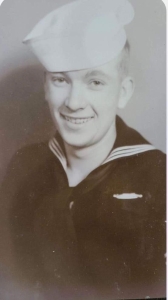 Hello, my name is Bill Kelly. I was born in Haxtun, Colorado on October 5, 1930. I attended Gill High School until I was 17 years old when I enlisted in the Navy. I did basic training in San Diego, California. After basic training, I was assigned to the VP47 patrol squadron. We flew in the PBM Martin patrol bombers where I was a AO3 (bombardier). I spent four years in the same squadron and the majority of my time was spent in The South Pacific. I received an honorable discharge in 1952.
Hello, my name is Bill Kelly. I was born in Haxtun, Colorado on October 5, 1930. I attended Gill High School until I was 17 years old when I enlisted in the Navy. I did basic training in San Diego, California. After basic training, I was assigned to the VP47 patrol squadron. We flew in the PBM Martin patrol bombers where I was a AO3 (bombardier). I spent four years in the same squadron and the majority of my time was spent in The South Pacific. I received an honorable discharge in 1952.
After my service in the Navy ended, I lived and worked as a Teamster in California for 17 years. Then, I moved back to Colorado and learned the television repair business. I owned and operated one shop in Salida, Colorado and two in Denver. My two sons, Les and Steve learned the business and worked with me. I have six daughters, Charlene, Debbie, Roberta, Paula, Karen, and Joyce. After 30 years in Colorado, I retired and my wife, Gladys and I moved to Huntsville, Texas to live with our daughter, Debbie. After 49 years of marriage, my wife passed in 2019. I continue to live with my daughter and enjoy playing golf and working in my wood shop.
Kelly, Frederic
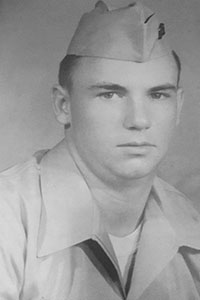
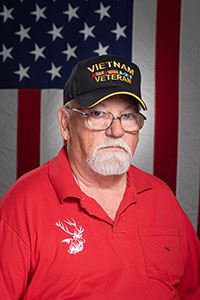 Frederic Kelly
Frederic Kelly
USMC; SSGT
I enlisted in Marines in San Diego Feb 1966. I was 17 years old going to college and decided to enlist before the draft. Boot Camp in San Diego, ITR at Camp Pendleton. Stationed at Cherry Point, North Carolina for training. Orders to Westpack came shortly. Jungle Survival School at Camp Pendleton. Then, overseas aboard the USS General John Pope and landed in Okinawa 17 days later. I was assigned to fighter Squadron VMA 223. Flew to Japan and then to Viet Nam. First Tour – Chu Lie. As a young Marine, I worked in communications, drove a truck, air base security, and anything else that came along. I was kind of a general duty Marine. I did however take a few correspondence courses from IBM Education Atsugi Japan.
My second tour I volunteered to go to Da Nang, 1st Marine Air Wing as a computer programmer. From the few courses I had taken it didn’t seem too difficult. I stood security on the wire at night and trained as a supply programmer during the day. I hitchhiked on helicopter to Quang Tri, Phu Bie, delivering bags to other commands.
I did whatever job was asked of me.
I returned state-side March ‘69, Hq 3rd Marine Air Wing as a Supply Digital Programmer, I went on to the 4th Mar Div , and worked on large software systems. I was discharged April 76 from Camp Pendleton .
I joined the Navy Reserves for four years. I moved to Juneau Alaska and worked for the Bureau of Indian Affairs. There was no Naval Reserve in Juneau so I transfer to the Army National Guard.
That’s how I have 10 years active duty in USMC, 4 years in USNR, and 6 Years in Army National Guard.
After Alaska, I worked for IRS for 20 years. Retired from IRS, retired from reserve components. Now, just tired.
I have taught college, courses in IT, tried hunting and fishing, now run a VFW in support of Veterans.
Kennedy, Wayne
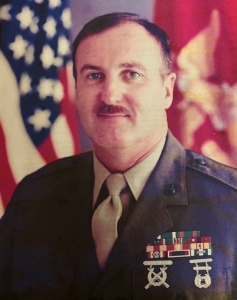 Wayne F. Kennedy
Wayne F. Kennedy
Master Sergeant, United States Marine Corps (Retired).
Vietnam War
MSgt Kennedy served his country from 1969 – 1993.
He was born in September 1948 in Houston, TX.
He received his draft notice in May 1969 and enlisted in the United States Marine Corps, attending basic training at MCRD San Diego, Ca and ITR training at Camp Pendleton. He received Aviation Ordnance School training at NAS Jacksonville, FL. Following training, he was transferred to MCAS Beaufort SC and assigned to VMFA-333 Fighting Shamrocks and was deployed as part of CAG-8 aboard the USS America, CVA-66 and deployed to the Mediterranean June 1971 – December 1971. He deployed again to the Tonkin Gulf June 1972 – March 1973. During the time he operated with close air support and MIG Cap missions in North and South Vietnam. On September 11, 1972 two of our F-4J Phantoms incurred an aerial battle – 2 F-4J vs 6 Mig-21. Our Crew (Maj. “Bear” Lassiter and Capt. “Lil John” Cummings) became the first Marine squadron to score a MIG kill. At the end of our tour during February 1973, our aircraft assisted in escorting the first three C-141 aircraft with released American POWs from Hanoi to Clark Air Base, Phillippines.
Following his tour in the Tonkin Gulf, MSgt Kennedy served tours with VMFAT-101 Yuma, AZ, F-14 Tomcat Program NAS Miramar, CA, then returning to MCAS Beaufort, SC to VMFA-451, deploying with CAG-17 aboard the USS Forrestal. After two over seas tours to MCAS Iwakuni, Japan, MSgt Kennedy reported to NAS Lemoore, CA, conducting F/A-18 Hornet weapons system training for the US Navy and Marine Corps and the Royal Canadian Air Force and The Royal Australian Air Force.
Transferring to MCAS El Toro, MSgt Kennedy joined MAG-11 and reported to VMFA-323 “Deathrattlers”, deploying aboard the USS Coral Sea with CAG 13 and participating in Operation Eldorado Canyon and conducting the Libyan Raid, attacking Benghazi while the USAF F-111s hit Tripoli.
MSgt Kennedy returned to MCAS El Toro and perform duties at VMFAT-101 and MCAS El Toro Station Weapons Facility, then retired July 1993.
Aviation did not leave his blood. Following military retirement he joined the Commemorative Air Force Gulf Coast Wing fulfilling duties as Adjutant, Executive Officer, Wing Leader and Flight Engineer with “Texas Raiders” B-17G Flying Fortress.
MSgt Kennedy married his Sweetheart, Kay Propst in April 2002. He has 3 children from a previous marriage and 10 grandchildren.
I am thankful for the opportunity to serve my country. It gave me the opportunity to realize how fortunate we are as United States Citizens to enjoy the freedoms we often take for granted.
Kiker, Leland
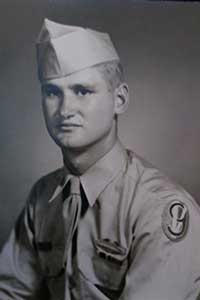 Captain Leland Kiker, born June 21, 1926, graduated from Childress High School in the Spring of 1944, and was drafted into the Army in October of the same year. He completed Basic Training in Ft. Benning, Georgia, and after a 14-day leave boarded the RMS Aquitania (February 24, 1945) for a 13-day voyage to Scotland. Once there, PFC Kiker traveled by train to London, England, stepped off the dock onto a Landing Craft, Tank, and crossed the English Channel into Le Havre, France.
Captain Leland Kiker, born June 21, 1926, graduated from Childress High School in the Spring of 1944, and was drafted into the Army in October of the same year. He completed Basic Training in Ft. Benning, Georgia, and after a 14-day leave boarded the RMS Aquitania (February 24, 1945) for a 13-day voyage to Scotland. Once there, PFC Kiker traveled by train to London, England, stepped off the dock onto a Landing Craft, Tank, and crossed the English Channel into Le Havre, France.
He joined Patton’s Third Army, 87th Infantry Division, crossing the Rhine River, under fire, from France into Germany, where he served in combat until Germany surrendered. After VE Day, PFC Kiker traveled back to Ft. Benning for training in preparation to invade Japan, but during a 30-day leave, atomic bombs ended the war with Japan. He volunteered to stay on active duty for a year, was promoted to the rank of Technical Sergeant, and qualified for four years of the G.I. Bill. After serving that year in Germany, Sergeant Kiker enrolled in Texas A&M, joined the Corps after two years, and graduated with a degree in Range and Forestry in 1950.
Upon graduation, Sergeant Kiker received his commission as Second Lieutenant and joined the 49th Infantry Division sent to Korea. While serving in Korea, he was awarded his 2nd Combat Infantry Badge and was discharged after four months because of his service in WWII. He was called back to active duty as Executive Officer during the Cuban Missile Crisis, served through the end of that conflict, and was promoted to Company Commander.
After his service to our country, Leland worked as a cowboy, specializing in selective breeding, on several ranches in Arkansas and Texas. He resides in Llano with Neva, his wife of 28 years and has six children (five from his marriage with his first wife Ann). He has six grandchildren and three great-grandchildren.
King, Marvin
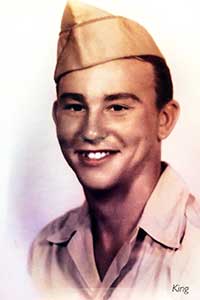 Marvin King
Marvin KingCorporal – United States Army
At this time, I would like, in behalf of the veterans and active military personnel, thank the administrators, staff, and students for honor they are showing us. It couldn’t be better.
First off, I would like to tell you that I was the youngest of three boys in our family.
My oldest brother enlisted in the Navy right after graduation from high school in 1939. He was at Pearl Harbor when the Japanese invaded us on December 7, 1941. He went through the whole war and retired after 20 years.
My other brother went in the Arm in the middle of 1944 and was killed on March 18, 1945.
Then on April 8, 1945, I joined the Army and took my training at Camp Hood. After 6 weeks of training, they sent me to North Camp Hood for training in the tank destroyer division on the M-18 Hellcat. The M-18 was a full tract vehicle with a 75MM gun on it. I was capable of traveling 60mph on open terrain.
During this time, there were two Presidents – Roosevelt and Truman. Roosevelt died April 12, then we had Truman. We were on our last night in the field when Truman authorized the first A-Bomb to be dropped on August 6, but the Japanese didn’t give up – three days later, the second A-Bomb was dropped. That was when they surrendered.
We go out orders to go to Japan shortly after that. I was with the first ones to go to Japan after the war was over. We shipped out from San Francisco and it took 21 days to get there. We arrived in the fall and in the rainy season. We had tents to sleep in with sand floors.
After several days there, we had recruiters from the 11th Airborne Division to come down from Sendai and told us what good food and barracks they had. I think everyone at the signed up! When we got to Sendai, it was like they said.
Our job there was to destroy all of the Japanese underground bunkers.
I reenlisted and came home for a month, then was assigned to the 988th Combat Engr. Battalion at Hood for the balance of my enlistment time.
Klinegardner, Harvey
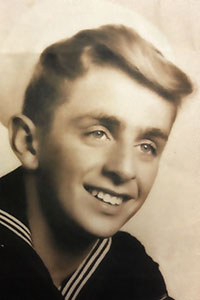
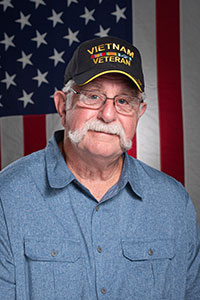 Harvey F Klinegardner
Harvey F Klinegardner
EOCN, United States Navy Seabee
Served his country in the VietNam War 1968-1969
Harvey was born in Walton, New York. He joined the US Navy in 1965 at 18 years old and attended the Great Lakes Naval Academy in Illinois.
Seabees was a closed rate at this time. I was assigned to Quonset Point Rhode Island, then sent to Westerly Rhode Island two weeks later. Finally, after a year I went to EOA school at Davisville, Rhode Island.
Completing EOA school I was sent to Roosevelt Roads, Puerto Rico then sent to Vieques Island.
In 1967, I was assigned to Mobil Construction Battalion 4 in Oxnard, California. MCB-4 deployed to VietNam the latter part of 1967.
Some action was during the Tet offensive early in January 1968. MCB-4 was near Quang Tri, Camp Evans. MCB-4 built many huts for the 101 airborne and a runway, also the An Io bridge near Hue. I made many convoys between the camp and Da Nang hauling fuel.
I was discharged from the Navy in November 1968. Met my wife Ginger in California and married in 1969. We have two children and 6 grandchildren. We have been living in Texas for the past 34 years.
Kologinczak, Julian
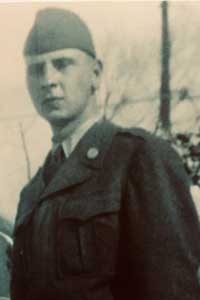 Julian Gregory Kologinczak
Julian Gregory Kologinczak
Julian was born in Houston, Texas on January 16, 1930. He was drafted into the Army on January 4, 1951 and served two years. He was stationed at Camp Polk, Louisiana where he took basic training, followed by land infantry training.
In August, 1951, he was sent overseas to South Korea. He arrived at Pusan, Korea and was called to go to Taegu, Korea. There he trained for six weeks in radio school.
After training, he was sent to Seoul, Korea to the 8075th Army unit, a small communication outfit directly under 8th Army. The main comcenter in Seoul, Korea consisted of small radio teams of six to nine men in non-American outfits. They served as in-betweens for Army infantry and Air Force. Julian was placed with the British First Commonwealth Division and then the Ninth Republic of Korea (ROK) Division.
In December 1952, Julian was shipped back to the United States after two years of service and was honorably discharged from the Army.
Kongable, Bill
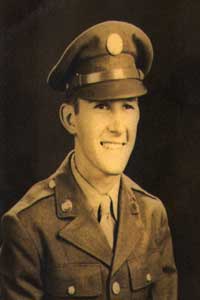 We were the liberators of the first concentration camp in Germany. I cannot forget the images we saw and what the Nazis had done to the people in that camp.
We were the liberators of the first concentration camp in Germany. I cannot forget the images we saw and what the Nazis had done to the people in that camp.
J.W. “Bill” Kongable was born and raised in Hominy, Osage County, Oklahoma. On finishing High School in May, 1944, he was drafted into the US Army at Fort Sill, Oklahoma.
He received his Infantry basic training at Camp Fannin, Texas, and then was assigned to the 89th Infantry Division, 354th Anti-Tank Company at Camp Butner, North Carolina. He went to the European Theater of operations with the Division in January 1945.
In March 1945, the 89th division joined the Third Army’s assault on the Rhineland, crossing the Sauer, Moselle, and Rhine rivers that same month. On April 8, the 89th captured the town of Eisenach and subsequently advanced farther into Thuringia and into neighboring Saxony, where it took the city of Zwickau on April 18, 1945.
On April 4, 1945, the 89th overran Ohrdruf, a subcamp of the Buchenwald concentration camp. Ohrdruf was the first Nazi concentration camp liberated by US troops in Germany. A week later, on April 12, Generals Dwight D. Eisenhower, George S. Patton, and Omar Bradley visited Ohrdruf to see, firsthand, evidence of Nazi atrocities against concentration camp prisoners.
We were all fairly young, had never been out of the country, and had ridden a train twice in our lives. The bombing destruction we saw of European cities by the U.S. and British air forces left nothing behind but piles of rubble.
After the end of the war, Bill served in the Army of Occupation in Austria until discharge at Ft. Sam Houston, Texas in June 1945. His awards include: Good Conduct Medal, Combat Infantryman Badge, Bronze Star, Europe-Africa-Middle East campaign medal with 2 bronze service stars, WW II Victory Medal and Army of Occupation medal.
Bill attended Canal Zone Junior College and the University of Oklahoma, receiving a BS degree in Chemical Engineering in 1951. He then worked for Monsanto Chemical Company in Texas City, Texas, Teesside, UK, and Alvin, Texas until retiring in 1985. He has been married to the former Phyllis Ann “Pat” Tassell for 65 years, marrying in Panama in May 1948. They have two children, Richard Kongable of Cuesta de Piedra, Panama and Patrica Ramsey of Friendswood, Texas and 2 grandchildren, Lauren Ramsey of Houston, Texas, and Kimberley Ramsey of Friendswood.
Krueger, Wesley
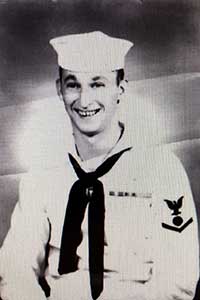 WESLEY FRANK KRUEGER
WESLEY FRANK KRUEGER
Electrician Mate 2nd class (EMP-2), United States Navy. Wesley served his country from 1951-1959.
Wesley was born on October 20, 1933 in Houston, Texas. He is a lifelong Houston resident.
He enlisted on October 10, 1951 and completed Electricians Mate school in San Diego, California. Wesley was assigned to the USS Piedmont (AD-17) for the duration of his active duty. He completed two trips to Korea and Japan during the Korean conflict.
Wesley was awarded three medals: National Defense, United Nations, and Korean Service. Wesley was honorably discharged from the Navy on October 10, 1959.
He returned to Houston. He married his sweetheart Bertha “Puddin” Domaschk on June 15, 1957. They have 5 children born between 1958 and 1963. They also have twelve grandchildren and eight great-grandchildren.
Wesley is blessed, humbled and honored to have served to defend the United States of America.
To God be the glory.
Labry, Ralph
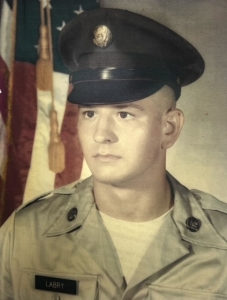 Ralph Labry
Ralph LabrySpecialist 4th Class
United States Army
I was born June 20, 1951, in Alvin, Texas. I graduated from Alvin High School in May 1969 and I attended 1 year of college at Alvin Community College (ACC). After a less than stellar year at ACC, and when my draft status became an almost certain event, I decided to enlist in the US Army. So, on August 21, 1970, I left the comfortable confines of Alvin and started my Army Basic Training at Fort Leonard Wood, Missouri.
Following Basic Training, I was assigned to Fort Davens, Massachusetts where I was taught how to intercept and copy Morse code radio signals. Follow this training, I was sent to Viet Nam and was assigned to the 146th Aviation Company. I served with the 146th Aviation from June 22, 1971 through April 23, 1972.
As a member of the 146th Aviation, I helped identify enemy troop locations when opposition forces would send Morse code signals from their field location to their command position. Giving our soldiers the location of our enemy was big help to the troops on the ground.
Then in April 1972, the US Army began its Command Strength Drawdown. I was given an early ticket home and was assigned to Fort Hood, Texas. The officers in charge, however, let too many soldiers leave Viet Nam early and in August 1972 I was sent back to Viet Nam to help with base shutdowns. From August through October 1972, I was assigned to the 8th Radio Research in Phu Bai, which was located just south of the Demilitarized Zone.
I was discharged from the Army on August 20, 1973. I married a wonderful woman, Patricia, in 1974. We have been married for 49 years. I have two daughters and three grandchildren
Lacy, Billy
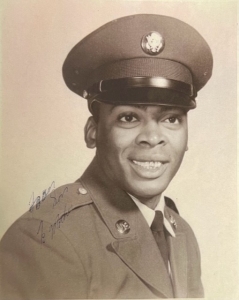 Billy George Lacy
Billy George Lacy
US Army; Combat Medic
Vietnam War
On October 12, 1964, I was drafted into the US Army. My first duty assignment was basic training at Ft. Polk, LA. After completing basic training, I got orders to go to Hawaii (Schofield Barracks) to begin training to become a Medical Corpsman (MOS 910).
I completed training on March 12, 1965. When I wasn’t working in the dispensary, I played football and basket-ball. The latter part of 1965 we were told the entire Division would be going to Vietnam. We had to dye all of our under-wear green. During the month of December 1965, several medics were assigned to Infantry Units. I went to the 25th Infantry (Cacti).
I departed for Vietnam on January 1, 1966, and was stationed in Pleiku, Vietnam located in the central highlands. I was the Medic in this company until late July 1966 when my father died and two Red Cross nurses came out in the jungle to tell me the bad news and that I could leave Vietnam to attend his funeral.
After the funeral, I was given orders to report to Ft. Sam Houston where I stayed until August 12, 1966 and this is the date I was honorably discharged.
Latson, Thomas
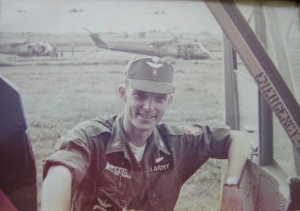 Thomas J. Latson
Thomas J. Latson
Captain, U S Army
Vietnam War
I was born in Memphis, TN, in February, 1943, in the beginning of WW-II while my dad was training with his Engineer Regiment and preparing to shipout to the Pacific. Dad returned home from Japan in 1946 and my brother and I grew up in Dallas, Texas, attending Sunset High School and North Texas State University.
Starting my Army career in 1963 I served two ½ years as an enlisted soldier and was assigned to White Sands Missile Range, NM, with duty as a technician at a remote mountaintop monitoring station at Sunspot, NM. My application for flight school was accepted and my Primary Helicopter training began at Fort Wolters, TX, followed by Advanced Helicopter training at Fort Rucker, AL, where I graduated as a Warrant Officer. The 121st Aviation Company at Soc Trang, IV Corps area was my home for the next 12-months flying combat assault missions in UH-1 Hueys. Then to Frankfurt, Germany, with the 3rd Armored Division where I was promoted to Chief Warrant Officer and then promoted to 2nd Lieutenant.
Leaving Germany, I went to Fort Knox, KY, for Armor Officers Basic (AOB), then Airborne School at Fort Benning, GA, and to Cobra Helicopter Transition at Hunter AAF in Savannah, GA. I was sent back to Vietnam for my second Vietnam tour just after the Tet Offensive of 1968 had begun. Assigned to the 3rd/17th Cavalry in the III Corps area at Tay Ninh and Di An, I flew the Cobra gunship where we gave excellent fire support to the 1st Infantry Division and the 25th Infantry Division. The work we did, and the sacrifices we made, saved many American lives, and improved the life of the miserable field soldiers that we supported.
After returning from Vietnam, I was assigned to Fort Hood, TX. I met Mary in 1969 at the church Memorial Day picnic and we married in the fall of that year, I was then an Army Captain, and Mary was a senior in her last semester at UT. Both of our kids were born in the Army Hospital at Fort Hood. Although I was a career officer, I was involuntarily released during the RIF program in 1973. I finished my bachelor’s degree program in 1974 and later earned my MBA at TAMU-Corpus Christi in 1995.
I had a 24-year career as a corporate pilot flying helicopters, turboprops, and business jet airplanes. I am an Airline Transport Pilot in both multi-engine airplanes and helicopters with five different ATP type ratings and I hold a Flight Instructor certificate with ratings in both airplanes and helicopters. In 1997 I was hired as an FAA Inspector where I served for 10-years, and then was hired by the NTSB as an Aviation Accident Investigator, retiring 10-years later in 2017. It was the best job I ever had.
We have two grown children and three grandchildren, and we have been residents in the Clear Lake area since 1997.
It was my privilege to serve for ten ½ years on active duty in the Army which included my 24-months in Vietnam where I flew 2,104 combat flying hours. I did not do anything particularly heroic, and amazingly I was never wounded, but I “volunteered” to serve. I am proud that I wore the uniform – and I would do it again.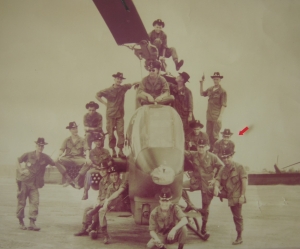
Laubach, James
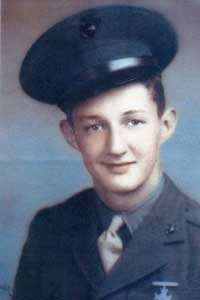 U. S. Marine Corps
U. S. Marine CorpsJanuary 28, 1944 – May 6, 1946
James served with the 1st Marine Division (12 September 1944 thru 21 April 1946).
He participated in action as a light machine gun crewman at Okinawa during the 1st assault wave April 1, 1944 through to the island being secured June 21, 1944.
At this point we were resupplied and training for an assault on mainland Japan at Kyushu when the atom was dropped and the war ended.
James and his division were then moved to the Tientsin-Pieping-Chinwangtao area in far North China in support of the ChIang Kia-shek Government.
He returned to the United States April 1, 1946 and was honorably discharged May 6, 1946.
Lauter, Albert
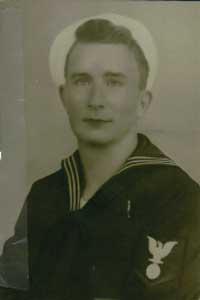 Petty Officer Second Class, U.S. Navy, World War II 1944-1946
Petty Officer Second Class, U.S. Navy, World War II 1944-1946
Lauter was born April 28, 1918 in Houston, Texas. He lived in Houston, retired and moved to Wharton, Texas. He was an electrician for 43 years.
Lauter was working at Dickerson Gun Barrel for the war effort when he received his draft papers. He turned down three deferrals and joined the Navy and went to boot camp in San Diego, California. Lauter made 3rd Class Petty Officer from Boot Camp – landing craft school.
Lauter was aboard an Army ship to Marshall and Caroline Islands then to Okinawa unloading a landing craft when a Japanese suicide plane dove on his location. Thank Heavens a 5 inch and 2-3 inch shell blast blew the plane apart.
Lauter was discharged in 1946 and returned home to Houston, his wife and two daughters. Lauter is 97-years old as of April 28, 2015.
Lee, Elmer
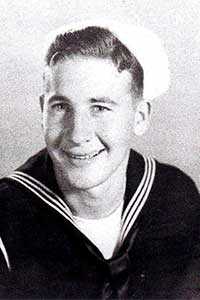 Elmer L. Lee
Elmer L. LeeSeaman First Class
U. S. Navy
Served in WW II 1944-1946
Elmer was born May 1926 in Hahn, Wharton County, Texas
He was drafted October 1944 and volunteered for the U.S. Navy
His initial training was at San Diego, California and then Coronado Island for Amphibious/ Small Boat Training.
After training, he traveled to Hawaii where he was assigned to the U.S.S. Montour. The ship traveled in the Pacific to Saipan, Tinian, MogMog, the Phillipines, Japan, Okinawa. Upon returning to the
U.S., the ship traveled to Portland, Oregon, San Francisco, through the Panama Canal, and finally to Newport News, Virginia where the ship was decommissioned. Elmer thell”eturned to Texas wheref.e was discharged in 1946.
Elmer then married Merle Ware (deceased 2012), in 1947 in Alvin, Texas where he has lived ever since. He and Merle had one daughter, three grandsons, and five grandchildren. He has farmed since 1958 and continues to do so at the age 91.
Lindgren, Harold
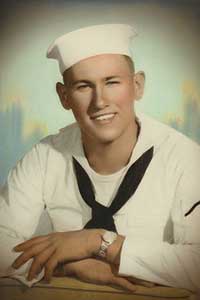 Harold Carl Lindgren
Harold Carl Lindgren
US Navy; Senior Chief
Senior Chief (ISCS) Lindgren served his country in the U.S. Navy from 1953 to 1976. Harold was born July 1935 and was raised on a farm near Media, Illinois until the age of 18.
He joined the Naval Reserve and became an ”eight-year obligator” while still in High School attending weekly drills and 2-week training each year until July 1957 when he volunteered for active duty and was stationed at Navy Reserve Air Station, Glenview, Illinois. At the end of his eight-year obligation he shipped over to the regular Navy and stayed in until retirement on 31 July 1976. He served in the following locations:
- San Diego, CA
- Pearl Harbor, Ha
- Washington D.C.
- Yokosuka, Japan
- Vietnam
- Houston, TX
Harold has been married to his wife Barbara for over 65 years and has 1 son, 5 grand-children and 14 great-grand-children. He has a great-grandson currently serving in the U.S. Marine Corps.
Looney, Temple
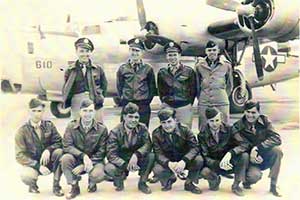 Temple O. Looney
Temple O. Looney
Temple Looney served in the U.S. Army Air Corp from 1942 until honorably discharged February 1946. When the U.S. declared war after the attack on Pearl Harbor, Temple was a student at Rice Institute ( later called Rice University ) in Houston, Texas, his home town, where he was born and raised, having been born there in 1922.
However, due to his father’s job transfers he also lived in Beaumont, Texas twice, Lufkin, Texas, and Galveston, Texas, having attended 12 different schools before Rice Institute. Like many of his classmates, he signed for flight training in the Air Corps June 1942.
He finished training as a Bombardier in 1943 he was crewed up with 9 others, a pilot, a co-pilot and six gunners, the crew of a 8-24 Heavy Bomber. The crew got more training and then took-off for Italy, the 450th Group of 15th Airforce.
He flew 13 missions, but on the 13mission, bombing the Ploesti oil fields and refinery, flack knocked out an engine, it was on fire. He has to bail out with all the crew. He and the crew were gathered by the Chetnics of Serbia and were sheltered 3 months until we could escape.
After discharge he returned to Rice University and finished his studies in engineering. He was hired by Gulf Oil Company where he worked 35 years including assignments in Taiwan and Japan and now he enjoys retirement. Temple had 3 children and 5 grandkids.
Lopes, Robert
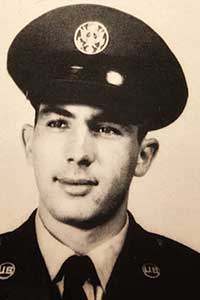 Robert J. Lopes
Robert J. LopesUSAR/USAF
Born and raised in Massachusetts, Lopes enlisted USAR September 28, 1954 – Discharged November 29, 1955 (PVT) (HON) – PVT United States Army Reserve
Enlisted USAF November 30, 1955 (HON) – Discharged September 30, 1980.
26 years, 3 days at McGuire AFB, N.J. Lopes was a Senior Master Sgt (E-8) at time of discharge.
Basic training completed February, 1956 Sampson AFB Geneva, NY. Jet school completed summer, 1956. Was assigned to the 78th Fighter Bomber Squadron RAF Station, Shephard Grove, England.
Duties in England, Norway, France, Germany, Spain, Turkey, Iran, Libya, Casablanca, USA, Korea, and Vietnam.
Aircraft assigned to: F84F, F101 AEC, T33, F4C,D,E, EB57, F-111, B52 and C141
Robert married in England in June, 1959 to Maureen J. Hacon. After discharge, they moved to Houston, Texas (Katy) and will be celebrating their 60th wedding anniversary June 27, 2019. They had 5 children and 2 grandchildren.
Mahoney, Timothy
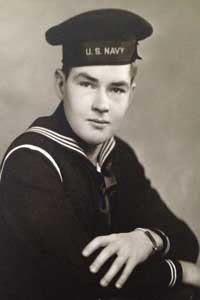 Electrician Mate Third Class, USNR V6 was assigned to CBMU 624
Electrician Mate Third Class, USNR V6 was assigned to CBMU 624
The Unit was to follow the Marines, secure Kadena Air Strip on Okinawa and make ready that strip to fly Marine Air Group F4U Corsairs in support of the invasion on D-Day plus 10.
The unit completed its assignment on D-Day + 5 for which it was awarded the Presidential Unit Citation. The Unit was presented its colors at Port Hueneme, CA on 30 December 1944 and had a compliment of 200 men who had served in the Aleutians, Solomon or Marshall Islands.
Mahoney was one of the 2200 Seaman 2nd Class just out of Boot Camp. They were trained at Port Hueneme, sailed on S.S. Thurston from Frisco to Pearl Harbor for training or loading equipment to the SS Meriwether.
He sailed from Pearl on the Meriwether 21 February to Okinawa for their April 1, 1945 8 am date on the beach with a stop at Eniwetok in the Marshalls on day 38 for 2 beers and one coke, Ulithi in the Carolines, Peleliu in the Palaus, Samar and Leyte in the Philippines. On 27 February 1945, crossed Int’l Date Line and became members of the Society of Go Dragon. In all of this Mahoney had one night liberty in Great Lakes (7 day Boot Camp leave for home), one night at Port Hueneme, One Sunday afternoon in Honolulu. In addition to the Hueneme training he had a month of LCt beach landings on the beach at Pearl, one day LCT landing at a beach on Leyte. He was the outside hatch guard on the Port side of the Meriwether from midnight until 4 am each day and went into White Beach on the first LCT.
At Kadena Mahoney did a variety of things, again guard duty until they started flying the Corsairs and repairing the cable. Another seaman and Mahoney were assigned to a first Class Electrician Mate to find the shell holes on the south side of Kadena Field and repair the cable, etc. if planes were out on raids.
The units history notes cites they were subject to 142 air raids, 11 shellings by Japanese mortars and big Japanese artillery called Whistling Willy, Pistol Pete, and Singin’ Sam.
Foxholes and the Okinawa caves were welcome retreats.
We were pleased to give that field to the Army Engineers and move to the other side of the island and build a new camp and make ready the Awase airstrip for MAG 33. After the war was over the unit tore many things down took lumber and such to Okinawa villages, sent to Guam in June and came home with 12 thousand other men on the USS Wakefield.
Mahoney and his wife, Betty, celebrated their 65th wedding anniversary on September 5, 2014 and have been blessed with five daughters, one son, seven granddaughters, a grandson, three great granddaughters and three great grandsons.
Maltz, Melvin
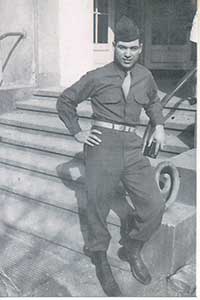 Cpl Melvin Maltz enlisted August 21, 1944 for US Air Corp for Aviation Cadet Training. In January 1945 he was offered a discharge or become an enlisted man as the Air Corp had an excess of trained pilots. WWII was still active in both the European and Pacific areas. Maltz remained in the Air Corp in enlisted status.
Cpl Melvin Maltz enlisted August 21, 1944 for US Air Corp for Aviation Cadet Training. In January 1945 he was offered a discharge or become an enlisted man as the Air Corp had an excess of trained pilots. WWII was still active in both the European and Pacific areas. Maltz remained in the Air Corp in enlisted status.
Melvin is a native Houstonian born Feb. 12, 1927 and was a Cadet at Texas A&M University when he enlisted along with his Cadet roommate. Academically he qualified as a Senior in Aeronautical Engineering before being activated a few months later. Melvin reported to Ft. Sam Houston and then sent to Keesler Field Mississippi for basic training and B-24 mechanic school. After completing the training he received a designation as a B-24 Mechanic MOS Potential.
December 31, 1945 Melvin boarded the USS George Washington with 7,000 of his best friends bound for Le Havre, France and after orientation to Furstenfeldbruk, Germany. He was sent via 40-8 box car to Weisbaden, Germany and then by bus to Schlangenbad, Germany for the Army of Occupation, Head Quarters 508 Engineering Battalion, European Aviation Engineer Command. While there he was given a choice of a Carbine rifle and chase POW’s or becoming a Clerk in Head Quarters. For the next 12 months as a Clerk he assisted in writing work orders for remodeling and construction of Air Bases and reconstruction of various buildings in Germany.
Melvin was offered a ride in a Staff car with the Battalion Colonel to a Texas A&M Muster Ceremony in Frankfurt, Germany. On April 21, 1946, date of the Muster, when Melvin began to sit next to the Staff Sergeant driver, the Col. Said “Aggies sit together in the back seat”. The Sergeant’s eyes got as big as saucers. After the Ceremony and dinner the Col. was ready to leave and Melvin stated to the Col. that a Classmate was remaining overnight in Frankfurt. The Col. said to him that he could stay without orders but to tell his 1st Sgt VOCO, and it would be OK. That night was a lot of fun and German beer.
Melvin returned to the USA on the Gen. Harry B. Taylor converted from a cargo ship to a troop ship transporting about 2,500 men; and discharged December 1946. His grandchildren have given him 7 great-grandchildren.
Manthei, David
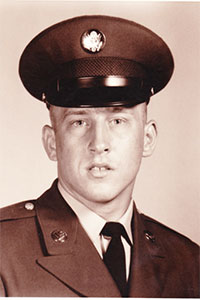 David P. Manthei
David P. Manthei
Specialist E-5, US Army, David P. Manthei began his service in June, 1966 until April, 1969.
David was born on December 29th, 1946 in Freeport, TX and was raised primarily in Lake Jackson, TX.
He volunteered for service in the U.S. Army in 1966. Did basic training at Fort Polk, LA. After basic training, he went Aberdeen Proving Grounds, Maryland for AIT. David was then assigned to Second Division, Korea where he maintained personal radar in the DMZ and also worked on the Starlight Scope, at the time, a new form of night vision optical. He was transferred from Korea at the end of 1967.
In 1968, he was assigned to Mannheim, Germany, 7th Division, Signal Corp. where he served until June of 1968. He was then transferred to Berlin and did optical repair work. He was also assigned to perform MCI and was designated Fire Control, conducting inspections on optical sights. In February, 1969, he was then transferred to San Antonio, Ft. Sam Houston for discharge.
Marino, Anthony
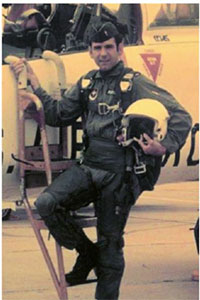 Anthony J. Marino
Anthony J. MarinoCaptain, United States Air Force
Marino served his country in Vietnam and the Cold War from 1971 to 1976.
Marino was born in September, 1947 in Brownsville, Pennsylvania.
He volunteered on January, 1971 and attended Officers Training School (OTS) at Medina on Lackland Air Force Base, in San Antonio, Texas, and Undergraduate Pilot Training (UPT) at Laughlin Air Force Base, in Del Rio, Texas.
In Del Rio, Marino received 11 months of pilot training in the T-41 Mescalero, the T-37 Tweet, and the T-38 Talon.
Marino was then assigned to fly the KC-135A Stratotanker in the 906th Air Refueling Squadron at Minot Air Force Base, in Minot, North Dakota where we fought the Cold War, as well as, a “Young Tiger” Vietnam air combat tour at Kadena Air Force Base, in Okinawa, Japan.
He flew numerous air combat missions refueling numerous combat aircraft while stationed at various locations in Southeast Asia: Anderson Air Force Base, in Guam, Kadena Air Force Base, in Okinawa, Japan, Clark Air Base, in Manila, Phillipines, and U-Tapao Air Base, in U-Tapao, Thailand.
While at Minot AFB, Marion sat 24 hour alert for 7 days straight with his four man crew sleeping in an alert facility next to his tanker. In case of a nuclear attack, his crew was responsible to refuel B-52 Stratofortress aircraft in a counterattack and hopefully land in the Aleutian Islands to fight another day.
Marino was sent in June, 1973 to Torrejon Air Base in Madrid, Spain to provide air refueling missions to British J-3 Lightnings, F-4 Phantoms, and F-100 Super Sabres over most of Europe and Mediterranean Sea. While in Spain another trip to Mildenhall Air Base, in Mildenhall, England found him refueling RC-135 “Chubby Cheeks” over the Baltic Sea.
Marino was also sent in December, 1973 to Eielson Air Force Base in Fairbanks, Alaska to provide air refueling missions to RC-135 aircraft. These air missions entailed a lot of cold weather, night time flying over the Arctic Ocean.
Marino is the recipient of the Vietnam Service Medal, the National Defense Service Medal, the Small Arms Expert Marksmanship Ribbon, the Presidential Unit Citation with on Oak Leaf cluster, the Navy Presidential Unit Citation, and the Air Force Longevity Service Award.
While at Okinawa, Marino met his bride, Donna, also in the Air Force. The married in Minot, ND in December, 1973 until Donna’s passing in 2012. They have two children and five grandchildren.
Marino was discharged from the Air Force in August, 1976. He moved home to Pennsylvania for a short time before moving to Friendswood, Texas in January, 1977 to work in the space program at NASA, Johnson Space Center for 38 years.
He is now retired and traveling the world again with his loving wife, Debbie.
Martin, Donald
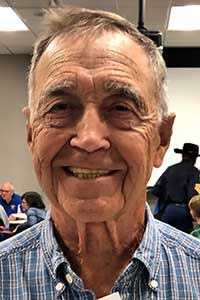 Donald Lee Martin
Donald Lee MartinUSAF A1/C
Martin served in the U.S. Air Force from July, 1954 through December, 1957.
Martin was born April 5, 1937 in Coles Co., Illinois. He attended boot camp at Lackland AFB during July, August, and September. Assigned to Parks AFB, California for processing to Korea, stayed there on hold for two months as action in Korea was winding down. Served as an accounting specialist at Scott AFB, Illinois for a few months. Also served two bases at Sheepshead Bay, Goosebay, Labrador, two bases in Newfoundland, one year at Sondrestrom AFB, Greenland and finally, Forbes AFB, Kansas for discharge.
Don Martin married his lovely neighbor girl, Linda. They have three children and seven grandchildren,
Martin received a Bachelor’s Degree from Eastern Illinois University and CPA Certificate from University of Illinois.
He retired in 1998 from public accounting practice and moved to League City, Texas to be near his 2 sons and seven grandchildren.
Martin, Glenn
 Major United States Air Force.
Major United States Air Force.
Volunteered to serve his country during World War II from 1942 – 1945 as a B-24 Pilot.
He was born in Beeville, Texas December 10, 1920, but has lived most of his life in Houston, Texas.
After 8 months of training in Texas and Arizona, he was assigned a B-24 bomber with a crew of 10 to proceed to England via Bangor, Maine. He flew solo across the Atlantic. Upon arriving, he was assigned to the 93rd Bomb Group (known as Ted’s Traveling Circus), 20th Combat Bomb Wing of the 8th Air Force in Hardwick, England.
Martin began combat missions on August 21, 1943 – May, 15, 1944. After completing 32 missions over Germany, France, Norway, Italy, Austria and Holland (all occupied by Germany), he was relieved of combat duties and was assigned to the 20th combat wing as operations and training officer. He continued serving in this capacity through June 6, 1944, D-Day, and until returning home in August 1945 on the Queen Mary. On this voyage, they received word on August 6th that an atomic bomb had been dropped on Japan.
After arriving home, he married the love of his life, Libbie Horlock on December 19, 1945. After being released from active duty, he remained in the Air Force reserve.
He enrolled in, what was then, South West Texas State Teachers College in San Marcos, Texas. After completing 3 years he was recalled to active duty during the Korean War, and assigned to Randolph Air Force Base in San Antonio, Texas as Squadron Commander and B-29 Pilot. He was discharged on December 10, 1952.
Martin will celebrate his 94th birthday on December 10, 2014.
He and wife, Libbie, had four daughters, six grandchildren, seven great-grandchildren, and one great-great-grandchild.
Awards and Decorations Include:
• Distinguished Flying Cross (2)
• Air Medal (3)
• Campaign Medal
• American Medal
• WWII Victory Medal
• French Croix de Guerre
• Korean Campaign
Martin, Homer
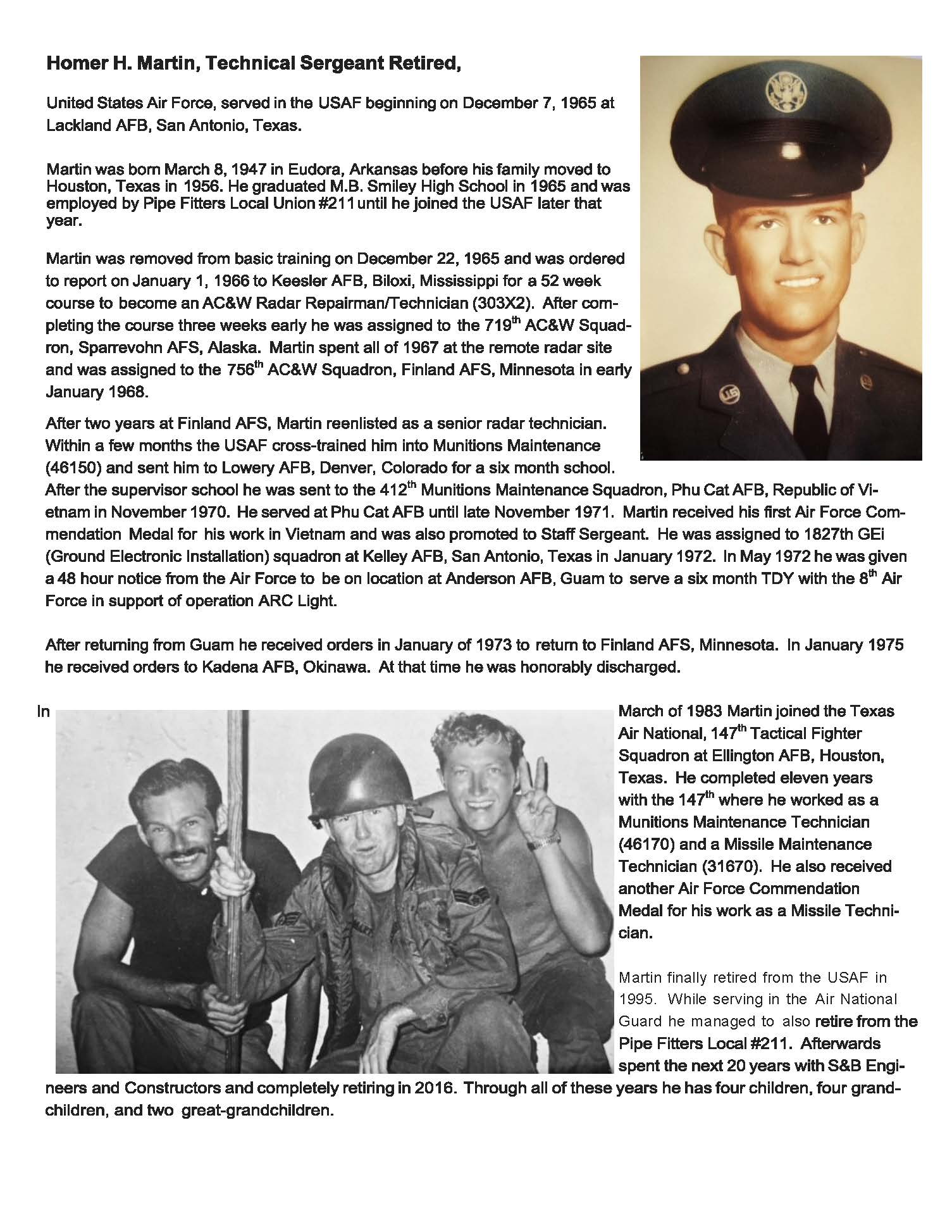
Martinec, John
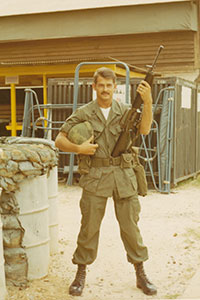
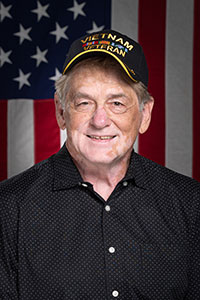 John L. Martinec
John L. MartinecSpecialist Fifth Class (Spc-5), United States Army. Martinec proudly served his country stateside at Fort McPherson, GA, Feb-Dec, 1969 and in the Vietnam War, Jan-Oct, 1970.
Martinec was born just after World War II in Temple, Texas on August 30, 1946.
John is proud to have served after being drafted on November 5, 1968 and attended Army Basic Training at Fort Bliss, Texas, Nov 1968 to Jan 1969.
Prior to military active duty service (November 1968 to October 1970) and after graduation from the University of Texas Austin (May 1968) with a Bachelor’s Degree in Business Statistics, Martinec gained computer systems engineering training and experience in service to our Nation with the International Business Machines (IBM) Federal Systems Integration branch and contract with the U.S. National Space and Aeronautics Administration (NASA).
The civilian computer development relationship with IBM and NASA led to Martinec’s pride in having served his country in both the Vietnam War (at Long Binh, 1970) as an Army logistics system computer programmer and in his role in mankind’s most important technical achievement of the century by Landing Man on the Moon (1969), both in the same twelve month period.
Martinec’s first active duty assignment was at Fort McPherson (February to December 1969) as a computer programmer on RCA’s personnel processing computer for Third Army Headquarters. This assignment provided another military career moment by serving in the same Third Army that was commanded in France and Germany following D-Day by hero “Old Blood and Guts” Lieutenant General George Smith Patton Jr.
On New Year’s Day 1970, Martinec boarded a chartered airliner in Oakland, CA, along with 200 of his friends headed to one year assignment in Vietnam. Not possessing specific orders for his tour in the Vietnam War, he was pleasantly surprised to be assigned as a computer programmer with the First Logistical Command at Long Binh. He was proud to be placed in a support role that firmly fit his computer training at UT, IBM and NASA – programming the most productive computer of its day, the IBM 360/50, in the very important Army automated task of substantially enhancing timely and correct delivery of crucial Army equipment and replacement parts. Computerized implementation of such vitally efficient logistics programs as the U.S. Army’s “Red Ball Express” was crucial to the operational success and security of our brave troops in Vietnam’s jungle and harsh battlegrounds.
Following Martnec’s service discharge in October, 1970, his military service was transferred for a six year reserve assignment with the USAR Control Group / US Army Admin Center, St Louis, MO. Martinec also returned at this time to his IBM national service career with NASA’s Manned Space Exploration line of major programs including Apollo, Apollo-Soyuz, Skylab, Space Shuttle and International Space Station.
Martinec continues his productive military service via volunteer community leadership:
● Chair for the Houston community’s Ellington Field Task Force that manages and performs the military/community’s Master Plan for Houston’s Ellington Field Joint Reserve Base;
● Chair of the BAHEP Cares! Executive Mentoring for Veterans; and
● Executive Member of the Houston Military Affairs Committee.
U.S. Military Decorations include:
● National Defense Services Medal
● Vietnam Service Medal
● Vietnam Campaign Medal
● Army Commendation Medal
● Good Conduct Medal
U.S. Military Decoration to civilian:
● Department of the Army
● Commander’s Award for Public Service.
Martinec was married to his high school sweetheart Carolyn Necas on June 15, 1968, moving to Houston, TX, from their prior homes near Rogers, Texas to Houston, Texas. They were married for 45 years before Carolyn’s passing. They have 2 son and daughter, who also each have a daughter and son. Martinec married on June 15, 2017 to Brenda Stansell Konikowski and live happily in Houston.
Matheson, Lyman
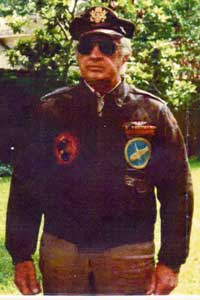 1st Lieutenant, Bombardier-B24 bombers, Army Air Corps, 13th Air Force, 307th Bomb Group, 370 Squadron
1st Lieutenant, Bombardier-B24 bombers, Army Air Corps, 13th Air Force, 307th Bomb Group, 370 Squadron
Matheson flew in 35 missions in the South Pacific, including two beachhead invasion coverages. He spent two and a half years in the service from February 1943 to September 1945. Of these years, eight and half months were spent overseas.
His ‘green’ crew of ten, flew a B-24 bomber from California to New Guinea by way of Hawaii and island hopping to Guadalcanal and into New Guinea. They flew their first two missions from a jungle air base before moving to Morotai in the Netherlands East Indies for the rest of their missions.
Matheson has three Air Medals (two of which are Oak Leaf clusters), Eight Asiatic Pacific Battle Stars (one silver (five stars), three Bronze stars), Philippine Liberation, American Campaign Medal, World War II Victory Medal, and one Philippine Republic-Presidential Unit Citation.
Matheson is 96 ½ years old, he was married to his wife, Phyllis, for 68 years before her passing in 2013. They have two children, Son John and Daughter Alexis.
Mazoch, Charles
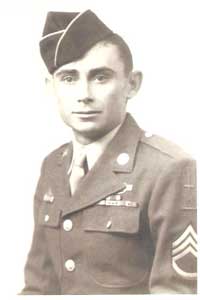 S/Sgt US Army
S/Sgt US Army
32nd Infantry Division, Red Arrow
Drafted August 1942
Hometown: Ammansville, Texas
Charlie enlisted at the county seat – La Grange, TX – Fayette County.
He served from February 1943 thru November 1945 in the South-West Pacific Theater.
He shipped out from San Francisco in 1943 to Australia for jungle warfare training.
He was then shipped to New Guinea for advanced combat training. After New Guinea he proceeded on to Leyte, Philippines (3 months) and then to Luzon, Philippines for the remainder of the war.
After the war ended, Charlie was shipped back to San Diego. He was then sent to Fort Sam, San Antonio for discharge on November 7, 1945.
Greyhound bus line was on strike, so soldiers had to find creative ways home. Charlie caught a ride with guys headed to Houston. He paid them for the entire trip, but he got off at the intersection of Hwy 77 and Hwy 90 in Schulenburg, TX. As luck would have it, his Father was at the corner filling station getting a tractor tire repaired. They headed home to the farm in Ammansville.
Charlie Mazoch married Rita Tumis in 1949, and they have raised their family and lived in Weimar, Texas ever since.
McCain, John
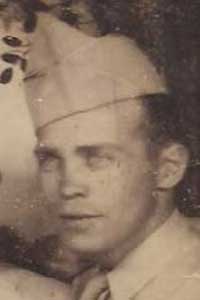 John N McCain
John N McCain
Master Sergeant, US Army
16th Armored Division
A friend, who had been in the trenches in WWI, told me that war was coming. He said, ”Son, you do not want to be in the trenches!” He advised me that since I seemed to have ability with machinery that I should join the Texas National Guard in the machinery and equipment repair company and do something useful in the service.
I joined the Texas National Guard, 36th Tank Company in 1940. On January 1, 1941 the Guard was told to report the next day to be sworn into the US Army. We all had to take a physical and all that passed were allowed to go home and get their business straightened out and report back in one week with all their gear. On January 10th we loaded on trucks and headed to Ft. Benning, GA where we joined the newly formed 2nd Armored Division. Everyone in the Maintenance Section went to school, either in Tank maintenance or Truck mechanics at Ft. Knox. I was in tank maintenance. When we returned from school we were sent on maneuvers to Tennessee and the Carolinas.
When the Japanese bombed Pear Harbor, we were told to standby. The next day we started loading tanks on flatcars for the trip. We left on the 14th for San Francisco. And on the 26th of December we sailed for Hawaii. When we arrived we scattered tanks all over the island. We ended up training a lot of Marines to drive tanks and made a lot of beach landings on the leeward side of the island. After the Battle of Midway, they decided to send us back to the US to form a new tank division. After training in Camp Chaffee, Arkansas, we were ready for Europe. We left from Staten Island, NY. All the Maintenance guys went in Advanced Cadre. The port of Le Havre was already secured when we arrived. We unloaded tanks and trucks, fueled them up and drove them into the woods for camouflage and set up our shop and welding truck. In about 2 weeks all of our troops arrived and checked out their vehicles. We were ready to take out after Patton’s 3rd Army! We repaired tanks, trucks, and anything else we could across France and Germany. We ended up in Plzen, Czechoslovakia where we met the Russians.
After the war, my job was to round up all the German equipment in a 50 mile radius. We stacked German vehicles on an old airstrip as far as you could see. I had collected enough points to go home. I was shipped back to the States and discharged at Jefferson Barracks in Missouri. I caught the train and arrived home to Wharton, TX on Sunday morning, so I picked up my gear and walked to Church because I knew that’s where my Mother would be.
McCarty, John
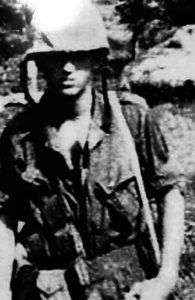
John P. McCarty
Lance Corporal, USMC
1964-1967
McPhail, Joe
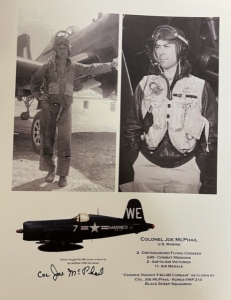 Colonel Joe McPhail
Colonel Joe McPhail
USMC-R; Aviator
WWII & Korea
Joe was born on October 10, 1921, in Grand Saline, Texas and earned his private pilot license in the summer of 1941. He joined the Marines on October 18, 1941, and went on active duty three days before the attack on Pearl Harbor. He received fighter pilot training, earning his wings on October 2, 1942. He was assigned to Marine Fighter Squadron VMF 441 flying the F4F-4 Wildcat on patrol in the Central Pacific theater. After returning to the States, he instructed fighter training the F4U Corsair at El Toro, CA in 1944.
Colonel McPhail was assigned to the most successful Marine Fighting squadron of 1945, VMF – 323, the “Death Rattlers.” In just a few weeks, they shot down 124.5 Japanese planes and counted a dozen aces. On April 12, 1945, while on patrol flying a Corsair, Joe McPhail shot down a Japanese Zero. On May 4, 1945, he shot down a Nate.
At the outbreak of the Korean Conflict, VMFA-214 “Blacksheep” Squadron was given short notice to, “get ready.” By August of 1950, the Blacksheep were aboard the USS Sicily Strait, enroute to Korean waters and into the fight. Joe joined 214 in November 1950 and went aboard the carrier Sicily in January 1951. Another chapter in the illustrious history of the Blacksheep squadron was being written as the, “Fighting 214th” which was the first Marine squadron to see action in Korea. Colonel McPhail is credited with 240 combat missions and 2 air-to-air victories.
Mellon, Randon
USAF
I joined the USAF in August 1967. Had basic training at Lackland AFB in San Antonio Texas and got stationed to Wright Patterson AFB in Dayton Ohio. I was in the Security Police Squadron.
In September,1969, I went back to Lackland AFB for Dog Handlers School. It was October, 1969 when I got my orders for Utapao, Thailand and took my ATC training at Lackland and subsequently shipped back to Ohio until my deployment in March,1970. In June of 1970 I was promoted to Dog Handler Supervisor and remained same until returning to State side.
While in Thailand with the 635th K-9 Squadron, we went from security dog handlers to patrol dog handlers and I had to certify all handlers and their dogs, and also train 17 Thailand handlers.
I returned to Abilene Texas, Dyes AFB until my discharge in July 1971.
Special Note: Honor Flight Houston is proud to have Randy on the board and fulfilling the position of Treasurer. Randy is dedicated to veterans and is making a difference with HFH and in the world.
Mendoza Jr., Aaron
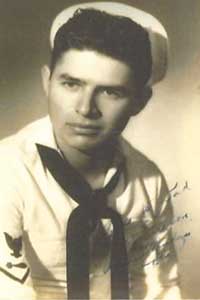 Aaron Mendoza, Jr.
Aaron Mendoza, Jr.US Navy
Aaron served in the U.S. Navy during WWII and in the U.S. Air Force during the Korean War.
Aaron was born in 1924 in Houston, Texas. He moved to South Texas and graduated as Valedictorian from Premont High School. After graduation, he moved to San Antonio, Texas as a scholarship recipient to attend Draughan’s Business College. While working at Kelly AFB, he was drafted into the U.S. Navy in September, 1943. He attended service school at the Naval Repair Base in San Diego, California working on Mark 13 Torpedoes. He was then assigned to Pearl Harbor and Kaneohe Bay for 15 months where he attained the rank of TM2/C while overhauling, maintaining, arming and testing torpedo warheads to be loaded on aircraft. Aaron’s next assignment was to the Great Lakes Naval Air Station. While there, the war ended and he was transferred to Memphis Naval Air Station and honorably discharged.
Returning home, he married his sweetheart, Viola. He then worked at Kelly AFB and joined the Air Force Reserves. When the Korean War broke out, his unit was called to active duty. He served from June 1950 through June 1953, as a Technical Sergeant.
He attended night school under the GI Bill of Rights and received a Business Administration degree from St. Mary’s University. After attaining the rank of GS12 at Kelly Air Force Base, Aaron had a very successful career in sales for Control Data Corp lasting over 25 years, selling large mainframe computers. There he became a lifetime member of the Shark Club, the highest honor given to a salesman in the company.
He and Viola celebrated 62 years of marriage. Aaron has 3 children, 9 grandchildren and 10 great grandchildren of whom he is very proud.
He currently enjoys living in Parkway Place, an independent living community, in Houston. His favorite activities include playing bridge, dominoes, and directing the Men’s Activity Club. The time he holds most precious is that spent with family.
Mercer, Sherman
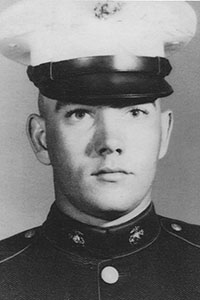 Roy Sherman Mercer
Roy Sherman MercerAfter three semesters of college I was unsettled, unhappy, and needed a different direction. I was raised in a town where veterans were respected and most all the people respected America. This was in 1967 and protesters were very few and far between in my hometown. Many of my friends had been or were currently in the military and that seemed the best direction for me at the time. A decision I have never regretted.
I joined the United States Marine Corps in late December of 1967, and delayed entry till after the holidays for that year. I reported for active duty January 10th of 1968. I was sent from Missouri to San Diego California for Boot Camp. I did well at Boot Camp and earned my PFC stripe.
Then came Infantry Training Regiment, this is where we were taught skills to keep us alive during war in South Viet Nam. Every Marine is an Infantryman first, other assignments come second to that. My military occupation was assigned after infantry training and I was to become a Communication Wireman. At this school I was awarded my next rank (Lance Corporal) and my occupation was Wire Chief.
Then came a 30-day leave, followed by orders to report to 11th Marine Headquarter Battery near Da Nang, South Viet Nam. I stayed at Headquarter Battery for 30 days and repaired wire going to OP Eagle as well as ran a switchboard for routing calls within the battery.
After my first thirty days, there was an opportunity to go to OP Eagle and I jumped at that; it was an opportunity to get into the field. OP Eagle was a hilltop observation post that overlooked Au Shau Valley and Happy Valley, where Marines and Soldiers were working combat operations. Our job was to watch the valleys, and when we saw rocket fire call in artillery support for the troops.
I did my thirty days on the OP and was given the opportunity to move to Alpha Battery and become a radio operator (MOS 2531, Field Radio Operator). I was assigned to work with Forward Observers. These men were officers that had completed artillery school and were well trained map readers. We worked as two- or three-man teams assigned to the infantry. Our job was to call in field artillery support to proceed our movement, and to call fire missions in combat situations. This was my last duty in country.
I rotated out with the usual week on Okinawa, then to El Toro California before my travels back to Monett, Missouri. There were the expectations I had for my return, and there was the reality when I got there.
I had unreal and unfair expectations of people, places, and opportunities I wanted upon my return. My hometown and the people in it had not changed, but I had. I tried school and many jobs prior to finding a career in sales. From my return in 1969 to my last day of work in 2011 I was a salesman.
From 1969 till 1995 I stayed away from the VA and veteran organizations. I had lived in Texas many times and in the year 2000 my wife and I moved to Texas. Here we made many friends, and most were veterans, so the Veterans organizations became a big part of our social life.
In 2011 I had a turn for the worse with my heart disease. Thank God for those veterans’ organizations, they helped me navigate the VA health system and increase my care and disability rating.
Today, when healthy enough, I volunteer at our Brazoria County Veterans Court. In addition, I facilitate PTSD support groups for veterans and their families. I have been given the opportunity to take the mistakes I made and the knowledge I gained to help other veterans have an easier transition to civilian life. This is the most rewarding duty I have ever had.
When my mission here on earth is done my hope and prayer is that I will be allowed to continue to help veterans and their families, maybe even as a Guardian Angel in a combat situation. Though I will report to the pearly gates and say what I say every morning…. Reporting for duty Sir, please tell me your will for me. I have shortcomings and faults so give me the help I need to complete your mission. Thank you Sir.
Miller, Donald
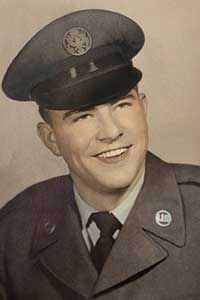 Donald E. Miller
Donald E. MillerAirman 2nd Class – United States Air Force
Miller served his country from 1955 to 1957 – USMC Ready Reserves
1957 to 1961 – USAF – completed A/C & Refrigeration School. Miller was assigned to work on Base air conditioning and aircraft air conditioning.
Donald Miller was born December 27, 1936 and grew up a farm boy in Iowa.
He was stationed in USAF at Shaw AFB, S.C. – Alconbury, England – Wheelus AFB, Libya, North Africa – Radar Installation Base at Eagle Pass, Texas.
After discharge from Air Force, he married his sweetheart, Kathy Berttucci, in 1961. He was engaged during his time in the service. They married in 1961 and have one daughter, Kimberlee, and two grandsons, Nicholas and Alex. He will be married 58 years in October, 2019.
He continued his career as a commercial A/C tech in Houston. He is now retired and enjoying life.
Milligan, Henry
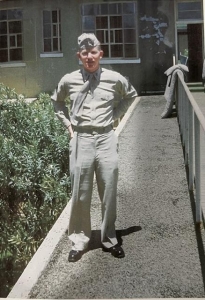 Henry Milligan
Henry MilliganUSMC; SGT
Korean War
I joined the Marines in Dallas, Texas on April 20, 1951 when I was seventeen years of age. It was during the Korean war, and I joined for three years.
I went through boot camp at San Diego, California. After boot camp I was assigned to El Toro Marine Base in Santa Ana, California. Next, I was assigned for training with the newly formed 1st Provisional Air Ground Task Force at Kaneohe Marine Corps Base on the Hawaiian Island of Oahu. During my tour of duty at Kaneohe Bay I attained the rank of Sergeant at age 18.
In June of 1953 I was transferred back to El Toro Marine base and assigned to the Shore Patrol duty in Santa Anna at the Shore Patrol Office. From the Santa Anna office we had responsibility for duty in Santa Anna, Laguna Beach and Balboa Beach.
I served on Shore Patrol until my enlistment was completed. On April 20, 1954, at the age of twenty I received an Honorable Discharge.
Minette, Maurice
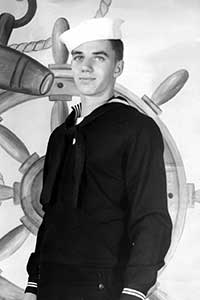 Maurice M. Minette, Sr.
Maurice M. Minette, Sr.
Seaman First class (S 1/c), United States Navy during World War II from 1945 – 1946
US Army Reserves – Machine records unit during Korean Conflict 1950 – 1952
Maurice was born in Long Prairie, MN and grew to adulthood there. During his senior year of high school he tested for the Navy’s Radar/Sonar technicians’ program and qualified for the training school.
He was following in the footsteps of his father and older brother who were both in the Navy: his dad was in World War I, and his older brother had just received his Disability Discharge from WWII.
In February 1945, Maurice took his physical and was going to board the bus for regular Navy boot camp when he was asked if he would like to go back home to finish his senior year of high school before reporting for the Naval Reserves and he, of course, said yes, graduating in May of 1945. He received a letter stating that the Navy would contact him to let him know when to report, and in the meantime took a summer job.
In August 1945, Maurice finally got the call and reported for boot camp. During boot camp, a change was offered to those who wanted to go to the Radar/Sonar tech school, so Maurice was discharged from the Reserves and re-enlisted in the regular Navy, signing up for the Minority Cruise. He then did his Pre-Radio training at Hugh Manly High School in Chicago, Primary Radio training in Gulfport, MS, and finally returned to the Navy Pier in Chicago for Radar training.
In June 1946, President Truman ordered that all Reservists were to be discharged by August, so the school was shut down and Maurie was then discharged in August 1946.
During the Korean Conflict, Maurice joined the Army Reserves. During the first summer he trained at Ft. Eustace, VA and during another summer at the Navy Pier in Chicago.
Maurice used his GI Bill to attend Dunwoody Industrial Institute in Minneapolis, MN where he took electronics courses and received his certifications. He went directly to work for IBM after graduation in 1949, working there for 41 years, and retiring in 1990.
Maurie and wife Joan married in July 1954 and celebrated 62 anniversaries. They have three children, 4 grandchildren and 3 great grandchildren. They lived in New York State, Youngstown and Cleveland, OH, Marquette, MI, Dallas, Beaumont and finally Houston, TX where Maurie & Joan lived since 1978.
Moreno, Vincent
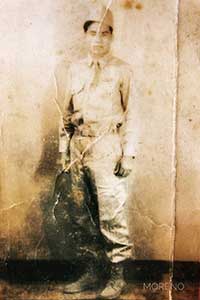 Vincent S. Moreno, Sr.
Vincent S. Moreno, Sr.PFC United States Army
Vincent Moreno served his country in World War II from 1943 – 1945.
Vincent was born in January, 1924 in Houston, Texas.
He was drafted March 4, 1943.
Moreno was shipped overseas November 10, 1943, and landed in India, December 26, 1943.
He served with the 508th and 289th Port Battalions, based in Calcutta, India from January, 1943 to August, 1944.
In August, 1944, Moreno volunteered for a combat mission in Burma. He was assigned to the 124th cavalry (SPL), part of two combat units. The 475th was the other that made up the Mars Task Force, a command regiment based in Myitkyina. Moreno walked 279 miles across the Himalayan Mountains while he pulled a mule that carried 200 pounds of supplies. He slept on the ground every night. After it was all over, he was shipped to China.
In China, he was assigned to military police duty.
In December, 1945, Moreno was back in the United States.
Vincent Moreno was discharged December 13, 1945. He married Margarita in 1948. They have 5 children, 8 grandchildren, and 8 great-grandchildren. Vincent and Margarita have been married 71 years.
Morrison, Vincent C.
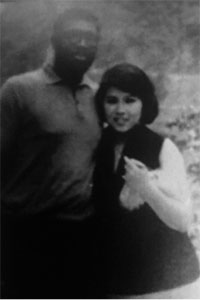 Vincent C. Morrison
Vincent C. Morrison
I was born in Brooklyn, NY. I graduated from Earl L. Vandermulen High School in Port Jefferson, New York in 1966. In October 1, 1967, I enlisted in the United States Marine Corps and graduated January 15, 1968 – Platoon 3071 from Camp Parris Island, SC.
January 1968, I arrived at Camp Lejeune, NC for Advance Infantry Training, 0311-Grunt. From there, my M.O.S. changed to 0811-Artilleryman and off I went to Fort Sill Oklahoma to Artillery School. Once I graduated from there, off to Camp Pendleton, CA for more training on Guns-105 Howitzer.
I got orders for Vietnam and spent a little time on “The Rock” Camp Hansen-Okinawa. Then things got real, saddle-up heading to Vietnam. On June 3, 1968, I arrived in Da-Nang, Republic of Vietnam. I took a C-130 up north to Dong Ha Combat Base, I-Corps-DMZ Area.
I reported in to Camp JJ Carroll 12th Marines Headquarters. They assigned me to Alpha Battery 1st Bn. 12th Marines. I worked my way up to become a Section Chief of Gun #6 and oversaw 5 men.
The name of our 105 Howitzer was “De Allah Kahuna”, translation “High Priest Witch Doctor”.
I spent a 13-month combat tour in Vietnam with Alpha Battery 1st Bn. 12th Marine Regiment, 3rd Marine Division (FMF) Fleet Marine Forces. We hopped all over Vietnam from the DMZ, A Shau Valley, Laos, Hills 881-North, 881-South and Con-Thein from June 1968 to July 1969.
I received an Honorable Discharge, with Combat Action Ribbon, Navy Commendation Medal with V Device, Vietnam Service Medal, Vietnam Campaign Medal with 60 Device, National Defense Medal and Good Conduct.
Moscariello, Emilio
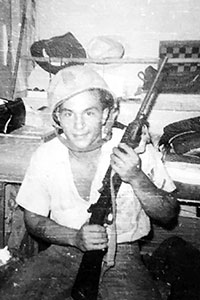
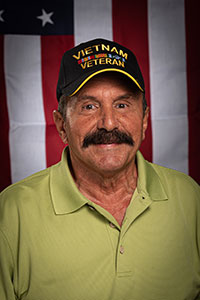 Emilio Moscariello
Emilio Moscariello
Emilio was born in Brooklyn, NY on October 24, 1947. Volunteered in the U.S Navy at the age of 17 in October 1964.
After training, he was assigned to the USS Ault DD698 where it sailed the Mediterranean, Caribbean and the East Coast of the US. After a year he was assigned to a new unit that the Navy put together 1.U.W.G 1 (Inshore, Undersea, Warfare Group One). Emilio was one of Forty Five men and after three months of combat training he was sent to VietNam in April of 1966 where he was one of a fifteen man team Unit 3. Oh! and by the way his unit nicknamed him Muskrat.
October 1968 at which time he was awarded an Honorable Discharge.
He returned home to New York and joined the New York City Police Department and after training was assigned to the South Bronx until his retirement. As a Police Officer he served in the active US Navy Reserves and then transferred into the US Army National guard.
He moved to Texas and started a Printing Company with his brother. He then went on to open a new Export Packing & Crating Company and retired after 25 years
Emil has been blessed with three children and five grandchildren.
Moseley, Scott
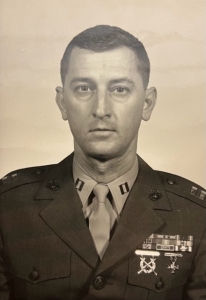 Captain M.S. “Scott” Moseley, USMC
Captain M.S. “Scott” Moseley, USMC
Captain “Scott” Moseley started his military career in Dallas, Texas where he joined the U. S. Marine Corps and was dispatched to “Officer Candidate School and The Basic School in Quantico, Virginia. Upon graduation he was sent to Camp Lejeune and duty in the Caribbean. Subsequently, he graduated from Artillery School at Ft. Sill, Oklahoma and received the designation as” Artillery Officer. After a short assignment to Camp Pendleton, helping to subdue “Brush Fires”, he reported for duty in the Republic of South Vietnam serving throughout the Tua Tien Province with the Third Marine Division. He subsequently was Dispatched to the First Field Artillery Group as Executive Officer where he saw action in the defense of “Hue City”. Upon completion of this assignment, he was transferred to 11th Marine Regiment where he assumed command of “W” Battery, 11th Marines. While with 11th Marines, he was deployed to the Republic of the Philippines to retrofit and return to Vietnam as part of a “Reaction Team” with Battalion Landing Team 2/7.
After leaving Vietnam, Lieutenant Moseley was transferred once again to 10th Marine Regiment at Camp Lejeune where he was promoted to Captain. He assumed command of “Lima” Battery, 10th Marines and once again, saw duty in the Caribbean. He was deployed as Asst. S-3 to the Mediterranean as part of the 34th Marine Amphibious Unit aboard the U.S.S. Guadalcanal. The unit participated in the evacuation of Lebanon.
Upon returning to Camp Lejeune, he was dispatched to Houston, Texas where he was asked to establish a new command; Officer Selection Office, Houston Texas, part of the 8th Marine Corp. District in New Orleans. From Houston, Captain Moseley was transferred to the Marine Corps Recruit Depot in San Diego, where he became the Commanding Officer of “K” Company, Third Recruit Battalion. Upon completion of this assignment, he was assigned as Commanding officer, “Sea School”, for the Training of all “Seagoing Marines”. After a return stint as a “Gunnery” Instructor at Fort Sill, he was once again dispatched to South Vietnam for duty with the 31 Marine Amphibious Unit as a Fire Support Coordinator, aboard the U.S. Okinawa and again in the Tua Tien Provence.
After this assignment he took command of “India” Battery, 12t” Marines in Okinawa and took the “Battery” to Camp Fuji Japan, for “Cold Weather” Training.
Upon returning to the United States, Captain Moseley was then assigned to the 2nd Force Troops Command at Camp Lejeune, N.C. He assumed command of 5t” 175 Gun Battery where he took the battery to Ft Bragg, N. C. for Joint Forces Training. Capt. Moseley was later assigned to a Marine Corps Artillery ReOrganization Task Force.
Other assignments include Amphibious Warfare School, Attendance at Command and Staff, Nuclear Warfare School Receiving a 5702 designation (Nuclear Weapons Employment Officer), There were numerous other schools and assignments.
He is a graduate of Sam Houston State University, BA, Studied at Univ.Texas and Univ Houston.
Captain Moseley is Retired from Texas Instruments. Other associations include ABM Industries, Marathon Oil, Baroid Oil Corp, Securitas Security Services, & Stratabit, Inc.,
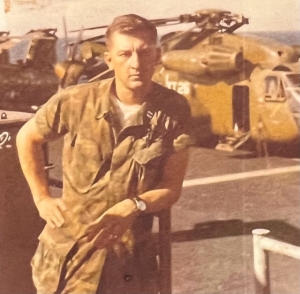 Captain Moseley is Married to the former Doris Sloterdijk, Four children between them. Nine Grandchildren, Five Great Grandchildren. Captain Moseley is a Graduate of Sam Houston State-BA, Studied at Univ.Texas.
Captain Moseley is Married to the former Doris Sloterdijk, Four children between them. Nine Grandchildren, Five Great Grandchildren. Captain Moseley is a Graduate of Sam Houston State-BA, Studied at Univ.Texas.
Memberships: Life Member: Marine Corps League, VFW, American Legion, DAV, Vietnam Veterans of America, Military Order of the “Devil Dogs”, Board of Directors- Marine Corps Coordinating Council of Southeast Texas, Mclemore Detachment # 324, Marine Corps League and others. He is also a member of the National Third Marine Div. Association, the Texas Third Marine Div. Association, the National Fifth Marine Div. Assn. and the National First Marine Association.
Muecke, James
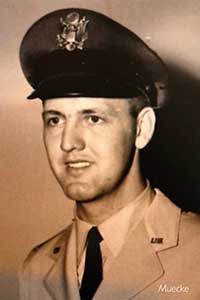 James E. Müecke
James E. Müecke
February 25, 1934, 85 years young
I was born in Shiner, Lavaca County, Texas to parents Harry and Sydonia Müecke (GERMAN) during the big depression. Unfortunately, I lost my dad at 16 months and my mother just as I turned 14. Had a 7 year older brother. My dad’s widowed sister raised me. Not an easy time during the Great Depression but you learned how to survive. I shined shoes, newspaper route and worked at the farmers’ co-op and cotton gin and a manufacturing plant.
Graduated HS in 1952 and attended Southwest Texas State in San Marcos and graduated in 1956 with a BBA and was commissioned a 2nd Lieutenant through the AFROTC. Entered active duty 06-12-56 and started pilot training. Washed out after 5 months and 59 hours of flight training. Assigned to the AC&W (early warning radar) in the Cold War. After training, I was sent to the northern island of Hokkaido, Japan. Sent to a remote/isolated site on a small island (Okushiri-Shima) off the southwestern coast, with radar coverage of the large eastern Russian Port of Vladivostok. To reach the island by AKL-29 it was a normal 10-hour boat trip, my first was 36 hours due to a major Siberian storm. Super sick with dry heaves. Very cold and much snow, at times the Quonset hut would be covered with snow and had to dig out. No entertainment facilities other than some old movies and no place to go visit. The Russians did not like us watching so often they sent Mig-15 fighters to test our radar being operational or strength. I was an aircraft controller so we had to scramble/send F-86 interceptors to run them home. Other intrusions, a B-29 shot down August 1958. I was notified to go TDY for 90 days where, you will know when you get there. After the Chinese Nationalist were run off the mainland to Taiwan/Formosa in 1948 they held on to two small islands, Matsu and Quemoy. The communist began shelling the islands 24/7 so the entire 7th fleet and the latest U.S. aircraft were deployed. It was very tense. One day 6, Migs were shot down with one damaged by the new sidewinder missile, which is still in use today. I was stationed on the Pescadore islands, a group of small islands between Taiwan and the mainland, so right in the middle of the action.
I rotated back to the states (after the one-year remote tour) for a short tour in California and then separated. My wife (we married in 1956) and I moved to Houston, Texas where I worked in the Materials Management dept of Transco Energy Company, a large Natural Gas Pipeline company moving natural gas from Texas to New York. I retired as Manager of Purchasing. Held several jobs and active in community affairs. When my wife had a stroke, I retired to take care of her. She passed away 17 years ago. We adopted a daughter who has two daughters, one married and one in college. My son lives with me.
Mulder, Elmer
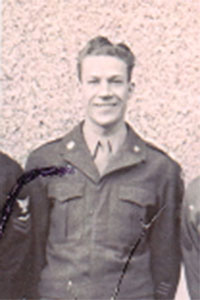 T-5 Sergeant in the U.S. Army from March 1944 to June 1945.
T-5 Sergeant in the U.S. Army from March 1944 to June 1945.
Born in Sioux Center, Iowa in October 1921. Graduated from High School in May 1939, was drafted into the Army in March 1944. Attended a medical Aid School in July 1944. Assigned to 239th Hospital Unit in October 1944. Sailed to England in December of 1944 and then into France in January of 1945 to a hospital as a medical aid. In Chalon-Sur-Marne, France as an assistant to a doctor.
Returned to the United States in June of 1945. Worked for the Burroughs Corp for 19 years as a service representative, then started his own business in 1955 selling office products.
Mulder married in June of 1949 and has now been married for 66 years with three children in Friendswood, Texas and has four grandchildren.
Murphy, Patrick
 Murphy was born in 1925 in Stillwater, Oklahoma. He attended Stillwater High School and one year at Oklahoma A&M, now Oklahoma State University.
Murphy was born in 1925 in Stillwater, Oklahoma. He attended Stillwater High School and one year at Oklahoma A&M, now Oklahoma State University.
Murphy became eligible for the draft in 1943, enlisted in the Navy, and qualified for the Navy V12 college training program. He was ordered to report to the University of Oklahoma at Norman, Oklahoma. He graduated with a Civil Engineering degree and commissioned as an Ensign in 1945.
Murphy was assigned to the USS PCE 875 in the Leyte Gulf area of the Philippines. When he arrived the ship was at a repair base and needed a reverse gear. It was decided it could not be repaired there so they joined a convoy with two other PCE’s to proceed to Pearl Harbor. While there the Navy decided to convert the ship for weather duty in the Alaskan area. Before it left Murphy became eligible for release from active duty and returned home.
Murphy subsequently took some Navy correspondence courses and was promoted to Lt. J.G. in the Naval Reserve. He retired from Amoco Corporation after 40 years of service in 1987 in Chicago.
Neal, Melvin
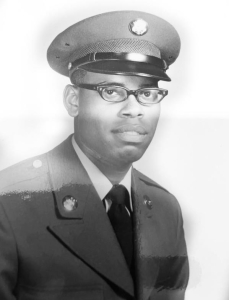 Melvin L. Neal US Army Spec. 4 Vietnam War
Melvin L. Neal US Army Spec. 4 Vietnam War
Spec. 4 Melvin L. Neal of the United States Army served his country in Vietnam from October 1966 to October 1967.
Melvin was born in New York City on June 13th,1946. His family moved to Houston, Texas in August of 1946. Melvin graduated from high school in June of 1965 and was drafted on May 12th,1966.
After processing, he was assigned to Fort Polk, LA for basic training. Eight weeks later he was sent to Aberdeen Proving Grounds in Maryland. After another eight weeks and two weeks of leave, Melvin was assigned to the 2nd Battalion 28th Infantry, 1st Infantry Division in Lai Kae, South Vietnam where after three months in the field, Melvin was assigned to the motor pool as a jeep parts clerk for the rest of his tour.
In October of 1967 he received orders for Fort Hood, Texas. Melvin was discharged from the Army on May 13th,1968. He returned to Houston, married and graduated from Texas Southern University with degrees in Biology, Chemistry and History. Melvin has 3 children, five grandchildren and two great grandchildren.
Nelson, Don
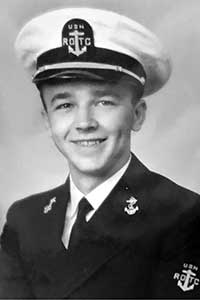 Donald O. Nelson
Donald O. Nelson
Don was born on October 11, 1926 in Estherville, Iowa. The oldest of 3 children, Don graduated from Eagle Grove High School in 1943 before enrolling at The University of Texas in Austin. He joined the United States Navy on March 1, 1944 and served until his Honorable Discharge on January 24, 1947 where he retired as a Second Lieutenant from the Navy,
On July 14, 1946, Don was transferred to the USS Deliver ARS 23 where he served until January 1, 1947.
One of his most interesting assignments while aboard the USS Deliver, was to witness a nuclear bomb test on Bikini Island. The Deliver, a naval supply ship, was part of a contingent of ships to witness the test. Afterwards, they sailed to many overseas port of calls before returning to the US. Donald
After his retirement from the Navy, Don returned to college where he graduated in May of 1948 with degrees in BS in Naval Science and Tactics and a BBA. He moved to Houston, TX where he met and married the love of his life, Bette Jean Lund, on August 21, 1955 at the Augustana Lutheran Church in Houston. They were married for just over 61 years before her passing in 2016. They were the proud parents of 2 children, 5 grandchildren and 2 great grandchildren.
Don worked for the steel industry for 51 years until his retirement in 2001. His hobbies include fishing, boating, golfing, gardening, singing in the church choir and watching his grandchildren laugh and play.
Nunn, Steven
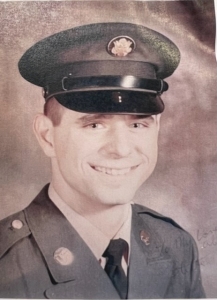 STEVEN L. NUNN
STEVEN L. NUNNSpec 4 E-4, United States Army
Steven served his country during the Vietnam War from 1971-1973. Steve was born in Enterprise, Ala-bama while his father was stationed at Ft. Rucker. When he was 3 months old, they moved back to Houston, Texas. He was drafter in 1971 and reported for duty on February 16, 1971. Steve went to Ft. Polk, Louisiana for basic training. After basic train-ing, he went to Ft. Rucker, Alabama, where his father was stationed, for his AIT training.
Once that was completed, he then went on to Hunter Army Airfield in Savannah, Georgia. This is where he received his orders to go to Vietnam.
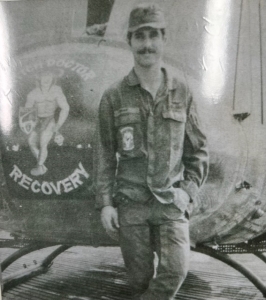
Steven married his high school sweetheart, Hollie Courson, on April 10, 1970. Their son was born on January 26, 1972. Steve left for Pleiku, Vietnam in April of that same year. He served as a 67N20 Crew Chief / Door Gunner on a UH! Huey named the, “Witch Docitor Recovery.” He omitted from telling his wife what his job was to keep her from worrying more than she already was!
When he returned from Vietnam, he was sent to Ft. Bliss, Texas for 2 month and then discharged from the service on February 15, 1973.
Steve and Hollie have been married for 53 years. They have 3 children, 1 son and 2 daughters, 6 grandchildren and 2 great grandchildren.
Offenhauser, George
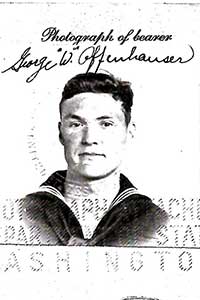 George W. Offenhauser, Sr.
George W. Offenhauser, Sr.
Born February 22, 1924 in Alhambra, CA. George enlisted in the US Navy under their M1 Program (Merchant Marines) in 1942. He was sent to Catalina Island, Avolone, CA for three months training. He received his Ordinary Seaman’s paper and was assigned to the tanker Paul Shoup in the deck gang. He sailed in the Pacific Theater from 1943 to 1946. During those years, he received his Certificate of Service to Able Seaman, Certificate as Tankerman, Master’s Certificate of Service of Sick or Injured Seaman and Certificate of Efficiency to Lifeboat Man. In all, George served on five different ships : Paul Shoup, M. H. Whittier, Alan Seeger, S.S. Plattsburg and the Wabash Victory. At his ports of call they delivered bunker fuel oil to Pearl Harbor; aboard the tanker they carried Hell Cats and Corsairs and delivered them to Esperato Santos; they delivered gasoline to Henderson Field, Guadalcanal, by submarine line and at times they delivered diesel to the Naval Base at Tillage for the submarines. The Wabash Victory was a freighter and was sent to Okinawa, Japan, to become the “invasion ship”. It was loaded with 65 railroad car loads of dynamite, 5 tons of blasting caps and complete airfield supplies (landing mats for air strips, planes and all equipment for a complete military air field). When they reached Okinawa, the war had just ended. They had to wait for new orders. However, the dynamite had become unstable from the heat, no one wanted it, so they were sent back to San Francisco where they had to just stay anchored out in the bay. George was discharged at that time (March 1946).
George had married his high school sweetheart, Rosalie H. Wald, while on leave In August of 1943. After being in California, they moved back to Houston, TX, in 1946. They were married 73 1/2 years before her passing in January, 2017. They have 4 children, 5 grand children and 7 great-grand children. AND George still plays 9 holes of golf every week!
Niederstadt, Roland
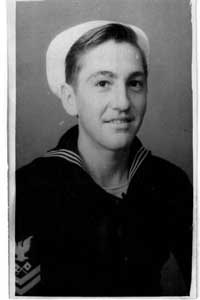 Niederstadt served in the Navy from 1944 – 1946 as a Signalman second class (2/C) on the USS Soubarissen a Navy Fleet Tanker in the Pacific Theater.
Niederstadt served in the Navy from 1944 – 1946 as a Signalman second class (2/C) on the USS Soubarissen a Navy Fleet Tanker in the Pacific Theater.
He participated in the Liberation of the Philippines and the Okinawa campaign. After the war Nierderstadt spent time in Hong Kong on occupation duty.
He returned home and went to college at Missouri School of Mines and Metalurgy on the GI Bill.
He retired from Mobil Oil in 1986 as a General Manager.
Niederstadt has been married 56 years to his wife Jan, they have three children, eight grandchildren, and three great-grandchildren. He currently resides in Beaumont, TX.
Oldham, Vernell
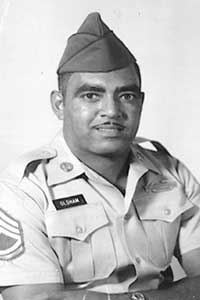 Vernell Oldham
Vernell OldhamUS Army
Sergeant Vernell Oldham was born April, 1932 in Caldwell, Texas. He attended Dorsey Lockridge School in Robertson County. Sgt. Oldham was drafted on December 2, 1952 and started his career at Fort Sam Houston in San Antonio. He trained at Fort Bliss in El Paso, TX.
He proudly served his county in 2 deployments to Korea with the 24th Anti-aircraft Artillery Gun Battalion and remained in Reserves of The United States Army obtaining the rank of Sgt. First Class E-7 Mess Stewart until 1972. He retired honorably from the military after 23 years of service. On moving to Houston in 1962, he opened a service station. He sang in Gospel groups and visits the sick, even now, every week.
He has passed his love for God, family, this country and, car mechanics down through the generations. He is a Deacon and the father of 3 children, 4 grandchildren with 1 grandson following his footsteps into the US. Army, and 5 great-grandchildren.
Owens, Michael
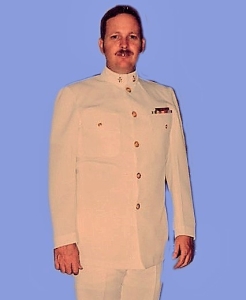 Michael L. Owens
Michael L. OwensUS Navy:Chief Cryptologic Technician Interpretive (CTIC)
Chief Owens served his country from 1970 – 1990.
Chief Owens was born in Houston, Texas in January 1951, graduated from Alief High School in 1968, and studied at Wharton County Junior College prior to joining the Navy.
He attended Navy boot camp at Recruit Training Com-mand Orlando, Florida and upon graduation was transferred to Defense Language Institute, Syracuse University to study the Russian language. He was then transferred to Goodfellow AFB in San Angelo, TX for further training.
Upon completion of training, Chief Owens served tours of duty with the Naval Security Group Command in Sinop, Turkey, Edzell, Scotland, National Security Agency Fort G.G. Meade, MD, and Misawa, Japan.
During his 20+ years, he was deployed aboard numerous surface and subsurface combatants, providing cryptologic support to units afloat. He also served as a language training instructor at Goodfellow AFB and was certified as a Navy Master Training Specialist and a USAF Master Instructor.
His awards include the Air Force Commendation Medal, Navy Achievement Medal, Navy Unit Commendation, Navy Good Conduct Medal with four bronze stars, Navy Expeditionary Medal with bronze star, National Defense Service Medal, Sea Service Deployment Ribbon, Navy and Marine Corps Overseas Service Ribbon with two bronze stars, Navy Rifle Expert medal, and Navy Pistol Expert Medal.
Chief Owens retired from the Navy in September of 1990. He re-turned home to Houston, began a career with CenterPoint Energy, and retired from there in 2013. He has been married to Sandy for 28 years, They have three children and two grandchildren.
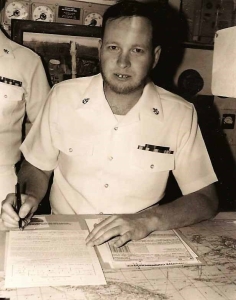 “The Navy taught me skills and helped me make many life-long friendships during my career. I try to keep in touch with many of the Brothers and Sisters I served with over the years.”
“The Navy taught me skills and helped me make many life-long friendships during my career. I try to keep in touch with many of the Brothers and Sisters I served with over the years.”
Patton, Gary
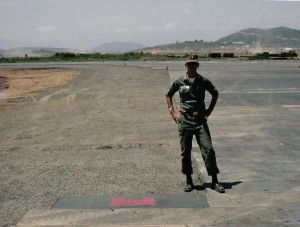 Ist Lieutenant Gary M. Patton , US Army Corp of Engineers – Vietnam War
Ist Lieutenant Gary M. Patton , US Army Corp of Engineers – Vietnam War
Graduated from Colorado School of Mines in 1965 with a degree in Geophysical Engineering. While at college took 2 years of ROTC allowing him to be commissioned as a 2nd Lieutenant upon graduation.
Initially assigned to Ft. Belvoir, Virginia but after 6 months was transferred to Vietnam. Assigned to the 62nd Engineer Battalion (Combat) where our unit constructed a runway for the Air Force stationed in Phan Rang. B-66 Canberras and F-100’s were constantly using our airstrip for missions flown over N. Vietnam.
Our battalion was also assigned to create a new road, including rice paddy crossing culverts as a direct route from the sea to our base. This was done with occasional efforts from the VC to halt construction using booby traps and other methods. Fortunately, our unit has a ROK (Korean) company to provide our security while we accomplished our mission.
After 6 months our battalion was transferred by LST to a new area north of Saigon which was to be-come Long Bihn base. We cleared jungle, built roads and generally assisted in constructing this base.
Following my assignment to Vietnam I was transferred to an Engineer unit in Ft. Carson, Colorado where I finished my active duty in 1968
During my service in Vietnam, I was awarded a Bronze Star medal, Vietnam Service Medal, and Re-public of Vietnam Campaign Medal.
Below photo was taken in 1968 where our unit was constructing the runway in Phan Rang
Phillips, William
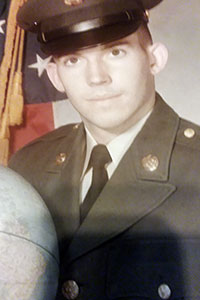
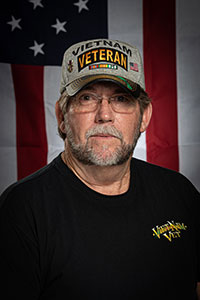 William L. Phillips
William L. Phillips
Sergeant E-5 United States Army.
Service from 1970 to 1977.
Overseas service Vietnam and Korea.
Born 1951 Owensboro, Kentucky.
Enlisted Regular Army, basic training at Fort Knox, Kentucky.
AIT Fort Monmouth, New Jersey
Radio repairmen and operator.
Vietnam Service unit 1st Signal Brigade, 41st Signal Battalion, Central highlands II corp.
Korea Service, Seoul Com Center.
Discharged Fort Polk, Louisiana
5th Infantry division.
Pierce, Jack
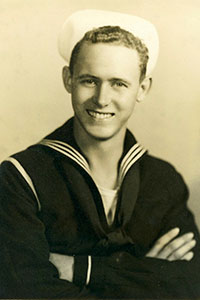 EM3c – United States Navy
EM3c – United States Navy
Served in World War II from 1942 – 1945
Pierce enlisted in the United States Navy in May 1942, at the age of 21.
He served in the South Pacific aboard the USS Cascade from 1943 to 1944, and aboard the USS Barataria from 1944 to 1945. He was honorably discharged December 4, 1945.
Pierce retired from the Gulf Refinery in Port Arthur, Texas where he worked for over 40 years.
He will celebrate his 60th wedding anniversary in October 2014 with wife Hilda M. Pierce. Together they have three children, George Yarborough, Melanie Lovelace and Sharon Ross. And they additionally have nine grandchildren and eleven great-grandchildren.
Pinto, Jerry
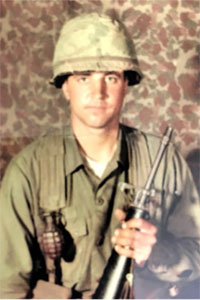 Gerald (Jerry) M. Pinto
Gerald (Jerry) M. PintoSGT/United State Army
As the son of World War II Navy veterans, I enlisted in the Army in January 1969, in Phoenix, AZ, after graduation from college. I completed boot camp at Fort Bliss, TX, and was sent to Fort Ord, CA, for infantry training. I deployed to Vietnam in July where I was assigned to the 101st Airborne Division (Screaming Eagles), 1ST Brigade, 2nd Battalion, 502nd Infantry, also known as “Strike Force”. As a member of a small elite reconnaissance group, I spent 13 months in the jungles of I Corps (northern South Vietnam) primarily in the Thua Thien Province. On February 11, 1970, five (5) of our group were killed in action. This is a day forever etched in my memory. I extended my service in Vietnam for extra month in order to be released from the service as I had less than 5 months remaining in my obligation. I was honorably discharged as a Sergeant in Fort Lewis, WA, in August 1970.
In 2018, my wife and I celebrated our 46th anniversary. Neither of our 2 children, a daughter and a son, live nearby, but we maintain a very close connection with them. I retired after an enjoyable career with a major oil and gas company and my wife retired from a rewarding career as a special education teacher. Although we moved several times during my career, I have been and remain involved in many community, church, youth and volunteer activities. My wife and I continue to travel extensively in the U. S. and the world.
Special Note: Honor Flight Houston is proud to have Sgt. Pinto on the board and fulfilling the role of Director of Administration. Jerry is instrumental in this organization and we honor his service to his country and to our veterans.
Pittman, Billy
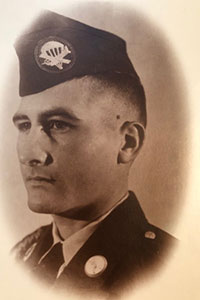
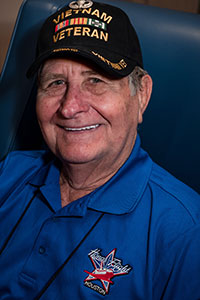 Billy Joe Pittman
Billy Joe PittmanUnited States Army 101st Airborne Division
Served his country during the Vietnam Conflict from 1961 – 1965.
Pittman was born on October 31, 1943 in Alvin Texas. He was raised in Bacliff Texas and graduated from Dickinson High School in 1961.
Pittman’s dream in high school was to enlist with the United States Army as joining the Armed Services was a tradition in his family. Because of his young age his parents had to provide this consent for him to be able to join. Pittman enlisted in Houston Texas, traveled to Fort Chaffee Arkansas for basic training and advanced infantry training, He volunteered for Paratrooper training and traveled to Fort Benning Georgia in order to complete the training. After graduation he was sent to Fort Campbell, Kentucky.
Pittman was discharged from the Army in 1965. He returned home and began his career with Houston Lighting and Power at that point. He retired after 44 years of dedicated service. Pittman recently celebrated 42 years of marriage with his wife, Patsye Pittman. He has filled his retirement years with church, neighborhood and city activities, as well as, helping others. Pittman also enjoys traveling, reading, enjoying his little dog, “Buddy” and riding his Harley.
Plomin, Joseph
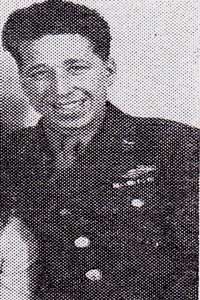 PFC United States Army, 5th Infantry Division, 10th Battalion, Company B.
PFC United States Army, 5th Infantry Division, 10th Battalion, Company B.
Plomin was inducted into the Army on March 30, 1944. He travelled to a camp near Macon, Georgia for basic training. Once training was over he was shipped overseas in July of 1944 and assigned to the 5th Infantry Division, 10th Battalion, Company B.
He was involved in the battles of the Moselle River and the Maginot Line in France. It was in Maginot Line where Plomin was captured by the Germans. He was located in a ‘pill box’ or bunker when the Germans turned a flame-thrower on the American Infantrymen. Only about 96 of the men survived out of a full company of 220 men.
Plomin was then taken to Stalag 10A for about six weeks where conditions were incredibly bad. He was forced to travel to Stalag 2B by boxcars or railroad with other prisoners of war with no food or water for three days.
Eventually, he ended up working on a farm with eleven other prisoners of war and stayed until the Russians were advancing. The prisoners were told to leave and forced to march for thirty-hours without stopping in order to cross over the Stettin River.
On April 15, 1945 Plomin was liberated by the United States 44th Mechanized Calvary. He then traveled alone, heading west for four days to join up with the British. He ended up in Brussels, Belgium with the British. From Brussels he traveled to Paris by train to join up with fellow Americans. Plomin then left France on May 1, 1945 on a hospital ship and arrived in the United States on May 15, 1945.
Plomin was granted a 68-day convalescent furlough to get to Florida where he remained until he was discharged on December 3, 1945.
Poe, Virgil
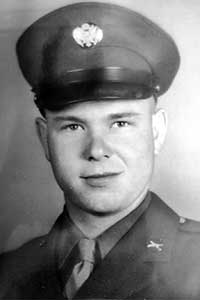 Virgil Poe
Virgil Poe
Technical Sergeant (T4) – US Army, 1944-1946
Born on June 28, 1926 in Mansfield, Arkansas, Virgil grew up poor in the Depression of the 1930s, just like many American children in the rural areas. Fresh vegetables were grown in the family garden behind the small frame house, and his mother made sandwiches for school out of homemade bread. Store-bought bread was for the rich. He grew up belonging to the Boy Scouts, playing the trumpet in high school band, raising rabbits and bees, and he went to church on most Sundays.
On October 1944, this 18-year-old country boy who had never been more than 50 miles from home found himself in US Army basic training at Camp Wolters, Texas. After that, he rode the train with hundreds of other American soldiers – mostly teenagers – to New York City for an ocean trip on a cramped Liberty ship to fight in World War II.
As a soldier in the 533rd Rocket Field Artillery Battalion, US 7th Army, he arrived in the European Theater on April 4, 1945. He was assigned to repeatedly drive supply trucks from Le Havre, France to support troops in the aftermath of the Battle of the Bulge. He saw incredible numbers of young Americans buried in graves throughout France, a sobering monument to those soldiers at Normandy.
Afterward, his unit fought on through the German cities of Aachen, Stuttgart, Cologne, and Bonn. As a teenager, he saw the concentration camps and the victims of the Nazis.
After Germany surrendered, Virgil was ordered to Fort Hood, Texas, to be re-equipped for the invasion of Japan. He was put on a train to Seattle, Washington from where he was supposed to be sent to the South Pacific; but he learned on arriving in Seattle that Japan had surrendered. So, he was ordered back to Fort Hood. He received an honorable discharge on August 5, 1946.
For his military service in World War II, Virgil received the US Army Good Conduct Medal, European-African-Middle Eastern Campaign Medal, World War II Victory Medal, and Army of Occupation Medal – Germany.
It was near Fort Hood that Virgil met Dorrace Hill at a Wednesday night prayer meeting service at the Church of Christ. After their marriage, he opened a DX service station, where he pumped gas, sold tires, fixed cars, and began a family. Deciding he needed to go to college, they moved to Abilene, Texas and Virgil enrolled in Abilene Christian College. He, Dorrace and their two small children lived in an old converted Army barracks with other such families. Virgil supported his family by working nights at KRBC Radio and climbing telephone poles for Southwestern Bell Telephone Company.
He finished college, became an engineer, and worked over 40 years at Southwestern Bell in Houston, Texas, where he still lives. Virgil turned down a promotion to transfer to New York City because it wasn’t Texas, and he said, “It was no place to raise a family.”
Virgil and Dorrace have a son, a daughter, 8 grandchildren and 17 great grandchildren. Dorrace passed away in 2019, after more than 70 years of marriage.
Pollock, Ray
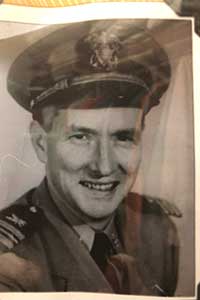 Ray Lusk Pollock
Ray Lusk Pollock
Ray Pollock was born in Delevan, Kansas in 1920. After several moves, is family located in Dallas, where he continued to live until moving to Houston in 2016. In Dallas, he graduated from Oak Cliff High (now Adamson) in 1937. After attending N.T.A.C. Junior College in Arlington, Texas, he transferred to the University of Texas. Graduating early in December 1941 with a degree in Accounting, he made plans to join the Navy. Initially, he was rejected for being color blind, but his persistence led to being accepted as a 3rd Class Carpenter’s Mate in the Seabees. Upon completion of boot camp, he was sent to Rekjavik, Iceland as a 3rd Class Storekeeper with the 9th Naval Construction Battalion. After a year, he returned to the States, received a promotion to Ensign and was sent to the Naval Supply Officers School at Harvard. From there he was sent to the 9th Naval Construction Battalion on Pelilua in the Pacific Islands until the end of the war. He was recalled to active duty for 2 years during the Korean War. He remained in the active reserves to finish his 20 years of service, retiring as a Commander. After the service, he earned a Law Degree from SMU and was also licensed as a Certified Public Accountant in Texas. He retired as a Senior Tax Partner with Arthur Young and Company after spending his career in public accounting.
He married Mary Beaman in August of 1947. They were married fifty-one years when she passed away. The have two daughters, five grandchildren, and eight great-grand children.
Powell, Donald
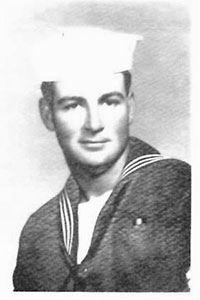 Donald R. Powell
Donald R. PowellPetty Officer Dental Tech G2 (E-5)
United States Navy
Powell served his country during the Vietnam Conflict from 1967 to 1970. He was attending the University of Texas at Arlington’s premed program, but decided to postpone education and volunteered in Dallas, Texas and was sent for basic training to San Diego Naval Station.
Powell was then stationed at New Port, Rhode Island Naval Base where he served as a Dental Technician for two years prior to deployment with the Mobile Riverine Force operating in Vietnam Mekong Delta. He was assigned duty aboard the USS Benewah.
He received an Honorable Discharge in 1970 and returned to Dallas, Texas where he continued his studies at Baylor College of Dentistry to graduate in 1974. Powell had a dental clinic in Austin, Texas area until 1978 and then moved to Hemphill, Texas where he practiced general and implant dentistry until his retirement in 2005, where he still resides with his wife of 42 years, Priscilla Powell, on Toledo Bend Lake. They have four children and 7 grandchildren.
Powell, Roy Lee
Roy and his family moved to Alvin in 1926 because his grandparents were here. Edgar Alonso Powell (Sarah Elizabeth) was the Methodist-Episcopal minister here at that time. (the church building and parsonage, where they lived, are still there on Sealy Street) Brother Fay and sister Shirley were born into the family in Alvin.
Roy attended Alvin schools starting with the white frame school house. The“Red brick schoolhouse”was from 4th-8th
Alvin High School was a much smaller place than it is now, when Roy attended from 1939-1943. He tried out for football once and faced the biggest guy on the squad. Coach Stapp Maxwell told him if he could get past this player, he could play for him. Roy was picked up like a rag doll and thrown back. That was the end of those plans.
Roy changed gears and was the smallest clarinet player in the first marching band in Alvin, directed by Otto Paris. The band was a huge part of Roy’s life. They were fortunate enough to be invited to play at the World’s Fair in New York City in 1940. The “Band Moms” raised money for the trip where 3 school buses took band members half way across the country, stopping to perform concerts in exchange for a place to stay in local schools and churches. At AHS, Roy was also on the debate team, which they called “Declaimers” and the Drama Club.
After graduation, Roy joined the United States Navy in 1943 during World War II. He left in 1946 and rejoined in 1948 during the Korean War. He was a Petty Officer II Class and was a radar operator on three different destroyers, U.S.S. Frank Knox, U.S.S. Leonard Mason and U.S.S. White Marsh. During his years in the Navy he crossed the equator 8 times.
While on a trip to see his parents in 1947, he met the love of his life, Marjorie Trimm, in DeQueen, Arkansas. Roy’s parents had traded their acreage in Alvin for a farm there. Roy was taking his brother and a friend, Joe Trimm to swim in the local water hole so Margie tagged along with her little brother. The rest, they say, is history. Roy and Margie married July 2, 1947 and immediately left for Alvin, where an older brother still lived. Jobs around Alvin were scarce, so he rejoined the Navy and they sent him to San Diego where they had their first daughter, Linda in 1949.
After leaving the Navy, Roy spent two and a half years at University of Houston studying electronics. Daughter Brenda was born during this time.
Returning home, Roy had several job opportunities including selling appliances at Stanton’s. He worked for other crews for years, building steel buildings, and decided to start his own company, Construction Service Company in the early 60”s. Roy and his crews have built hundreds of buildings up and down the coast of Texas and he can still tell you where they are.
Daughter Sandy was born in 1960. Daughter Laura was born in 1974. Four daughters born in four different decades?! Roy once told his mother that when he grew up he would surround himself with beautiful women and he did. He and Margie had four daughters, ten grandchildren and ten great-grandchildren. Margie passed away in July 2015.
Roy is still the biggest fan of Alvin High School. He has had season tickets to varsity football for over 50 years. Like most parents, Roy was at almost every event in which his girls and grandchildren participated, from football, basketball, softball, gymnastics, band concerts, and musicals. There is no greater person deserving recognition, than Roy Lee Powell.
Provost, Charles
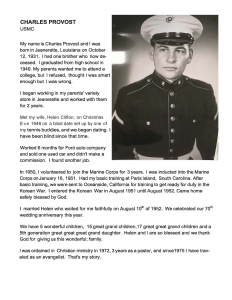
Putnam, Ky
Ky B. Putnam
Army Air Corp
Ky Putnam was born in Portland, OR to Roy and Irene Putnam on August 4, 1923. Ky’s father worked for Southern Pacific Railroad and in 1941 the family was transferred to El Paso, Texas. Ky graduated from El Paso High School and then enrolled into College of Mines and Metallurgy (now UT El Paso). Ky enlisted into the Arm Air Corp in 1942 and was called up to fight in WWII.
Ky joined the 414 Fight Fighters Squadron that was stationed in Pontedara, Italy where he flew P-61s, the Black Widow. He and his radar Operator, Johnny Marunovich flew nigh missions along the Po river in northern Italy. It was during one of these missions that that they targeted an enemy train and dropped a bomb on it. The explosion of the train damaged their plane, Willing Widow #1, and both had to bail out over the Apennine mountains. Ky and Johnny found each other after 3 days in the mountains which were in enemy territory. They were reported missing in action for approximately 3 weeks. With the help of friendly farmers and townspeople, Ky and Johnny made it back to their unit. Ky stayed with his unit and flew the Willing Widow #2 without incident until the end of the war.
For his outstanding flying and leadership, Ky was awarded the Distinguish Flying Cross. He also earned the Air Medal, American Campaign Medal, European-African-Middle Eastern Campaign Medal, and the WWII Victory Medal. Ky left the Army Air Corp as a 2nd Lieutenant and went to work for the Southern Pacific Railroad. Ky was Division Engineer for Southern Pacific before retiring and then put his civil engineering talents toward the company TrackWork. Ky still loves airplanes and has been a member and officer in the Commemorative Air Force Gulf Coast Texas Raiders.
Rader, Coleman
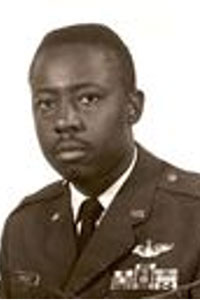 I was born in Winston Salem, N. C. Graduated from Atkins High School in 1953, studied Electrical Engineering at North Carolina A & T College. I enlisted in the Air Force in 1956, and completed basic training at Lackland AFB.
I was born in Winston Salem, N. C. Graduated from Atkins High School in 1953, studied Electrical Engineering at North Carolina A & T College. I enlisted in the Air Force in 1956, and completed basic training at Lackland AFB.
I was trained as a radar mechanic and assigned to Suffolk County AFB, where I worked on F-102’s. In August 1957 I married my wife, Emily, we have two daughters, four grandchildren and two great grandchildren.
After graduating from Officer Candidate School in September 1961 I was assigned to Craig AFB for pilot training, additional cargo aircraft training at Tinker AFB for C-124 Globemaster, then McChord AFB. Where I was assigned to 4th Air Transport Squadron (Heavy), we were direct support for Viet Nam from 1962 until 1964.
In1964 after attending Squadron Officers School I was assigned to Clark AFB PI, as an Officer controller for Military Airlift of cargo and troops in and out of Viet Nam. While at Clark I flew serval aircraft in support of the Viet Nam effort. (F-4, T-29, T-39, and C-54). I did R & R flights to Danang, Camrahn, Ben Hoa, and others.
My next assignment was Carswell AFB TX by way of Castle AFB for KC-135 training. While stationed at Carswell I did many refueling flights from Guam, Kadena, U-Tapao Thailand, and Taiwan, all in support of the B-52’s and the fighters that were deployed to the Viet Nam area.
After Carswell I was assigned to Offutt AFB, NE to work in the Underground Command Post (Strategic Air Command) as a controller. There I flew T-39’s and C-131’s.
I retired from active duty April 1976 after 20 years of service. I remained in Omaha and was employed by Northwestern Bell Telephone as a corporate pilot and later director of aviation.
I am currently retired and living with my wife of 61 years in Spring, Texas.
Ramos, David
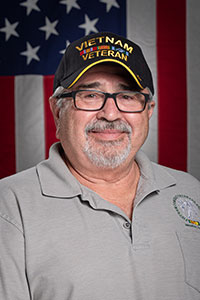 David Ramos
David Ramos
I enlisted in the Army, 1967 after high school. I was discharged from the Army in 1970 marking three years that would define me for the rest of my life. Took basic training at Fort Ord, California. From there I when to Fort Gordon, Georgia for AIT. Then to Fort Benning for jump school. Then to the friendly country of Vietnam. There I was assigned to the 3rd Brigade, 82nd Airborne and joined my unit, A Company, 1/ 505 Infantry.
A friend of mine has gone on this Honor Flight last year and said that this would be healing for me. Healing not from any physical wounds but mental wounds. Wounds I received after I came home, those from others and those I inflicted on myself. Like many others, I was not received with open arms. This only placed more anger; upon the anger I came home with.
I look forward to taking this flight with hopes that I will find some kind of healing and peace of mind.
Rees, Holly
Patrick Murphy
Murphy was born in 1925 in Stillwater, Oklahoma. He attended Stillwater High School and one year at Oklahoma A&M, now Oklahoma State University.
Murphy became eligible for the draft in 1943, enlisted in the Navy, and qualified for the Navy V12 college training program. He was ordered to report to the University of Oklahoma at Norman, Oklahoma. He graduated with a Civil Engineering degree and commissioned as an Ensign in 1945.
Murphy was assigned to the USS PCE 875 in the Leyte Gulf area of the Philippines. When he arrived the ship was at a repair base and needed a reverse gear. It was decided it could not be repaired there so they joined a convoy with two other PCE’s to proceed to Pearl Harbor. While there the Navy decided to convert the ship for weather duty in the Alaskan area. Before it left Murphy became eligible for release from active duty and returned home.
Murphy subsequently took some Navy correspondence courses and was promoted to Lt. J.G. in the Naval Reserve. He retired from Amoco Corporation after 40 years of service in 1987 in Chicago.
Reichek, Isadore
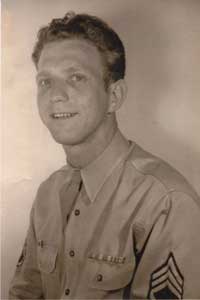 S/SGT, 343 Fighter Squadron, 55 Fighter Group, 8th Air Force
S/SGT, 343 Fighter Squadron, 55 Fighter Group, 8th Air Force
Reichek was born on March 9, 1920 in Hull-Daisetta, Texas. He was the 7th of nine children (Four Brothers, Five Sisters). Of his four brothers, three served in World War II.
Reichek was inducted in Houston, Texas on April 2, 1942. He was sent to school to be an aircraft mechanic on fighter aircraft, specializing on P38s and P51s.
Most of his time in the service was in the European Theatre where United States aircraft were protecting bombers.
Reichek was discharged on January 19, 1946 with the rank of Staff Sergeant. After being discharged he returned to Houston, Texas and resumed his job before joining the war. Since retiring he spends his time volunteering at the Shriner Hospital, going to Church, exercising with friends, and traveling with his wife and family.
Reichek has been married to his lovely wife, Anne, for 64-years, and they hope for many more. They have two children, five grandchildren, and two great-grandchildren.
Robinowitz, Maurice
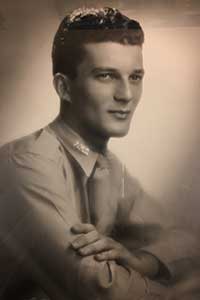 Maurice “Rock” Robinowitz
Maurice “Rock” Robinowitz
A native Houstonian, Maurice graduated from Lamar High School in 1944 and from Texas A&M in the class of 1948.
Rock served in the Army Air Corps from 1945-1947 in the Pacific Theater, and is the past president of the Houston Texas A&M club, serving as Class Agent for the Class of ’48.
After retiring from the grocery store business in 1991, Rock devoted his time to volunteering. He served as president of volunteers at the Houston Arboretum & Nature Center and “President” of the Wednesday volunteers at the M.D. Anderson Children’s Art Project.
Rock’s beloved wife of 66 years, Marilyn, passed away last summer. His daughter Robin lives in Philadelphia, along with her husband Lou and grandson Jared.
His son Bob lives in Houston, along with his wife Maria and granddaughters Lilliana and Camila, ages 8 and 10, who keep Rock on his toes!
Robinson, Charles
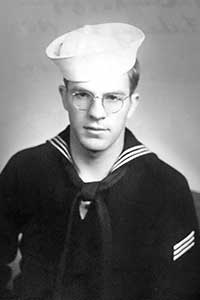 Charles F. Robinson
Charles F. RobinsonQM2 United States Navy Feb. 1952 – Feb. 1956
Born Sept. 12th, 1930 – Homer, Louisiana
Moved to Vivian, Louisiana 1936
Graduated Vivian High School 1947
1952 Basic training USNTC San Diego, California
May 1952 USS PCEC 882 San Diego, California
Pearl Harbor- Midway – Japan – Korea – Iwo Jima
August 1953 Flag Allowance Com Trans Div 13
Aboard USS Calvert APA 32 San Diego, California
October 1953 SSC QM School USNTC Bainbridge, Maryland
February 1954 Flag Allowance Com Trans Div 13
Aboard USS Calvert APA 32 San Diego, California
Picked up troops in Korea and brought them back to California
September 1954 Went To Vietnam and Transported people from North Vietnam to South Vietnam
April 1955 Transferred to USS Laning APD 55 – through Panama Canal to Brooklyn Naval Yard
Finished active duty reserve training
Honorably Discharged February 1960
Married Eleanor Hewins in August 1955
Eleanor passed June, 2019 two months before our 64th anniversary
We have three boys; Charles, John and Paul as well as one grand daughter Rachel
Robinson, James
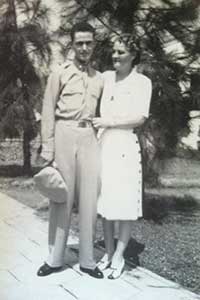 Enlisted June 1942 in Army Air Corp. Had radio experience from being an Amateur Radio Operator since age 12 and top FCC license. So was not sent to any school. Assigned as radio-operator mechanic and worked in the specialty until Oct 1943 when the Communications Sq Commander sent me to 8 months of officer training in electronics. Three months officer training in Goldsboro NC Air
Enlisted June 1942 in Army Air Corp. Had radio experience from being an Amateur Radio Operator since age 12 and top FCC license. So was not sent to any school. Assigned as radio-operator mechanic and worked in the specialty until Oct 1943 when the Communications Sq Commander sent me to 8 months of officer training in electronics. Three months officer training in Goldsboro NC AirBase and then to Yale University. ( The Army had taken over most of Yale to teach electronics, photography and Weather) That training was for 5 months. Commissioned as Communications Officer July 1944 and assigned to AACS. Several more electronic schools. Transferred to Iceland Jan 1945 to install Direction Finding Equipment that they had trained me at Scott AF Base. Discharged Sept 8th as war ended.
The USAF recalled me Aug 1948 during Berlin Air Lift. Sent to Japan and stationed at Tachakawa AFB as Base communications officer. My family (was married Dec 8 1940) joined me in Japan in Feb 1949. We remained on this base during the Korean War. Returned to the States in Nov 1951 assigned as Radio Maintenance officer AACS at MacDill AFB Tampa Fl and later transferred to Cocoa Beach FL as OIC of the control tower and small communications center. Discharged March 31, 1953 and enlisted in the FLAir National Guard in Jacksonville FL as their communications officer. Retired Aug 1964 and started drawing benefits in 1981 and have now been on retirement for 35 years. Now Age 95.
AACS furnishes control tower operators, runs communications centers back then radio teletype, Morse code operations and Crypto and maintains the equipment used. Of my 9 years active duty approximately 30 months was assigned to AACS Squadrons.
Robinson, Marvin
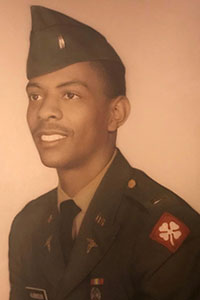
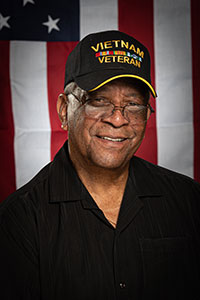 Marvin R. Robinson
Marvin R. RobinsonCaptain U.S. Army Medical Service Corps
Served as Special Service Officer as well as a Unit Commander during his tour of duty in the U.S. Army. He was stationed at Fort Sam Houston, San Antonio, TX, Fort Hood, Killeen, TX and the Republic of Vietnam. He received the Bronze Star, Army Commendation Medal, the Vietnam Campaign Ribbon and numerous other awards with an Honorable Discharge.
He has one daughter, Stephanie Rivers by a previous marriage and a step-son, Carl Payne, II by his present wife, Carolyn A. (Simpson) Robinson. They reside in Houston, TX.
Roenigk, Ray
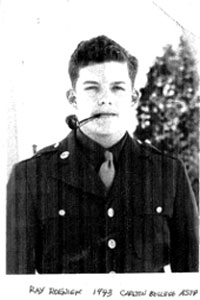 Drafted in 1943, sent to Air Force, Shepard Field for basic Glider school accepted into ASTP sent to Lincoln, Nebraska then to Carleton College Northfield, Minnesota. ASTP disbanded around 1944, sent to Camp Phillips, Kansas then to Keesler Field, Biloxi, Mississippi. Then to Elgin Field, Florida for B-17 Gunner School. Roenigk’s eyes weren’t good enough, so he was sent to a Carolina troop carrier unit where he did basic maintenance on C-47’s and CG-44 Gliders. Went to Europe in 1945 England, Belgium, France and German. When war was over he went to two technical schools while waiting to go stateside or to the Pacific Theater. Roenigk was discharged in 1946.
Drafted in 1943, sent to Air Force, Shepard Field for basic Glider school accepted into ASTP sent to Lincoln, Nebraska then to Carleton College Northfield, Minnesota. ASTP disbanded around 1944, sent to Camp Phillips, Kansas then to Keesler Field, Biloxi, Mississippi. Then to Elgin Field, Florida for B-17 Gunner School. Roenigk’s eyes weren’t good enough, so he was sent to a Carolina troop carrier unit where he did basic maintenance on C-47’s and CG-44 Gliders. Went to Europe in 1945 England, Belgium, France and German. When war was over he went to two technical schools while waiting to go stateside or to the Pacific Theater. Roenigk was discharged in 1946.
Roenigk went back to Carleton for college, but the commute was too expensive, so he transferred to U.T. in Austin. Graduated in 1948, worked at Petro-Tex & Sinclair. After several years he started his own business with a friend from Carleton called Geneva Industries. Roenigk retired with Chemical Exhange industries at 70.
Hobbies included Golf, flying, skiing, jogging.
Rush, Carl
 After high school graduation in 1942, and working that summer, Rush attended Purdue University as an Engineering student. He was in the ROTC and in October of 1942 volunteered to join The Enlisted Reserve, which took him out of the draft board’s control.
After high school graduation in 1942, and working that summer, Rush attended Purdue University as an Engineering student. He was in the ROTC and in October of 1942 volunteered to join The Enlisted Reserve, which took him out of the draft board’s control.
In May 1943 the Enlisted Reserve Corps was called into active service and Rush did Basic Training at Ft. Eustis in Virginia. There he trained on the 40 MM Bofors AA Cannon. After a short leave he went to Ft. Meade for additional training, then to Camp Kilmer for shipment overseas.
Rush was sent overseas on the QUEEN ELIZABETH and landed in Scotland where he was then sent to England to a replacement depot. Eisenhower was rapidly expanding SHAEF and was taking all clerks into his headquarters–lesser units had to take whatever was available and train them to be clerks. Rush ended up in HEADQUARTERS 1ST ARMY in Bristol England.
He was assigned to the Mimeograph Department of the Adjutant Generals staff. He spent the next three days walking around a large table assembling copies of orders and memorandum for distribution to every unit in First Army.
A necessary but tiresome job.
Then Rush was introduced to the A. B. Dick Model 92 Mimeograph Machine. First Army had three of these electric operating machines.
Sometimes we ran them 12 to 14 hours a day to print the Army information.
First Army was located at Clifton College in Bristol, England. Enlisted men were housed in large residences formerly used as dwellings by the college students. They stayed in Bristol for twenty days after the invasion, then they were sent to France. The Battle of Normandy ended the day that First Army Rear came into France.
In Normandy First Army was housed in pup tents in a wooded area near the large chateau, which provided office space for the Army.
The Army moved on a sea of paper and my job was to help make the sea work. A very small paddle, but necessary to getting the job done.
From Normandy they moved to the Rothschild Estate near Paris, then on to three different locations in Belgium. During the Battle of the Bulge Rush caught a chill and had a recurrence of rheumatic fever from his childhood, was hospitalized and sent back to France to Orleans south of Paris. Luckily he got a pass to Paris from the hospital and was sent to the replacement depot and returned to his outfit via the famed 40 and 8ts of the First World War.
Rush’s outfit was in Belgium preparing for the assault on Germany, after the Battle of the Bulge Germany faded quite rapidly. Headquarters First Army, with a core of officers and enlisted men from 2nd Corps in Africa, had planned the invasion of Sicily and Normandy. First Army Headquarters was chosen to go to the Pacific to help plan the invasion of Japan but we were re-routed through the States. When they dropped the Bomb and the war ended rapidly Rush was stateside and had enough points to get out of the service. If Rush had still been in Europe he would not have had enough points to get a boat for six months.
Rush was discharged in October of 1945, and since Purdue was on a trimester schedule he was able to be back in school within ten days of leaving the Army.
Ruth Jr., George
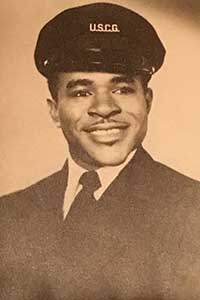
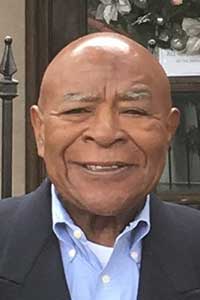 George was born November 14, 1928 in St. Francisville, Louisiana. He was the sixth of eight children born to George and Hattie (Washington) Ruth, Sr. George entered the military before his 15th birthday in 1943, attending Army infantry training, heavy weapons training, and desert training before shipping out with the 93rd Infantry Brigade in the Pacific during WWII.
George was born November 14, 1928 in St. Francisville, Louisiana. He was the sixth of eight children born to George and Hattie (Washington) Ruth, Sr. George entered the military before his 15th birthday in 1943, attending Army infantry training, heavy weapons training, and desert training before shipping out with the 93rd Infantry Brigade in the Pacific during WWII.
After the war, George re-enlisted into the U.S. Coast Guard, attended Military Leadership & Master at Arms Schools and faithfully served our country in The Korean War and through The Vietnam War.
George served on the following Coast Guard vessels:
USCGC Tamaroa (WMEC-166) – 1947 to 1949 USCGC Kukui (WAK-186) – 1954 to 1956
USCGC Acacia (WLB-406) – 1957 to 1962
USCGC Bramble (WLB-392) – 1962 to 1965
George received multiple medals during his career to include the Combat Infantryman’s Badge, The World War II Victory Medal, the Korean Service Medal, the Vietnam Service Medal, and the Good Conduct (six Stars). He retired after twenty-two years of service.
In 1968, he married the former Lois Deslonde, and they moved to Houston, Texas where their three sons were born. George later moved his family to Rosharon, Texas where he was employed by The Texas Department of Criminal Justice as the Director Food Service. After completing twenty years of service George retired. He then went on to serve as a bailiff for Brazoria County and also became an agent for Catholic Life Insurance.
Ryan Jr., Bernard
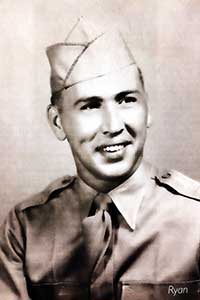
Salinas, Jesus
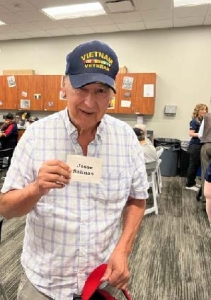 Jesus “Jesse” Salinas
Jesus “Jesse” Salinas
US Army; E-3
Vietnam War
My name is Jesus “Jesse” Salinas. I was born on December 24, 1940.
I grew up and attended school in Port Arthur, Texas. I was drafted to serve in the United States Army on September 22, 1964. I served in Vietnam.
I was in the 2nd Bat, 28 Inf, Big Red One, at Lia Khe Vietnam. I was there from 1964 to 1965.
Sanchez, Elias
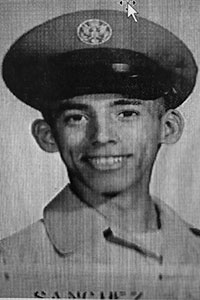
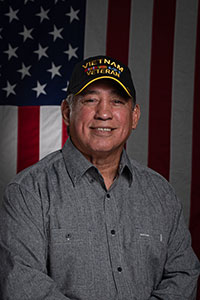 Elias Sanchez-Perez
Elias Sanchez-Perez
Joined USAF at 18 after having fought in Corpus Christi Silver and Golden Gloves boxing tournaments since age 12.
Became member of USAF TAC commands, 1962 – 1963.
In 1963, became USAF World Wide Boxing Champion in welterweight division. Toured the U.S. and Southeast Asia (Vietnam) with USAF Boxing Team. Participated in many Intra-military boxing tournaments to boost morale of troops, i.e., got beat up as entertainment for the troops. However, didn’t think much of it since it was in my blood for so long.
After two years of fighting and traveling, I insisted in getting schooling. Commander offered me one year of trade school in electronics so I took it and liked it. After electronic school, I became member of USAF Air Defense Command as transferred to Phoenix, Arizona, Luke AFB.
After USAF, I continued in electronics at University of Texas at Austin in Electrical Engineering. Received my BSEE and went to work at NASA JSC for all my adult life. While at NASA JSC, I continued in electronics and earned my M.S. and PhD, being happy to contribute to America’s future in the space age. I met all six Hispanic Astronauts as Dr. Ellen Ochoa, Franklin Chang Diaz, Col. Sydney Gutierrez and more. We, as professionals working in space age, organized five symposium to promote science and engineering to local students. We packed with the students the Gilreath Center at NASA JSC that has a capacity of 1,000.
We were quite happy to promote science and engineering during those times.
So far, no regrets on my USAF contributions.
Santillan Salvador
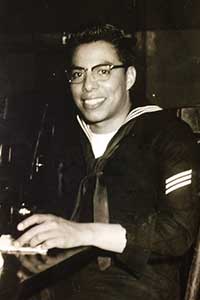 Salvador “Paloma” Santillan was born in Houston, Texas on July 20, 1933.
Salvador “Paloma” Santillan was born in Houston, Texas on July 20, 1933.
He joined the US Navy on July 17, 1953 at 19 years old during the Korean War. He remembers vividly taking the train from his hometown of Houston, Texas to boot camp in San Diego, California and being sick to his stomach since he was leaving home for the first time. The first ship that he shipped out on after 3 months of boot camp was USS Pine Island AV12. He delivered goods to Point Magod Airbase to different islands for two months. He was able to stay in Pearl Harbor for 2 years so he enjoyed going out to vacation island. He constantly moved to different ports in Asia, Taiwan, Japan and Hong Kong. He has great memories of staying in Asia for two weeks and playing softball and winning against the Chinese. He made constant trips to the Philippines. Some of his greatest memories are how wild the weather conditions were and the great friendships he made during his time in the service.
Salvador, joined the Merchant Marines in 1962 after taking some time to visit relatives in Mexico and relax a little. During his time with the Merchant Marines he made 3 world cruises. His home port was in Okinawa and he worked in the engine room. His time on board the ships are also full of great memories. He enjoyed vacations in a very hot Vietnam. (He really enjoyed Vietnam.) He enjoyed exotic food from all over the world. He slept outside mostly when he was onboard and remembers more bad weather while on the ships. He also lived all over the world and enjoyed the year he spent living in Brazil. He has great stories from all of his worldly travels.
He married his wife, Lucy Santillan, in 1978 after a very long bachelor life. He’s been married for 41 years and has 4 children and 9 grandchildren. He finally retired in 1999 after many years of sailing. He has been an amazing grandfather. He can be found at every sporting event and school event that the grandchildren have had. He’s very involved and active in all of their daily activities.
Schmidt, Kenneth
 Staff Sergeant United States Army
Staff Sergeant United States Army
Schmidt served his country in World War II from 1942-1945.
Schmidt was born on July 8, 1922 in St. Charles, Missouri. He was the oldest of five children and started his Army career at Ft. Knox, Kentucky. He went to North Africa in May of 1943. The war ended in North Africa when he was 8 days out to sea. He prepared for the invasion of Sicily, which lasted 3 months. He then was sent to Italy and stayed for the remainder of the war.
Schmidt was overseas for 30 months and earned five battle stars. Following the 1944 Liberation of Rome, he was fortunate to witness the first audience for the GI’s with Pope Pius XII.
Schmidt was discharged from the Army in December 1945 and returned to Missouri and enrolled in the University of Missouri in January of 1946. He married his college sweetheart, Joann Leontsinis in 1949. They were married 54 years until her death in 2003. They raised three children, 10 grandchildren and 2 great-grandchildren.
Schmidt started his own business in 1977 and still works today.
‘I proudly served my country – the greatest country in the world.’
Schulenberg, William
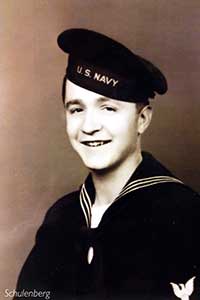 William (Bill) Schulenberg
William (Bill) Schulenberg
My story begins in 1945. I was drafted by the Army. Had my physical and filled out all the forms. I was accepted, but would not have to report for duty until after I completed High School which wasn’t until June 1946. A high school friend & I decided join the Navy instead. We went to Boot Camp together; but the Navy sent us in different directions. I ended up in Boston, Mass; the last man assigned to the USS Hyman; DD 732. (a destroyer) or what we affectionally called a “Can’ Being the last man assigned aboard the Hyman, I was rewarded the only job available: the fire room, and I became a Fireman. Later I was assigned the “big wheel” where you make sure the water level in the steam drum is just right. If the water level is too high, water gets blown into the engines in the engine room, and shatters the blades of the motor. If the water level is too low, you burn up the water tubes, and you’re in big trouble!
Meanwhile, when WW II was full speed ahead, the Hyman and it’s top decks crew were dropping depth charges, or shooting down planes before they got shot or bombed That’s the usual activity on a “can.” But, the shooting war was over. We were assigned Occupational activities. Oh, I forgot to tell you; the Hyman left Boston to go to Naples, Italy. No planes or submarines to worry about. But there were still lots of undiscovered mines out there in the Mediterranean Sea; in fact the ship that replaced the us had its fantail blown off by one of those mines. For the Korean War, I found myself aboard the USS Pine Island AV 12, a sea plane tender. We were located at the Pescador Islands; between Formosa and China. We were the watch dog; just in case China decided this would be a good time to take back Formosa. We went to our battle stations daily, just in case. Only one time we sighted an unidentified aircraft. It apparently saw us; because it turned around and went back to where ever. Meanwhile the Korean War was very real for our Marines and our Army; but for us, there were no submarines or planes for us to worry about. Oh, (At this time, I did note how fast jet planes were, and remembering how difficult it was to shoot down propeller planes in WW 11.) Wow! Yes, I served in WW II & the Korean war; neither of those times was it a shooting war for me. I was very lucky, or blessed. And, yes, what the crews of both the Hyman & the Pine Island did was a necessary part of defending our freedom!
Seibold, Robert
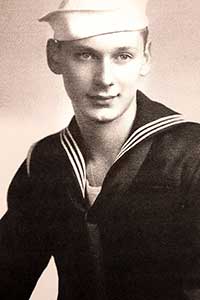 Robert Seibold
Robert Seibold2nd Class PO; USNR
Drafted July 25, 1944, Seibold was sent to Sampson Naval Base on Lake Geneva, NY. He went for additional training at Anacostia Naval Base outside Washington, D.C.
Assigned to the U.S.S. Dionysus, and auxiliary repair ship, in April, 1945, Seibold operated the ship’s laundry.
He sailed from Norfolk, VA, through the Panama Canal, to the Marshall Islands, and then to Tokyo Bay. He was discharged on June 6, 1946.
Robert Seibold returned to his birthplace, Buffalo, New York, before going back to school on the GI Bill. He retired as a parish pastor and moved to Houston, Texas. On September 1, 2018, he married a college sweetheart of more than 70 years ago.
Smedstad, Allan
Specialist first class United States Army. Allan served his country during the Korean War from 1954 to 1956. Allan was born in March, 1933 in Starbuck, Minnesota. His parents moved the family to Danube, Minnesota. Allan went to school there and graduated from Danube High School. While growing up in Danube; he also helped his dad in the creamery. He was drafted on November 11, 1954 and spent his 8 weeks of basic training at Fort Ord, California. After basic training Allan was transferred to Fort Devens, Massachusetts. This is where he trained another eight weeks to learn Morris Code and served as part of the Army Security Agency. After completing his training at Fort Ord, he was transferred to Fort Huachuca, Arizona. From there he was transferred once again to Fort Riley, Kansas, where he completed his tour of duty. Allan was discharged from the Army in November of 1956. After being discharged, he and his wife Mary Kay moved their young family to Los Angeles, California. He and Mary Kay raised four children during their 35 years of marriage. He is the proud grandfather of eight and the proud great-grandfather of five. Allan has remarried and is currently living with his wife, Cynthia, in Katy, Texas.
Smith, Gerard
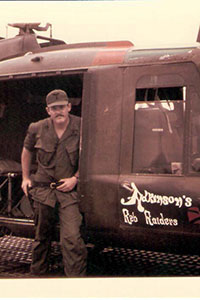
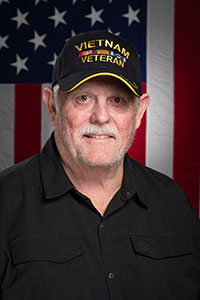 Gerard J. Smith
Gerard J. Smith
Smith was born in Brooklyn, NY in June 1942 and raised in Baldwin, LI, NY. He attended Chaminade High School in Mineola, NY and graduated from the University of Vermont where he received a Regular Army Commission as a 2nd Lieutenant and a Private Pilot’s license through the ROTC Flight Program. Smith attended Infantry Officers Basic Course (IOBC) and Airborne School at Fort Benning, GA. He then completed Primary Helicopter training at Fort Wolters, TX and Advanced Helicopter training at Fort Rucker, AL.
Captain Jerry (Smitty) Smith flew 1,310 Huey combat hours in the RVN from April 1967 through April 1968. He served on the advance party that moved the newly formed 188th Assault Helicopter Company (AHC), the Black Widows, from Fort Campbell, KY to Dau Tieng. Smith flew slicks in support of the 25th Infantry Division in ll Corps and again when the company moved to Tuy Hoa in support of the ROK Tiger and Whitehorse Divisions in Il Corps. Smith transferred to the Stinger Gun Platoon in August 1967. Smith then transferred to the 116th AHC, the Hornets, based in Cu Chi where he flew Huey B model gunships as Stinger 95. In November 1967 he attended the Cobra Q course in Bien Hoa. Smith rotated stateside in late April 1968 and instructed at the Fort Wolters Primary Helicopter School until his discharge in February 1969. During his tour in RVN Smith received 31 Air Medals, The Army Commendation Medal, two Distinguished Flying Crosses and the Purple Heart.
Following his service, Smith pursued a career in Aviation flying, demonstrating and selling turbine powered helicopters and fixed wing aircraft. He is a Commercial, Multi-engine, Instrument, and Instructor pilot in helicopters and fixed wing aircraft and has a Westwind Jet Type Rating.
Smith married his wife, Gene Ellen, of 51 years following his tour in RVN. They have two grown children and four grandchildren. They have been residents of Friendswood, TX for 46 years.
Smith, Paul
 Smith was born on March 29, 1927 on a cotton farm in Mississippi. When WWII broke out he was fourteen.
Smith was born on March 29, 1927 on a cotton farm in Mississippi. When WWII broke out he was fourteen.
He joined the Merchant Marines since he was too young for “Military” service at sixteen. His ships delivered supplies and troops to ports in Russia, North Africa, South America, the Pacific, Australia, and the Admiralty Islands among other ports.
He lost three ships, one in the Atlantic, one in the Gulf of Mexico and one of which was intentionally run aground at the Battle of Leyte to avoid sinking by Kamikazes while offloading cargo and troops. At sixteen he joined the Freedom Fighters and fought with the Army 1st Cavalry on Leyte and Mindanao for several months.
Once he returned State side he joined the Army training troops. Later he served in the Navy. He volunteered for Korea but was denied because of young children at home and the need for Corpsmen, the school he was currently in.
During Vietnam he served on an LSD 25 – the San Marcos off the coast of Vietnam and New Guinea, hosting helicopter and tank support for the Marines. This included delivery of supplies and as a corpsman, medical services and extractions.
Smith eventually retired from the Navy in the nineteen-seventies. He was married for 63 years to a true military wife and has five daughters who are proud to be called military brats, and are especially proud of the service and sacrifice of their Father and their Mother.
Sobotik, Jesse
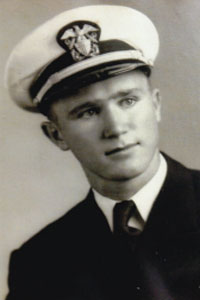 Lieutenant, United States Navy Reserves
Lieutenant, United States Navy Reserves
Sobotik was born in Rosenberg, TX IN 1926.
Sobotik was accepted into the Naval Aviation Program (V-5) on February 29, 1944. He was sent to Mississippi College in Clinton, MS and after eight months, he was transferred to the V-12 Program at Polytechnic Institute in Ruston, Louisiana for another eight months. Sobotik was then transferred to Rice Institute in Houston, TX and graduated in June 1946 with a degree in Naval Science and Technology and was commissioned as an Ensign.
After being stationed in Orange, TX on a reserve ship, Sobotik was sent to Naval Supply School in Bayonne, NJ in October 1946. After completing his course, he was assigned to the USS Corduba (‘The Rusty Bucket’), a refrigerated cargo ship out of Bayonne, and delivered food provisions to our armed forces in Cuba, Puerto Rico, Trinidad, England, Greece and Casa Blanca from January 1947 to September 1947.
Sobotik was released honorably from active duty on September 9, 1947. He retired from the U.S. Naval Reserves in 1961. He received a BBA degree in 1949 and a MPA degree in 1952 from the University of Texas. Throughout his accounting career, he worked for several oil companies in Houston, TX and Venezuela, South America.
He married Mary Zaruba in December 1955. They have five children and five grandchildren.
Sparks, John W.
Gunnery SGT, USMC
Enlisted in the United States Marine Corps on December 5,1966 from Bellaire, Texas.
Served in RSVN from August, 1969 until September, 1970 with MAG13 HMNS 13 Chu Lai RSVN
Mos 6241
Stephans, James
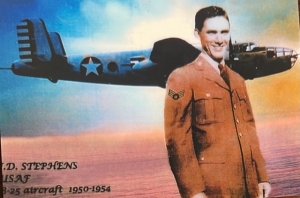 James D. Stephens
James D. StephensUSAF; A1C
Korean War
Airman 1st Class (A 1/C) United States Air Force. J.D. served his country during the Korean Conflict from 1950 to 1954.
He was born in Arlington, Texas on June 12, 1931. His family moved to Pensacola, Florida in 1945 where he graduated from Pensacola High School in 1950.
He volunteered for the Air Force on October 24, 1950 and had basic training at Lackland Air Force Base in San Antonio, Texas. He spent a short period of time in Biloxi, Mississippi. He was then assigned to James Connally Air Force Base in Waco, Texas as an Aircraft Mechanic. He later became a Crew Chief on B-25 aircraft at Sheppard Air Force Base in Wichita Falls, Texas where he became a Tune-Up Specialist. He served there for two years before being transferred back to Waco.
J.D. was discharged from the Air Force on October 24, 1954. He returned to Pensacola and moved to Pasadena, Texas where he was employed by Shel Chemical Refinery. He attended Lee Jr. College in Baytown, Texas and acquired a 2-year degree.
He moved to Alvin, Texas and went to work for Monsanto Chemical Company as an Operator in 1962. In 193, he retired as a Maintenance Production Planner. He actually retired from Monsanto, Conoco, DuPont and Occidental. He sat at the same desk all those years, but his company kept getting sold.
J.D. and his wife, Barbara, have been married for over 51 years and have a blended family of 5 boys and 2 girls, 10 grandchildren and 12 great-grandchildren.
Sunderhuse, Denis
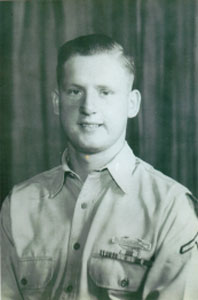 Combat Infantryman, United States Army, Sunderhuse served his country in World War II from 1944 – 1946.
Combat Infantryman, United States Army, Sunderhuse served his country in World War II from 1944 – 1946.
During his service, he faced combat in the battle of Luzon in the Philippines. Sunderhuse received the following decorations and citations:
Asiatic-Pacific campaign ribbon with 1 Bronze Star
Philippine Liberation campaign ribbon with 1 Bronze Star
Good Conduct Medal
Victory Ribbon
2 overseas bars
Sunderhuse was born in Brenham, Texas July 9, 1925. He was drafted August 28, 1944, he was assigned to Company H of the 342nd infantry, attended basic training in Fort Hood, Texas and was transferred to California before being shipped out to Luzon in the Philippines. He served approximately on year in combat until the war eneded in September 1945, he was then transferred into the Blackhawk Division where he was assigned as cook.
Sunderhuse was discharged from the Army in 1946 returning home in Roseberg, Texas. In 1949 he met and married Lorine Liebscher, they had one daughter and divorced in 1953. Sunderhuse later met and married Irene Zwink in 1958 and together had three daughters. They were married 49 years before Irene’s passing in 2008 just 5 months before their 50th wedding anniversary.
Sweet, Bob
 Sergeant T4, United States Army.
Sergeant T4, United States Army.
Sweet served his country in World War II from 1945 – 1947.
Sweet was born April 19, 1927 in Blackwell, Oklahoma. His family moved to Bethany, Oklahoma so his Dad could attend Bethany Nazarene College.
Sweet started school at Crooked Oak Elementary School in Oklahoma City in 1933. He was in high school in Carnegie, Oklahoma in 1945 when he was drafted into the Army.
Sweet was sent to Fort Chafee, Arkansas, from there he was sent to Fort Knox, Kentucky for training and then sent to Camp Pickett, Virginia. He was packed with winter clothes and going to Germany and the war ended and his orders were changed and he was sent to Tokyo, Japan. While in Japan he served under General MacArthur. He was chauffer for Captain Holland, Colonel DeWitt and Major Reiner.
Sweet saw the damage and destruction caused by the A-Bomb and the people who were still suffering from the burns. He saw towns completely flattened, in one town all of the buildings were flattened except one little white wooden church that was still standing.
Sweet was discharged at Fort Beal, California in February 1947.
Sweet didn’t tell his parents he was being discharged and coming home. They were pasturing a church in Pitkin, Louisiana, a very small town. It was dark, late night when the bus stopped and the bus driver said Pitkin and he had no idea where his parents lived. He was standing there pondering what he was going to do until he could find where they lived. All of a sudden he heard a dog barking, he thought, ‘that sounds like my dog Talzer’, so he started walking toward the bark, which wasn’t far down the street and he called his dogs name and the dog came running and was so glad to see him. His Mother was equally delighted to see him when she opened the door and saw him standing there.
Later they moved to Oakdale, Louisiana and started a church there, then moved on to Arkansas to pastor a church. Sweet decided to stay in Louisiana and there he met and married his wife, Vivian Johnson, on July 12, 1952. In January 1953 they moved to Houston and July 12, 2015 they celebrated their 63 years of marriage.
June 5, 1954 they were blessed with a beautiful daughter, Angelia Marie and on January 4, 1958 they were blessed with another beautiful baby girl, Mary Lynn. Unfortunately, she was born with Cystic Fibrosis and March 11th, 1958 she passed away.
God Bless America and all who is and have served our great nation.
Szpak, Robert
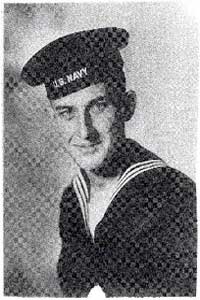 Radarman Second Class United States Navy (RdM 2/C USN).
Radarman Second Class United States Navy (RdM 2/C USN).
Szpak served from 1944 – 1946 in the Atlantic Fleet aboard the USS Landing Craft Infantry (Large) 534 – LCI(L)-534.
Szpak is proud to have served with his two brothers, both of the Unites States Army.
Hometown is Milwaukee, Wisconsin.
Tardy, Eddie
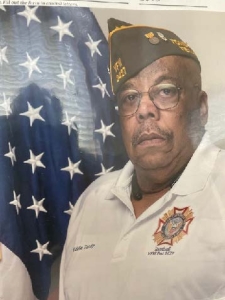 Eddie L. Tardy
Eddie L. TardyUS Army
Vietnam War
Born in Washington D.C. May 27, 1947.
Tardy was Inducted into United States Army, October 1966. At the completion of his basic training, he was recognized as the outstanding trainee of the cycle at Fort, Bragg, North Carolina.
Next station was Aberdeen proving grounds at Aberdeen Maryland. There he trained to repair all types of wheeled vehicles, finishing with the MOS of 63 bravo. Next duty station was Fort Ord, California, where he worked repairing vehicles for the transportation brigade. The next duty station was the ninth infantry division (Old Reliable) in Southeast Asia.
He returned to the United States and was stationed at Fort Hood Texas – second armored division 5th 14th artillery as a mechanic.
Discharged from the Army September 1969.
1982, Tardy re-entered the military- DC National Guard – he served as Senior Training NCO, Active Guard-Managing the 104 Maintenance Direct Support Unit. Also, serve as an instructor with the DC Military Academy at Fort Meade, Maryland instructed land navigation and was a Primary Leadership DC/Reserve Component Instructor.
He ended his military career 15 May 87.
Eddie has spent years(1992-current) volunteering with the VA in various capacities. He recently served for 4 yrs. as Secretary of the Greater Houston Regional Blinded Veterans Group, Houston Texas.
As a Blinded Veteran, Eddie was selected in 2022 to experience NASA’S Arttemis Launch in Florida by Wisdom for the Blind Organization .Eddie is a Lifetime Member of the VFW.
Happily married to Dianna Tardy, he resides in Spring, Texas.
Taylor, Robert
 Taylor was born in Indiana in 1926, and graduated from Wiley High School in Terre Haute, Indiana. He entered the service in 1944, and had basic training at Fort Knox, Kentucky and special tank cory training.
Taylor was born in Indiana in 1926, and graduated from Wiley High School in Terre Haute, Indiana. He entered the service in 1944, and had basic training at Fort Knox, Kentucky and special tank cory training.
In March of 1945 Taylor went by train to Port Oregon and on to Okinawa as tank commander, a Sergeant at the time. Taylor’s unit was a replacement for the invasion groups. In May of 1945 there were no tanks to command, so on to the field artillery.
Taylor was still on Okinawa when the atom bomb was dropped. Just thirty days later he was sent to Seoul, Korea as part of the occupation. He was selected to be a bodyguard for Provost Marshall of Korea, General Moon Mullins. Taylor later served as a correspondent for the Stars and Stripes, and ran the officers and enlisted men’s club.
Taylor returned after the war September of 1946 to be discharged at Fort Sheridan, Illinois. Taylor lived in Terre Haute, Indiana until 1951 when he moved to Texas and has lived in the Houston area ever since. Taylor is a life member of the VFW.
Terry, James
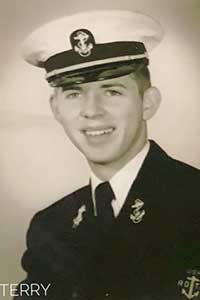 James M. Terry
James M. TerryMajor, USAF (Retired)
Major Jim Terry served his country from 1956 until 1967.
Jim was born in Vinton, Iowa on September 3, 1931. He graduated from the University of Nebraska – BS ’53 and DDS ’57.
Jim was selected for a Scholarship in the Air Force in his senior year of dental school and was commissioned a second lieutenant in 1956.
Upon his graduation from dental school in 1957, he was assigned to his first duty station at Walker Air Force Base in Roswell, New Mexico.
In 1961, he was selected by the USAF to attend graduate school at Marquette University in Milwaukee, Wisconsin. He received his Masters of Science in the dental specialty of Prosthodontics in 1963.
His next assignment was to the School of Aerospace Medicine at Brooks Air Force Base in San Antonio, Texas. His duties were in the field of Dental Research and he was a member of the Medical Evaluation Team for active duty pilots. He was on the medical team that screened Astronaut candidates for the Mercury 7 group of Astronauts.
Jim was medically retired in 1967 and served with the Veterans Administration in Los Angeles and in Houston. He completed a Fellowship at MD Anderson and went on to teach at the University of Texas Dental School in Houston until retiring in 1993.
Jim and his wife, Janet, have been married for 66 years and have four children and three grandchildren.
Thompson, Bill
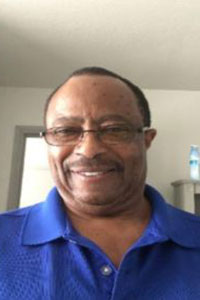
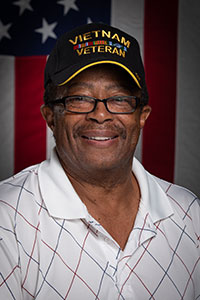 Billy George Thompson
Billy George Thompson
I was born in Birmingham, Alabama December 24th, 1949 before moving to Hawkins, Texas and attending Jarvis Christian College during which time I was drafted into the United States Army.
I Served in the United States Army during the Viet Nam conflict with the 87th Infantry Division and the 57th Transportation Battalion from 1970-1972.
After being discharged, I returned to Texas and completed the requirements to receive a Bachelor of Business Administration and Economics from Bishop College in Dallas, Texas in May of 1977.
I had a very successful career from 1977-2010 with some notable organizations such as Apple, Compaq, and HP Computer Corporations, Anheuser Busch, and I retired from the Oil and Gas industry with Trelleborg Offshore during the BP Oil spill in the Gulf of Mexico.
In retirement, I taught myself the game of golf and Certified as a Licensed Golf Teaching Professional with the United States and World Golf Teachers Federation in San Diego, California. I also attended the Harvey Penick School of Golf and the Golfsmith Club Makers training program and certified as a custom club fitter and club maker. Upon completion, I returned home and designed and constructed one of the first indoor Golf training facilities in the Houston area.
In 2017, I enrolled in Grand Canyon University and graduated in April of 2019 with and Master of Business Leadership.
I have six Brothers and sisters, and all three brothers were in the military at the same time. My oldest was an Air Force B-52 pilot and my youngest brother was a medic stationed in Okinawa in the United States Army.
My wife Veronica Thompson and I are celebrating our 2-year Anniversary on September 15th, 2019. We have five children and four Grandchildren and two great Grandchildren.
My Current Goals:
1. Write an easy to read book
2. Put together a Team and conduct Leadership Conferences in Low Income Areas
3. Complete the Requirements to become a Veterans Service Officer to assist Veterans with Benefits, Schooling, Medical and other benefits they are entitled to through the claims process.
Thompson, Clarence
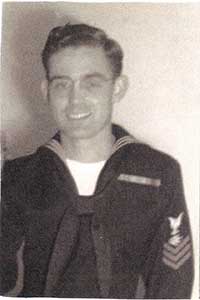 Clarence E. Thompson:Experiences serving in the U.S. Navy in WORLD WAR Two
Clarence E. Thompson:Experiences serving in the U.S. Navy in WORLD WAR Two
I was born in Canyon,Texas (17 miles of Amarillo) on July10, 1925 and because Texas public schools had then only11 years I graduated from high school at age 17.This allowed me to finish my first year of college just before I was 18 years old. Since the draft was imminent, I got permission from my parents to go to the closest Naval recruiting station in Lubbock, Texas and voluntarily join the u.s. Navy on July 7, 1943. Thus began my World War Two military service. I was quickly put on a troop train and sent to the Naval Training Station in San Diego for Boot Camp. From there I was assigned to attend various naval training stations for Radio Technicians, (Currently changed to Electronic Technicians) (Photographed in my final uniform as a 1st class petty officer with an electronic technician’s rating) My final 15 months of training was for 6 months at a naval station on Treasure Island in San Francisco Bay. Upon completion I was assigned to a new “heavy” destroyer being built in the Bethlehem ship yards. This ship was named The USS Putnam (DD757) and was commissioned into service on October 12, 1944 and became the Flagship for Destroyer Squadron 66 which included 10 other destroyers. For the next 17 months our squadron 66 was in the Asiatic-Pacific campaign continuously at sea patrolling the oceans to accompany troop ships, aircraft carriers and various supply ships to the major battles first at lwo Jima and later to Okinawa, always alert to the danger of the Kamikaza suicide pilots attempting to fly their enemy planes into U.S. ships to sink them. One such attact was successful for the enemy as the bow was blown off the destroyer, U.S.S. Twiggs so close to us that as she sank our men on deck were able to save 144 of over 300 in the crew. It was estimated that in our 17 months of continuous war duty we sailed approximately 55,000 miles.
Thornton, Audis
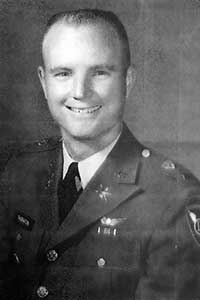 Capt. Audis H. Thornton, Jr.
Capt. Audis H. Thornton, Jr.U.S. Army
Served his Country from August 1960 to July 1965
Thornton was born June 3, 1936 in Baton Rouge, LA. He received his commission as 2/Lt upon graduation from Louisiana State University in 1960.
His first assignment was with the 2/80th Missile Bn., a corporal missile unit at Ft. Sill, Oklahoma. While there he was selected to attend the U.S. Army Aviation School at Camp Walters, TX and Fort Rucker, AL. and received his wings as a helicopter pilot.
From Flight School he was sent to the 7th Infantry Division in Korea where he served 13 months.
Thornton served the remainder of his active duty time at Ft. Benning, Ga. during the buildup of the 11″ Air Assault Div. which became the 1″ Cavalry Div. He was released from Active Duty July 31, 1965 after 5 years of service to return to his wife and two children.
Trevino, Juan
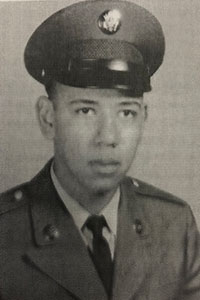
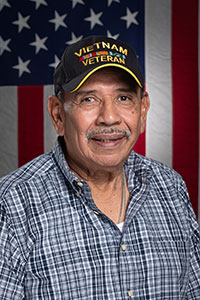 Juan E. Treviño
Juan E. TreviñoUnited States Army, Sgt (E-5)
Born March of 1949 in Laredo, Texas.
Treviño began his military career with the intentions to join the United States Army through the “Buddy Program.” Although his friend did not qualify to serve, he enlisted of his own accord on April 26, 1967.
After completing the physical, he was processed to basic training at the United States Army Infantry Training Center in Fort Polk, Louisiana. Upon completion, he was then promoted to advance training. Afterwards, he volunteered to become a paratrooper and attended, “Jump School,” at Fort Benning, Georgia.
Treviño served his country with the Army in Southeast Asia Republic of Vietnam from 1967 -1969. He also toured through Thailand and Germany.
He was discharged from the United States Army in July of 1975. He then moved to Houston, Texas and began a career in transportation management where he is now retired. He has two beautiful daughters and four grandsons.
Trice Jr., Marvin
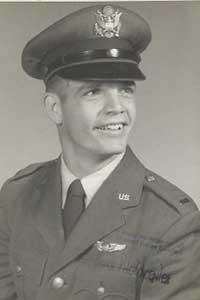 Marvin L Trice Jr
Marvin L Trice Jr
Captain, United States Air Force. Trice served his country as an instructor pilot while in the service.
Trice was born February 3, 1936 in Hewitt, Texas (near Waco, Texas). Later the family moved to Lorena, Texas where Trice attended school until graduation in May 1954. Trice then attended Texas A&M University where he graduated in May 1958 with a Bachelor of Arts degree in Mechanical Engineering.
Trice underwent pilot training at Malden, Missouri; Big Spring, Texas; and Selma, Alabama before being assigned to the 3500th Pilot Training Squadron at Reese Air Force Base outside Lubbock, Texas where Trice served as an instructor and check pilot in T-33 and T-37 aircraft in 1960-1964. Trice was discharged from active duty on March 18, 1964 after serving five years with the Air Force.
Trice married his sweetheart, Sue Nelson, in January 1959 before entering military service and they have now shared 60 years of marriage together. They have two children and two grandchildren. Trice worked for Humble Oil Company after graduation and before entering the service. After his discharge he returned to work with Humble Oil Company later to become ExxonMobil Oil Company. Trice worked with the company for 37 years before retiring in March 2000. Trice worked in Malaysia as a technical advisor for ten years before retirement with the rest of his career was spent working in oil and gas development in various locations in Texas.
Tristan, Diego
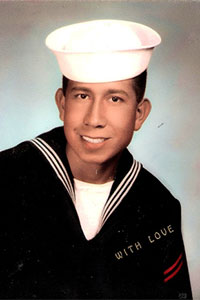 Diego Tristan
Diego Tristan
Second class shipfitter, United States Navy.
I served my country in the Vietnam War from 1965-1969.
I was born in Harlingen, Texas on October 12, 1944.
I joined on January 15, 1965 and attended the US Navy Boot Camp in San Diego, California. I graduated in 16 weeks on May 15, 1965, on May 30th I left for Vietnam.
I was assigned to board USS Destroyer Stoddard in June 1965 as a welder, repairing anything that needed repairing on the ship. It was an honor to serve on the Destroyer like my uncle, Joe Mendoza, who also served World War II on the USS Maddox.
An important saying from President Kennedy that I always remembered and lived by, “It is not about what your country does for you, but what you can do for your country.” So when my country called for me to serve, I was ready.
I served 11 months on the USS Stoddard 566 World War II Destroyer. I used to love doing shore bombardment to support our troops. We also served protecting our aircraft carriers where we used to intercept torpedo, so the carrier wouldn’t get hit. We went to North Vietnam above the DMZ to North Viet Nam to pick up downed pilots that were hit by North Vietnamese shore gunfire.
On my second tour, we were hit on March 17th. The ship was hit so badly that it almost sunk the 250-275 men on board. I was a part of helping the patching & welding the hole that was made upon completion of the path. I felt very proud of having accomplished our mission by patching up our ship to stay afloat, which was such an important job.
Our ship didn’t have to go to the Japan shipyard for repairs. We kept fighting, doing shore bombardments, supporting our Army and Marine troops. As a matter of fact, our ship had a bounty of a big prize by North Viet-Nam. They wanted to sink us because we were doing a great job for our troops and our country. When I got out of the Navy, I came home to my home town. I’ve been married 48 years with my high school sweetheart, Vicky Cabrera. We moved to Houston and had 3 boys, the oldest became police officer, middle son does fire control piping, and the youngest served in the Navy on the USS Abraham Lincoln carrier doing 4 years and now works at the ER in a Houston hospital. We have 3 grandchildren, two granddaughters and one grandson. I couldn’t be happier to be alive with my family and to live in this great country, the great USA Land of the Free.
US NAVY 1965-1969
Tyler, Robert
Petty Officer Second Class, Robert D. Tyler, served March 1954-March 1962 during the Korean Action. Born in Fannin County, Texas, his parents were both school teachers. His father served in the US Army in WWII. An older brother, John O. Tyler, Sr., volunteered and flew Army Air Corps B-24s at Guam Air Sea Rescue. Another brother, Edwin W. Tyler, served in the US Navy in China.
Robert was a student at Sam Houston State Teacher College, Huntsville, TX in 1954 when he joined the US Navy Reserve and took boot training at NAS, Dallas, TX and was assigned to Squadron VA-04, an attack squadron of Corsair planes. In 1955, Tyler transferred to VR-702, a transport squadron, and traveled to Hawaii, Panama, Morocco, Germany, Italy and Athens, Greece. Qualified as Flight Orderly, Flight Mechanic and Plane Captain, Tyler drew flight pay flying in the Navy R5D (C54). In March 1962, Tyler received an Honorable Discharge at NAS Dallas, TX.
While attending SHSTC, he received Bachelor of Science and Master of Education degrees. He was a teacher, guidance counselor, Assistant Principal and Principal during his 37 years in education. After retiring from Pasadena ISD, TX, Tyler became an Adjunct Professor and Sam Houston State University supervising student teachers. He presently volunteers at the H.E.A.R.T.S. State Veteran’s Museum in Huntsville, TX.
H.E.A.R.T.S. Helping Every American Remember Through Serving
Vaughn, Jerald
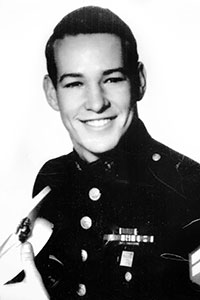
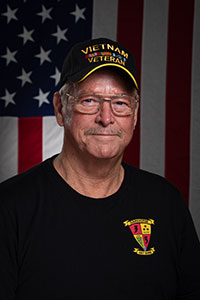 Jerald M. Vaughn
Jerald M. VaughnCpl. United States Marine Corps Vaughn
Served his country in Vietnam from 1967 to 1969
Vaughn was born on December 17, 1948 in Wichita, Kansas and moved with his family to Houston, TX in 1965.
He joined the USMC after graduating from South Houston High School. He went to boot camp at MCRD San Diego, California.
He arrived in Danang RVN on December 26, 1967. He was assigned to Kilo company 3rd battalion 5th MAR regiment 1st MAR division weapons platoon. His MOS was 0331 machine gunner.
During the Tet Offensive, 1968, he received shrapnel to the right side of his head while operating in Arizona Territory close to An Hoe RVN.
In July 1968, he transferred to the 2nd combined action company and after training, was assigned to the cap unit at An Hoe RVN. The last 4 months of 1968, he drove a jeep for the S-3 (security) officer from the 2nd CAG headquarters on China Beach. He came home in January 1969.
He joined the Houston Police Department in 1969 and worked there until 1981. He then started driving trucks, which he did for 31 years before retiring.
His wife of 41 years, Cherrye L. Vaughn, passed away in March of 2019. He has 2 sons, 5 granddaughters, and 2 great-granddaughters.
Vasser, William
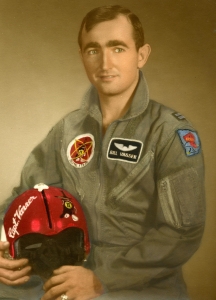 WILLIAM VASSER, JR.
WILLIAM VASSER, JR.Major, United States Air Force. William Vasser served his country in Vietnam in 1968 and 1972 and various other countries oversea during his 20 years of service from 1966 to 1986.
Bill Vasser was born July 1942 in Houston Texas and live at Klein, Texas, just North of Houston, attending Klein High School and Texas A&M where he got his commission as a 2nd Lt through the ROTC program.
In 1966 he entered flight training at Webb AFB, Texas. After completing flight training, he was assigned to George AFB, Calif. in 1967 for checkout in the F-4 Phantom. That lead to a combat tour assignment with the 366 TFW “the Gunfighters”, at DaNang AB, Vietnam, arriving Jan. 1968.
He flew 100 bombing and air combat missions into N. Vietnam, and 110 missions in support of combat troops in S. Vietnam. April 21, 1968 he was shot down on a bombing mission into N. Vietnam and rescued by the USS Cleveland on that ship’s 1st year anniversary. In June 1968, Vasser’s F-4 was again severly shot up but was able to limp back to Danang AB on one engine. He then was assigned to the 523 TFS at Clark AFB, Philippines. His follow on assignment was to the 702 TASS at Bergstrom AFB, flying a O-2A as a Forward Air Controller (FAC). While there, was sent TDY back to DaNang AB where he flew 33 combat missions. His next assign was to Eglin AFB, again flying F-4 Phan-toms.
Vasser then went back to Clark AF, Philippines, as part of the initial team to set up the Cope Thunder combat flying training program, flying the T-33. From there he was assigned to Wil-liams AFB Az flying the F-5 Freedom Fighter. Vasser retired in 1986 at Wright Patterson AFB, Ohio working on various programs associated with the development of both current and pro-posed fighter aircraft.
A person has a lot of memorial moments in combat, getting shot at, and missed, but the three that stand out most was being shot down, shot up, and saving a Army patrol. Returning from a bombing mission, a O-2A FAC came up on the radio screaming for support because the Army patrol he was flying cover for had just been ambushed and were trapped in a bomb crater. The only armor we had was our 20MM Gatlin Gun. Only having gas to go home and their location would be enroute, we advised the FAC we could only make one gun pass so his location instructions had to be perfect. Our 2 ship emptied our guns,strafed the wood line where the bad guys were, thereby neutralizing the threat. Helo gun ships then arrived on station to rescue the patrol. We landed on fumes. I had 14 squadron mates shot down KIA, and two captured, and 7 Texas A&M classmates KIA in the Vietnam conflict. I can tell stories of each one of them of the great times we had together. Tough
The Air Force was a great life even though there was no such thing as a 40hr work week. Never a stranger at a new base. Always knew people from a previous assignment and we still have reunions every couple of years.
While at Clark AB, Philippines, Vasser met his future wife on a blind date, “supporting his squadron buddy”, and got married 4 yr later in Los Angeles in 1974. They have been married for 48 years and have 2 sons and 3 Grandchildren.
Vega, Agapito
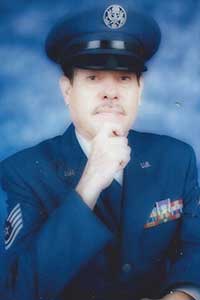 Agapito G. Vega
Agapito G. VegaTech Sgt. US Airforce, Retired
Agapito was born in February 1940 in Taft, Texas. Joined the Texas Army National Guard in 1959, honorable discharged 1961.
Joined US Army 1961 to 1963, trained as a trak vehicle mechanic, served in Germany 1961-1963, honorably discharged.
Joined US Army 1964-1967, served in Vietnam Sept. 1965-1966, honorably discharged.
Joined Army National Guard 1980-1985, honorably discharged.
Joined Air National Guard 1985-1996, honorably discharged.
Joined US Air Force 1996-2000, honorably discharged.
Retired 2000.
Waldheim, Harry
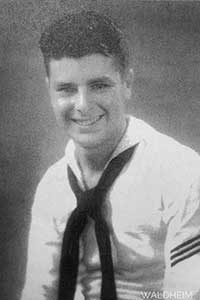 Harry Waldheim
Harry Waldheim
From 1939 to 1945, Hitler’s Nazi Germany systematically exterminated six million Jews. Every Jew all over the world was affected by this great persecution, especially
the nine million Jews who lived in Europe during that time. This horrific period of time is commonly referred to as The Holocaust, which in Greek means sacrifice by fire. It is also known as “Ha’Shoah” which is Hebrew for “the catastrophe”. Even though the Nazis used the term “Final Solution” in reference to their evil plans to wipe out all the Jewish people, this was not God’s final solution for one
German Jewish child.
Born Hans Waldheim on May 9, 1931, “Hans” was the oldest son in a practicing Jewish family in pre-World War II Germany. He shared, “The thing I remember the most about living in the little town of Hemer (pronounced Hay-Mer) was that directly behind our home was the biggest prisoner of war camp in Germany. The Nazis imprisoned thousands of men at Stalag VI-A. As kids, my younger brother, Manfred, and I used to walk up to the fence to see the military prisoners who were Polish, French, Belgian, Dutch and English.” He reported that Stalag VI-A was originally supposed to be an Air Force base for the German military, but it was never completed. From October 1939 to the end of the war in the spring of 1945, around 200,000 Allied POWs resided in those unfinished barracks. It is estimated about 10% of those POWs were buried in the “dying camp” because of poor conditions and hard labor.
In 1938, after getting thrown out of primary school for being Jewish, seven-year-old “Hans” was sent to Jewish boarding school 50 miles away in Cologne, Germany. The school had recently been converted from a Jewish orphanage. He recalled, “This was about the time problems really started for Jews in Germany. I learned some English at that school because they knew that eventually some of us would get out of Germany and go to either the United States or to England. I attended that boarding school for two years.”
Next door to the Waldheim family home was his father’s manufacturing business. Harry recalled, “My father manufactured fixtures that you see in stores which display dresses or stockings. Then in 1938 my father was arrested and sent to Buchenwald from November 11 to December 7 because he was a Jewish business owner.” Harry pointed out a copy of the actual letter to the police which reported the Bill of Sale for the manufacturing business that his father signed on December 3, 1938 while in Buchenwald. Harry translated the letter from German, “It says that Ernst Waldheim sold it to somebody, but the name is blacked out and you notice that there is no amount for the sale. It was really taken from him!” When Ernst was finally released, he came home to Hemer and hid for a week. Harry shared that someone from the underground came and sneaked his father into Holland where he stayed the entire year of 1939 and part of 1940. He added, “That was before the Germans were in Holland. I was a seven-year-old child when he left, but I knew what was happening. It was very upsetting.” In the summer of 1941, “Hans” (9), Manfred (7) and their mother, llse (37) (pronounced IL-sa), took a train from Germany to the neutral country of Portugal. After waiting two weeks at the port of Lisbon, they boarded the famous Portuguese ship, the Serpa Pinto, which was bound for the United States of America. It is interesting to note that during WWII the Serpa Pinto made 20 voyages from Lisbon, Portugal to both North and South America. Because it was one of the few ships making transatlantic voyages in this period, many of the refugees from Nazi Europe, like Harry’s family, in this period traveled on this very ship. Harry recalled the journey across the Atlantic Ocean, “During the two-week boat ride, we almost got attacked by a German submarine and sunk even though it was a Portuguese ship that should have been considered neutral in the war. We didn’t know the ship was under attack until later.
As the Serpa Pinto pulled into the New York harbor Harry remembered seeing his very excited father waiting to greet
them at the gangplank. Ernst had boarded a Dutch ship the SS Westerdam the very day the Germans marched into Holland May 10, 1940. He had been in the U.S a year before his family was able to join him. During that time Ernst arranged visas for his wife and two sons whom he had not seen in two years.
After arriving Hans chose a more American name to begin his new life. He laughed as he shared, “I was going to pick the name, Henry but my friend who come over with us chose it first. Henry Kamm become the famous correspondent for the NY times, so I had to pick something else. I told my parents will take Harry. They were going to name me Harvey and I didn’t like that.
By the time WWII ended in 19451, the Waldheim family was safely living on the banks of the Hudson River in Manhattan in a German Jewish community as new English-speaking US citizens. That’s when they received the news of his maternal grandparent’s death. Harry said not long after we left the Nazis gathered up the remaining Jews in Hemer which were all older people. They put them in concentration camps. One report says my grandparents were in the Auschwitz Concentration Camp when they died, and another report says they were shot in Russia. They couldn’t leave with us because it was a matter of visas.
By July 1942 there were no Jews accounted for in Hemer. As far as Harry knows none of his extended family ever returned to their ancestral home. In 1997, the town of Hemer erected a memorial in remembrance of the remaining Jews that were murdered by the Nazis. His grandparents’ names are listed on that monument. Albert and Julie Steuer (pronounced Stoy-yer}.
When Harry turned 17 years old he took home his enlistment papers for his parents to sign. He did his patriotic duty serving in the U.S. Navy from 1948 to 1953. He pointed out one serious seaman of the hundreds who covered the large battleship on the block and white photo hanging on his wall. He said that was me on the USS New Jersey. I was on that battleship for two years and a couple of years on destroyers. I was in active duty during the Korean War. Being in the Navy was a good experience for me, it mode a man out of me. 11
When Harry (23) left the Navy in 1953 he attended school through the Gl Bill and worked at various jobs before becoming an engineer for Grumman Aerospace in 1959 based out of New York and Las Cruces, New Mexico. He was assigned to projects for the Apollo Program for the next 1 0 years. One impressive accomplishment while Harry was at Grumman was his team’s creation of one of 14 lunar modules for NASA to be used on their planned ten missions to the moon. Harry stood facing a framed photo of the Lunar Module dated March 24, 1969 which is surrounded by many signatures of those on his team. He said, I was the Industrial Engineering Planner for the actual Lunar Module that went on Apollo 12 mission which was on NASA’s 2nd successful moon landing mission in November 1969! This framed picture was given to me by the President of the company because the team I led exceeded our schedule.
A year after getting out of the Navy Harry (24) returned
to New York and married Irma in October 5, 1954. Harry showed a picture of him and Irma, smiling as a newly engaged couple. He shared, she was from Brooklyn, New York. She was a Jew, but she was not German. We had four kids, first twin daughters and then the two sons followed.
In 1969, Harry (38) moved his family from New York back to Las Cruces where he went to work on nuclear war heads and atomic bombs for New Mexico State University at the White Sands Missile Range. During their eight years in New Mexico, Harry and Irma joined a smell Jewish synagogue. He said, “I was even president at the synagogue after a couple of years! It was very much a part of my life until the late 80’s when my wife and I turned away from religion. Irma got sick with all kinds of illnesses.”
The Waldheims moved to Houston in 1977 so Harry could work in the chemical industry. In 1983, Harry owned an air conditioning shop, HHS Service Company in League City. Harry gave his A/C business to his oldest son, Alan, and retired at the age of 65 in 1996.
Harry’s and Irma’s daughter, Susan, passed away in February 2009 at the age of 52. Then, not long after their 55th wedding anniversary, Irma died of congestive heart failure in November 2009. Harry said quietly, “That was a rough year.”
Harry moved to the newly constructed Villas at El Dorado in Webster in October 2011. That’s where Harry met Sagemont member, Marilyn Steelman. He smiled as he recalled their first date, “On August 20, 2013, we were exercising together at the Friendswood Senior Center. Marilyn said to me, ‘What do you know about televisions?’. I said, ‘Everything!’ Marilyn said, ‘Will you go with me and check my TV? It’s broke.’ I said, ‘Sure! If you need one we will go get one…after lunch!’. I took her to the Olive Garden. Then out of the clear blue sky she told me she was going to Sagemont Church. I just said, ‘I’d like to go to church with you!’ I had never been to a Protestant religious service my entire life, but I have been here ever since.”
Walters, John
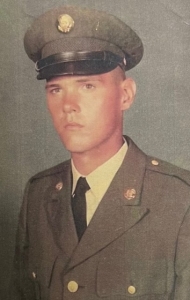 John D. Walters
John D. WaltersUS Army; Spec 5
Vietnam War
I, John D. Walters, was born on July 7, 1950, in Houston, Texas to Rev. and Mrs. John A. Walters. I was raised in the Cloverleaf neighborhood on the east side of Houston. I attended Cloverleaf Elementary School and Northshore Jr and Sr. High Schools. Upon graduation from high school, I briefly attended San Jacinto Jr. College in Pasadena, TX.
After being reclassified 1-A by the draft board, I had a desire to get married and start my family, so I volunteered to be drafted to get my military service behind me. I entered the U.S. Army on 24 April, 1969 and went to Ft. Bliss, TX for basic training. Afterwards, I was sent to Redstone Arsenal in Huntsville, AL for AIT training.
My MOS was 55-B-20, which is an Ammunition Storage Specialist. Was sent to Danang, Vietnam on October 8, 1969 and served with the 528th Ammunition Company as a forklift operator and whatever other duties were assigned in the Ammunition Dump. I eventually achieved the rank of E-5, Spec/5. I saw very little actual combat action but survived numerous mortar attacks.
My most memorable memory of my time there was being assigned to transport water during the night hours through the city of Danang. The main water line that serviced the city had been blown up and for a period of time, we had to transport water in tanker truck from the Danang airport to a large storage tank located on a mountain behind our company. These trips were hazardous, to say the least, and we were fired on a number of times by snipers. This duty lasted almost a month. I was assigned a guard to ride with me for protection. He was good but could do little against the snipers.
I returned home on October 7, 1970, for a 30 day leave and then went to Germany where I finished my tour. While in Germany, I returned home on leave and married my high school sweetheart. We have been married 52 wonderful years. We have two daughters and one grandson who is 16 years old. I was discharged from the Army at Ft. Campbell, KY on January 8, 1972. I now live within 2 miles of where my wife and I were raised.
I have suffered the effects of Agent Orange and am now 100%, service related, disabled by the VA
Warburton, Stanley
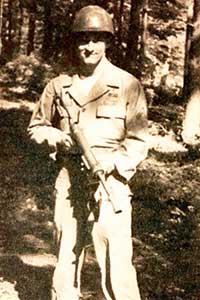 Stanley D. Warburton
Stanley D. WarburtonCorporal (T), Ordinance Supply Specialist
Stan was born on February 6, 1933, in Harlingen, Texas, and lived and grew up in Freer, Texas, a small town close to Laredo, TX. He worked in his father’s Western Auto store from the age of 10. After dropping out of college, he was drafted into the U.S. Army in April, 1953, at the Corpus Christi Naval Air Station. He was bussed to Ft. Sam Houston, San Antonio, TX. From San Antonio he was shipped to Ft. Bliss, El Paso, TX, where he completed his basic training. His unit was assembled on the train station platform waiting to be deployed to Korea. Everyone boarded the train except for him and 5 others whose last names all began with “W”. Stan was shipped to Wackernheim, Germany and assigned to the Headquarters Battery, 94th AAA Battalion, 2nd Armored Division. While in Germany, Stan attended Ordinance Supply School, Fussen, Germany. Stan’s next tour was with General Doan’s Sports Division. He was a good tennis player and traveled throughout the southern and central part of Germany playing in tennis tournaments. He played in and won many tournaments and trophies. For his accomplishments, he received a “Pass and Review” parade by his fellow soldiers where he was formally presented with all his trophies. He received a promotion to Corporal for his service. He was discharged from the Army in April, 1955. He returned to his home in Freer and used the G.I. Bill to return to school at the University of Texas, Austin, TX. He met and married his wife, Joan Farquhar in June, 1959. In June of this year, he will have been married for 60 years. They have 2 daughters and 3 grandchildren.
Ward, Larry
Aerographer’s Mate First Class (AG1) Larry A. Ward, USN, Ret. He served his country during the Vietnam War from 1959 until he retired in 1981.
Larry was born in March 1941 in Columbus, OH. He joined the Navy Reserve Program while still in high school and went active duty after high school graduation in 1959. He became an aerographer (weather forecaster) and has served aboard ships and on land.
He assisted in two astronaut recoveries, served aboard the Princeton for much of the Vietnam War, the Kearsarge, and retired from the Ranger. He was also at FWC Rota, Spain, NAS Brunswick, GA, NAS Sanford, FL, Barber’s Point in Hawaii, FWC Alameda, CA, North Island in San Diego, CA and Midway Island with the gooney birds.
He married Rebecca, whom he met on a blind date, in 1969 and they had three children.
After retirement, he went to college and earned a BBA in accounting. He and the family returned to OH to live and, after the children were grown and gone, moved to Phoenix, AZ. A few years later, they moved to the Houston area, where they still reside and will celebrate 53 years together in December
Watson, Kurt
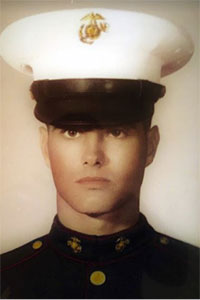 KURT WATSON
KURT WATSONUSMC
My name is Kurt Watson, I was born in Omaha, Nebraska, growing up there until graduation from high school and then went off to college in California in 1964. I joined the draft in 1966 and did not finish college until many years after my military discharge and with the backing of the GI Bill in Springfield, Missouri. Most of life until now, was spent in Missouri, but I also lived in different places, mainly job-related, such as North Dakota, Nebraska, California, and my favorite, Texas. My wife and I have lived in Texas over thirteen years and consider Texas our home.
Employment experiences include: grocery bagger, stock boy, and checker. I worked at construction jobs and learned: welding, framing, roofing, sheetrock, plumbing, concrete and carpentry. I worked as a printer’s helper and learned the printing press, pre-press artwork, plate making, and business paper handling machines, sales, and management. I ended my career working in Texas as a Veteran Outreach Program Representative.
My employment included state, national, and international corporations and I owned my own business. My wife and I have lived in Springfield, MO, League City and Houston, TX. My wife worked in education; we both are retired.
Hobbies include: fishing, motorcycles, street rods, antique outboard motors, boats and gardening.
Associations: I am a life member of the NRA, American Legion, and Veterans of Foreign Wars
Moto: Freedom is not free, it takes constant vigilance
Advice: America is as great as we allow it. Preserving our constitution is our greatest virtue. Our way of life is worth fighting for. We all need to be diligent, honest, and trust in God. When I was inducted in the Marine Corps, I help up my right hand and swore by to defend American against all enemies, both foreign and domestic. That should be taught to all our children and immigrants that come here.
I joined the Marine Corps in 1966 after receiving my selective service rating as 1A. To me, the Marines were the best choice since it was well-respected and carried a proud tradition of honor and country.
My training was at Camp Pendleton, California where, after boot camp, I learned to be a field radio operator, read maps for artillery and handle small arms. After my training, I was sent to Vietnam. While in country, I served with the first Marine division. I was assigned to the 3rd Battalion, 11th Marines in support of artillery, calling in fire missions while in the field and relaying messages while at battalion headquarters. I arrived in the The Republic of Vietnam on March, 1967.
Vietnam was both beautiful and ugly. Beautiful with countryside and ugly by war. The enemy may seem friendly during the day, but may kill you at night. He was crafty and resourceful. I respected them as fighters, but as my brother Marines got killed, I learned to hate. I still carry that cross.
My tour of duty took me to many places in what the military called, I-core. It included areas in the north of Da Nang to the DMZ. I went on twelve military campaigns or operations. Sometimes I was deployed with a squad of Marines, or a company size; once two of us went out. Most of the time, I was frightened, but a lot of the time it was just a job as radioman.
I often wonder the fate of the children that were victims of the Vietnam War. I got to come home in April, 1968; they had to endure the bloody end of their homeland and be indoctrinated in communism.
Watt, Gary
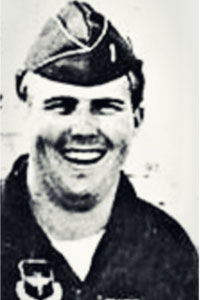 Gary Watt
Gary Watt1st LT/USAF
I was born January 25, 1947 in Austin, TX, where I remained until graduating from the University of Texas at Austin in 1970 with a degree in Mechanical Engineering.
In late 1970, I was recruited by the US Air Force Reserve to fill available pilot slots at Ellington AFB near Houston. I graduated from USAF Officer Training School at Lackland AFB, TX in 1971, from USAF Undergraduate Pilot Training at Craig AFB, AL in 1972, and from C-130 Combat Crew Training School at Ellington AFB, TX later in 1972.
I was then assigned as a C-130 Hercules pilot to the 924th Tactical Airlift Group at Ellington. Due to the wind down in the Vietnam War, I was transferred to Inactive Ready Reserve status in 1973 whereI remained until receiving an honorable discharge in 1978.
I married Joan Willis in Houston in 1970 and we have two sons (and daughters-in-law) and 7 grandchildren. After a career in both the oilfield services and bulk trucking industries, that included 13 house moves both nationally and internationally, I retired in Chicago, IL in 2015 and we relocated to our current home in League City, TX in 2016.
I began volunteering for the Lone Star Flight Museum in Galveston in 2016 as a docent and curatorial assistant and am now serving as Head Docent of the new museum at Ellington. The Lone Star Flight Museum recently began hosting the HFH flight Meet & Greets.
Special Note: Honor Flight Houston is very proud to have Gary Watt as a vital part of their organization. Gary is the HFH Events Director and coordinates requests for speakers and programs about HFH in the Houston and surrounding areas. It is truly an honor to have Gary on the Honor Flight Houston team!
Waxman, Gerald
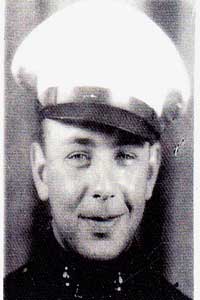 Sergeant “Jerry” Waxman
Sergeant “Jerry” Waxman
United States Marine Corps
Served in World War II from 1942 – 1946
Born in Cleveland, Ohio in June 1925 and attended school through the 10th grade. Enlisted voluntarily shortly after he was 17 and trained at Parris Island, South Carolina. He then recruited officers at MCOPO in Philadelphia, Pennsylvania for a year.
After graduating MC Engineering School at Camp Lejeune as a Topographical Draftsman he served S-2 Intelligence in Pago Pago, American Samoa for the Fleet Marine Force.
Waxman contracted a tropical disease and was hospitalized at the Marine Base in Klamath Falls, Oregon where he created cartoons for the camp newspaper. He was then sent to the Officers Training School in Quantico, Virginia where he was head of the chart and design section of Marine Corps Training Schools.
In his three and a half years in the Corps, Waxman received enough on-the-job training in newspaper work and advertising arts to serve him in his chosen field of Advertising and Exhibit Design. He spent 40 years in the field designing industrial Trade Shows and World Fairs, Director at the Interior Design Department for the City of Dallas, Texas, an Art & Design teacher for Katy ISD, Caricaturist for Astro-World in Houston, Texas, and as the designer of the Katy Veterans Memorial Museum in Katy, Texas. He is now retired from the advertising art department of the Houston Chronicle.
Waxman is a member of the VFW & American Legion and an honorary member of the USS Houston CA 30. He also wrote “The Veterans Corner” for the Katy Times for eight years.
Sgt. Waxman married Dandra Dean in 1974. They have four children, three stepchildren, and four grandchildren all who practice “Semper Fidelis.”
Weber, Ed
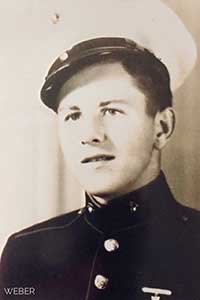 Ed Weber
Ed WeberPFC USMC
Weber served his country in WWII from 1942 – 1945. He was born in St. Louis, MO before his family moved to Dallas, Texas in 1927.
He enlisted on December 5, 1942, and went to boot camp in San Diego, California.
Weber was assigned to the Naval Air Station in Santa Ana, CA where he spent 8 months with the Marine Guard Detachment. Following that, he was sent to the 5th Marine Amphibious Corp for future training in Hawaii. After four months, he was transferred to the Transient Center on Oahu where he remained until the war ended in 1945.
Weber was discharged November 28, 1945, from the Marine Corps Base in San Diego, CA. He returned home to Dallas, TX where he later met his wife, Mildred. They were married 65 years before her passing in 2014. They have one daughter, son-in-law, three grandchildren, and two, soon to be three, great-grandchildren.
Wells, Lloyd
 Staff Sergeant United States Army Air Corp (USAAC) – served our country during World War II from 1943 – 1946 in the 8th Air Force – 490th Bomb Group – 850th Bomb Squadron.
Staff Sergeant United States Army Air Corp (USAAC) – served our country during World War II from 1943 – 1946 in the 8th Air Force – 490th Bomb Group – 850th Bomb Squadron.
Wells was born in January 1926 in Ponca City, Oklahoma. His family moved numerous times before he enlisted in the service in Chicago, Illinois following his brother’s footsteps, as he was 2 years older. His brother (John) joined the Army Air Corp in 1942 and was sent to flight school to be a pilot.
Wells was sent to Sheppard Field in Wichita Falls, TX for basic training. He then went to gunnery school in Kingman, Arizona learning to shoot .50 caliber machine guns. He was then sent to Yucca, Arizona to aerial gunnery school. His next stop was Tampa, Florida at McDill Field for crew training; then on to Avon Park, Florida for crew assignments.
In January 1945, he flew to Bangor, Maine where his crew was assigned to a new B-17. His next stop was Gandor, Newfoundland where the snow was six feet deep. There his crew flew to Enlgand and was assigned to a permanent squadron and group. After one month they were sent on their first combat mission (March 8, 1945) to Dorman, Germany. Their ‘new’ plane was named the Magnificent Obsession. The next day, March 9, 1945 they were sent to Frankfurt, Germany to bomb railroad yards. BOOM!! With bombs not released, his plane was in flames as they were being shot down by enemy fire. As the plane crash-landed the Germans saw them and were waiting for them. He was captured and taken to a German POW Hospital. Others in his crew were killed in the crash and others taken to German POW camps.
American troops under General George Patton rescued them and they went by ambulance to Belgium and then England. After spending almost a year in an English hospital, he came home on the ‘Larkspur’, which was previously a German Submarine Tender used in WWI from 1914-1918. The ship landed in Charleston, S.C. and then he went by train to Menlo Park, California where he spent several more months in Dibble General Hospital having several more reconstructive plastic surgeries. At this time he received his Purple Heart.
After being discharged from the Army Air Corp, he enrolled in the University of Southern California. He then transferred to Fresno State and got his Bachelor’s Degree in Education. His next 30 years were spent teaching Elementary School and is now retired.
In June of 1949 he married his sweetheart, Mary Pat Newhouse. They have been married for 65 years. They have one son and one daughter as well as two grandchildren, one great-grandson and another one on the way. He and his family currently live in Texas.
White, Robert
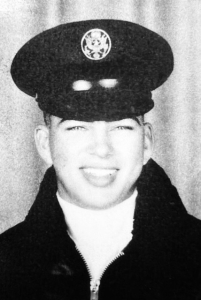 ROBERT A. WHITE
ROBERT A. WHITEMaster Sgt., USAF
Master Sgt. White served his country in the Vi-etnam War from September 1966 to August 1970. He was born in Brenham, Texas on a dairy farm and lived there for 12 years before his family moved to Texas City, Texas.
Upon graduating , Sgt. White joined the Air Force. He attended basic in San Antonio, TX, then on the ACFT Maintenance School in Ama-rilla, Texas. From there, he was assigned to Laredo AFB, TX as a crew chief on T-38 ACFT.
After going to numerous ACFT schools and training, he volunteered for Vietnam. He was assigned to Bien HOA AFB working on B-57 Canberras, but orders were changed to Takhli AFB in Thailand as a crew chief on F-105s and B-66s, the 355th TFW, 44th TFS and 42nd TEWs.
Sgt. White was honorably discharged in August 1970, graduating from college, employed by Houston Fire Department for 28 years and has been married to his wife, Penny, for 51 years. They have 2 children and 2 grandchildren.
Sgt. White also served as a crew chief at Ellington AFB working on F-101s, F-4 Phantoms and F-16s, for 22 years before retiring from the Texas Air National Guard.
Whitley, Jack L.
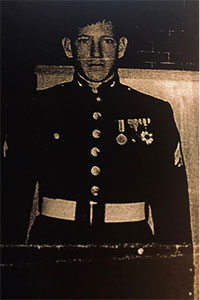 Jack L. Whitley
Jack L. Whitley
Cpl E-4 U.S. Marine Corps. Served his country in Vietnam from 1966-1972.
Jack was born on September 1946 in Talladega Co., Alabama.
He was drafted on the 19th of January 1966 and assigned to Marine Corps boot camp at San Diego, CA. This is where Jack completed advanced infantry training at Camp Pendleton. After receiving a 30 day leave, he was transferred straight to Vietnam.
While assigned to Vietnam, Jack received the following medals: Presidential Unit Citation, National Defense Service Medal, Vietnam Service Medal with a star and Vietnam Campaign Medal.
After serving 10 months in Vietnam, Jack was given a hardship transfer to McAlester, OK. While waiting the death of his mother with terminal cancer. While in McAlester, Jack served as Military Police and was discharged from active duty in 1968 to Marine Corps Reserve.
Jack presently lives in Brazoria, Tx with his wife Marci of 31 years. He has 4 children and 8 grandchildren that all live in the Houston area.
Williams, Donald
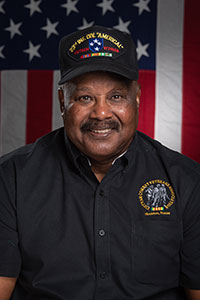 Donald Joseph Williams
Donald Joseph Williams
United States Army, E-5
My name is Donald Joseph Williams and I was an E5 in the US Army where I served in Vietnam from 1967-1969. I was born on November 4, 1946 in Beaumont, Texas and was drafted into the US Army in 1967 after graduating from Charlton Pollard High School. I served my basic training at Fort Polk, Louisiana. After completing basic training, I entered Advanced Infantry Training (AIT) for my preparation in Vietnam. On December 24, 1967, I was sent to Vietnam and was assigned to the 23rd Infantry Division “Americal”.
During my tour in the 23rd Infantry Division “Americal,” I fought in the 1968 TET Offensive where I received the Bronze Star for Valor. During my military service, I also achieved the following medals: Army Commendation, Vietnam Service & National Defense.
After completing my tour of duty, I was honorably discharged from the US Army in September of 1969. I returned home to Beaumont, Texas where I went to Lamar College and married Jennifer Martin in 1973. We have been married for 46 years with 2 grown children and 5 grandchildren.
Williams, Percy
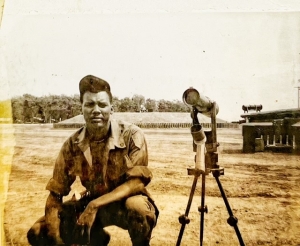 The Biography of Percy D. Williams
The Biography of Percy D. Williams
My name is Percy Williams. I was born in Monroe, Louisiana on March 31, 1948 to Mr. and Mrs. Wilford and Josie Williams. I graduated from Monroe High School in 1966.
I enlisted in the Army in 1968 where I did three years in Germany. I discharged and re-enlisted in 1971 where I did three more years with 13 months in Vietnam.
After discharging from the Army again in 1974, I went to Houston Community College, then I started working for Volkswagen of America. In 1981, I started working for the United States Postal Service of which time I met and married my wife, Jerdine, in 1982. I worked for the Postal Service for 30 years including my military time. I retired from the Postal Service in 2010.
My wife and I have three adult children, seven grandchildren and one great-grandchild. I have a granddaughter that’s studying to become an Orthopedic Surgeon, on that majored in Echocardiography and is employed as a Diagnostic Medical Sonographer, one that is a Veterinarian and one that will graduate from college in May 2023 after studying to become a Forensic Accountant. I have a grandson who also served in the Army. The rest of my grandchildren are still public school.
I now spend my time traveling with my wife, walking around the community, enjoying my grand-children and life.
Wooley, Gaddis
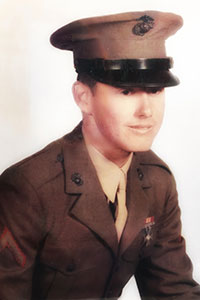
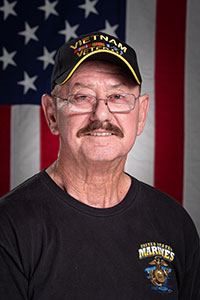 Gaddis E. Wooley
Gaddis E. WooleyL/Cpl., United States Marine Corps.
Served his country in Vietnam from 1970-1971.
Gaddis was born on August 8, 1949 in Galveston Texas.
He was drafted by the army in May 1969. While being sworn in a Marine Gunny Sergeant came out and said, “I need 10 volunteers. I need you, you, and you, — you skinny runt”. That is how he got picked by the Marines
After basics he served a short time in Okinawa and then went to Vietnam. He was stationed with the First Air Wing Group out of Mag. 16 until 1971.
Gaddis was discharged March 1971. He returned home where he married his wife Christina of 48 years. They have three fantastic sons, three wonderful daughter-in-law’s, and three fabulous grandchildren.
Wuensche, John
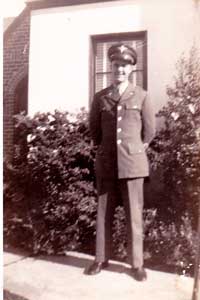 Wuensche was born April 8, 1917 in Hufsmith, Texas. His parents were Gustave Adoph Wuensche and Louise A. Mueller. His Father was killed in World War I and his Mother remarried to Concie Ross.
Wuensche was born April 8, 1917 in Hufsmith, Texas. His parents were Gustave Adoph Wuensche and Louise A. Mueller. His Father was killed in World War I and his Mother remarried to Concie Ross.
Wuensche was educated in Texas City and went to Central High School class of 1935. He attended the University of Texas earning his bachelors in 1939. He then went on to attend the University of Texas’ graduate law school for 1 ½ years.
Married Charlotte Ellen Thomas in 1941. They have two children Richard Anton and Lounell Lyon.
Wuensche enlisted in the Army Air Corps in San Antonio, Texas on May 26, 1942. He received flight training from November 1, 1942 – April 1943 in Santa Ana and Ontario, California. He attended aviation mechanics school, Amarillo AFB and Chanute Field, Illinois from May 1943 to December 31, 1944. He was an instructor at Chanute Counter Intelligence Corps. Attended training at Camp Ritchie, Maryland and University of Pennsylvania. Was a CIC agent in Germany from May 1945 to January 1946.
Wuensche was discharged at Camp Fannin, Texas on January 21, 1946.
He attended Southwestern Baptist Theological Seminary earning his bachelors degree in 1952. He then attended the University of Houston during the summers of 1960 and 1961 for education and math.
Wunderlich, Henry
Patrick Murphy
Murphy was born in 1925 in Stillwater, Oklahoma. He attended Stillwater High School and one year at Oklahoma A&M, now Oklahoma State University.
Murphy became eligible for the draft in 1943, enlisted in the Navy, and qualified for the Navy V12 college training program. He was ordered to report to the University of Oklahoma at Norman, Oklahoma. He graduated with a Civil Engineering degree and commissioned as an Ensign in 1945.
Murphy was assigned to the USS PCE 875 in the Leyte Gulf area of the Philippines. When he arrived the ship was at a repair base and needed a reverse gear. It was decided it could not be repaired there so they joined a convoy with two other PCE’s to proceed to Pearl Harbor. While there the Navy decided to convert the ship for weather duty in the Alaskan area. Before it left Murphy became eligible for release from active duty and returned home.
Murphy subsequently took some Navy correspondence courses and was promoted to Lt. J.G. in the Naval Reserve. He retired from Amoco Corporation after 40 years of service in 1987 in Chicago.
Wyss, William
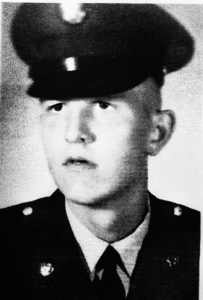 William S. “Steve” Wyss
William S. “Steve” WyssSpecialist E4, SP4, United States Army
Steve served his country in Vietnam from 1969-1971.
Steve was born in Illinois and lived in many mid-west states before retiring to Texas.
He was drafted in September 1969. Basic training at Fort Leonard Wood, AIT at Fort Sill Oklahoma Field Artillery.
Assigned to the 25th Infantry Division, Btry C 7th BN 11th Arty, Vietnam MOS 13AIO.
He received the National Defense Service Medal, Vietnam Service Medal, Vietnam Campaign Medal, and the Army Commendation Medal.
Zajac, Tom
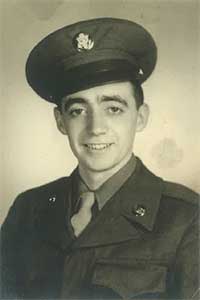 Tom Zajac joined the Army in January 1948 at 15 years old attending boot camp in Fort Dix, New Jersey. Became a squad leader acting cpl. in boot camp. First tour was overseas was in Alaska before it was a state. He came back to the states in 1949 to Fort Warden, Washington as a 2nd Engineer Special Brigade, Amphibious. The Korean War started June 25, 1950 and we embarked to Japan, by ship, to Yokusta, Japan. Regrouped for invasion of Inchon, convoy had a tough time going thru Typhoon our LST came very close to sinking. Saw combat in Inchon, then went to North Korea for landing at IWON, just south of the Russian Border. The Chinese came into the war and we evacuated everybody out at Hungnam, 7th, 10th Corp., 1st Marins and Civilians Tom earned 5 bronze Battle Stars and 2 Landing Clips, all Korea War Medals plus UnderAge Honorable Medal for our organization VUMS-Veterans UnderAge Military Service
Tom Zajac joined the Army in January 1948 at 15 years old attending boot camp in Fort Dix, New Jersey. Became a squad leader acting cpl. in boot camp. First tour was overseas was in Alaska before it was a state. He came back to the states in 1949 to Fort Warden, Washington as a 2nd Engineer Special Brigade, Amphibious. The Korean War started June 25, 1950 and we embarked to Japan, by ship, to Yokusta, Japan. Regrouped for invasion of Inchon, convoy had a tough time going thru Typhoon our LST came very close to sinking. Saw combat in Inchon, then went to North Korea for landing at IWON, just south of the Russian Border. The Chinese came into the war and we evacuated everybody out at Hungnam, 7th, 10th Corp., 1st Marins and Civilians Tom earned 5 bronze Battle Stars and 2 Landing Clips, all Korea War Medals plus UnderAge Honorable Medal for our organization VUMS-Veterans UnderAge Military ServiceZemcik, Robert
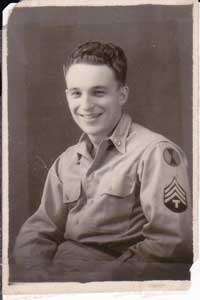 Zemcik served his country in World War II from 1944 to 1948. He enlisted first in the United States Merchant Marines (November 3, 1944 at age 18) when he received his 1st draft notice. Zemcik went to boot camp at Sheepshead Bay, Brooklyn, N.Y. In basic training he took many tests for placement aboard ship. Approximately December 10, 1944 Zemcik graduated from basic training and was one of three men called out of their platoon of sailors and sent to Gallups Island, Boston, Massachusetts for Radio School.
Zemcik served his country in World War II from 1944 to 1948. He enlisted first in the United States Merchant Marines (November 3, 1944 at age 18) when he received his 1st draft notice. Zemcik went to boot camp at Sheepshead Bay, Brooklyn, N.Y. In basic training he took many tests for placement aboard ship. Approximately December 10, 1944 Zemcik graduated from basic training and was one of three men called out of their platoon of sailors and sent to Gallups Island, Boston, Massachusetts for Radio School.
Zemcik trained to be a Morse Code Radio Officer aboard a merchant ship. The island was seven miles out in Boston Harbor past U.S. submarines and nets that protected U.S. harbors and the small island like this one, which had heavy coastal guns defending Boston Harbor too.
Zemcik and the others reached the island only by a ferry boat, all summer and winter. He spent seven months there before graduating as a commissioned warrant officer radio operator. Zemcik was sent to Seattle, Washington to board the ship S.S. Chelsea Victory in August, which was being loaded with Army war supplies for all the islands the U.S. had invaded. The ship sailed out to the Pacific alone at night, with no lights and no convoy. Zemcik stated:
The only fear was being torpedoed or struck by a Japanese bomber.
Troop transports and cargo supply ships were also targets both in Europe and Pacific. That trip took eight months before returning to San Francisco, California.
Zemcik received his honorable service union book, his pay check and left for home in Detroit, Michigan where he was born.
For personal reasons Zemcik never went back to being a sailor.
In August 1946 Zemcik received his 2nd Draft notice. He enlisted at once in the U.S. Army as a Buck Private. He took basic in Fort Sheraton, Illinois and Fort Dix, New Jersey. Then he was shipped out to Camp Stoneman, Oakland, California. He boarded the troop ship ‘Admiral, William L. Capps’. The ship sailed to South Korea 6,000 miles away with 5,000 men aboard. They landed at Inchon and were trucked at night to Fort on the 38th parallel in Chunchon, South Korea to become Army occupation for 12 months. Zemcik received his rank fast to Staff Sergeant due to experience in the Merchant Marines.
Zemcik:
My officer/radio school kept me out of the major part of the battles and war. One of the lucky ones.
Like Seaman Daniel A. Kelly said –
‘Thank God for Uncle Harry’
He had to make a horrible decision to be the first nation to drop an atomic bomb, two actually, before Japan gave up.
The invasion of Japan was planned for November 1945. Japan surrendered September 2, 1945. No news ever reached sailors or soldiers during time of war quickly. But when it did there was much celebration of life not death and Home. Zemcik returned with 5,000 troops on the troop ship ‘General H.B. Freeman’ on December 24, 1947. He received his honorable discharge on January 8, 1948 from U.S. Army at Camp Stoneman, California. Zemcik took the train back to Detroit, Michigan where a party awaited him at home.
Upon settling back home in 1948 Zemcik started working for his Father’s business. He went to college taking night courses and in 1950 met his future wife, Eleanor. They married May 3, 1952 and had three daughters, one son, nine grandchildren and nine great grandchildren – all well and happy.
CHANGE A LIFE TODAY
Being a supporter of Honor Flight Houston means joining a family of people who are committed to to giving veterans the experience they deserve.
